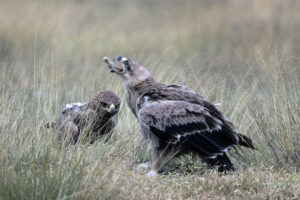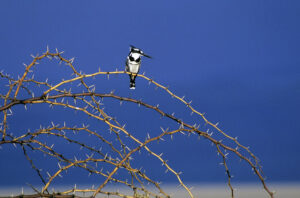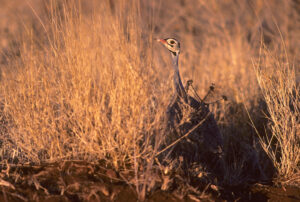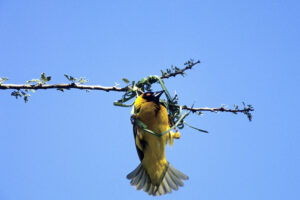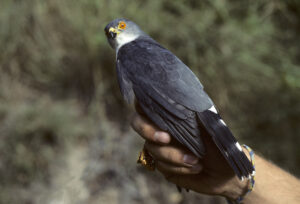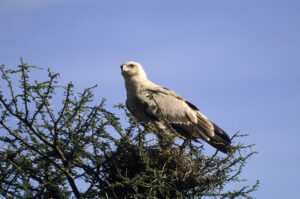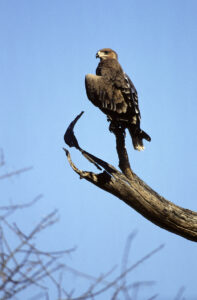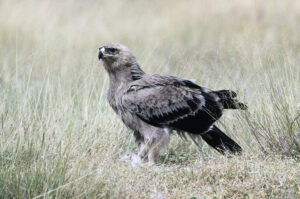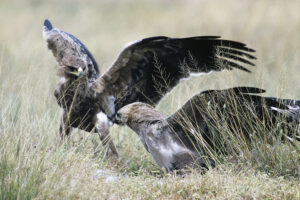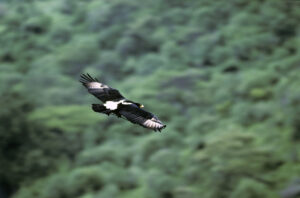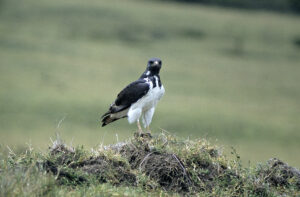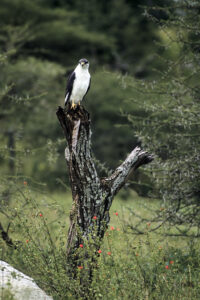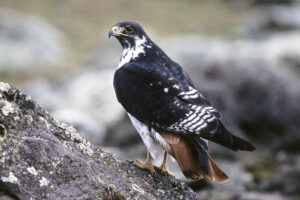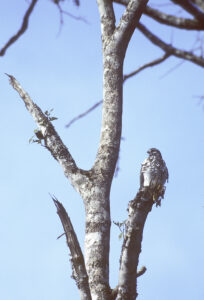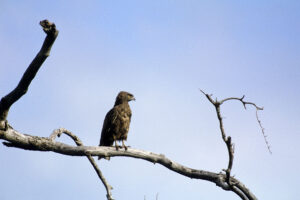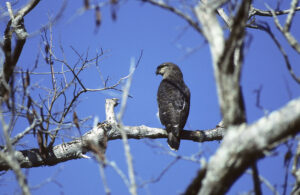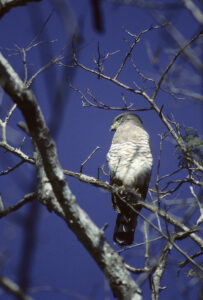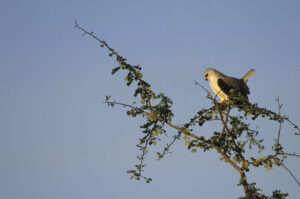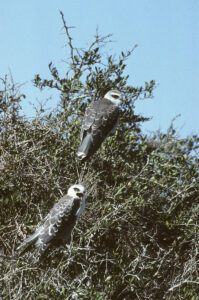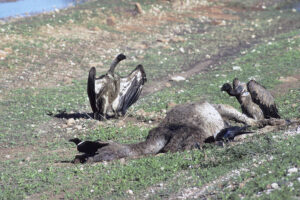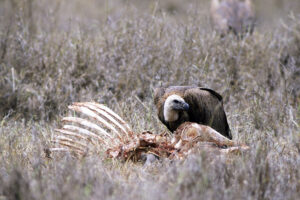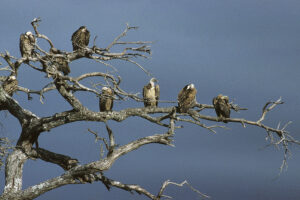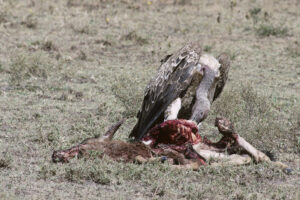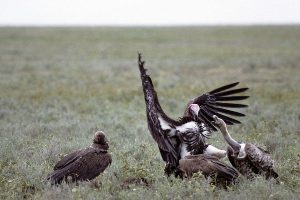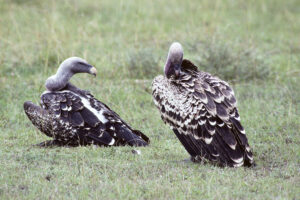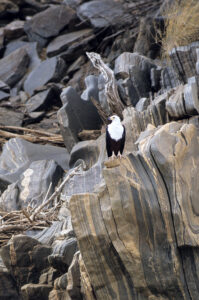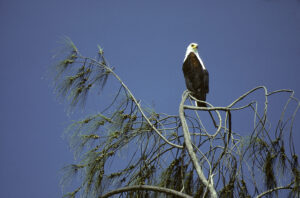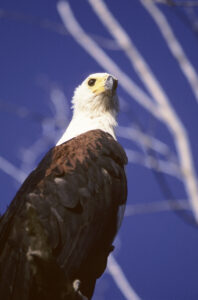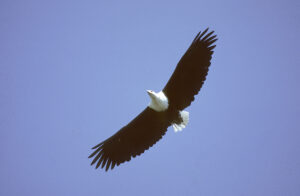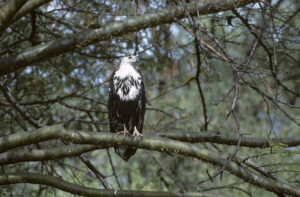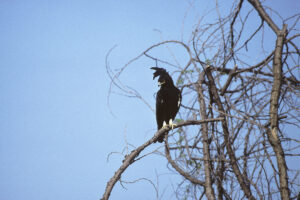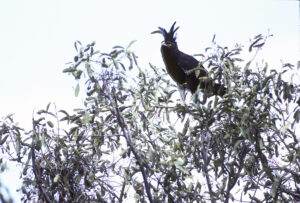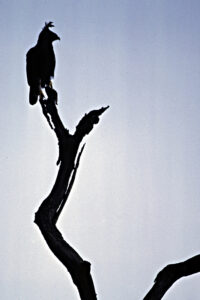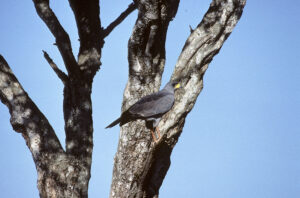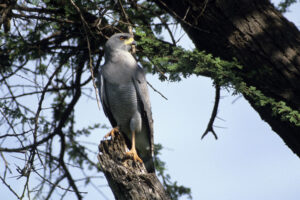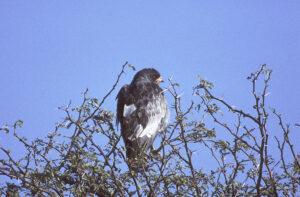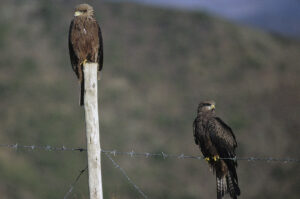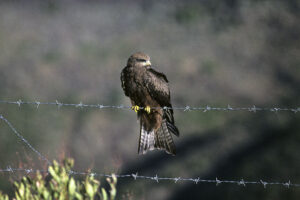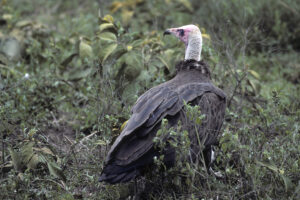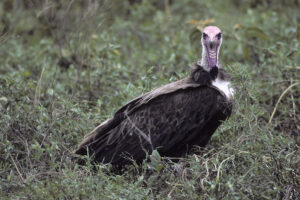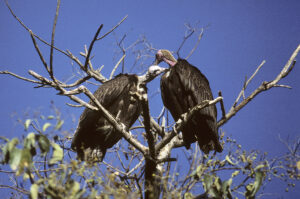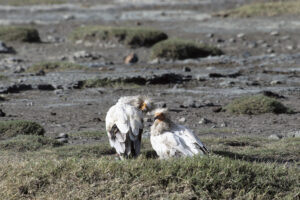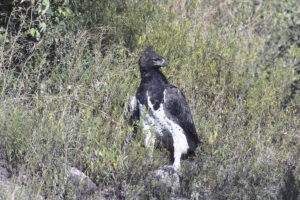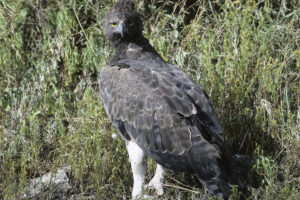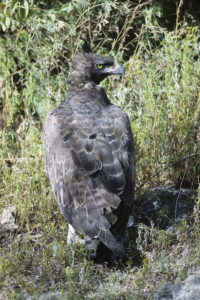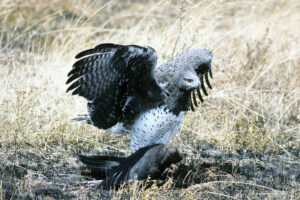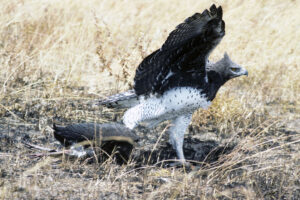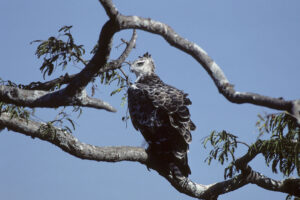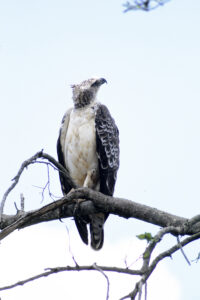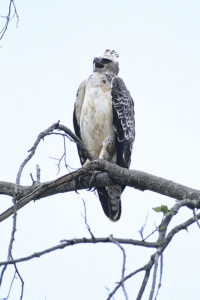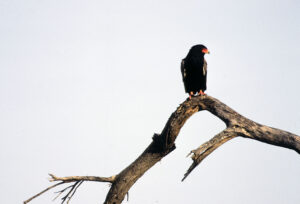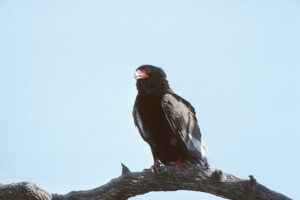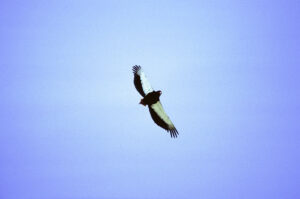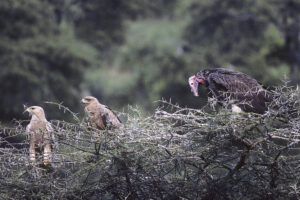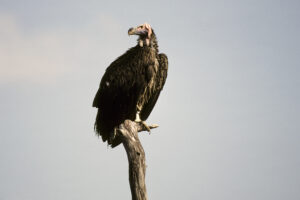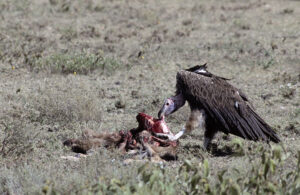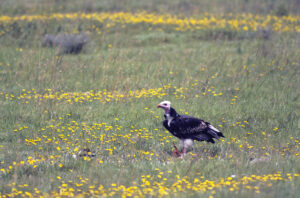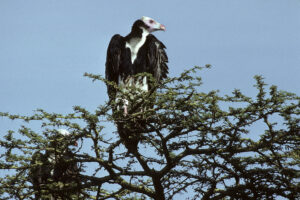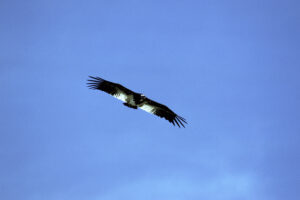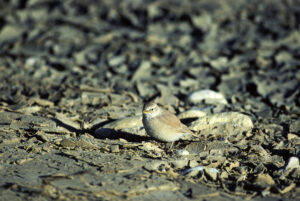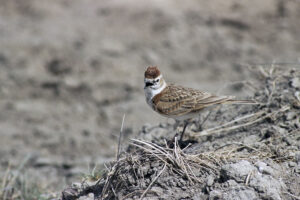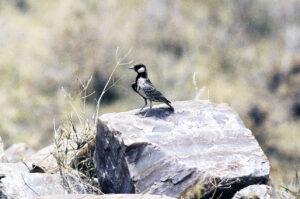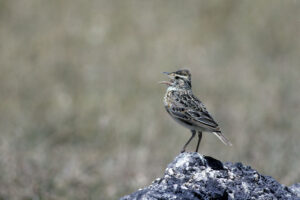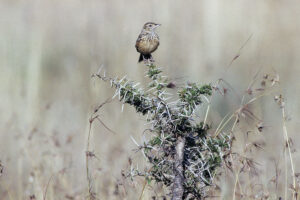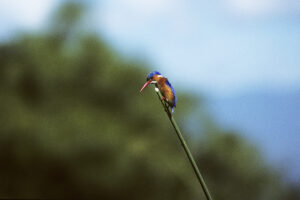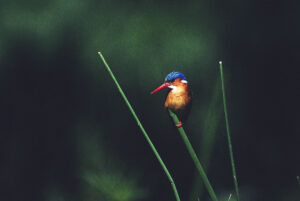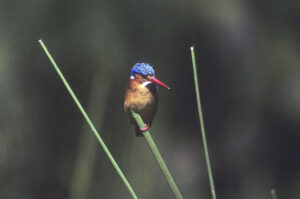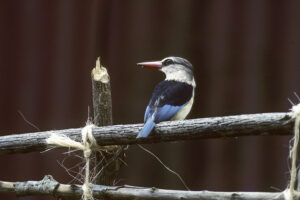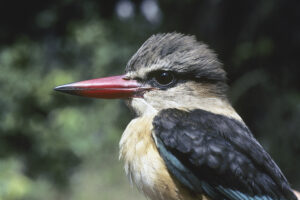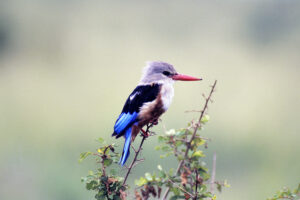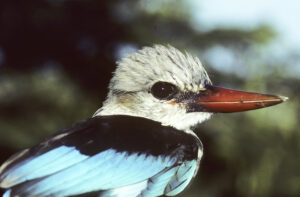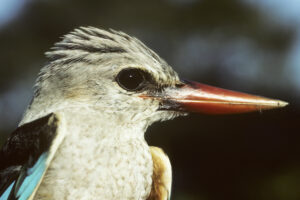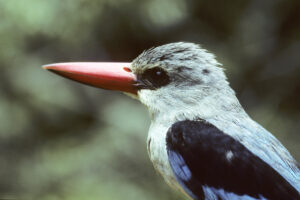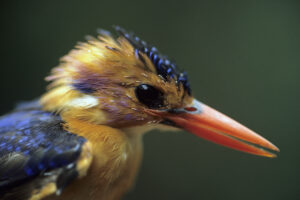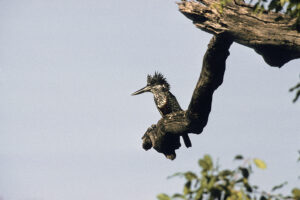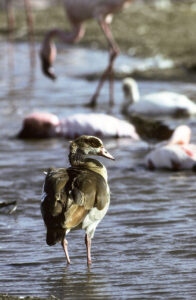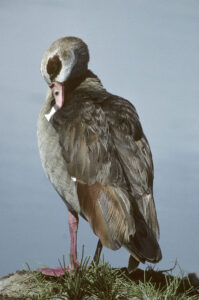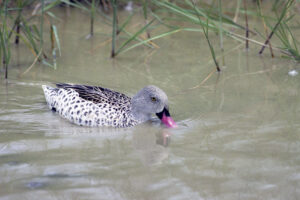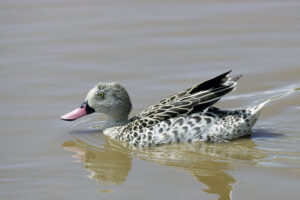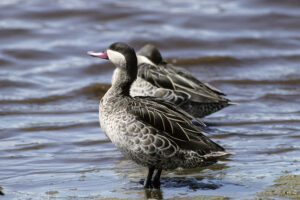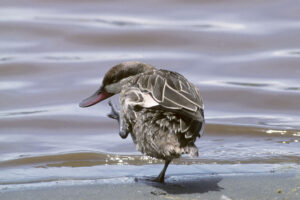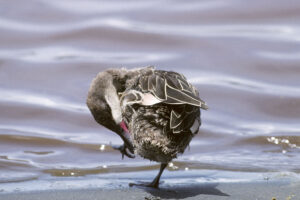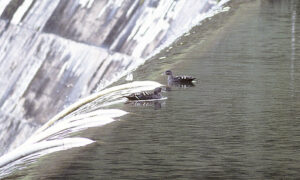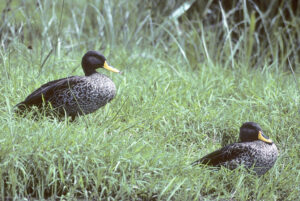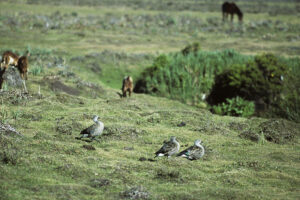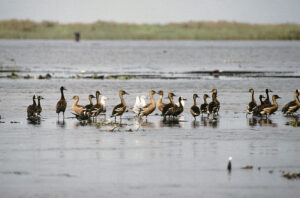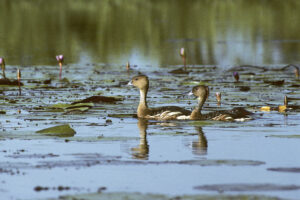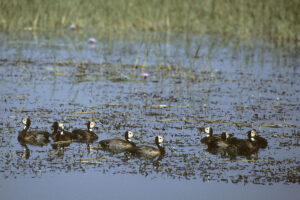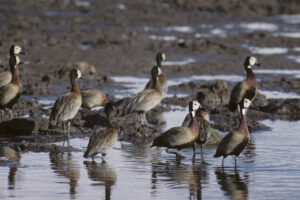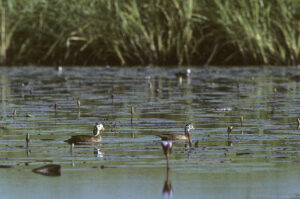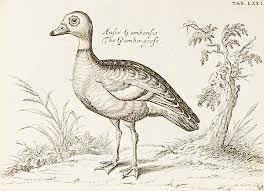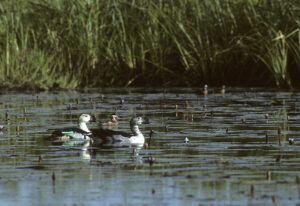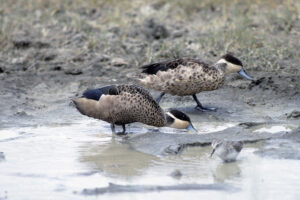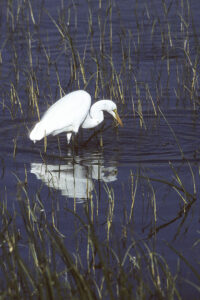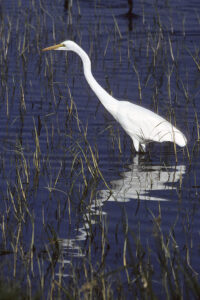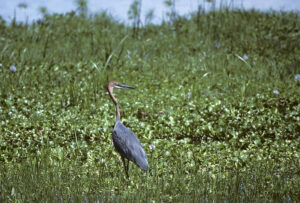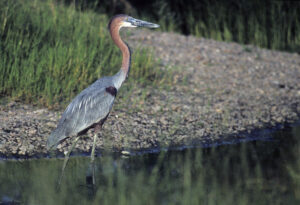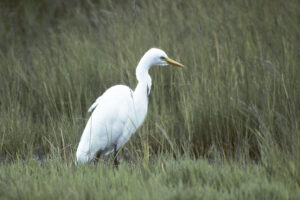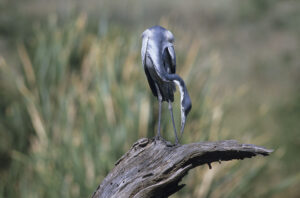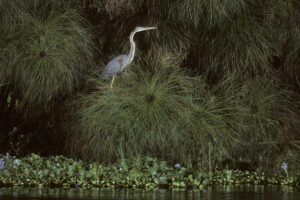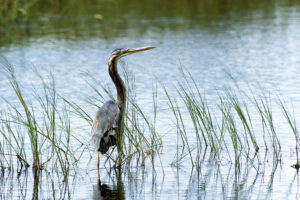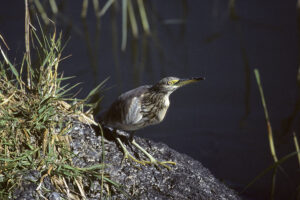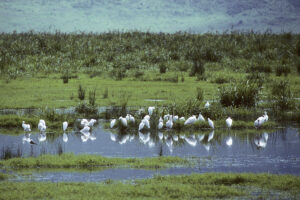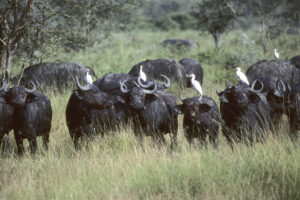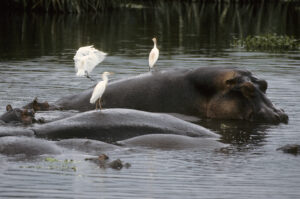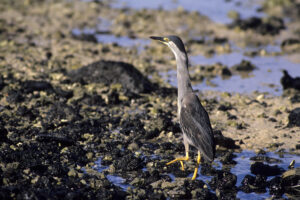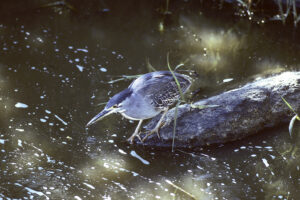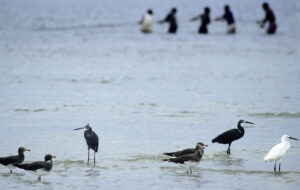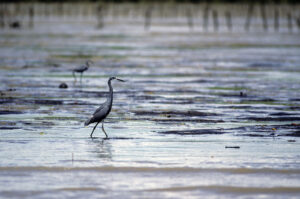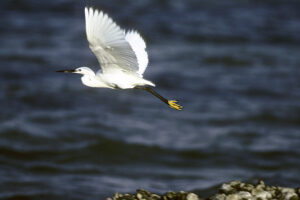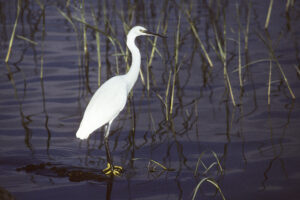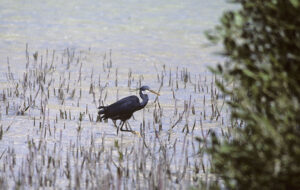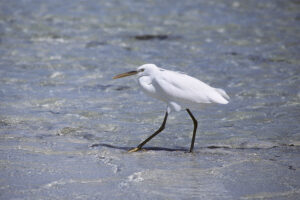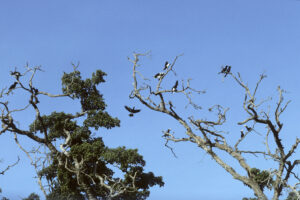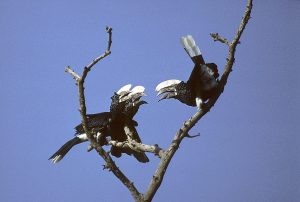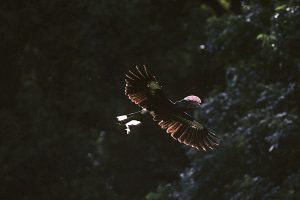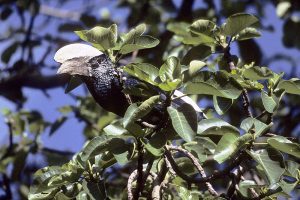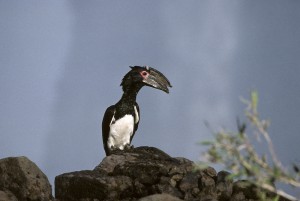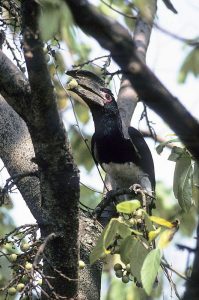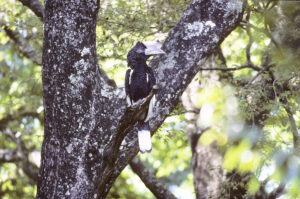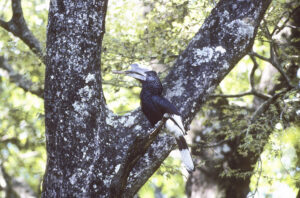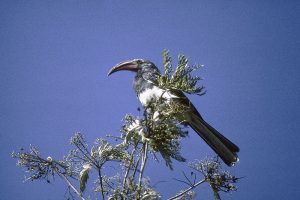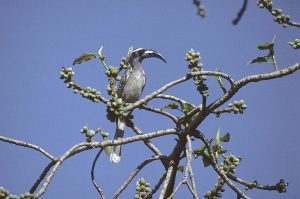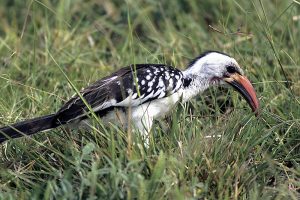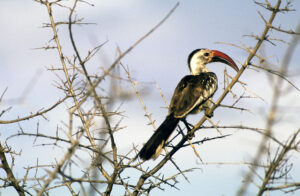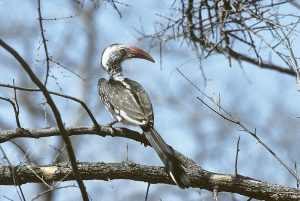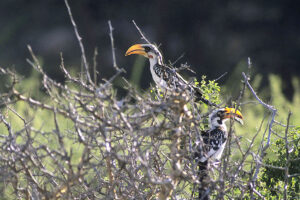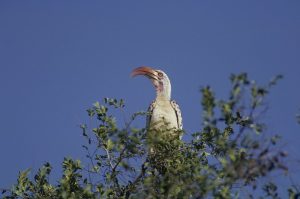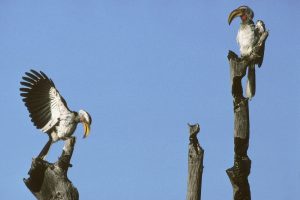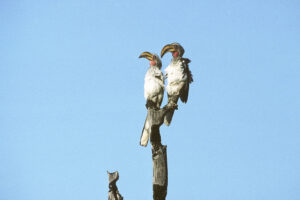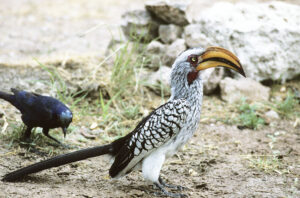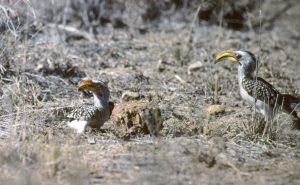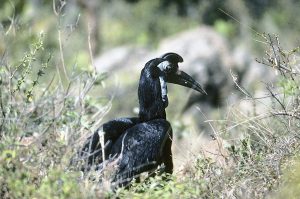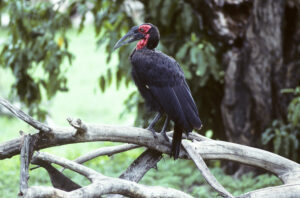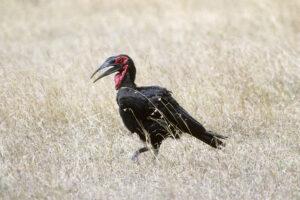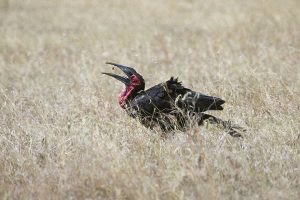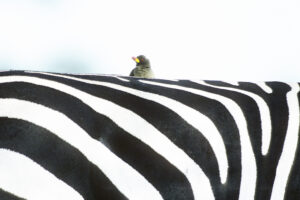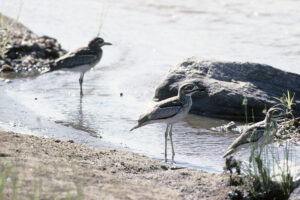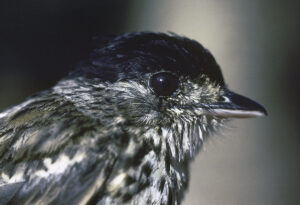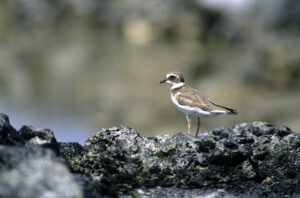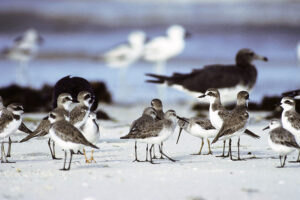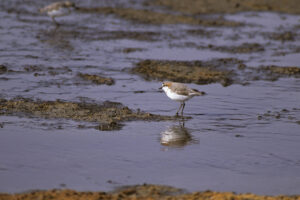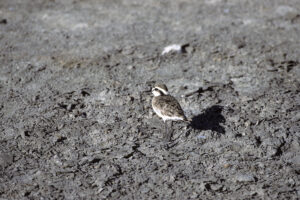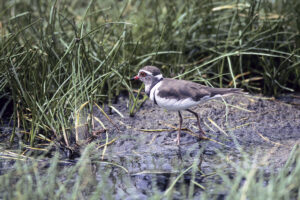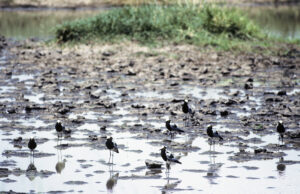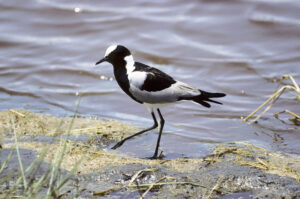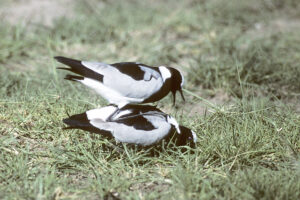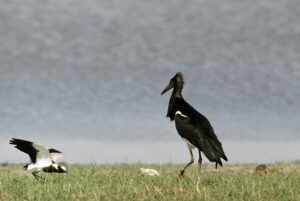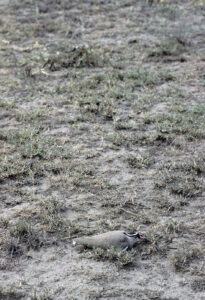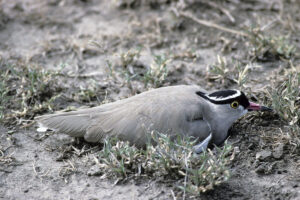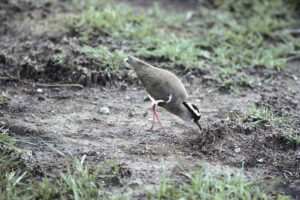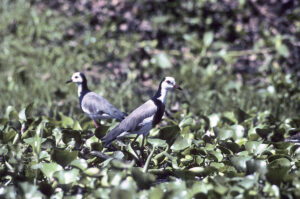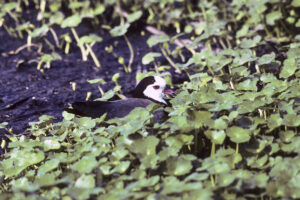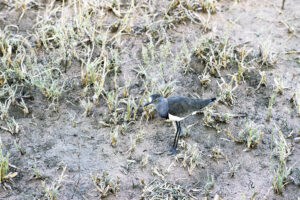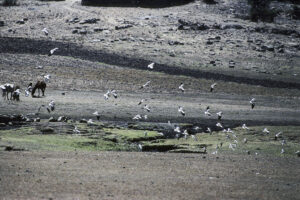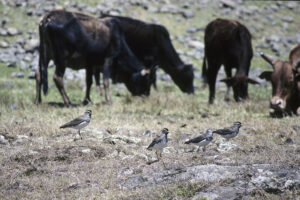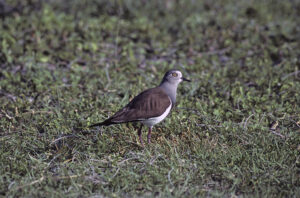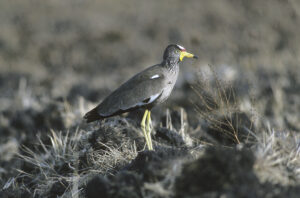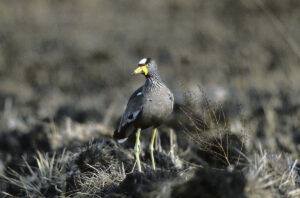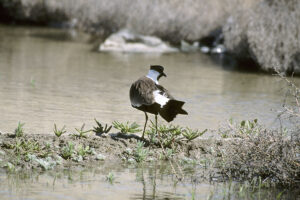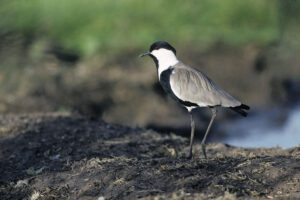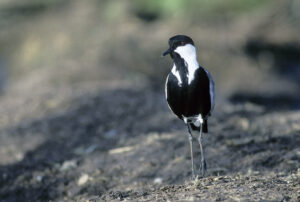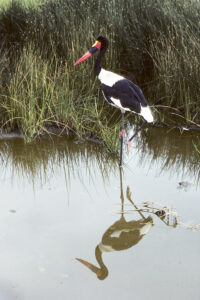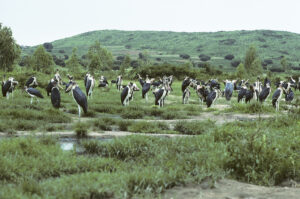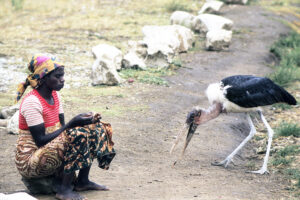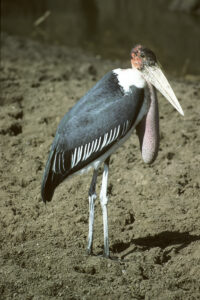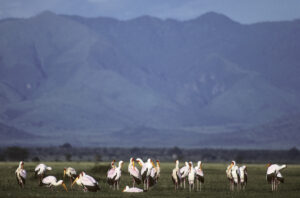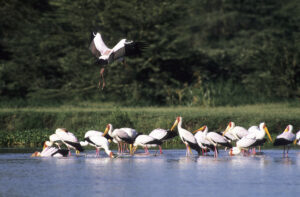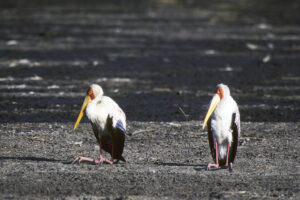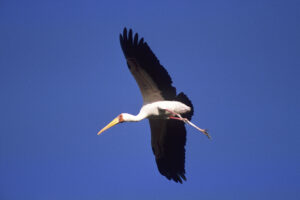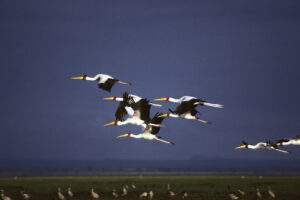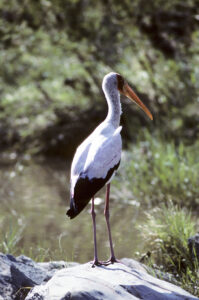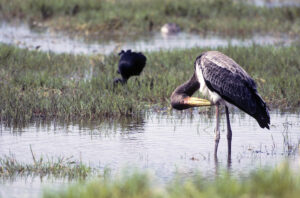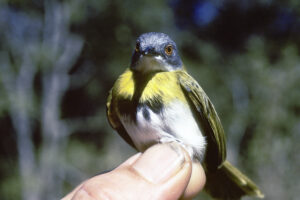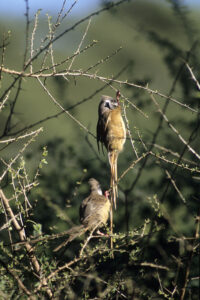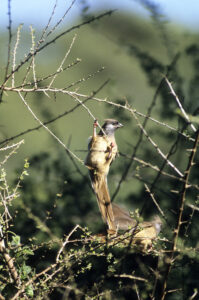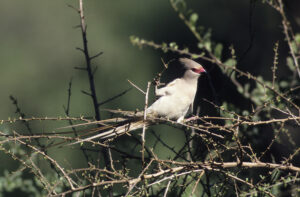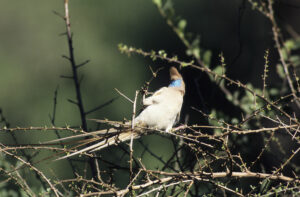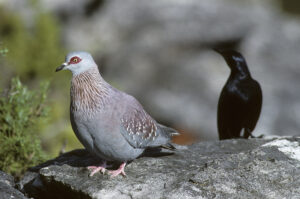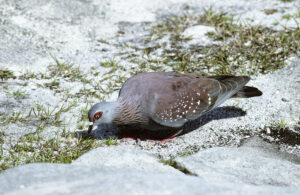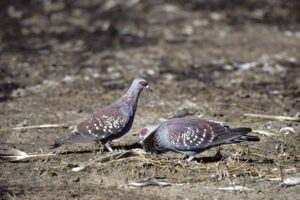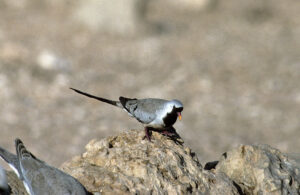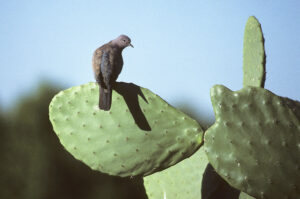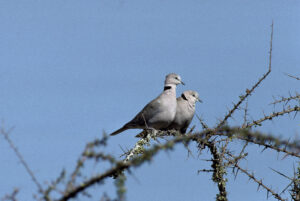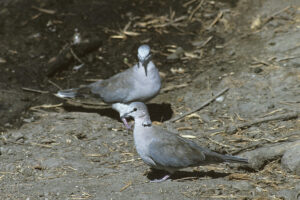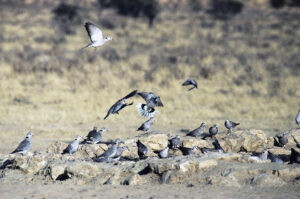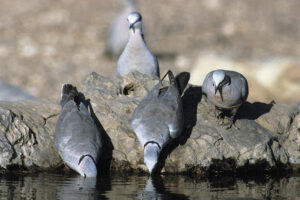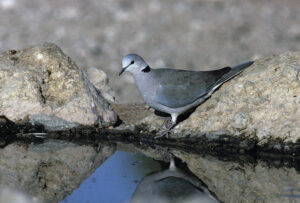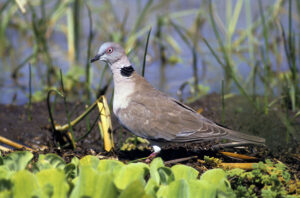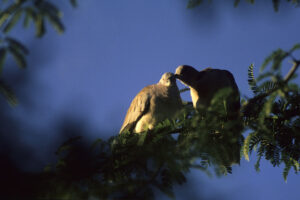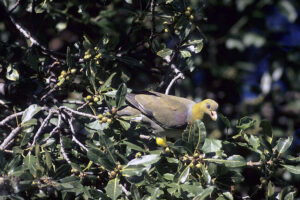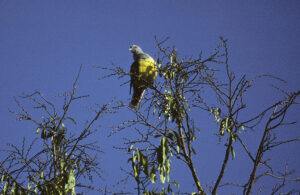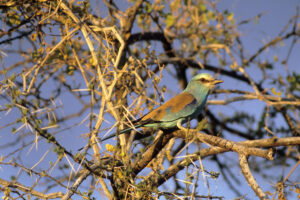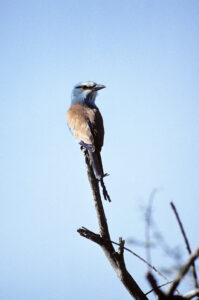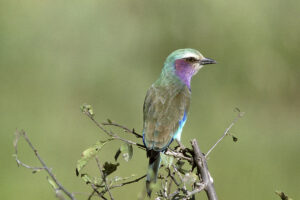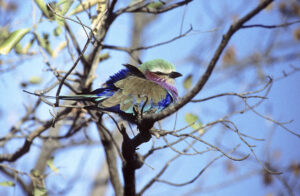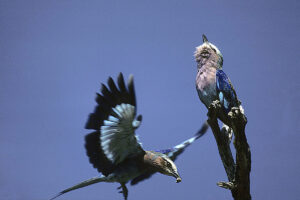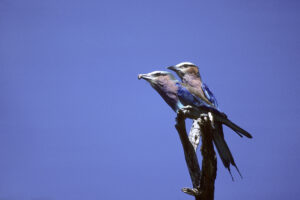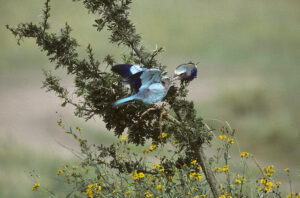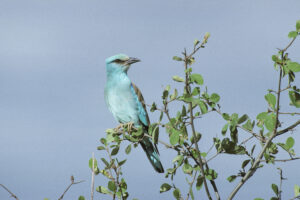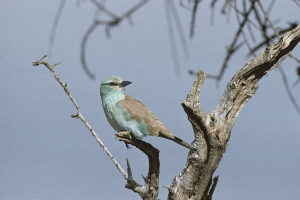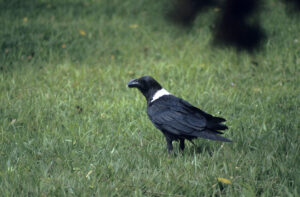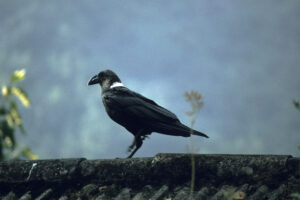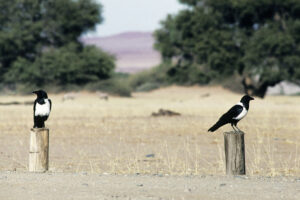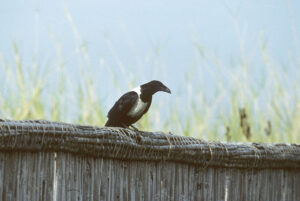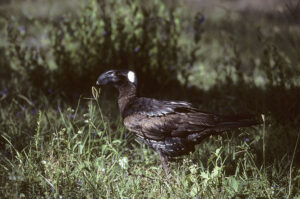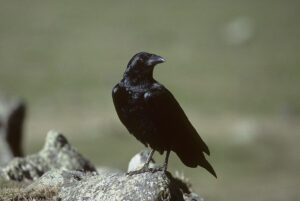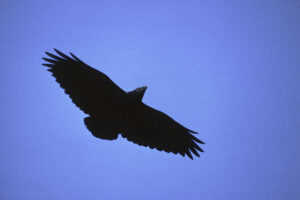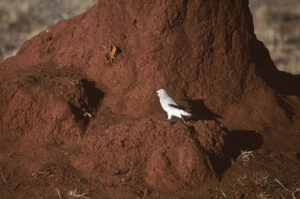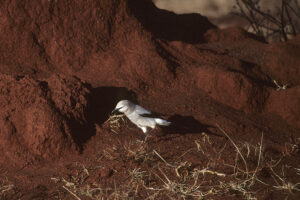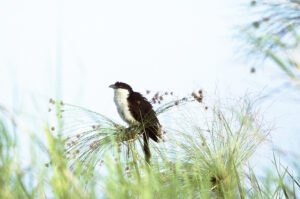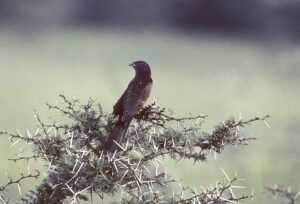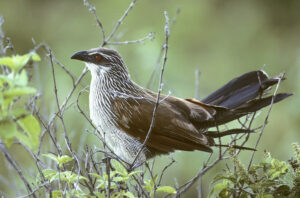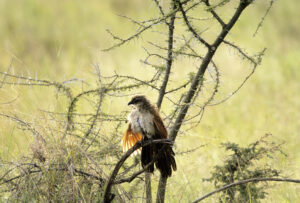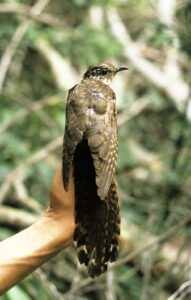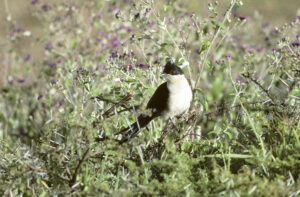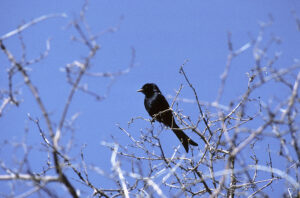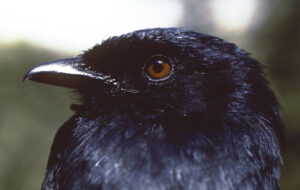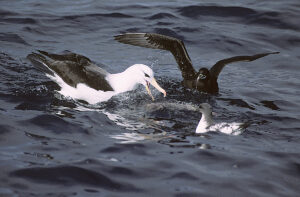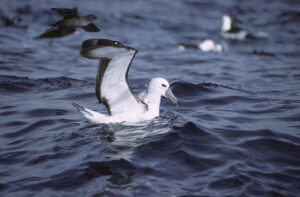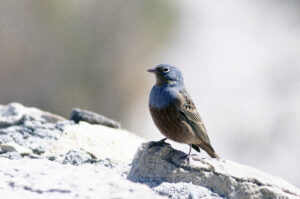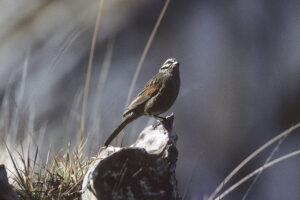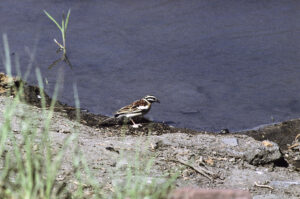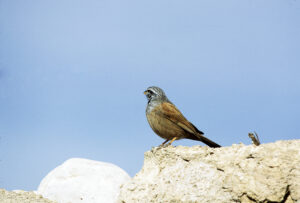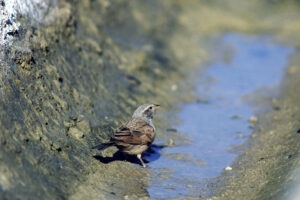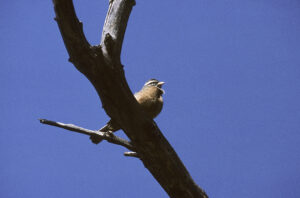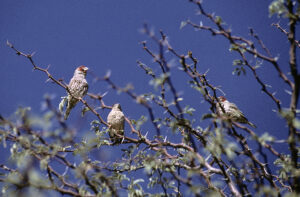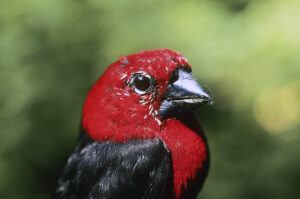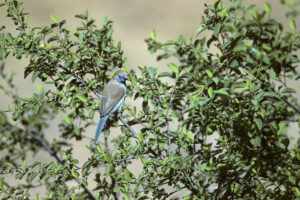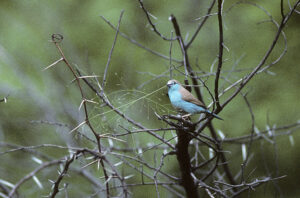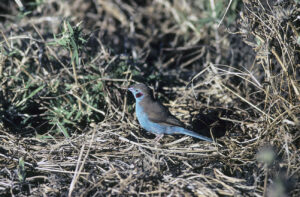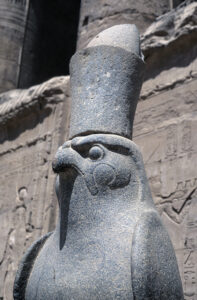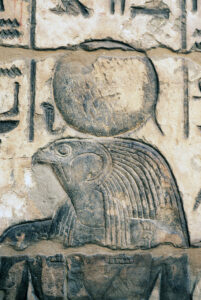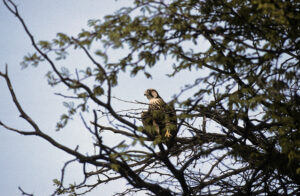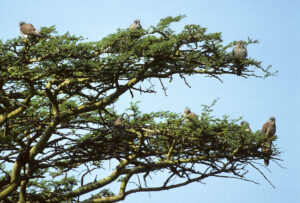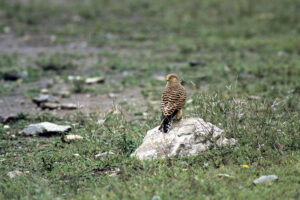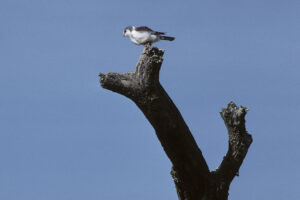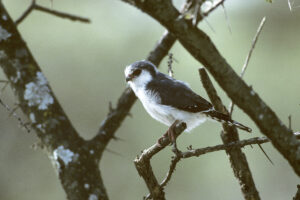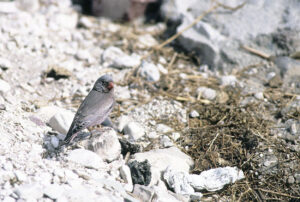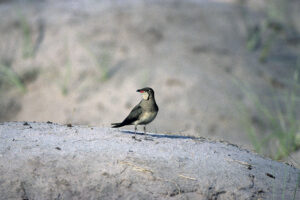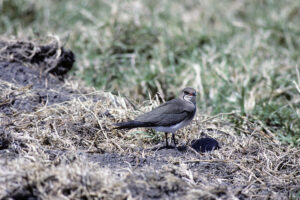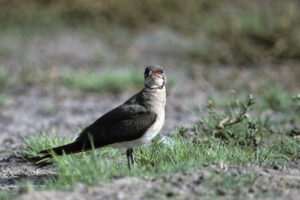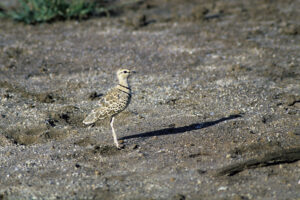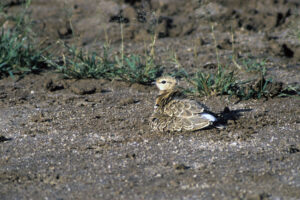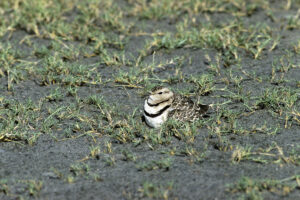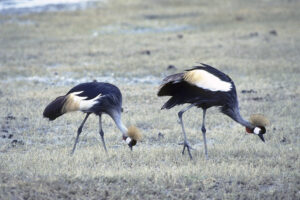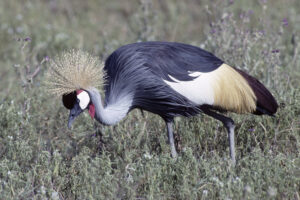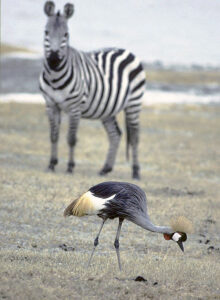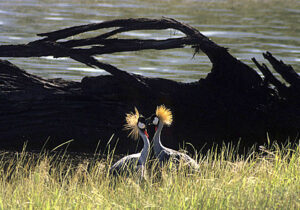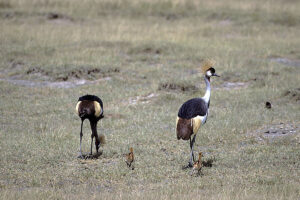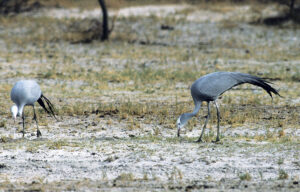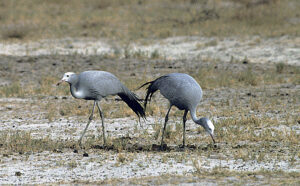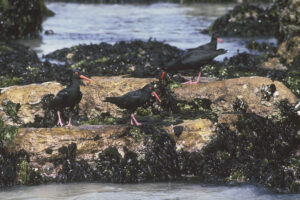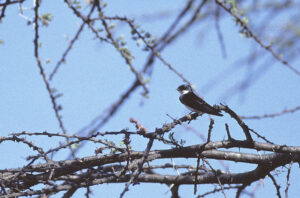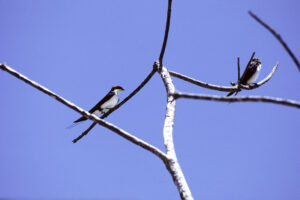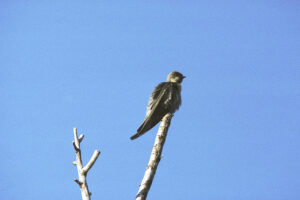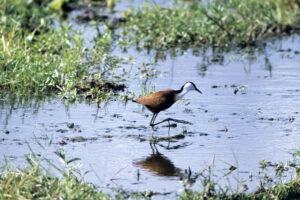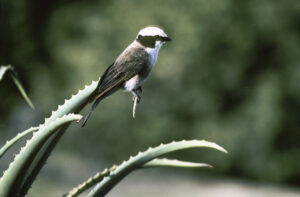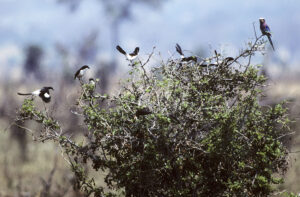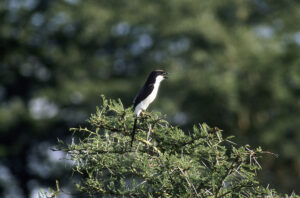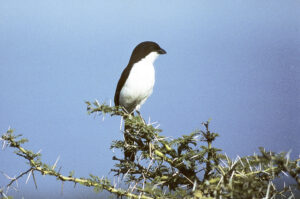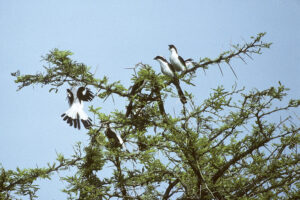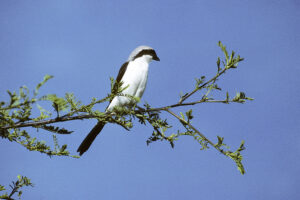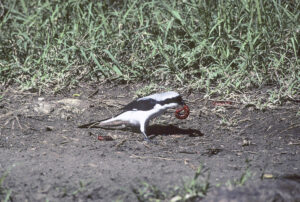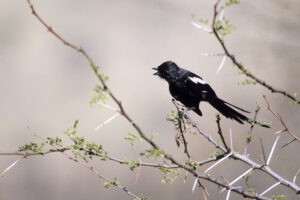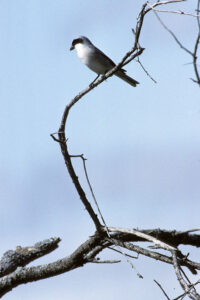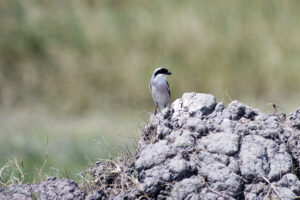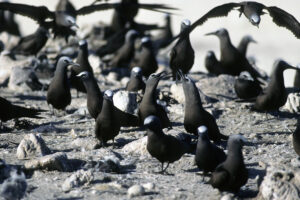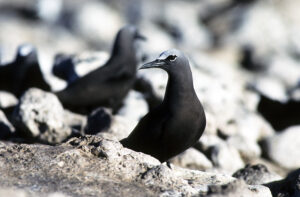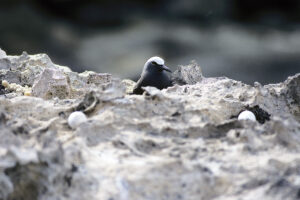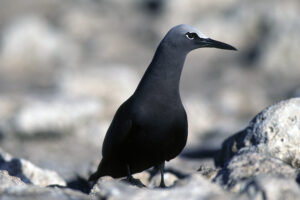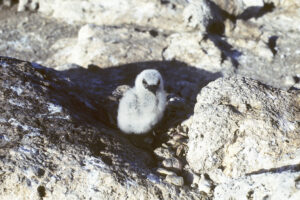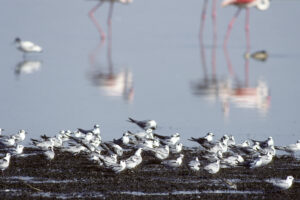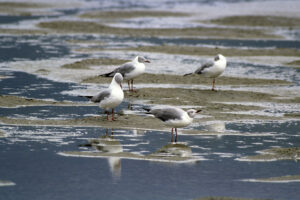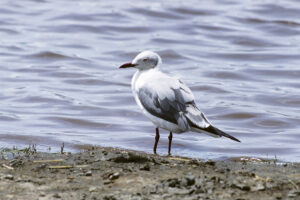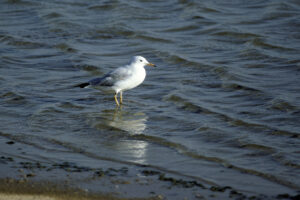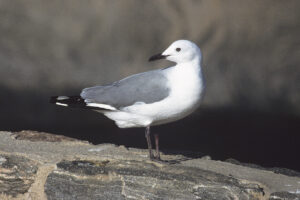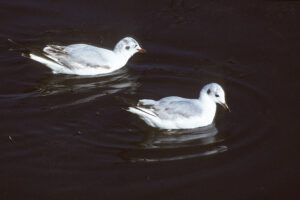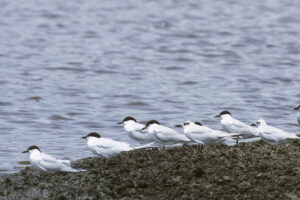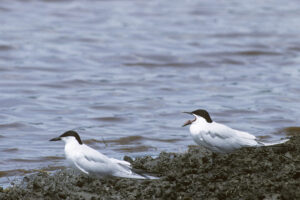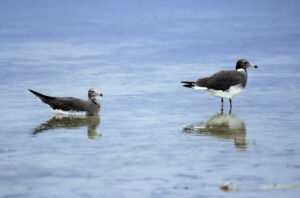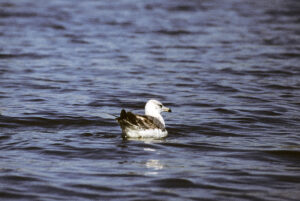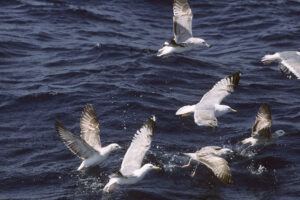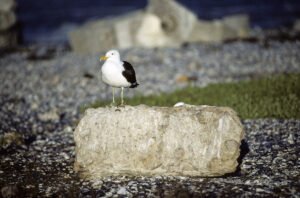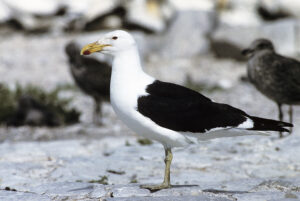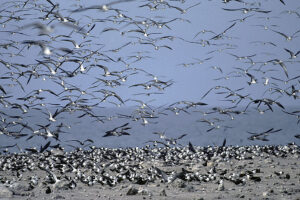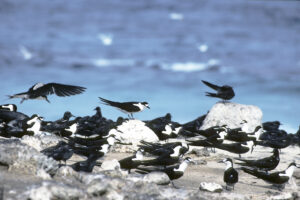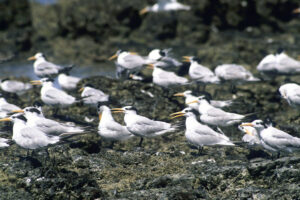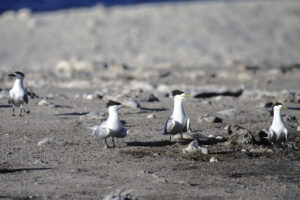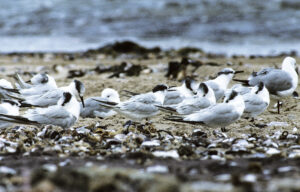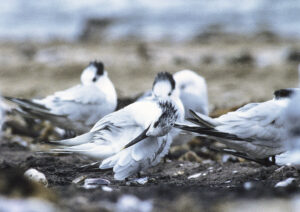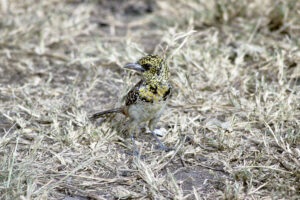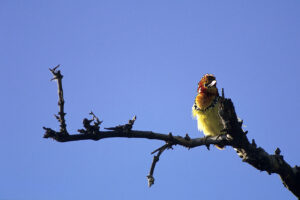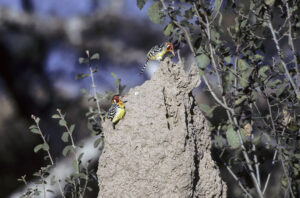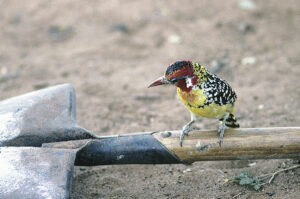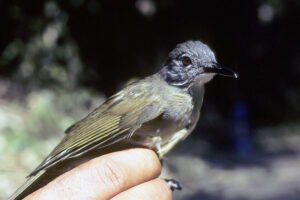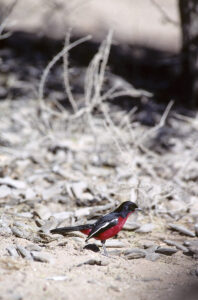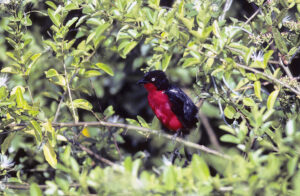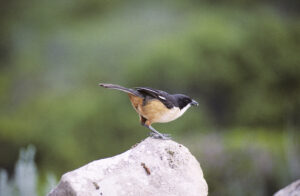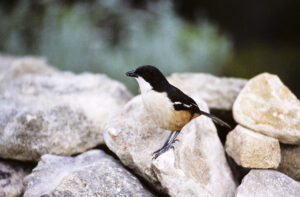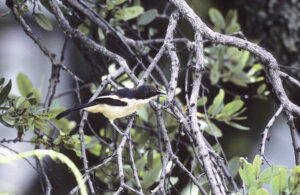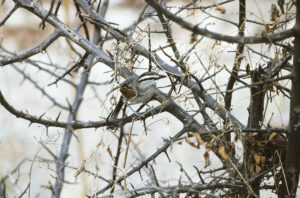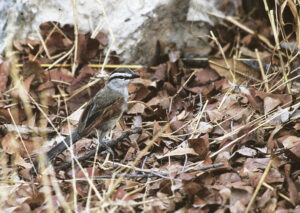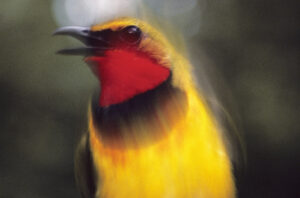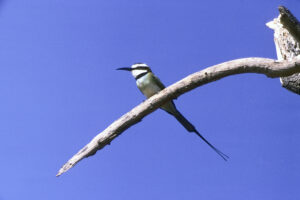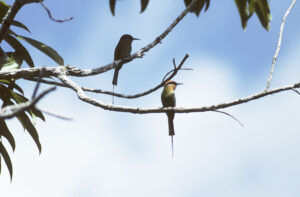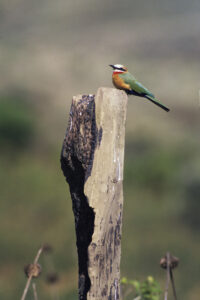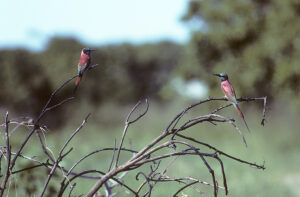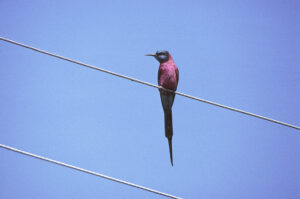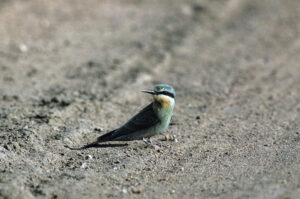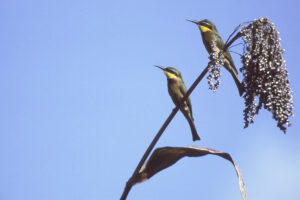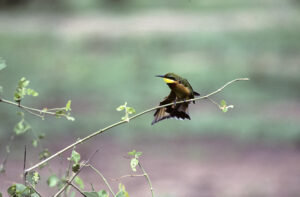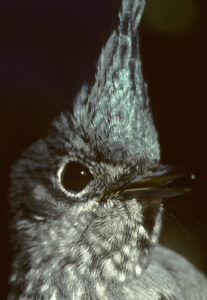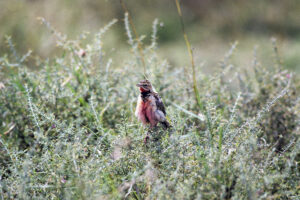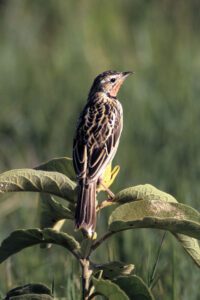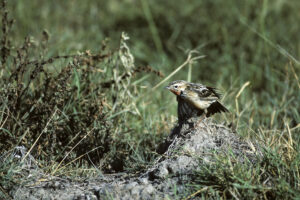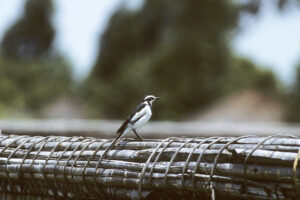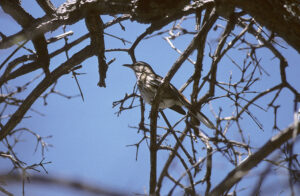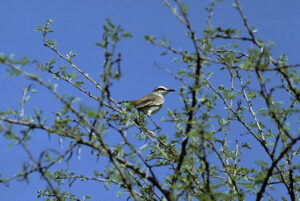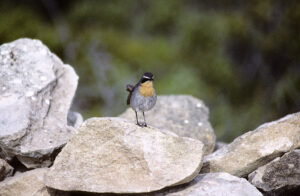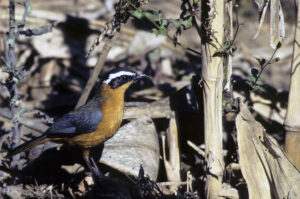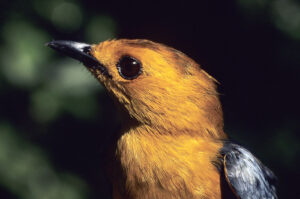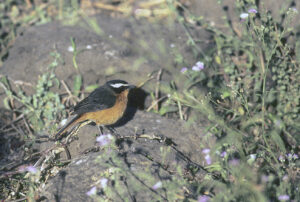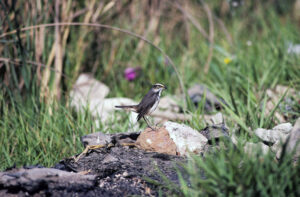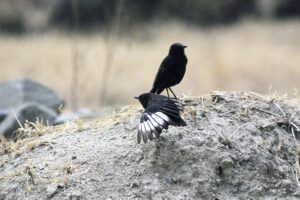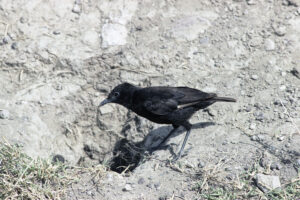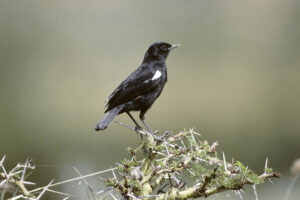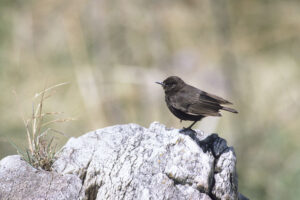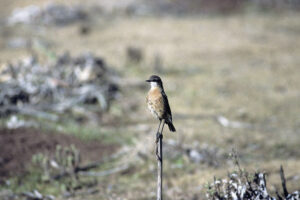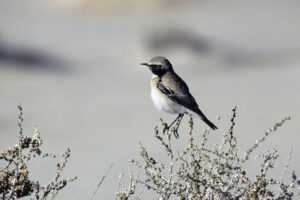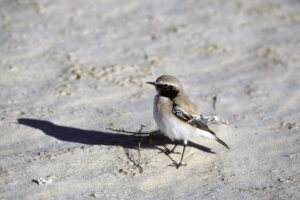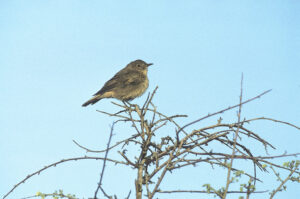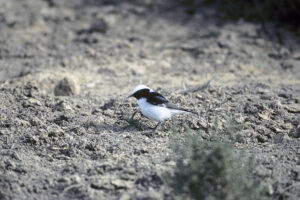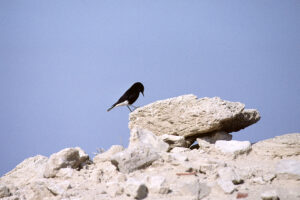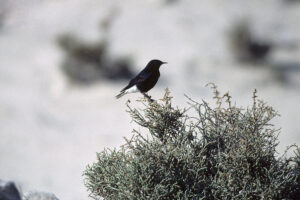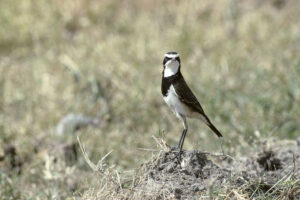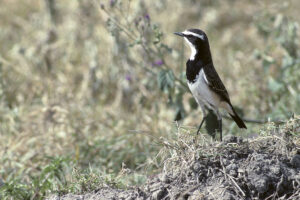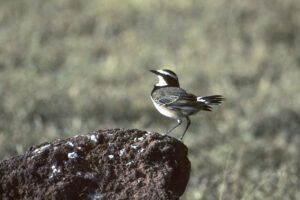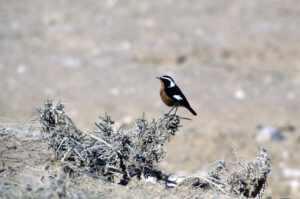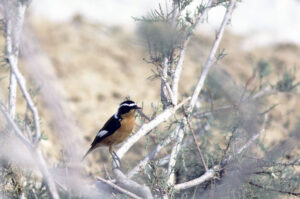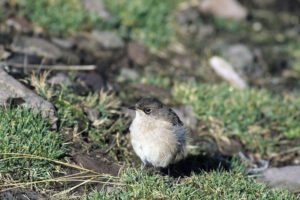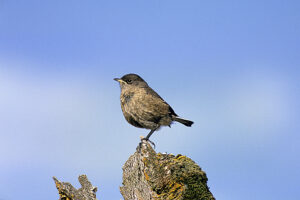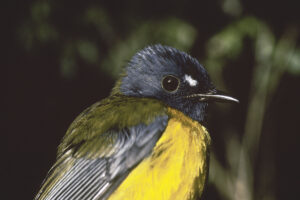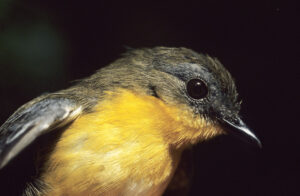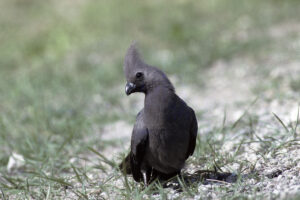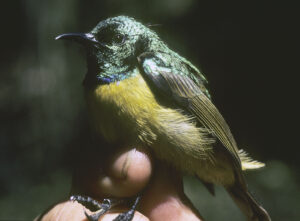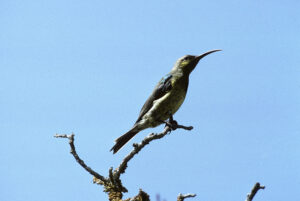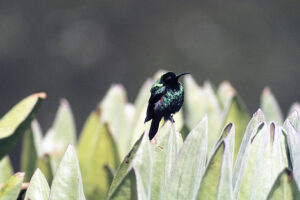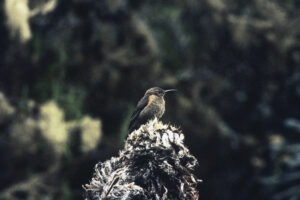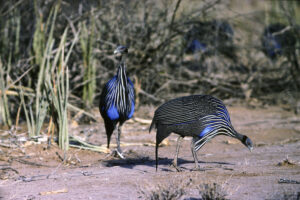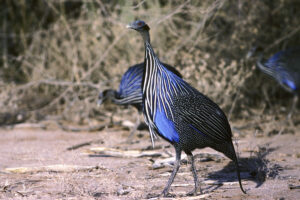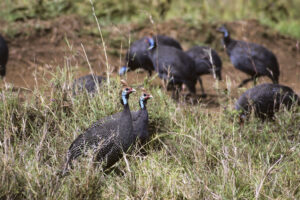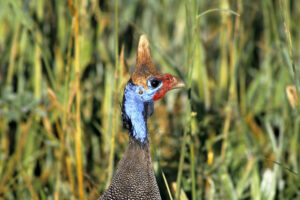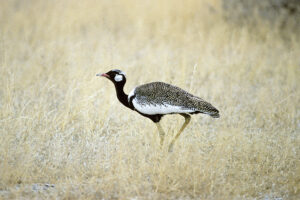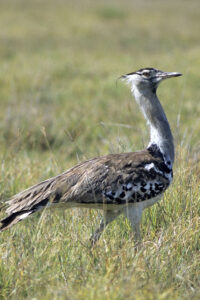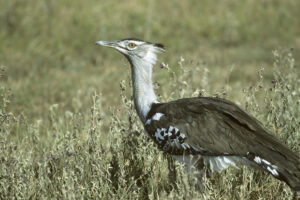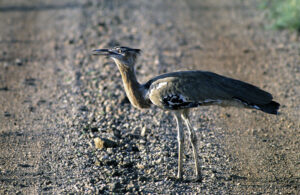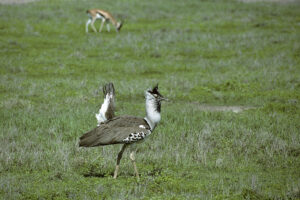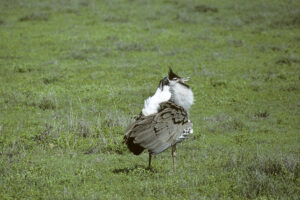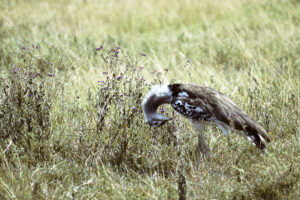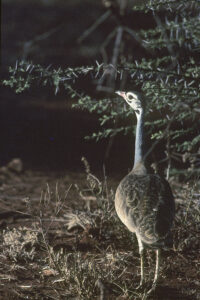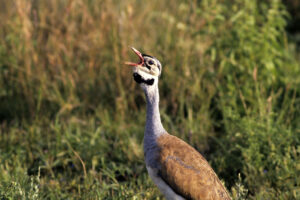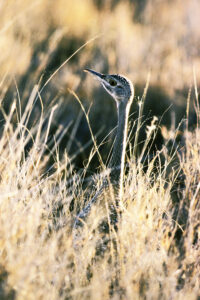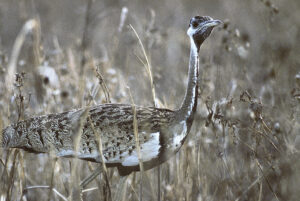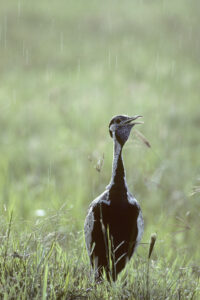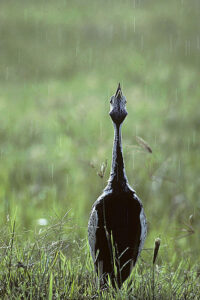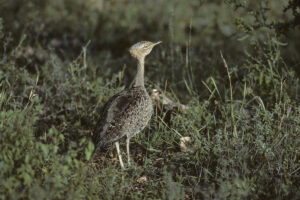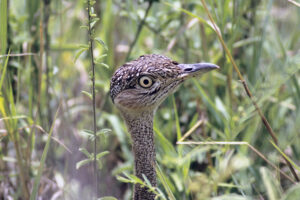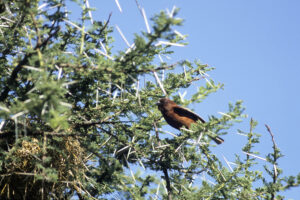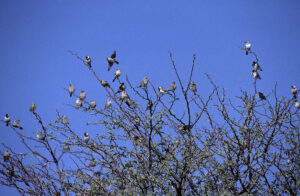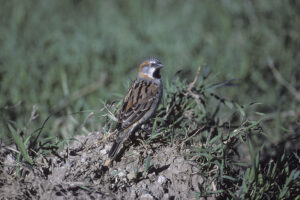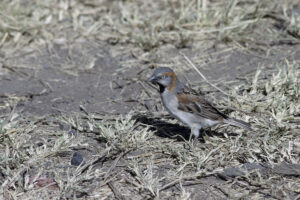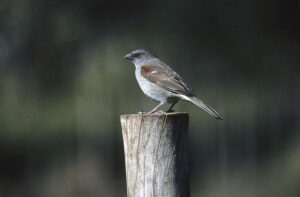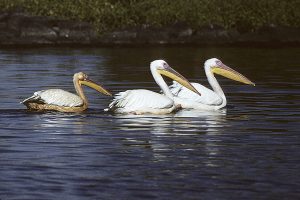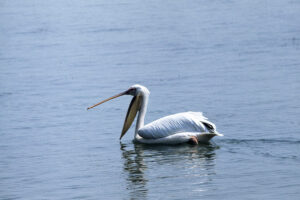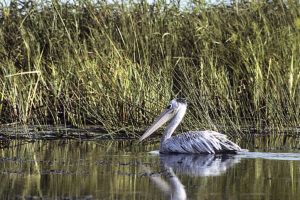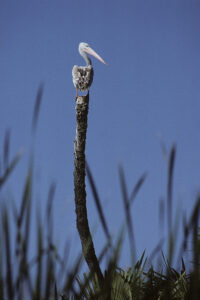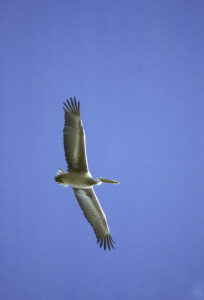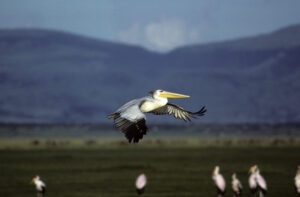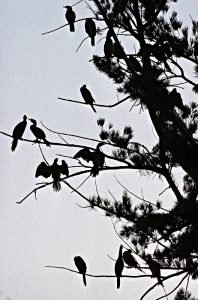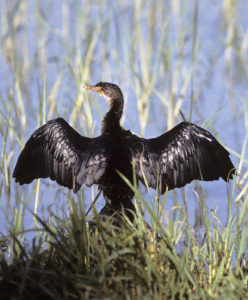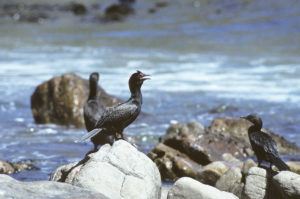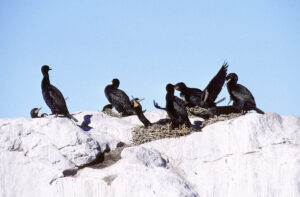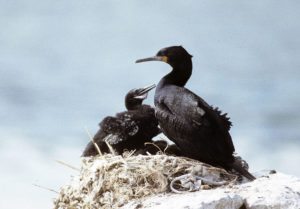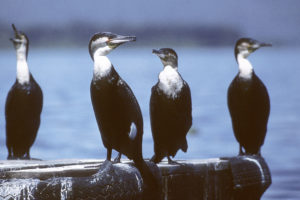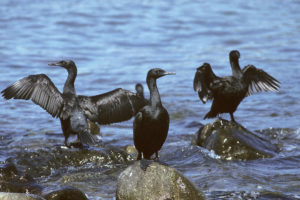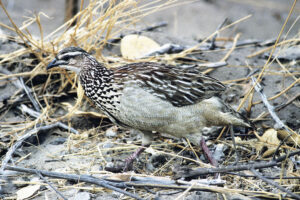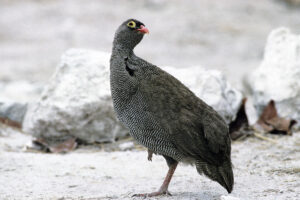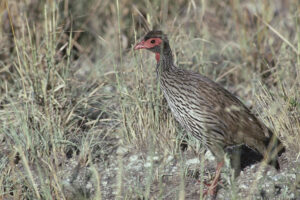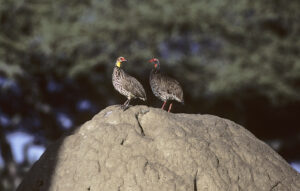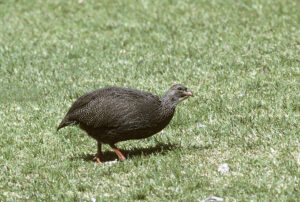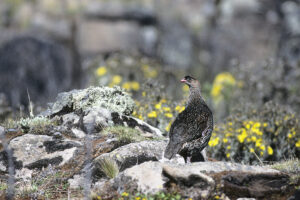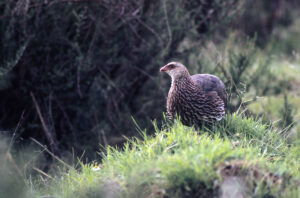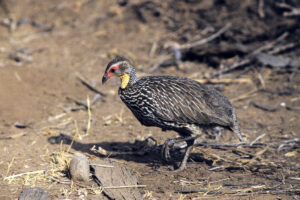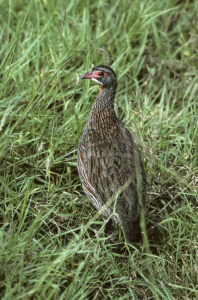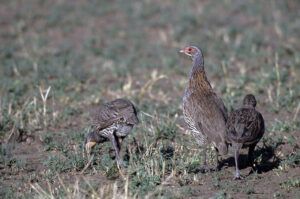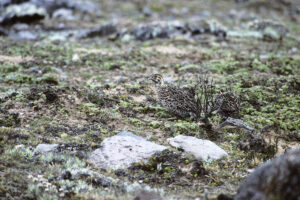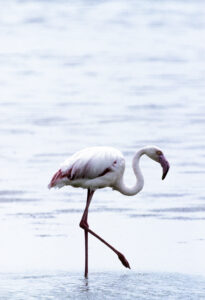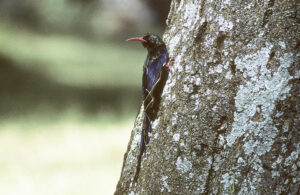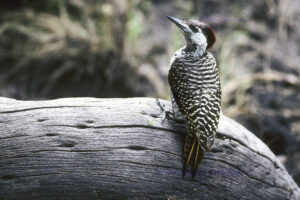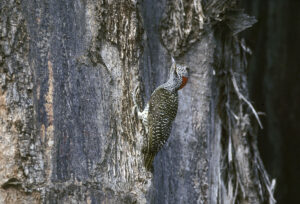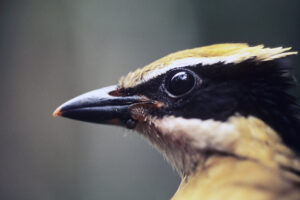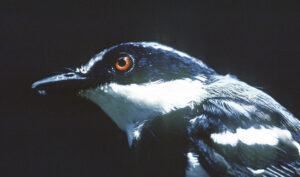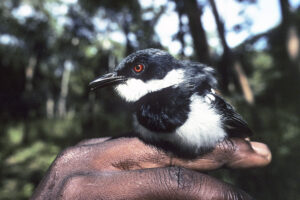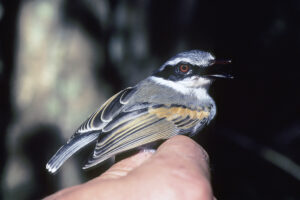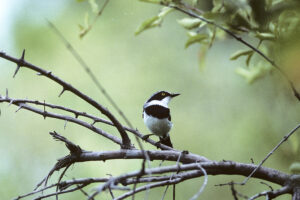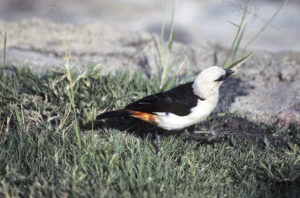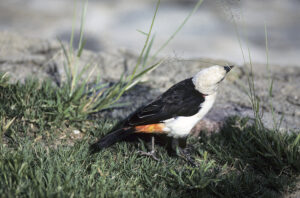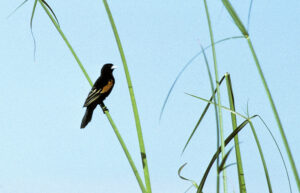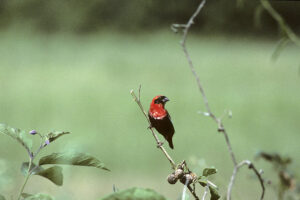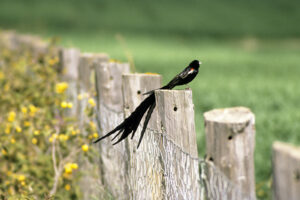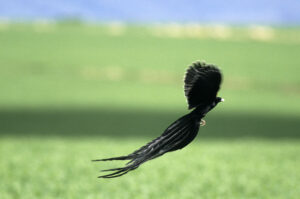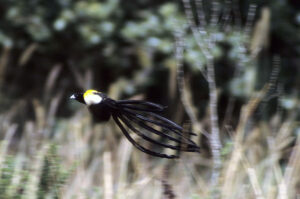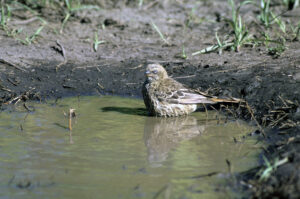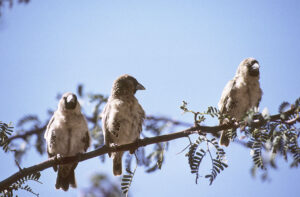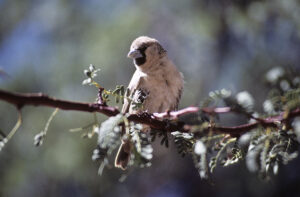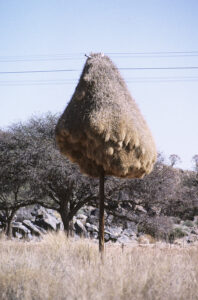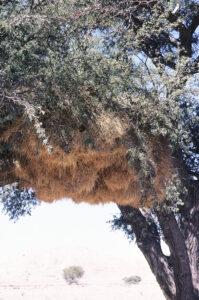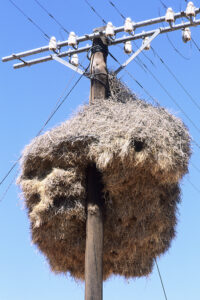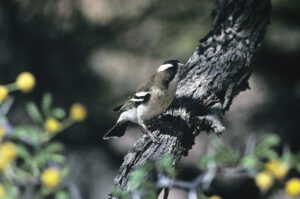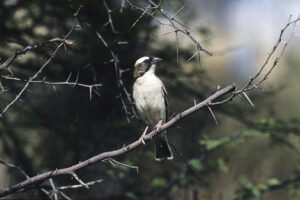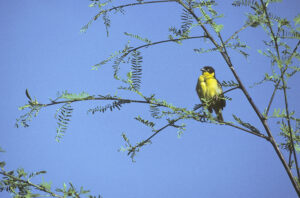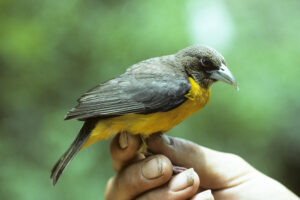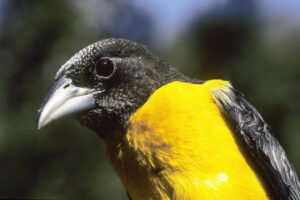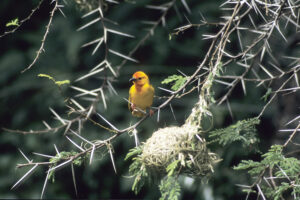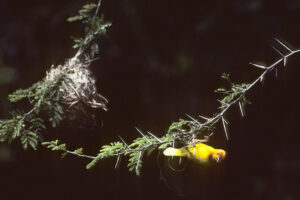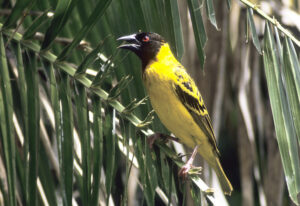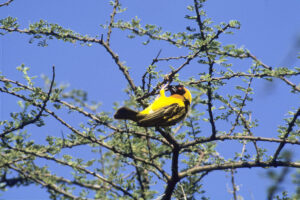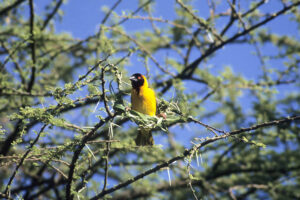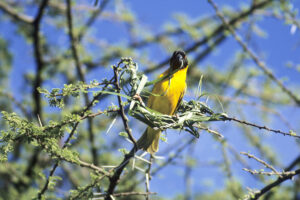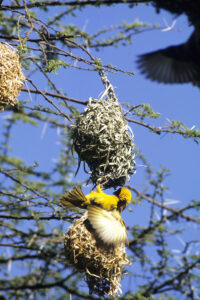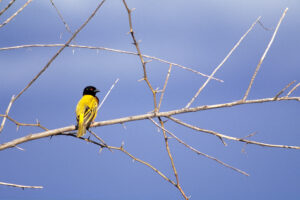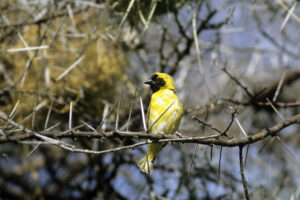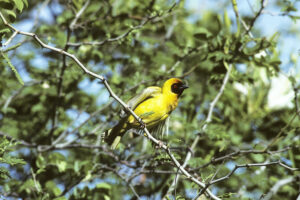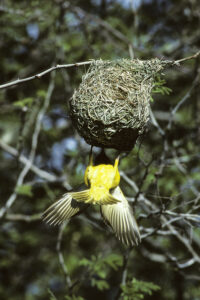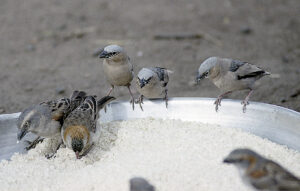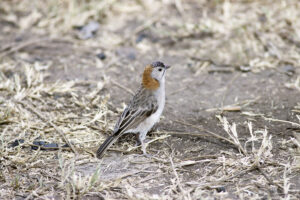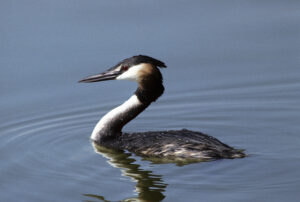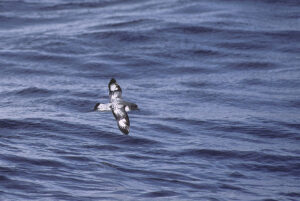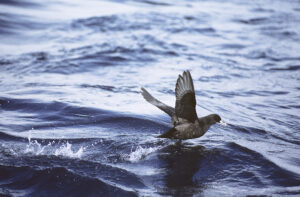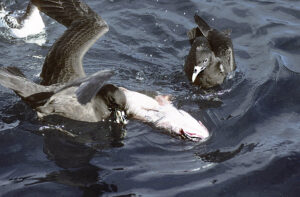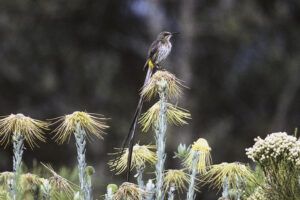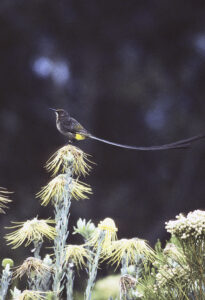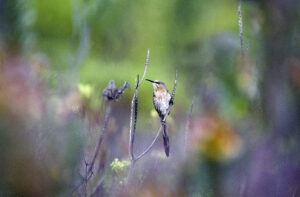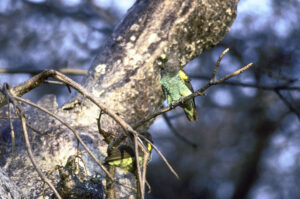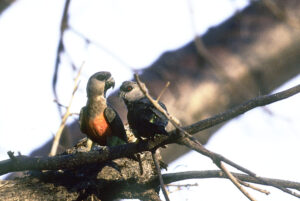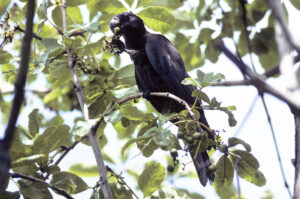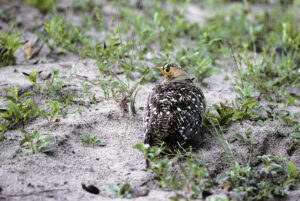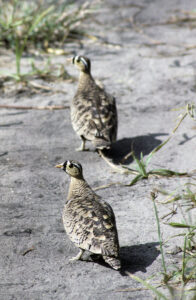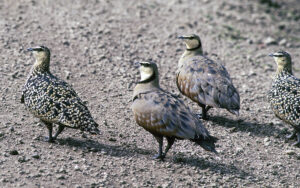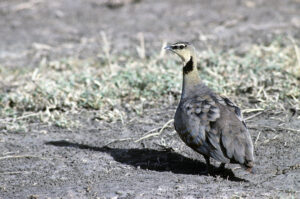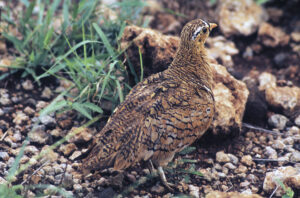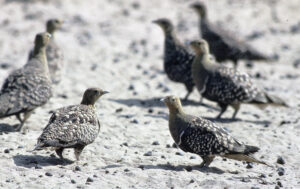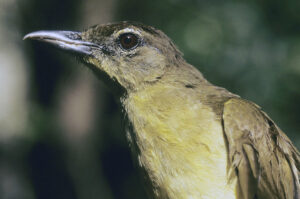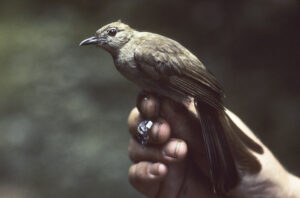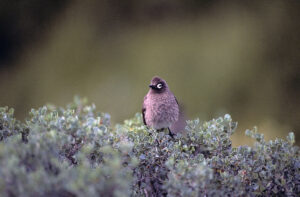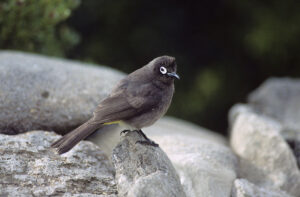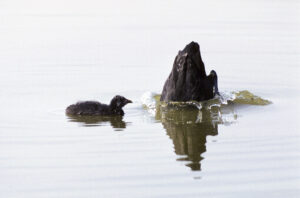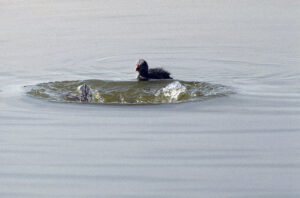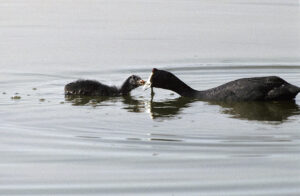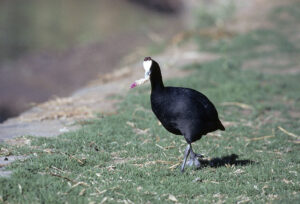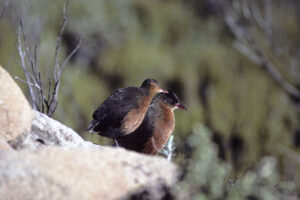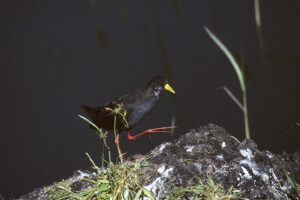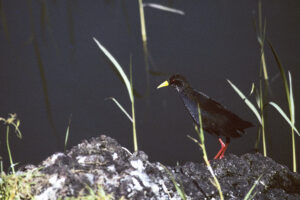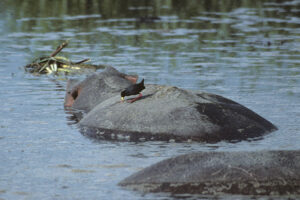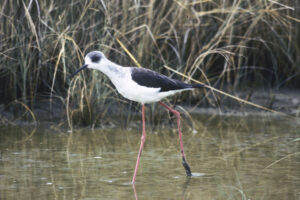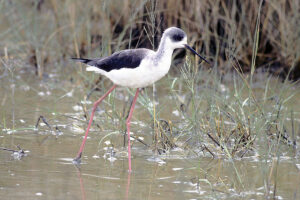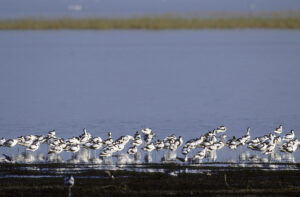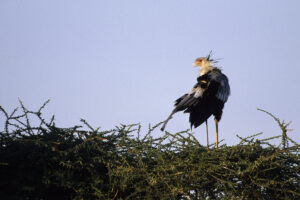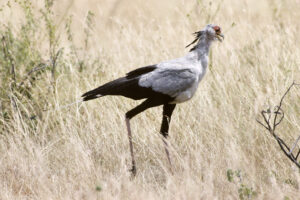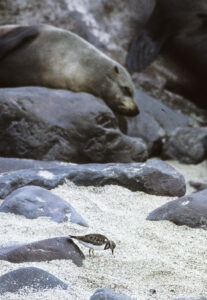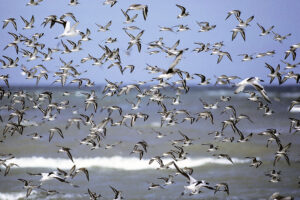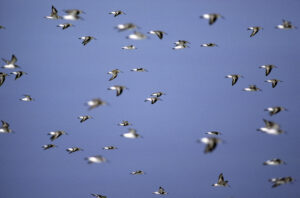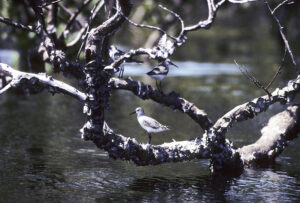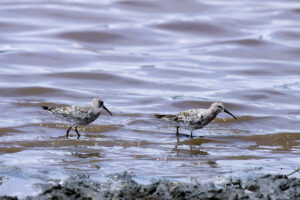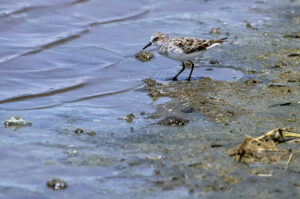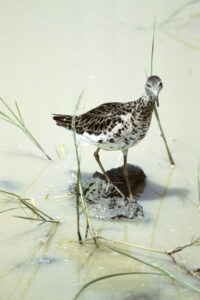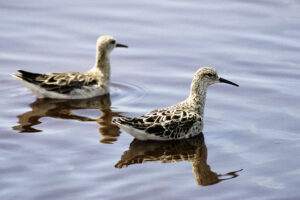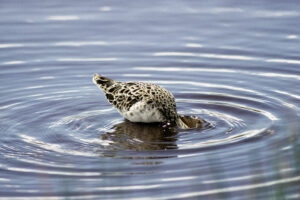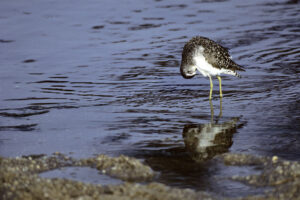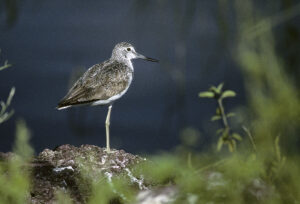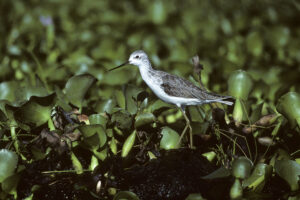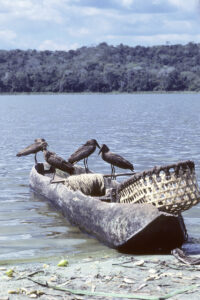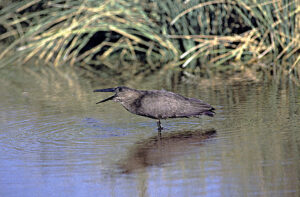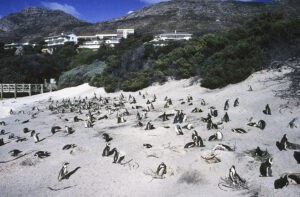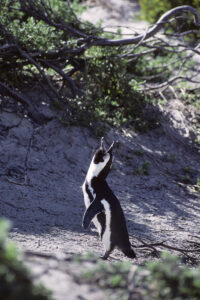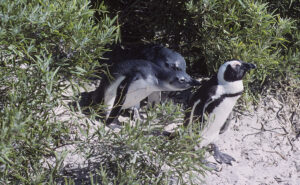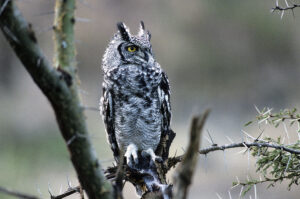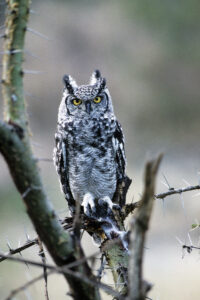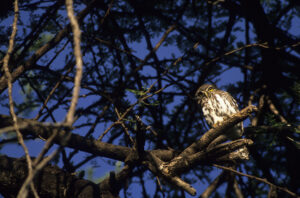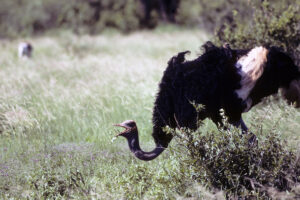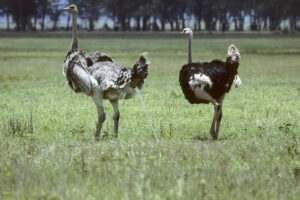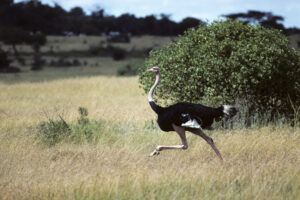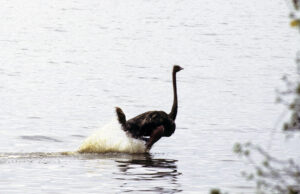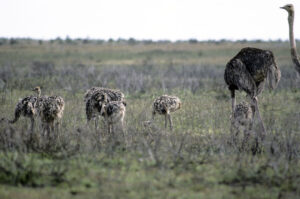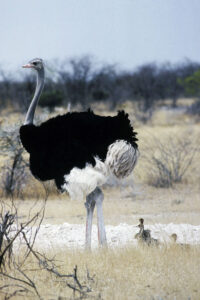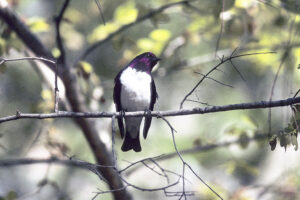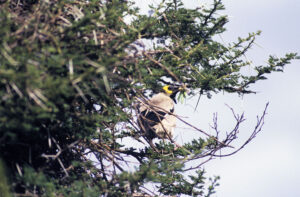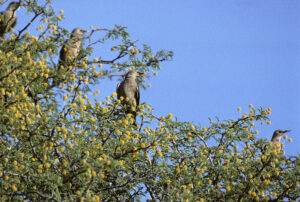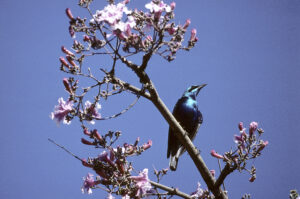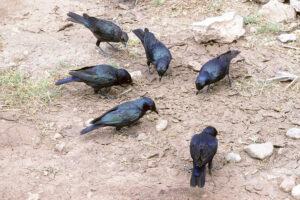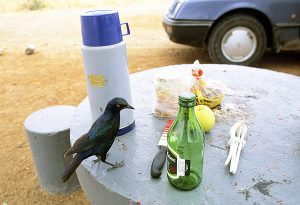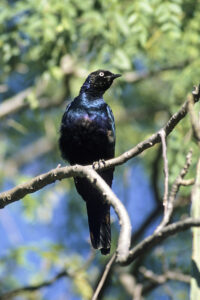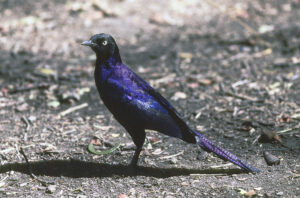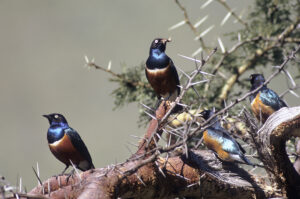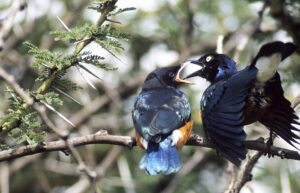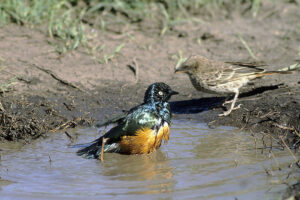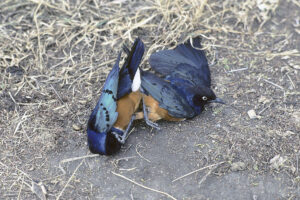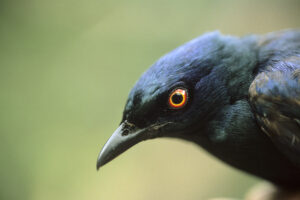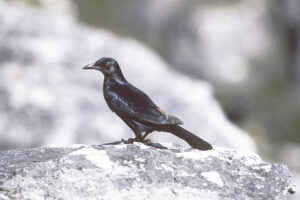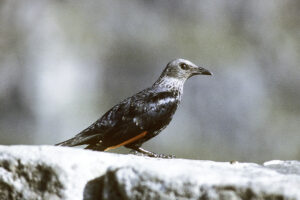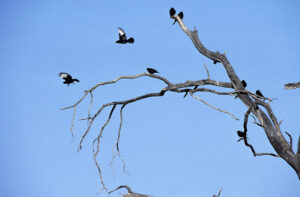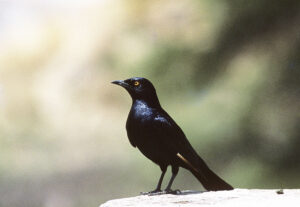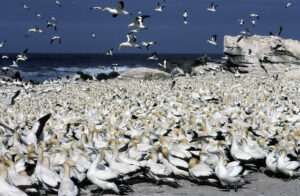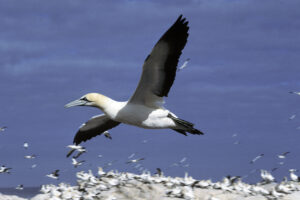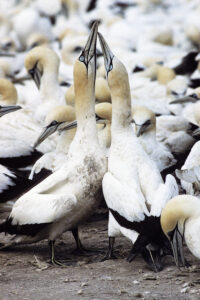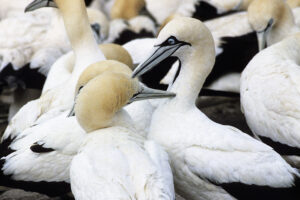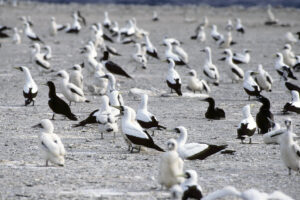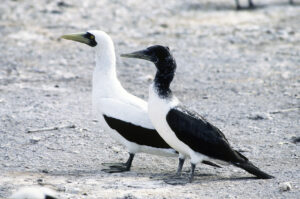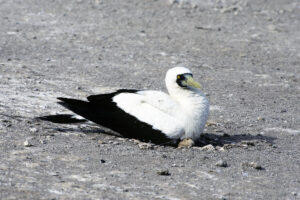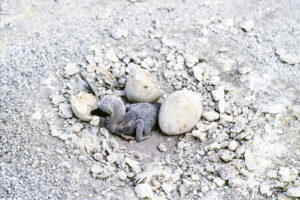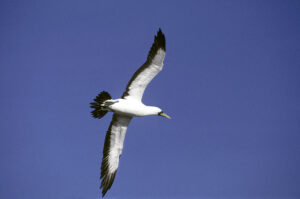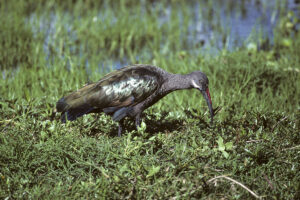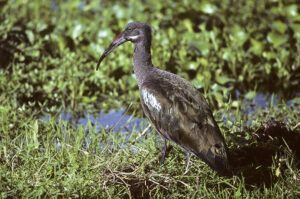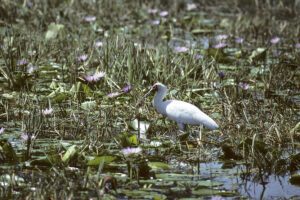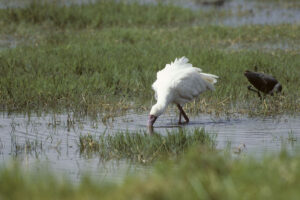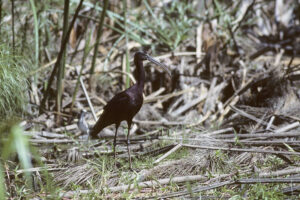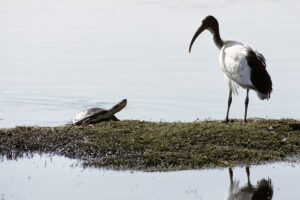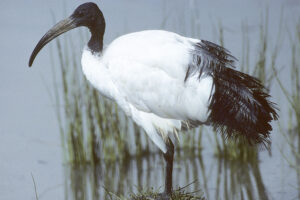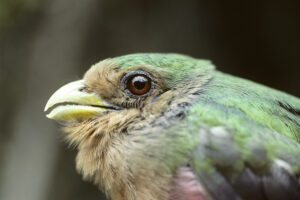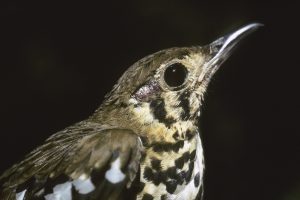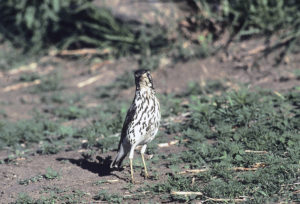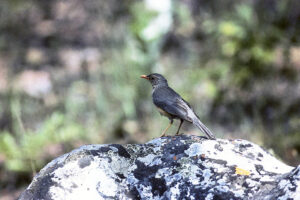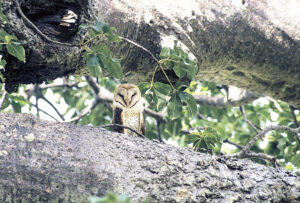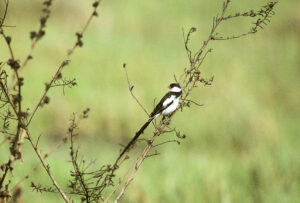Birds in Africa
Tawny eagle (Aquila rapax), swallowing a leg of a hare, Ngorongoro Crater, Tanzania. (Photo copyright © by Kaj Halberg)
Lesser pied kingfisher (Ceryle rudis), perched on a dead acacia branch, Lake Baringo, Kenya. (Photo copyright © by Kaj Halberg)
Male white-bellied bustard (Eupodotis senegalensis) in evening light, Meru National Park, Kenya. (Photo copyright © by Kaj Halberg)
Male village weaver (Ploceus cucullatus), building a nest, Lake Bogoria, Kenya. (Photo copyright © by Kaj Halberg)
In the period 1980-2003, I made altogether 8 prolonged visits, and 3 shorter ones, to Africa. Adventures during these visits are described on the Travel episodes pages, see Africa 1980-81, Zaire 1981, Tanzania 1988, Tanzania 1989, Tanzania 1990, Zambia 1993, and Ethiopia 1996. Other aspects of my stay in Zambia 1993, and a visit to Namibia 1993, are described on the page Countries and places. During these visits, I have managed to photograph a large number of bird species.
In 1988-1993, I participated in four expeditions to Tanzania, the aim of which was to count wintering waders, and to investigate bird life in coastal forests. In the forests, we caught birds in mistnets, and the major part of the portraits below stem from this work.
Families, genera, and species are presented in alphabetical order. The text is largely based on the websites ebird.org and Wikipedia, the etymology most often on J.A. Jobling 2010. The Helm Dictionary of Scientific Bird Names, Christopher Helm, London. Nomenclature largely follows the IOC World Bird List (worldbirdnames.org).
I have used the former name Zaire for the country today officially known as The Democratic Republic of Congo, as I find that name somewhat laborious. Furthermore, you can hardly place the term ‘democratic’ on a country that, for decades, has been pervaded by a chaos of violence.
Accipitridae Hawks, eagles, and allies
A huge family, comprising about 66 genera and c. 250 species of small to large raptors, distributed worldwide, with the exception of Antarctica.
Accipiter Sparrowhawks, goshawks
Comprising 51 species, this is the largest genus in the family. In Europe, these birds are known as sparrowhawks (smaller species) or goshawks (larger species), in America simply as hawks.
The generic name is the classical Latin word for hawk, derived from accipere (‘to grasp’), naturally alluding to the sharp talons.
Accipiter minullus Little sparrowhawk
The smallest species of the genus, with a length of only 23-27 cm, males weighing 75-85 g, females usually a little more, up to 105 g. Its size is reflected in the specific name, from the Latin minulus (‘very small’), diminutive of minus (‘less’).
It occurs in eastern and southern Africa, from Ethiopia and Angola southwards, living in various types of forest, including patches of woodland and scrub, typically along river valleys, sometimes even in suburban gardens.
A male African little sparrowhawk, Accipiter minullus, caught in a mistnet to be ringed, Msumbugwe Forest, northern Tanzania. (Photos copyright © by Kaj Halberg)
Aquila True eagles
A genus of 11 species, found in most parts of the world, except the polar regions, South America, and rainforest areas.
The generic name is the classical Latin word for eagle, perhaps derived from aquilus (‘dark in colour’).
Aquila rapax Tawny eagle
Divided into 3 subspecies, this eagle is breeding in the major part of sub-Saharan Africa, in the Indian Subcontinent, and in scattered locations in north-western Africa, south-western Arabia, and Iran. The plumage is highly variable, with distinct pale and dark morphs, and various intermediate forms.
The specific name is derived from the Latin rapere (‘to seize’).
Tawny eagle, pale morph, looking for fledged young in a nesting colony of wattled starling (Creatophora cinerea), Serengeti National Park, Tanzania. (Photo copyright © by Kaj Halberg)
Tawny eagle, dark morph, Lake Manyara National Park, Tanzania. (Photo copyright © by Kaj Halberg)
Intermediate morph tawny eagles, squabbling over a leg of a hare, Ngorongoro Crater, Tanzania. (Photos copyright © by Kaj Halberg)
Aquila verreauxii Verreaux’s eagle
This striking eagle lives in hilly regions in eastern and southern Africa, the Chad area, and in the south-western part of the Arabian Peninsula. It is a very specialized species, feeding mainly on rock hyraxes (Procavia).
The specific name commemorates French naturalist Jules Verreaux (1807-1873), who visited southern Africa in the late 1820s. He collected the type specimen there.
Verreaux’s eagle with nesting material, Lake Manyara National Park, Tanzania. (Photo copyright © by Kaj Halberg)
Buteo Buzzards
A genus of about 28 species, distributed on all continents, except Australia and Antarctica. In the Old World, these birds are known as buzzards, whereas the term hawk is often used in North America.
The generic name is the classical Latin name of the common buzzard (B. buteo). The English name is derived from Old French busard, which is a corruption of the classical Latin name.
Buteo augur Augur buzzard
Most adult birds are very distinct, with white underside, blackish back, and orange-red tail. However, the plumage varies, and a dark morph also exists. Young birds are brownish. This is mainly a species of highland grasslands, usually above an elevation of 2,000 m, occasionally observed up to 5,000 m. It is distributed from Ethiopia southwards through eastern Africa to Zimbabwe, with separate populations in western Angola and Namibia.
An augur was a priest in Ancient Rome, whose main role was to interprete the will of the gods by studying the flight of birds – whether they were flying in groups or alone, what kind of noise they made, the direction of flight, and what kind of birds they were. The observation of eagles, hawks, and owls was particularly significant. Why the name was applied to this particular species is not clear.
Augur buzzard, Ngorongoro Conservation Area, Tanzania. (Photo copyright © by Kaj Halberg)
Augur buzzard, taking off, Serengeti National Park, Tanzania. (Photos copyright © by Kaj Halberg)
Augur buzzard, Sanetti Plateau, Bale Mountains, Ethiopia. (Photo copyright © by Kaj Halberg)
Buteo oreophilus Mountain buzzard
As its name implies, this bird occurs in mountains. Its main habitat is forest, but it may also be observed in plantations. It is confined to eastern Africa, found in Ethiopia, South Sudan, Kenya, Uganda, Rwanda, Burundi, eastern Zaire, Tanzania, and Malawi.
The specific name is derived from Ancient Greek oros (‘mountain’) and philos (‘loving’).
Mountain buzzard, Shume-Magamba, Usambara Mountains, Tanzania. (Photo copyright © by Kaj Halberg)
Circaetus Snake-eagles
As their name implies, these birds feed mainly on snakes. There are 7 species, all restricted to Africa with the exception of the short-toed snake-eagle (C. gallicus), which breeds in southern Europe, western Asia, and the Indian Subcontinent.
The generic name is derived from Ancient Greek kirkos, a type of hawk, in this connection associated with harriers (Circus); and aetos (‘eagle’).
Circaetus cinereus Brown snake-eagle
When sitting, this bird appears a uniform brown, but in flight it shows mainly white wings with black tips. It is widespread south of the Sahara, chiefly in open habitats, avoiding rainforest and desert areas.
The specific name is Latin, meaning ‘ash-grey’, from cinis (‘ashes’) – not a good name for this mainly brown bird.
Brown snake-eagle, Tarangire National Park, Tanzania. (Photo copyright © by Kaj Halberg)
Circaetus fasciolatus Southern banded snake-eagle
This bird has a rather limited distribution, occurring mainly in evergreen coastal forests, from Kenya southwards to north-eastern South Africa.
The specific name is Latin, derived from fasciola (‘little band’), ultimately from fascia (‘band’), thus ‘the one with little bands’, alluding to the narrow bands on the lower breast and belly.
Southern banded snake-eagle, Mtama, southern Tanzania. (Photos copyright © by Kaj Halberg)
Elanus Small kites
Members of this genus, comprising 4 quite similar species of small white, grey, and black raptors, are distributed throughout almost the entire globe, although they avoid colder areas.
The generic name is a Latinized form of elanos, the classical Greek word for kite.
Elanus caeruleus Black-winged Kite
This bird has a very wide distribution, found in all of sub-Saharan Africa, in north-western Africa, the Iberian Peninsula, France, the Nile Valley of Egypt, at several locations throughout the Middle East, from the entire Indian Subcontinent eastwards to southern China and Taiwan, and thence southwards through Indochina and the Philippines to Indonesia and New Guinea.
The specific name is derived from the Latin caelum, which, strictly speaking, means ‘sky’, but is often used to indicate the colour ‘sky-blue’; and a diminutive suffix, thus loosely translated as ‘the small sky-blue one’, referring to the bluish sheen in the plumage.
Adult black-winged kite in evening light, Meru National Park, Kenya. (Photo copyright © by Kaj Halberg)
Young black-winged kites, one calling, West Coast National Park, South Africa. Immature birds may be identified by the scaly pattern on the wings. (Photo copyright © by Kaj Halberg)
Gypohierax angolensis Palm-nut vulture
This vulture, the only member of the genus, lives along coasts, from Senegal southwards to Angola, and from Kenya southwards to north-eastern South Africa, and it may also sometimes be encountered along rivers inland.
This species is unique among vultures, as it feeds mainly on the fleshy husks of fruits of palms of the genera Elaeis and Raffia, which constitute more than 60% of the diet of adult birds and over 90% of the diet of juveniles. It also feeds on crabs, molluscs, frogs, fish, locusts, small mammals, and reptiles’ eggs and hatchlings, and it will occasionally attack domestic poultry, or feed on carrion.
The generic name is derived from Ancient Greek gyps (‘vulture’) and hierax (‘hawk’).
Palm-nut vulture, resting in a mangrove tree, Mbezi River, Tanzania. (Photo copyright © by Kaj Halberg)
Gyps Griffon vultures
A genus of 8 species of carrion-eating raptors, distributed in Europe, Asia, and Africa.
The generic name is the classical Greek term for vulture.
The African species have decreased dramatically in numbers in recent years. Both species below have declined by over 90%, especially in West Africa, and they are now regarded as critically endangered.
Vultures in the Indian Subcontinent have also diminished alarmingly since the 1980s. More about this issue is found on the page Animals – Birds: Birds in the Indian Subcontinent.
Gyps africanus White-backed vulture
This vulture was once widespread and common in sub-Saharan Africa, occurring from the Sahel zone eastwards to Ethiopia and Somalia, and thence southwards through eastern Africa to South Africa and Namibia. Sadly, this species is now undergoing a rapid decline. The global population has been estimated at 270,000 individuals.
Previously, it was thought to be conspecific with the Asian white-rumped vulture (G. bengalensis), but today most authorities regard them as separate species.
White-backed vultures, feeding on a dead donkey, Palapye, Botswana. One bird has finished its meal and is now drying its wings. Two pied crows (Corvus albus) are also interested in the carcass. (Photo copyright © by Kaj Halberg)
White-backed vulture at a carcass, Nairobi National Park, Kenya. (Photo copyright © by Kaj Halberg)
Gyps rueppelli Rüppell’s vulture
This species occurs throughout the Sahel region, and also in eastern Africa southwards to Mozambique. Formerly abundant, it may now count less than 20,000 individuals.
It was named in honour of German naturalist and explorer Wilhelm Peter Eduard Simon Rüppell (1794-1884), who collected numerous specimens of plants and animals in Africa.
Ruppell’s vultures and two white-backed vultures (centre), resting in a dead tree, Tarangire National Park, Tanzania. A dark rain cloud is looming on the horizon. (Photo copyright © by Kaj Halberg)
Rüppell’s vultures and white-backed vultures, gathered around a pregnant plains zebra (Equus quagga ssp. boehmi), which has just been struck and killed by lightning, Serengeti National Park, Tanzania. (Photo copyright © by Kaj Halberg)
Rüppell’s vulture, feeding on the carcass of a white-bearded wildebeest calf (Connochaetes taurinus ssp. mearnsi), which was probably killed by lions, Serengeti National Park. (Photo copyright © by Kaj Halberg)
This Rüppell’s vulture, which was feeding on the remains of a white-bearded wildebeest calf, defends its meal against an intruding lappet-faced vulture (Torgos tracheliotos), Serengeti National Park. (Photo copyright © by Kaj Halberg)
Preening Rüppell’s vultures, Serengeti National Park. (Photo copyright © by Kaj Halberg)
Haliaeetus Sea-eagles, fish-eagle
A genus of 10 species, widely distributed in Africa and Eurasia, with a single species in North America.
The generic name is derived from Ancient Greek hali (‘of the sea’) and aetos (‘eagle’). Despite the name ‘sea-eagle’, many of the species are living at freshwater areas inland. These species are termed ‘fish-eagles’.
Haliaeetus vocifer African fish-eagle
This iconic bird is widely distributed in sub-Saharan Africa, always near water. It has been declining in later years, probably due to widespread usage of pesticides.
It was described by French naturalist François Levaillant (1753-1824), who named it vocifer (’the one who has a penetrating voice’) – a most suitable name for this eagle, whose scream is often resounding over the African landscape. It is the national bird of no less than three countries: Zambia, Zimbabwe, and South Sudan.
African fish-eagle, resting on a rock, Adamson’s Falls, Tana River, Meru National Park, Kenya. (Photo copyright © by Kaj Halberg)
This one is resting in a Casuarina tree, Kisigese, Tanzania. (Photo copyright © by Kaj Halberg)
This bird, observed at the Rufiji River, Tanzania, was indeed confiding. Our rubber dinghy bumped into the tree, in which it was resting, but it merely glanced down at us and didn’t take off. (Photos copyright © by Kaj Halberg)
Soaring African fish-eagle, Lake Manyara National Park, Tanzania. (Photo copyright © by Kaj Halberg)
This African fish-eagle has just caught a fish, Chembe, Lake Malawi. (Photo copyright © by Kaj Halberg)
Young bird, Serengeti National Park, Tanzania. (Photo copyright © by Kaj Halberg)
Lophaetus occipitalis Long-crested eagle
This medium-sized eagle, with its striking, bushy crest, is fairly common south of the Sahara, from Senegal eastwards to Ethiopia, and thence southwards to South Africa and Namibia. It mainly lives at forest edges and in moist woodlands, but may be observed in many types of open land, including grasslands, marshes, farmland, and plantations, from sea level up to about 2,000 m, occasionally higher.
At present, this bird is placed in the monotypic genus Lophaetus, but genetic research indicates that it is closely related to the spotted eagles, genus Clanga.
The generic name is derived from Ancient Greek lophos (‘crest’) and aetos (‘eagle’), the specific name from the Latin occipitium (‘the back of the head’), alluding to the position of the crest.
Long-crested eagle, perched on a dead tree, Arba Minch, Ethiopia. (Photo copyright © by Kaj Halberg)
The crest of the long-crested eagle is rather grotesque. – Lake Manyara National Park, Tanzania. (Photo copyright © by Kaj Halberg)
The characteristic silhouette of the long-crested eagle, Lake Manyara National Park. (Photo copyright © by Kaj Halberg)
Melierax Chanting goshawks
This genus consists of 3 very similar, medium-sized raptors, distributed in the major part of Africa.
The generic name is derived from Ancient Greek melos (‘song’) and hierax (‘hawk’), alluding to their melodious piping call.
Melierax poliopterus Eastern chanting goshawk
A bird of semi-desert, dry bushland, and wooded grassland, found from Eritrea southwards to central Tanzania, westwards to South Sudan and Uganda. When sitting, it can be separated from the similar dark chanting goshawk (M. metabates) by its yellow and black bill (versus red and black), and in flight by its white rump (versus barred in dark chanting goshawk).
The specific name is derived from Ancient Greek polios (‘grey’) and pteros (‘wing’).
Formerly, southern African birds were included in this species, but have now been split to form a separate species, the pale chanting goshawk (M. canorus).
Eastern chanting goshawk, Yabello, southern Ethiopia. (Photo copyright © by Kaj Halberg)
Eastern chanting goshawk, Meru National Park, Kenya. (Photo copyright © by Kaj Halberg)
Micronisus gabar Gabar goshawk
This small raptor, the only member of the genus, is widely distributed south of the Sahara, avoiding rainforest and the Somali Desert. It also occurs in Yemen. It resembles a small chanting goshawk and was previously placed in the same genus.
The generic name is derived from Ancient Greek mikros (‘small’) and nisus, the classical Latin name of the common sparrowhawk (Accipiter nisus), borrowed from Ancient Greek nisos.
In Greek mythology, Nisos was a king of Megara, who possessed a purple lock of hair, which would protect him and his kingdom. According to one version of the legend, when King Minos of Crete besieged Megara, he tempted Nisos’s daughter Scylla with a golden necklace to betray and kill her father. In another version, she fell in love with Minos from a distance, and after cutting off her father’s purple lock, she presented it to Minos. However, Minos was disgusted with her act, calling her a disgrace. As Minos’s ships set sail, Scylla attempted to climb up one of them, but Nisos, who had turned into a sea eagle, attacked her, and she fell into the water and drowned. She was changed into a bird, possibly a heron, constantly pursued by Nisos.
The specific name is derived from the French garde (‘watchman’ or ‘guard’) and barré (‘barred’).
Gabar goshawk, Augrabies National Park, South Africa. (Photo copyright © by Kaj Halberg)
Milvus Larger kites
A small genus with 3 or 4 species, erected in 1799 by French naturalist Bernard Germain de Lacépède (1756-1825).
The generic name is the classical Latin name of the red kite (M. milvus).
Milvus aegyptius Yellow-billed kite
This bird was previously regarded as a subspecies of the black kite (M. migrans), but is readily identified by its yellow bill. It is common from the Sahel zone southwards to South Africa, only absent from the Congo Basin rainforest. It is also found in Madagascar, the Nile Valley, and western Arabia.
Yellow-billed kites, Lalibela, Ethiopia. (Photos copyright © by Kaj Halberg)
Necrosyrtes monachus Hooded vulture
This small vulture, the only member of the genus, used to be very common in West Africa, from Senegal eastwards to Chad, and in eastern Africa, from Sudan and Ethiopia southwards to north-eastern South Africa. It was much scarcer in central Africa, Angola, and Namibia. Like all African vultures, it has declined steadily, in some places with as much as 85% population loss over the last 50 years. Threats include poisoning, hunting, loss of habitat, and collisions with electric wires.
The generic name is derived from Ancient Greek nekros (‘corpse’) and syro (‘to drag’). The specific name is a Latinized version of Ancient Greek monakhos (‘monk’, i.e. ‘hooded’), alluding to the almost naked head and neck.
Hooded vulture, Serengeti National Park, Tanzania. (Photos copyright © by Kaj Halberg)
Preening hooded vultures, Debre Mariam, Lake Tana, Ethiopia. (Photo copyright © by Kaj Halberg)
Neophron percnopterus Egyptian vulture
This small species, the only member of the genus, has a very wide distribution, found from the Mediterranean eastwards across the Middle East to Kazakhstan and the Indian Subcontinent, and in the Sahel Zone of Africa, southwards to northern Tanzania. It also once had a resident population in Angola, Namibia, and South Africa, which is now considered extinct.
Three subspecies are currently recognized, the nominate northern and African birds, which have a mainly grey bill, Indian birds of subspecies ginginianus with a yellow bill, and finally a separate, larger subspecies, majorensis, in the eastern Canary Islands.
It lives in open areas, nesting on cliffs, less frequently in trees. Besides feeding on carcasses, it is often encountered at rubbish dumps, and it will also prey on small mammals, birds, and reptiles. It is among the few bird species known to use tools. Eggs of other birds, which are too large to break open with the bill, are broken by tossing stones onto them, using the bill.
This species is also in decline over much of its range due to habitat destruction, hunting, poisoning, and collision with power lines.
The generic name stems from the Greek mythology. Neophron and Aegypius were young men and close friends, but it upset Neophron that his mother Timandra was having a love affair with Aegypius. To punish Aegypius, Neophron made advances towards Aegypius’ mother, Bulis. He succeeded and enticed Bulis into entering the dark chamber where his mother and Aegypius were soon to meet. Neophron then distracted his mother, tricking Aegypius into entering the chamber and sleeping with his own mother. When Bulis discovered the deception, she gouged out the eyes of her son before killing herself. Aegypius prayed for revenge, but Zeus, instead of helping him, changed both young men into vultures as a punishment.
The specific name is derived from Ancient Greek perknos (‘dark-coloured’) and pteron (‘wing’).
In ancient Egypt, the bird was held sacred to the Moon God Isis, and its protection by Pharaonic law made it common in the streets, giving rise to the name pharaoh’s chicken.
Preening Egyptian vultures, Ngorongoro Crater, Tanzania. (Photo copyright © by Kaj Halberg)
Polemaetus bellicosus Martial eagle
A very large and powerful eagle, native almost throughout Africa south of the Sahara, although avoiding rainforest areas. It primarily hunts by soaring and then suddenly pouncing on its prey.
It is the sole member of the genus. The generic name is derived from Ancient Greek polemos (‘battle’ or ‘war’) and aetos (‘eagle’). The specific name is Latin, meaning ‘aggressive’, derived from bellum (‘war’).
Martial eagle, Ngorongoro Crater, Tanzania. (Photos copyright © by Kaj Halberg)
This martial eagle in Serengeti National Park, Tanzania, had caught an Abdim’s stork (Ciconia abdimii). As our vehicle got too close, the eagle grabbed the stork with one foot and walked some distance away with it, dragging the carcass along. (Photos copyright © by Kaj Halberg)
Stephanoaetus coronatus Crowned eagle
Like the martial eagle, this species lives in Africa south of the Sahara, but its preferred habitat is forest. It is the only living member of the genus, as a second species, the Malagasy crowned eagle (S. mahery) was hunted to extinction, when humans settled on Madagascar.
On average, it is a little smaller than the martial eagle, but is just as powerful, living mainly on mammals such as duikers, rock hyraxes, and monkeys.
The generic name is derived from Ancient Greek stephanos (‘crown’) and aetos (‘eagle’), like the specific and common names alluding to a fairly large and bushy crest on the crown.
Crowned eagle , Tarangire National Park, Tanzania. (Photo copyright © by Kaj Halberg)
Young crowned eagle, calling, Arusha National Park, Tanzania. (Photos copyright © by Kaj Halberg)
Terathopius ecaudatus Bateleur
This eagle, the only member of the genus, is very characteristic when in flight, due to the extremely short tail, with the feet extending beyond the tail. This is the cause of the specific name, from the Latin ex (‘without’), cauda (‘tail’), and atus (‘provided with’), thus ‘not having a tail’. In fact, only adult birds have a very short tail. The tail of juveniles is longer, but becomes shorter with each moulting.
It is widely distributed in open areas south of the Sahara, avoiding rainforest and the Somali Desert.
The generic name is derived from Ancient Greek teras (‘wonder’ or ‘marvel’) and ops (‘appearance’), presumably referring to the exceptional flight style of this bird, which twists and turns, often making somersaults. This is probably also the reason for the common name bateleur, French for ‘street performer’, but originally meaning ‘a tightrope walker’ or ‘balancer’.
Bateleur, Tarangire National Park, Tanzania. (Photo copyright © by Kaj Halberg)
Bateleur, Hwange National Park, Zimbabwe. (Photo copyright © by Kaj Halberg)
Ecaudatus – the bird without a tail. – Bateleur, Serengeti National Park, Tanzania. (Photo copyright © by Kaj Halberg)
Torgos tracheliotos Lappet-faced vulture
This massive vulture, also known as Nubian vulture, is the only member of the genus. It is easily identified by the naked, blue and red face with wrinkled, flesh-coloured lappets (loose skin) on the side of the head and neck. It lives in dry, open areas, including savannah, thorny shrubland, deserts with scattered trees, and open mountain slopes.
It is widely distributed from the Sahel Zone and southern Egypt southwards to northern South Africa, and also on the Arabian Peninsula. It has disappeared from many areas, and is still in decline.
The generic name is a classical Greek word for vulture, whereas the specific name is derived from Ancient Greek trakhelia (‘meat scraps of the neck’), ultimately from trakhelos (‘neck’); and ous (‘ear’).
Lappet-faced vulture and tawny eagles (Aquila rapax), resting in an acacia, Serengeti National Park, Tanzania. (Photo copyright © by Kaj Halberg)
Lappet-faced vulture, Tarangire National Park, Tanzania. (Photo copyright © by Kaj Halberg)
Lappet-faced vulture, feeding on a white-bearded wildebeest calf (Connochaetes taurinus ssp. mearnsi), Serengeti National Park. (Photo copyright © by Kaj Halberg)
Trigonoceps occipitalis White-headed vulture
This striking white and black vulture, with naked, bluish and reddish skin in the face, is widely distributed south of the Sahara, southwards to Namibia and northern South Africa, but absent from rainforest and desert. It has been declining drastically in later years due to habitat destruction and poisoning.
The generic name is derived from Ancient Greek trion (‘three’) and gonia (‘angle’), and the Latin ceps (‘headed’), the specific name from the Latin occipitium (‘the back of the head’), thus ‘the one with the angled back of the head’ – a most descriptive name.
White-headed vulture with a bone, Ngorongoro Conservation Area, Tanzania. (Photo copyright © by Kaj Halberg)
White-headed vultures, resting in an acacia, Serengeti National Park, Tanzania. (Photo copyright © by Kaj Halberg)
Soaring white-headed vulture, Serengeti National Park. (Photo copyright © by Kaj Halberg)
Alaudidae Larks
This family contains 21 genera with about 100 species, distributed in Africa and Eurasia, with a single species reaching the Americas, and a single species in Australia.
Ammomanes Desert larks
Following genetic research, this genus now contains only 3 species, whereas 4 others have been moved to other genera. The 3 remaining species are distributed from northern Africa eastwards to Kazakhstan and the Indian Peninsula.
The generic name is derived from Ancient Greek ammos (‘sand’) and manes (‘passionately fond of’), from mania (‘passion’), alluding to the fact that these birds mainly live in sandy areas.
Ammomanes deserti Greater desert lark
This species is widely distributed in northern Africa, from Morocco and Mauritania eastwards to the Red Sea, along the coast to Somalia, and also in Arabia and the Middle East, eastwards to Kazakhstan and the Thar Desert of north-western India.
Greater desert lark in morning sun, Seldja, near Metlaoui, Tunisia. (Photo copyright © by Kaj Halberg)
Calandrella
This small genus of 6 species was introduced in 1829 by German naturalist Johann Jakob von Kaup (1803-1873), who believed in a strict mathematical order in nature, classifying plants and animals based on the rather strange Quinarian system, with emphasis on the number five: it proposes that all taxa are divisible into five subgroups, and if fewer than five subgroups are known, quinarians believed that a missing subgroup remained to be found.
The generic name is a diminutive of Ancient Greek kalandros, the calandra lark (Melanocorypha calandra). Apparently, Kaup found that the type species, the greater short-toed lark (C. brachydactyla) resembled a small calandra lark.
A number of species, which were previously placed in this genus, have been moved to other genera.
Calandrella cinerea Red-capped lark
A widespread bird, distributed in open areas from Zaire, Uganda, and Kenya southwards to the southern tip of the continent, with an isolated population on the Jos Plateau in Nigeria.
The specific name is Latin, meaning ‘ash-grey’ – a strange name for this species with its reddish cap, brown upper parts, and whitish underside.
Singing red-capped lark, Ngorongoro Crater, Tanzania. (Photo copyright © by Kaj Halberg)
Calendulauda
Members of this genus, altogether 8 species, were previously placed in the genus Mirafra. They are restricted to Africa south of the Sahara.
The generic name is a combination of two other generic names of larks, Calendula and Alauda.
Calendulauda sabota Sabota lark
Distributed in southern Africa, from Angola and Zimbabwe southwards to South Africa. It lives in grasslands and shrubberies.
The specific name is derived from the Tswana word sebotha, the name for various larks.
Sabota lark, Etosha National Park, Namibia. (Photo copyright © by Kaj Halberg)
Eremopterix Sparrow-larks
These small larks, comprising 8 species, were named due to their resemblance to sparrows. They are found all over Africa, except the northernmost part and rainforest areas, and in Madagascar, the southern part of Arabia, southern Iran, and the Indian Subcontinent.
The generic name is derived from Ancient Greek eremos (‘desert’) and pteron (‘wing’), i.e. ‘birds of the desert’.
Eremopterix leucopareia Fischer’s sparrow-lark
This bird is found from extreme eastern Zaire and northern Kenya southwards to eastern Zambia, northern Malawi, and north-western Mozambique. Its natural habitat is grasslands.
The specific name is derived from Ancient Greek leukos (‘white’) and pareion (‘cheek’). The common name commemorates German explorer Gustav Adolf Fischer (1848-1886), who explored parts of East Africa 1876-1886. Shortly after returning to Germany he died of a bilious fever, contracted during his travels.
Fischer’s sparrow-lark, Serengeti National Park, Tanzania. (Photo copyright © by Kaj Halberg)
Mirafra Bushlarks
As of today, this genus contains about 24 species, distributed in sub-Saharan Africa, southern parts of Asia, and Australia. Following genetic studies, many other former members have been moved to other genera.
The etymology of the generic name is obscure.
Mirafra africana Rufous-naped lark
This bird, comprising no fewer than 23 subspecies, is very widely distributed in eastern and southern Africa, and also has scattered populations in the Sahel zone and Somalia. Its habitat is a wide variety of grasslands.
Singing rufous-naped lark, Ngorongoro Crater, Tanzania. (Photo copyright © by Kaj Halberg)
Mirafra hypermetra Red-winged lark
This species is found at scattered locations in savannas of eastern Africa, from South Sudan and Ethiopia southwards to northern Tanzania.
Red-winged lark, Serengeti National Park, Tanzania. (Photo copyright © by Kaj Halberg)
Alcedinidae Kingfishers
Kingfishers, comprising about 114 species of small to medium-sized, often brilliantly coloured birds, are characterized by having a large head, a long, sharp, pointed bill, and very short legs. As their name implies, most of these birds eat fish, although many species live away from water, eating mainly small invertebrates.
These birds are divided into 3 subfamilies: river kingfishers (Alcedininae), tree kingfishers (Halcyoninae), and water kingfishers (Cerylinae).
Ceryle rudis Pied kingfisher
This species, the only member of the genus, has a very wide distribution, found in sub-Saharan Africa and Egypt, and in Asia, from Turkey eastwards across the Middle East, the Indian Subcontinent, and Indochina to south-eastern China.
The generic name is derived from Ancient Greek kerylos, an unidentified bird mentioned by scientist and philosopher Aristotle (384-322 B.C.) and other authors. This bird was probably mythical, associated with the halkyon (see genus Halcyon below).
The specific name is Latin, meaning ‘rude’ or ‘uncultivated’. This strange name was applied by Swedish naturalist Fredrik Hasselquist (1722-1752) who probably confused the Latin word hispida (‘kingfisher’) with hispidus (‘rough’ or ‘rude’).
Pied kingfisher, Lake Awassa, Ethiopia. Another picture of this species is found at the top of this page. (Photo copyright © by Kaj Halberg)
Corythornis
A small genus of 4 species, 2 of which are found in sub-Saharan Africa, 2 on Madagascar. They were previously included in the genus Alcedo.
The generic name is derived from Ancient Greek korys (‘helmet’) and ornis (‘bird’), alluding to the bushy crest of the malachite kingfisher (below).
Corythornis cristatus Malachite kingfisher
This bird is rather common in lakes and along slow-moving rivers south of the Sahara, being absent from the Somali Desert and some parts of south-western Africa.
The specific name is Latin, meaning ‘crested’. The common name refers to malachite, a mineral that owes its green colour to a high content of copper. The upperparts and crown of this kingfisher are bright blue, so the common name is far from descriptive. However, some specimens has a greenish-blue band on the forehead.
Malachite kingfisher, Lake Naivasha, Kenya. (Photos copyright © by Kaj Halberg)
Halcyon
A genus of 11 medium-sized kingfishers, distributed in warmer areas of Africa and Asia.
The generic name is associated with a bird of Greek legend, called halkyon, generally thought to be the common kingfisher (Alcedo atthis). The Ancients believed that this bird made a floating nest in the Aegean Sea and had the power to calm the waves while brooding her eggs. Two weeks of calm weather were to be expected when the halkyon was nesting, which took place around winter solstice. These halkyon days were generally regarded as beginning on the 14th or 15th of December.
This belief in the bird’s power to calm the sea originated in a myth recorded by Roman poet Publius Ovidius Naso (43 B.C. – c. 17 A.D.), known as Ovid. The story goes that Aeolus, ruler of the winds, had a daughter named Alcyone, who was married to Ceyx, the king of Thessaly. Ceyx drowned at sea, and in her grief, Alcyone threw herself into the waves. However, instead of drowning, she was transformed into a bird and carried to her husband by the wind. (Source: phrases.org.uk)
Halcyon albiventris Brown-hooded kingfisher
This bird is very widely distributed south of the Sahara, from Congo eastwards to southern Somalia and thence southwards to Namibia and South Africa. It lives in woodland, shrubberies, grasslands with trees, farmland, parks, and gardens, occurring from the lowland up to an elevation of about 1,800 m.
The specific name is derived from the Latin albus (‘white’) and ventris (‘belly’).
Brown-hooded kingfisher, sitting on a fence, Narunyu, southern Tanzania. (Photo copyright © by Kaj Halberg)
Brown-hooded kingfisher, Msumbugwe Forest, northern Tanzania. (Photo copyright © by Kaj Halberg)
Halcyon leucocephala Grey-headed kingfisher
A bird of various types of forest, especially riverine woodland. Nests have been found in riverbanks. It is quite common south of the Sahara, from Mauritania and Senegal eastwards to Ethiopia and Somalia, and thence southwards to South Africa, although absent from the southernmost part. It is also found on the Cape Verde Islands and in southern Arabia.
The specific name is derived from Ancient Greek leukos (‘white’) and kephale (‘head’), although the head is grey rather than white.
Grey-headed kingfisher, Meru National Park, Kenya. (Photo copyright © by Kaj Halberg)
Portraits of a grey-headed kingfisher, Dar es Salaam, Tanzania. (Photos copyright © by Kaj Halberg)
Halcyon senegalensis Woodland kingfisher
A striking bird, blue and black above, bluish-grey on the underside, with a distinctive bicoloured bill: the upper mandible is red, the lower black. It has about the same distribution as the previous species, being absent from most of South Africa, and deserts.
Woodland kingfisher, Litipo Forest, southern Tanzania. (Photo copyright © by Kaj Halberg)
Ispidina
This genus contains only 2 African species, closely related to members of the genus Corythornis.
The generic name is derived from the Latin hispida (‘kingfisher’).
Ispidina picta African pygmy kingfisher
This tiny kingfisher is widespread in forested areas south of the Sahara, being absent from the Somali Desert and large parts of south-western Africa.
The specific name is Latin, meaning ‘painted’, alluding to the colourful plumage of this bird.
African pygmy kingfisher, Rondo Forest, southern Tanzania. (Photo copyright © by Kaj Halberg)
Megaceryle Giant kingfishers
A genus of 4 very large kingfishers, found in Africa, southern Asia, and the Americas.
The generic name is derived from Ancient Greek megas (‘great’), and the genus name Ceryle (above).
Megaceryle maxima Giant kingfisher
The largest kingfisher in Africa, growing to 46 cm long, and having a large crest. The male is chestnut-coloured on the upper breast, the female on the lower belly. It is widely distributed in wetlands south of the Sahara, but absent from desert areas.
Female giant kingfisher, illuminated by late afternoon sunshine, Katima Mulillo, Namibia. (Photo copyright © by Kaj Halberg)
Anatidae Ducks, geese, and swans
At present, this large worldwide family contains 43 genera with about 146 species.
Alopochen aegyptiaca Egyptian goose
This bird is very common in wide areas south of the Sahara and in the Nile Valley. It was considered sacred by the Ancient Egyptians, often appearing in their artwork. Due to its tameness and beauty, it was introduced to Britain in the 1700s, and later to other European countries, the United States, and New Zealand. It has become naturalized in many places in Europe, where it competes with indigenous geese and ducks. It has been declared a pest in several countries, where it may be hunted year-round, but few birds are bagged, and the species is still expanding.
The generic name is derived from Ancient Greek alopex (‘fox’) and chen (‘goose’), alluding to the ruddy colour around the eye, and on the hindneck, back, and inner flight feathers. The specific name is Latin, meaning ‘of Egypt’.
A pair of Egyptian geese, Ngorongoro Crater, Tanzania. (Photo copyright © by Kaj Halberg)
Egyptian geese, having a dispute, Lake Manyara National Park, Tanzania. (Photo copyright © by Kaj Halberg)
Egyptian goose, Ngorongoro Crater. In the background lesser flamingos (Phoeniconaias minor, see Phoenicopteridae). (Photo copyright © by Kaj Halberg)
Preening Egyptian goose, Ngorongoro Crater. (Photo copyright © by Kaj Halberg)
Anas
Following genetic studies, this formerly very large genus has been divided into 7 genera, including Spatula (below). Today, the genus contains 31 species.
The generic name is the classical Latin word for duck.
Anas capensis Cape teal
A medium-sized duck, sexes alike, head pale grey with numerous darker dots, underside whitish with brown bars, wing and back feathers dark brown with pale brown edges. The bill is pink with a black base. In flight, the wing shows a large white patch with a green and black centre. This species is widely distributed, found from Angola and Zambia southwards, with isolated populations in Ethiopia, Kenya, and Tanzania. It prefers saltwater wetlands, but may occasionally be observed in freshwater habitats.
Cape teal, Ngorongoro Crater, Tanzania. (Photos copyright © by Kaj Halberg)
Anas erythrorhyncha Red-billed duck
This bird is easily identified by its brownish plumage, blackish-brown cap and hindneck, and the reddish bill. It is widely distributed, from Eritrea southwards through eastern Africa to southern Africa, including Angola and Namibia, and also on Madagascar.
The specific name is derived from Ancient Greek erythros (‘red’) and rhynkhos (‘bill’).
Resting and preening red-billed ducks, Ngorongoro Crater, Tanzania. (Photos copyright © by Kaj Halberg)
Anas sparsa African black duck
Like the North American harlequin duck (Histrionicus histrionicus), the South American torrent duck (Merganetta armata), and the blue duck (Hymenolaimus malacorhynchos) of New Zealand, the habitat of the African black duck is fast-flowing rivers.
This species is sooty-brown or dark chocolate-brown with white bars on back and rump, bill dark with a white base. It is distributed in the major part of Africa, from the Sahel zone and Ethiopia southwards to South Africa, but avoids the rainforest areas of central Africa.
The specific name is Latin, meaning ‘speckled’.
This pair of African black duck are feeding above the Mare Dam, Nyanga National Park, Zimbabwe. (Photo copyright © by Kaj Halberg)
Anas undulata Yellow-billed duck
This species resembles the red-billed duck (above), but the head is uniform pale brown, and the bill is bright yellow with a dark centre. It is found from Ethiopia southwards through eastern Africa to southern Africa, including Angola and Namibia, with an isolated population in Cameroun.
The specific name is Latin, meaning ‘with wavy markings’, alluding to the pattern on the underside of this species.
Yellow-billed duck, Ngorongoro Crater, Tanzania. (Photo copyright © by Kaj Halberg)
Cyanochen cyanoptera Blue-winged goose
This bird is endemic to the central highlands of Ethiopia, living along rivers and in marshes. It is the only member of the genus, and genetic research indicates that it belongs to an ancient clade.
The scientific names are derived from Ancient Greek kyaneos (‘dark blue’), chen (‘goose’), and pteron (‘wing’), thus ‘blue goose with a blue wing’.
Blue-winged goose, west of Dinsho, Bale Mountains, Ethiopia. (Photos copyright © by Kaj Halberg)
Dendrocygna Whistling-ducks
A genus of 8 species, distributed worldwide in tropical and subtropical areas.
The generic name is derived from Ancient Greek dendron (‘tree’) and kyknos (‘swan’), alluding to the fact that these ducks often breed in tree cavities, and to their fairly long neck. Several members have clear, whistling calls, which gave rise to the popular name.
Dendrocygna bicolor Fulvous whistling-duck
This fulvous-coloured duck has a huge distribution area, found in Florida, southern Texas, the Caribbean, much of Mexico, northern and eastern South America, large areas of sub-Saharan Africa, Madagascar, and eastern and north-eastern India. It lives in wetlands, including shallow lakes and rice fields, nesting among dense vegetation or in a tree hole.
The specific name is Latin, meaning ‘of two colours’, presumably alluding to the black wings, contrasting with the fulvous body.
Mixed flock of water birds, dominated by fulvous whistling-ducks, Lake Chale, Bangweulu Swamps, Zambia. Also present are white-faced whistling-ducks (Dendrocygna viduata, below), grey-headed gulls (Chroicocephalus cirrocephalus, see Laridae), and 3 African skimmers (Rynchops flavirostris, left). (Photo copyright © by Kaj Halberg)
A pair of fulvous whistling-duck, Bangweulu Swamps. (Photo copyright © by Kaj Halberg)
Dendrocygna viduata White-faced whistling-duck
This beautiful duck is often seen in large flocks, occasionally in the hundreds. It is widely distributed in sub-Saharan Africa, Madagascar, and northern and eastern South America. A population in Florida is probably established from escaped birds.
The specific name is Latin, meaning ‘widowed’, from viduare ‘to be deprived of’, in this connection meaning ‘in mourning’, alluding to the black hindneck and neck of the bird, which somewhat resembles a mourning veil.
White-faced whistling-ducks, Lake Awassa, Ethiopia. (Photo copyright © by Kaj Halberg)
White-faced whistling-ducks, Lake Manyara National Park, Tanzania. (Photo copyright © by Kaj Halberg)
White-faced whistling-ducks, taking off, Bangweulu Swamps, Zambia. (Photo copyright © by Kaj Halberg)
Nettapus Pygmy geese
A small genus of 3 species of tiny ducks, the African pygmy goose (below), the cotton pygmy goose (N. coromandelianus), found in the Indian Subcontinent, Southeast Asia, and northern Australasia, and finally the green pygmy goose (N. pulchellus) of northern Australia and southern New Guinea.
Traditionally, these birds are called pygmy geese, although genetic research indicates that they are more closely related to dabbling ducks than to geese. The name alludes to the short, goose-like bill.
The generic name is derived from Ancient Greek netta (‘duck’) and pous (‘foot’), Apparently, German naturalist Johann Friedrich von Brandt (1802-1879), who erected the genus in 1836, regarded these birds as a kind of small geese due to their short bill, but also found that they possessed the feet and body of a duck.
Nettapus auritus African pygmy goose
This colourful duck is widespread south of the Sahara, only missing in the south-western part and in the rainforest area of central Africa. It also lives in Madagascar. It is partial to freshwater wetlands with floating vegetation, especially water lilies (Nymphaea).
The specific name is Latin, meaning ‘with large ears’, referring to the large green patch on the side of the neck.
A pair of African pygmy geese (male left), Bangweulu Swamps, Zambia. (Photo copyright © by Kaj Halberg)
Oxyura Stiff-tailed ducks
These ducks, comprising 6 species, are very distinctive, often raising their tail upwards. They are found across large parts of the globe, with 3 species in the Americas, one in Africa, one in southern Europe, the Middle East, and Central Asia, and one in Australia.
Breeding males are a rich chestnut brown, females and non-breeding males brownish.
The generic name is derived from Ancient Greek oxys (‘sharp’) and oura (‘tail’).
Oxyura maccoa Maccoa duck
The male is very distinctive in breeding plumage, with blackish head, chestnut body, and a large blue bill. Female and non-breeding male are dark brown with white head stripes. It lives in freshwater wetlands, but may occasionally be observed in saline lakes.
This species has two disjunct breeding areas, from Eritrea southwards to Tanzania, and from Namibia and Zimbabwe southwards to the Cape Province.
The maccoa duck was named by the Boer, who apparently found that it resembled the domestic Muscovy duck, which, for some reason or other, they called makou. This was then corrupted to maccoa. In fact, the word makou is of Chinese origin, referring to the Portuguese enclave Macau.
Male maccoa duck in breeding plumage, and a female with ducklings, Daan Viljoen National Park, Namibia. (Photo copyright © by Kaj Halberg)
Plectropterus gambensis Spur-winged goose
This large bird differs from other geese in a number of anatomical features, and for this reason it has been placed in a separate subfamily, Plectropterinae. It is common in wetlands throughout Africa south of the Sahara, with the exception of the African Horn and some rainforest areas of central Africa.
The diet of this species includes blister beetles of the family Meloidae, which contain a poison, cantharidin. This poison is stored in its meat, and if you eat it, you may easily get poisoned. 10 mg of cantharidin is enough to kill a human.
The generic name is derived from Ancient Greek plektron (‘to sting’) and pteron (‘wing’), alluding to the spur on the wing. The specific name is Latin, meaning ‘from the Gambia’. The type specimen was collected there. It was called the ‘Gambo-Goose’ by English naturalist John Ray (1627-1705) and was illustrated in the seminal work Ornithologiae Libri Tres (1676), which Ray wrote together with his friend and colleague Francis Willughby (1635-1672). Ray was pleased that the plates were “the best and truest, that is, most like the live Birds, of any hitherto engraven in Brass.”
Spur-winged goose, Ngorongoro Crater, Tanzania. (Photo copyright © by Kaj Halberg)
‘Gambo-Goose’, illustrated in Ornithologiae Libri Tres. (Public domain)
Sarkidiornis melanotos Knob-billed duck
This peculiar duck, with a large protuberance on the bill, is widely distributed in tropical wetlands in the Indian Subcontinent, Indochina, sub-Saharan Africa, and Madagascar. Previously, the very similar American comb duck, which lives in South America, was included in this species, but today many authorities regard it as a separate species, named S. sylvicola.
The generic name is probably derived from Ancient Greek sarx (‘meat’, or ‘body’) and ornis (‘bird’), maybe alluding to the compact body of the bird. The specific name is also Ancient Greek, derived from melas (‘black’) and noton (‘back’).
Knob-billed ducks, Bangweulu Swamps, Zambia. In the background a blue-billed teal (Spatula hottentota), and near the papyrus swamp African pygmy geese (Nettapus auritus). (Photo copyright © by Kaj Halberg)
Spatula Shovelers and allies
Members of this genus, comprising 10 species of shovelers and teals, were formerly placed in the genus Anas. The genus Spatula had originally been proposed in 1822 by German zoologist and lawyer Friedrich Boie (1789-1870), who described many new species and several new genera of birds. He and his brother Heinrich also described about 50 new species of reptiles.
The generic name is the Latin word for ‘spoon’ or ‘spatula’, alluding to the spatulate bill of shovelers.
Spatula hottentota Blue-billed teal, Hottentot teal
A very pretty duck with fulvous underside, dark brown cap, and blue bill. It is widely distributed in freshwater habitats, from South Sudan and Ethiopia southwards through eastern Africa to southern Africa, including Angola and Namibia, and also on Madagascar.
The specific name refers to the word Hottentot, which was the Boer term for the Khoisan people. However, this was a derogative term, and in later years many authorities have changed the popular name to blue-billed teal.
Feeding blue-billed teals, Ngorongoro Crater, Tanzania. The small wader is a little stint (Calidris minuta, see Scolopacidae). (Photo copyright © by Kaj Halberg)
Anhingidae Darters
Darters, also called snakebirds due to their long, thin, flexible neck, are large water birds, comprising two or four species in the genus Anhinga, the sole genus of the family. The American darter (A. anhinga), often called anhinga, lives in the New World.
One or three species are found in the Old World. If only one species is acknowledged, it is called A. melanogaster. Most authorities, however, recognize three full species: Oriental (A. melanogaster), African (below), and Australasian (A. novaehollandiae).
The generic name means ‘little head’ in the Tupi language of Brazil, referring to an evil spirit of the forests, the devil bird. (Source: G. Marcgrave 1648. Historiae rerum naturalium Brasiliae. Liber V)
Anhinga rufa African darter
Widespread and common in sub-Saharan Africa and Madagascar. One subspecies, chantrei, was previously found in south-central Turkey, in northern Israel, and in the marshes of southern Iraq. Today, this subspecies is almost extinct. A tiny population still lives in the remnants of the marshes of Iraq.
The specific name is Latin, meaning ‘rufous’.
African darters in rainy weather, Huntley’s Farm, Zambia. (Photo copyright © by Kaj Halberg)
Ardeidae Herons, egrets, and bitterns
Herons, comprising 18 genera with about 64 species, are long-legged and long-beaked, fish-eating water birds, distributed worldwide with the exception of the polar regions. Some species are called egrets, mainly birds with ornate plumes during the breeding season, whereas birds of the genera Botaurus, Ixobrychus, and Zebrilus are called bitterns.
Many members of the family are presented on the page Fishing.
Ardea
A genus with about 13 species of mainly large herons, distributed almost worldwide.
The generic name is the classical Latin word for herons.
Ardea alba Great white egret
This large heron has an almost global distribution, found in Europe, Africa, most of Asia, Australia, and the Americas. Traditionally, it was placed in the genus Egretta (below), mainly due to its white plumage. Some authorities have also placed it in a separate genus, Casmerodius. However, it shows many affinities to large herons in the genus Ardea.
The specific name is Latin, meaning ‘white’.
Feeding great white egret, Lake Awassa, Ethiopia. (Photos copyright © by Kaj Halberg)
Ardea goliath Goliath heron
This bird resembles the purple heron (below), but is larger, with a much heavier bill. In fact, it is the world’s largest heron, up to 1.5 m tall and with a wingspan up to 2.3 m.
It is fairly common in Africa south of the Sahara, southwards to northern Namibia and Botswana, and north-eastern South Africa. Small numbers are also found in the marshes of southern Iraq, in southern Iran, and in Yemen.
Goliath heron, feeding in a swamp with water hyacinths (Eichhornia crassipes), Lake Naivasha, Kenya. (Photo copyright © by Kaj Halberg)
Goliath heron, Serengeti National Park, Tanzania. (Photo copyright © by Kaj Halberg)
Ardea intermedia Yellow-billed egret, intermediate egret
This bird resembles a smaller edition of the great white egret (above). It has a very wide distribution, found in sub-Saharan Africa, the Indian Subcontinent, East and Southeast Asia, and Australia. In East Asia, it breeds as far north as South Korea and southern Japan. These northern birds are migratory, spending the winter in Taiwan, the Philippines, Indochina, and Indonesia.
The specific name refers to its size, intermediate between the great white egret and the little egret (Egretta garzetta, below).
Some authorities place this bird in a separate genus, Mesophoyx.
Yellow-billed egret, Ngorongoro Crater, Tanzania. (Photo copyright © by Kaj Halberg)
Ardea melanocephala Black-headed heron
A widespread and common species south of the Sahara. As opposed to most other herons, it often feeds quite far away from water.
The specific name is derived from Ancient Greek melas (‘black’) and kephale (‘head’).
Black-headed heron, feeding in a tall-grass savanna, Serengeti National Park, Tanzania. (Photo copyright © by Kaj Halberg)
Black-headed heron, resting on a tree stump, Serengeti National Park. (Photo copyright © by Kaj Halberg)
Resting and preening black-headed herons, Lake Legaja, Serengeti National Park. (Photo copyright © by Kaj Halberg)
Ardea purpurea Purple heron
This species is very widely distributed, breeding in Africa south of the Sahara, on Madagascar, in central and southern Europe, around the Mediterranean eastwards to Kazakhstan, from Pakistan eastwards to China and Siberian Ussuriland, and thence southwards to the Philippines and Indonesia.
Purple heron, resting in papyrus (Cyperus papyrus), Lake Naivasha, Kenya. The plants in front are water hyacinths (Eichhornia crassipes). (Photo copyright © by Kaj Halberg)
Purple heron, Ngorongoro Crater, Tanzania. (Photo copyright © by Kaj Halberg)
Ardeola Pond herons
A genus of 6 species of small herons, most of which are found in tropical areas of Asia and Africa. One species, the squacco heron (below), also breeds in southern Europe and the Middle East.
Most of the year, the plumage of these birds is buff or brownish, making them extremely well camouflaged among various types of vegetation. When they take to flight, however, they are transformed as if by magic, when their brilliant white wings are displayed.
The generic name is composed of the classical Latin word for heron, ardea, and ola, a suffix denoting something diminutive, thus ‘small heron’.
Ardeola ralloides Squacco heron
This bird breeds in eastern and south-eastern Africa, in scattered locations in West Africa, on Madagascar, and around the Mediterranean, eastwards to Kazakhstan and Iran. Northern populations are migratory, spending the winter in Africa and Arabia.
The specific name is derived from Rallus, the generic name of certain rails, and Ancient Greek –oides (‘resembling’), thus ‘resembling a rail’.
Squacco heron, Lake Awassa, Ethiopia. (Photos copyright © by Kaj Halberg)
Bubulcus ibis Cattle egret
This species is very widely distributed, found in most warmer areas of the world, only avoiding rain forests and desert areas. Originally, it was native to southern Spain and Portugal, the northern half of Africa, and across the Middle East and the Indian Subcontinent eastwards to Japan, and thence southwards to northern and eastern Australia.
However, in the late 1800s it began expanding its range into southern Africa, and in 1877 it was observed in northern South America, having apparently flown across the Atlantic Ocean. By the 1930s, it had become established as a breeding bird in this area, rapidly spreading to North America, where it is now found as far north as southern Canada. In later years, it has also spread northwards in Europe.
As its name implies, it often follows cattle to snap grasshoppers and other small animals, flushed by the grazers. It is also often observed in newly ploughed fields. The generic name is Latin, meaning ‘cowherd’. The specific name is the classical Greek term for ibises. Why it was applied to the cattle egret is not clear.
Today, some authorities split the cattle egret into two species, the western (B. ibis) and the eastern (B. coromandus). Apart from minor differences, they are identical, so why this split was made, is incomprehensible. I prefer to regard all cattle egrets as a single species.
Swamp with resting cattle egrets, African spoonbills (Platalea alba), and a single black-winged stilt (Himantopus himantopus), Ngorongoro Crater, Tanzania. (Photo copyright © by Kaj Halberg)
Cattle egrets, using the backs of African buffalos (Syncerus caffer) as a lookout point, Queen Elizabeth National Park, Uganda. (Photo copyright © by Kaj Halberg)
Cattle egrets on resting hippos (Hippopotamus amphibius), Ngorongoro Crater, Tanzania. (Photo copyright © by Kaj Halberg)
Butorides
Most authorities recognize 3 small herons of this genus as separate species, the striated heron (below), the green heron (B. virescens) of North and Central America, and the lava heron (B. sundevalli), which is endemic to the Galapagos Islands. Others regard them as being conspecific.
The generic name is composed of Middle English botor (‘bittern’), and Ancient Greek oides (‘resembling’).
Butorides striata Striated heron
This small heron, also known as mangrove heron or green-backed heron, is widespread in South America, in Africa south of the Sahara, around the Red Sea, in south-eastern Arabia, and from Pakistan eastwards to Japan and the Philippines, and thence southwards to Australia. North-eastern populations in Asia are migratory.
Striated heron, subspecies rhizophorae, feeding in a tidal pool, Iconi, Grande Comore, Comoro Islands. (Photo copyright © by Kaj Halberg)
Looking for fish in a small stream, this striated heron seems petrified. – Serengeti National Park, Tanzania. (Photo copyright © by Kaj Halberg)
Egretta Egrets
A genus of 12 small to medium-sized herons, the major part breeding in warmer areas around the globe. Most members have black legs with bright yellow toes, and many develop ornate plumes during the breeding season.
The generic name is derived from Provençal French aigrette, a diminutive of aigron (‘heron’).
Egretta dimorpha Dimorphic egret
A coastal species, which breeds on coral islets along the coasts of Madagascar, the Comoro Islands, the Seychelles, Kenya, and Tanzania. It mainly feeds in pools in exposed, fossilized coral reefs. As its name implies, this species comes in two morphs, one white, although sometimes with a darker shade, and one slate-coloured.
It is often debated among scientists, whether the dimorphic egret is a separate species, or a subspecies of the little egret, or of the western reef heron (both below). A review of the complex relationship between these species has been made by Don Turner. (The Egretta garzetta complex in East Africa: A case for one, two or three species. Scopus. Journal of East African Ornithology, Vol. 30, 2010)
Today, most authorities regard the 3 birds as separate species.
Dimorphic egrets, pale and dark morphs, and sooty gulls (Ichthyaetus hemprichii), Kunduchi Beach, Dar es Salaam, Tanzania. In the background, fishermen are pulling in their net. (Photo copyright © by Kaj Halberg)
Dark morph dimorphic egrets, feeding on mudflats, Rufiji River, Tanzania. (Photo copyright © by Kaj Halberg)
A pale morph dimorphic egret takes off, Shungu Mbili Island, Tanzania. (Photo copyright © by Kaj Halberg)
Egretta garzetta Little egret
The little egret is found in most tropical and subtropical areas of Europe, Africa, Asia, and Australia. In 1994, a small population was established on the Caribbean island Barbados, and the species has since spread to other Caribbean islands and to the Atlantic coast of the United States.
The specific name is the Italian name for the bird.
Little egret, Lake Awassa, Ethiopia. (Photo copyright © by Kaj Halberg)
Egretta gularis Western reef heron
This coastal species is divided into two subspecies, gularis, which is found in West Africa, from Mauritania southwards to Gabon, and schistacea, which is distributed in the Red Sea, from Sinai southwards to Somalia, in the Persian Gulf, and along coasts of Iran, Pakistan, India, and Sri Lanka.
Like the dimorphic egret, this bird has two colour morphs, black and white.
The specific name is derived from the Latin gula (‘throat’), presumably referring to the white throat-patch of the dark morph.
Western reef heron, dark morph of subspecies schistacea, feeding among mangrove roots, Nabq, Sinai, Egypt. (Photo copyright © by Kaj Halberg)
Western reef heron, pale morph, Nabq, Sinai. (Photo copyright © by Kaj Halberg)
Bucerotidae True hornbills
These peculiar birds, comprising about 53-57 species, are distributed in tropical Asia and Africa. They vary greatly in size, from the small West African black dwarf hornbill (Horizocerus hartlaubi), which is 30 cm long and weighs only c. 100 grams, to the huge rhinoceros hornbill (Buceros rhinoceros) in Malaysia and Indonesia, growing to about 1.2 m long and weighing up to 5.9 kg.
The family name and the name of the type genus, Buceros, are derived from Ancient Greek bous (‘cow’) and keras (‘horn’), referring to a peculiar protuberance, or casque, on the bill of most species. Hornbills are very noisy, and the casque is probably a means to increase the volume of their call, which carries a long distance. The casque of males is larger than that of females.
A number of Asian species are described on the page Animals – Birds: Hornbills.
Bycanistes
A genus of 6 large species, living in forests south of the Sahara.
The generic name is a Latinized version of Ancient Greek bykanistes (‘trumpeter’), alluding to the loud call of these birds.
Bycanistes brevis Silvery-cheeked hornbill
This impressive bird is still fairly common, albeit declining, distributed from Ethiopia southwards through eastern Africa to eastern Zimbabwe and extreme north-eastern South Africa.
The specific name is Latin, meaning ‘short’. What it refers to is a bit of a mystery, as the bird is not at all short, but has a long tail. The popular name was given due to the silvery-grey dots on the side of the head and neck.
Hornbills often call simultaneously, like these silvery-cheeked hornbills, gathered in a tree, Lake Manyara National Park, Tanzania. (Photos copyright © by Kaj Halberg)
Silvery-cheeked hornbill, catching swarming termites, Lake Manyara National Park. (Photo copyright © by Kaj Halberg)
This one is feeding on fig fruits, Wondo Genet, Ethiopia. (Photo copyright © by Kaj Halberg)
Bycanistes bucinator Trumpeter hornbill
This species is distributed from Kenya and eastern Zaire southwards through eastern Africa to south-eastern South Africa. It lives in various types of forest, including riverine and coastal forests.
The specific name is Latin, meaning ‘trumpeter’, from bucina (‘a military trumpet’). This bird must really be trumpeting, as the scientific name means ‘the trumpeting trumpeter’!
Male trumpeter hornbill, sitting on a rock in front of Victoria Falls, or Mosi-oa-Tunya (’the smoke that thunders’), Zambezi River, Zimbabwe. (Photo copyright © by Kaj Halberg)
This male is feeding on fruits of a fig tree, Zambezi National Park, Zimbabwe. (Photo copyright © by Kaj Halberg)
Bycanistes subcylindricus Grey-cheeked hornbill
This species, also known as the black-and-white-casqued hornbill, lives in rainforests. It has a patchy distribution south of the Sahara, from Guinea eastwards to western Kenya, with an isolated population in north-eastern Angola.
The specific name is derived from the Latin sub (‘close to’), and cylindricus, the specific name of the brown-cheeked hornbill (B. cylindricus), thus ‘the one resembling brown-cheeked hornbill’. Cylindricus is derived from Ancient Greek kylindros (‘cylinder’), presumably referring to the somewhat cylinder-shaped casque of these two birds.
Grey-cheeked hornbill, swallowing some large insect, Kakamega Forest, western Kenya. (Photos copyright © by Kaj Halberg)
Lophoceros
Members of this genus were formerly included in the genus Tockus (below), but have recently been moved to a separate genus. There are 7 species, all found south of the Sahara.
The generic name is derived from Ancient Greek lophos (‘crest’) and keras (‘horn’) – an odd name, as these birds have small casques.
Lophoceros hemprichii Hemprich’s hornbill
This species is mainly an Ethiopian bird, but is also found in southern Eritrea, northern Kenya, and along the Somalian Red Sea coast. It lives in shrubland, forests, and rocky areas, often near water. The sexes are quite similar, but the female has paler red bill than the male.
This bird was named in honour of German naturalist and explorer Wilhelm Friedrich Hemprich (1796-1825), who travelled extensively in Egypt, Sudan, and Ethiopia. He died of malaria in Ethiopia, only 29 years old.
Female Hemprich’s hornbill, Yabello, southern Ethiopia. (Photo copyright © by Kaj Halberg)
Lophoceros nasutus African grey hornbill
This bird is very widely distributed south of the Sahara, from southern Mauritania and Senegal eastwards to the Red Sea coast (also on the Arabian side), and thence southwards through Ethiopia, Uganda, Kenya, and Tanzania to Mozambique and north-eastern South Africa. From here, it is found westwards to southern Angola and eastern Namibia.
It lives in open woodland and savanna. The male has a black bill, whereas that of the female is blackish, often with reddish or yellowish parts. Both sexes have a conspicuous white stripe on the upper mandible.
The specific name is Latin, meaning ‘large-nosed’, derived from nasus (‘nose’), referring to the casque, of course.
Male African grey hornbill, observed near the Blue Nile, Ethiopia. (Photo copyright © by Kaj Halberg)
Tockus
A genus of 6-10 small hornbills, living in grasslands and shrubland south of the Sahara.
The generic name is derived from the French tock, applied to the African grey hornbill and the red-billed hornbill by French naturalist Georges-Louis Leclerc, Comte de Buffon (1707-1788). Supposedly, this name was based on an onomatopoeic Senegalese name of these birds.
Tockus deckeni Von der Decken’s hornbill
This species is distributed from central Ethiopia and extreme south-eastern South Sudan southwards through Somalia and Kenya to southern Tanzania. It lives mainly in arid shrublands.
It was named in honour of a German explorer, Baron Karl Klaus von der Decken (1833-1865). He was the first European attempting to climb Mount Kilimanjaro, but did not succeed due to foul weather. He also visited Madagascar and the Mascarene Islands. In 1865, he went to Somalia, exploring the lower parts of the Jubba River, on board the small steamship Welf. However, after the ship sank in rapids, he and three others in his party were murdered by hostile Somalis.
Female von der Decken’s hornbill, Awash National Park, Ethiopia. The female has a dark bill, whereas the male has a red bill with an ivory-coloured tip. (Photos copyright © by Kaj Halberg)
Tockus erythrorhynchus Red-billed hornbill
Following genetic studies, some researchers claim that this bird should be split into 5 separate species, whereas other authorities still regard them as belonging to a single species. If you follow the latter, the bird is distributed from Mauritania eastwards to Eritrea and Somalia, southwards to Namibia and north-eastern South Africa.
The five species/subspecies are as follows:
The northern red-billed hornbill (T. (e.) erythrorhynchus) is found from southern Mauritania eastwards to Eritrea and Somalia, and thence southwards to Kenya and northern Tanzania.
The western red-billed hornbill (T. (e.) kempi) is distributed from southern Mauritania through Senegal and Gambia to western Mali.
The Tanzanian red-billed hornbill (T. (e.) ruahae) is restricted to central and western Tanzania.
The southern red-billed hornbill (T. (e.) rufirostris) is found from Angola and Namibia eastwards to Zambia, and thence south to north-eastern South Africa.
The Damara red-billed hornbill (T. (e.) damarensis) is restricted to southern Angola and northern and western Namibia.
The specific name is derived from Ancient Greek erythros (‘red’) and rhynkhos (‘bill’).
Northern red-billed hornbill, subspecies erythrorhynchus, feeding in a grassy area, Tarangire National Park, Tanzania. (Photo copyright © by Kaj Halberg)
Northern red-billed hornbill, Meru National Park, Kenya. (Photo copyright © by Kaj Halberg)
Southern red-billed hornbill, subspecies rufirostris, Matobo National Park (top), and Hwange National Park, both in Zimbabwe. (Photos copyright © by Kaj Halberg)
Tockus flavirostris Eastern yellow-billed hornbill
This bird, also known as northern yellow-billed hornbill, is similar to southern yellow-billed hornbill (below), but has blackish skin around the eyes. It is found in eastern Africa, from Eritrea, Djibouti, and Somalia southwards to extreme south-eastern South Sudan, eastern Uganda, Kenya, and extreme northern Tanzania.
The specific name is derived from the Latin flavus (‘yellow’) and rostrum (‘bill’).
Eastern yellow-billed hornbills, Samburu National Park, Kenya. (Photo copyright © by Kaj Halberg)
Tockus jacksoni Jackson’s hornbill
This bird resembles von der Decken’s hornbill, but has dense white spots on the wing-coverts. It is restricted to a rather small area in south-eastern South Sudan, south-western Ethiopia, north-eastern Uganda, and north-western Kenya. The population is decreasing.
The name of this species was given in honour of Sir Frederick John Jackson (1860-1929), an English administrator, explorer, and ornithologist, who lived in Kenya.
Male Jackson’s hornbill, Lake Baringo, Kenya. This individual has a very pale head. Usually, males have a dark smudge around the eye. (Photo copyright © by Kaj Halberg)
Tockus leucomelas Southern yellow-billed hornbill
This species is distributed from Angola and Namibia eastwards across Botswana and northern South Africa to extreme southern Zambia and Mozambique. It is similar to eastern yellow-billed hornbill (above), but has pinkish skin around the eye and beneath the bill.
The specific name is derived from Ancient Greek leukos (‘white’) and melas (‘black’), thus ‘black and white’.
Southern yellow-billed hornbill, illuminated by the evening sun, Etosha National Park, Namibia. – This park and other fantastic natural areas in Namibia are presented on the page Countries and places: Namibia – a desert country. (Photo copyright © by Kaj Halberg)
A pair of southern yellow-billed hornbills, greeting each other in the morning sun, Matobo National Park, Zimbabwe. (Photos copyright © by Kaj Halberg)
Southern yellow-billed hornbill, photographed in a campground, Etosha National Park, Namibia. In the background a red-shouldered glossy-starling (Lamprotornis nitens). (Photo copyright © by Kaj Halberg)
Southern yellow-billed hornbills, feeding on insects in elephant dung, Kruger National Park, South Africa. (Photo copyright © by Kaj Halberg)
Bucorvidae Ground-hornbills
The huge ground-hornbills may grow to about 1.2 m long and weigh up to 6.2 kg. They differ sufficiently from true hornbills (above) to form a separate family, containing only 2 species in the genus Bucorvus.
Their habitat is grasslands with short vegetation and scattered trees, in which they nest. They differ mainly in their feeding habit, as they spend most of their time on the ground, searching for prey like lizards, snakes, and larger insects.
The generic name is composed of two other genus names, Buceros (see above), and Corvus (ravens and crows), thus ‘the hornbills that resemble crows’.
Bucorvus abyssinicus Abyssinian ground-hornbill
This species, also known as northern ground-hornbill, is endemic to Ethiopia (in former times called Abyssinia). It differs from the southern species (below) by its blue wattles and a larger casque. It is declining due to habitat destruction and hunting.
Abyssinian ground-hornbill, photographed near the Genale River, Ethiopia. (Photo copyright © by Kaj Halberg)
Bucorvus leadbeateri Southern ground-hornbill
This bird is found from Rwanda, Kenya, south-eastern Zaire, and Angola southwards to northern Namibia, northern Botswana, and eastern South Africa. It has been declining in later years.
The specific name refers to Benjamin Leadbeater (1760-1837), an English natural history dealer in London.
Southern ground-hornbill, Lake Manyara National Park, Tanzania. (Photos copyright © by Kaj Halberg)
This southern ground-hornbill walks around in a savanna, catches an insect and swallows it, Serengeti National Park, Tanzania. (Photos copyright © by Kaj Halberg)
Buphagidae Oxpeckers
These birds, comprising two species, were previously regarded as a subfamily of the starlings, but have now been moved to a separate family. They live in Africa south of the Sahara.
They feed mainly on insects and ticks, usually on the skin of large ungulates. It has been observed that in one day a bird may eat more than 100 adult ticks or 13,000 larvae.
However, their preferred food is blood, and they often peck in wounds on animals to make the blood flow, or they may even peck at the skin, making a wound themselves. This behaviour is reflected in the generic name, derived from Ancient Greek bous (‘ox’) and phagos (‘eating’).
Buphagus africanus Yellow-billed oxpecker
Widely distributed in the Sahel zone, from Senegal eastwards to Ethiopia. In southern and eastern Africa, it has a scattered occurrence.
Yellow-billed oxpecker, sitting on the back of a Chapman’s zebra (Equus quagga ssp. chapmani), Hwange National Park, Zimbabwe. (Photo copyright © by Kaj Halberg)
Burhinidae Thick-knees, stone-curlews
These birds comprise about 10 species in two genera, Burhinus and Esacus.
Burhinus Thick-knees, stone-curlews
A genus of 8 species, known as dikkops in South Africa. These birds are widely distributed, from southern Europe across the Middle East to the Indian Subcontinent and Southeast Asia, and thence southwards through Indonesia to Australia, in Africa, in Central America and northern South America, and along coastal Ecuador and Peru. Most species live in dry habitats.
The generic name is derived from Ancient Greek bous (‘ox’) and ‘rhinos’ (‘nose’, or, in this connection, ‘bill’), alluding to the large bill of these birds. The name thick-knee refers to the swelling of the leg joint.
Burhinus capensis Spotted thick-knee
This bird lives in grasslands and savannas in the Sahel zone, from Senegal and Mauritania eastwards to Ethiopia and Somalia, and thence southwards through eastern Africa to the entire southern Africa. It also occurs a few places in Yemen and Oman.
The specific name refers to the Cape Province.
Spotted thick-knee, Serengeti National Park, Tanzania. (Photo copyright © by Kaj Halberg)
Burhinus vermiculatus Water thick-knee
The habitat of this bird is wetlands, including lakesides, rivers, mangroves, and river deltas, usually surrounded by shrubberies or woodlands. It is distributed from Ethiopia southwards through eastern Africa to the major part of southern Africa, from sea-level up to an elevation of about 1,800 m. It also occurs a few places in West Africa.
The specific name is derived from the Latin vermiculus (‘little worm’), diminutive of vermis (‘worm’). Apparently, German ornithologist Jean Louis Cabanis (1816-1906), who named the bird in 1868, found that the stripes on its body resembled worms.
Water thick-knee, Tarangire National Park, Tanzania. (Photo copyright © by Kaj Halberg)
Calyptomenidae Broadbills
A family with two genera, Calyptomena with 3 species, found in the Malay Peninsula and Borneo, and Smithornis with 3 species, living in Africa. They were all formerly included with other broadbills in the family Eurylaimidae, but genetic research has shown that they are not closely related to the other broadbills. However, I find it rather odd that two genera so far apart should belong to the same family.
Smithornis African broadbills
This genus contains 3 species, found in forests south of the Sahara.
The generic name was given in honour of Scottish naturalist and explorer Andrew Smith (1797-1872) who became the first director of the Cape Town Museum. The second part ornis means ‘bird’ in Ancient Greek.
Smithornis capensis African broadbill
The main distribution area of this bird is from eastern Zaire, Uganda, and Kenya southwards to north-eastern South Africa. It also has a rather spotty occurrence in West Africa, from Sierra Leone eastwards to the Central African Republic, and thence southwards to Angola. It lives in various types of forest and in dense shrubberies and woodland.
The specific name refers to Cape of Good Hope, South Africa. This is an error, as the bird is not found there.
Male African broadbill, Rondo Forest, southern Tanzania. (Photo copyright © by Kaj Halberg)
Female African broadbill, Pugu Forest, near Dar-es-Salaam, Tanzania. (Photo copyright © by Kaj Halberg)
Charadriidae Plovers and lapwings
This family of small to medium-sized waders comprise about 10 genera with about 65 species. They are distributed almost worldwide, the vast majority near wetlands.
Charadrius Ringed plovers, dotterels
These birds, comprising about 32 species of mainly small waders, are found almost throughout the world, usually in wetlands.
The generic name is the classical Latin word for a yellowish bird, mentioned in Biblia Vulgata, a Latin translation of the Bible from the late 4th Century. The name was derived from the classical Greek term for a bird living in river valleys, kharadrios, derived from kharadra (‘ravine’).
Charadrius hiaticula Ringed plover
As a breeding bird, this species is found in Greenland, Iceland, northern Europe, as far south as southern England, northern Germany, Poland, and northern Ukraine, and along the Arctic coast, from Norway to eastern Siberia, spending the winter in Africa south of the Sahara, on Madagascar, along shores of western Europe and the Mediterranean, and in the Middle East, the Indian Subcontinent, and Sri Lanka.
The specific name is derived from the Latin hiatus (‘cleft’) and cola (‘dweller’), from colere (‘to dwell’). It has the same meaning as the word kharadrios above, thus ‘living in ravines’ – an odd name for this bird, which does not at all live in ravines.
Adult ringed plover in winter plumage, Iconi, Grande Comore, Comoro Islands. (Photo copyright © by Kaj Halberg)
Charadrius leschenaultii Greater sand plover
The greater sand plover breeds in semi-desert areas, from Turkey eastwards through Central Asia, spending the winter on beaches in East Africa, South Asia, and Australasia.
The specific name was given in honour of French botanist and ornithologist Jean Baptiste Leschenault de la Tour (1773-1826), who travelled widely in Java, India, and South America, bringing large collections of plants and birds back to France.
This picture shows greater sand plovers, two Terek sandpipers (Xenus cinereus, with yellow legs), two curlew sandpipers (Calidris ferruginea, in front, centre), and a single sanderling (Calidris alba, far right), roosting on a sandbar during high tide, Msimbazi Beach, Dar es Salaam, Tanzania. A sooty gull (Ichthyaetus hemprichii) and crab plovers (Dromas ardeola) are seen in the background. (Photo copyright © by Kaj Halberg)
Charadrius pallidus Chestnut-banded plover
This small, pretty plover has a spotty distribution, living in alkaline or saline wetlands in two disjunct areas, in Kenya and Tanzania, and in the entire southern Africa.
The specific name is derived from the Latin pallere (‘to be pale’), presumably alluding to the snow-white underside.
Chestnut-banded plover, Lake Natron, Tanzania (top), and Lake Legaja, Serengeti National Park, Tanzania. (Photos copyright © by Kaj Halberg)
Charadrius pecuarius Kittlitz’s plover
This bird is native to much of Africa south of the Sahara, the Nile Delta, and Madagascar. It breeds in saltmarshes, along sandy or muddy riverbanks, and in grasslands with short vegetation.
The specific name is Latin, meaning ‘grazier’, derived from pecu (‘cattle’, or ‘flock’). What it refers to is uncertain.
The popular name commemorates Prussian soldier, explorer, and naturalist Friedrich Heinrich Freiherr von Kittlitz (1799-1874), who joined the Russian corvette Senjawin on a circumnavigational expedition 1826-1829 under the leadership of Captain Fyodor Petrovich Litke (1797-1882). On this expedition, von Kittlitz made large collections for the imperial museum in St. Petersburg, including 314 bird species. In 1831, he travelled to North Africa, but had to return to Germany due to poor health. During this trip, he collected specimens of the plover, which now bears his name.
Kittlitz’s plover, Ngorongoro Crater, Tanzania. (Photos copyright © by Kaj Halberg)
Charadrius tricollaris Three-banded plover
Resident at inland rivers, pools, and lakes, from Eritrea southwards through eastern Africa to the entire southern Africa, and Madagascar. It is also found a few places in West Africa. It is easily identified by its two black breastbands with a white band between them.
Three-banded plover, Lake Manyara National Park, Tanzania. (Photo copyright © by Kaj Halberg)
Pluvialis Golden plovers
This genus contains 4 species, the grey plover (below), and 3 golden plovers. Formerly, it was believed that there was only a single species of golden plover, P. apricaria, which was divided into 3 subspecies. However, these subspecies have since been upgraded to separate species, the Eurasian golden plover (P. apricaria), which breeds in tundra from Iceland eastwards to central Siberia, the Pacific golden plover (below), and the American golden plover (P. dominica), which breeds in the northernmost regions of North America.
The generic name is derived from the Latin pluvia (‘rain’). An old word said that when golden plovers flocked, it would mean imminent rain.
Pluvialis fulva Pacific golden plover
This species is found along the Siberian coast, from the Jamal Peninsula eastwards to the Chukotka Peninsula and extreme western Alaska. In winter, it mainly migrates to the Indian Subcontinent, Southeast Asia, Australia, and the Pacific islands, but some also fly to eastern Africa, and a few spend the winter in California.
The specific name is Latin, meaning ‘tawny’ or ‘yellowish-brown’, referring to the breeding plumage.
Pacific golden plovers, Lake Abietta, Ethiopia. In the background feeding lesser flamingos (Phoeniconaias minor). (Photo copyright © by Kaj Halberg)
Pluvialis squatarola Grey plover
This medium-sized wader, known as black-bellied plover in North America, breeds in the High Arctic, from western Russia along the entire Arctic coast to Alaska and the Canadian Arctic islands. In winter, it may be seen at almost any coast around the world, with the exception of polar areas.
The specific name is a Latinized version of sgatarola, an old Venetian name for a kind of plover.
Grey plovers and crab plovers (Dromas ardeola), roosting on a sandbar during high tide, Msimbazi Beach, Dar es Salaam, Tanzania. Two greater sand plovers (Charadrius leschenaultii, left), a sleeping curlew sandpiper (Calidris ferruginea, in front), and a single ruddy turnstone (Arenaria interpres, right) are also present. Huge tankers are seen in the background. (Photo copyright © by Kaj Halberg)
Vanellus Lapwings
This genus contains 24 species of medium-sized waders, distributed in most parts of the globe.
The generic name is Latin, diminutive of vannus (‘winnowing fan’), referring to the whirring sound, produced by the wings of the northern lapwing (V. vanellus) during courtship display.
The common name is derived from Old English hleapewince, of hleapan (‘to leap’) and wince (‘move rapidly’), likewise alluding to the courtship display of the northern lapwing, when the male twists and turns at a tremendous speed over the meadows.
Vanellus armatus Blacksmith lapwing
A common bird from central Kenya southwards through Tanzania to the entire southern Africa. Its habitat is any kind of lowland wetland, including those in agricultural areas and along dams.
The specific name is derived from the Latin arma (‘weapons’), thus ‘armed’, alluding to the sharp spur on the wing, which is used when the bird aggressively defends its young, continually diving towards the enemy, targeting its head. The common name refers to the alarm call, a repeated, metallic tink-tink-tink, which has been likened to a blacksmith’s hammer, striking an anvil.
Blacksmith lapwings, resting in a flooded area along a lake shore, Lake Manyara National Park, Tanzania. (Photo copyright © by Kaj Halberg)
Feeding blacksmith lapwing, Ngorongoro Crater, Tanzania. (Photos copyright © by Kaj Halberg)
Mating blacksmith lapwings, Lake Manyara National Park. (Photo copyright © by Kaj Halberg)
A blacksmith lapwing threatens an Abdim’s stork (Ciconia abdimii), which has entered its nesting territory, Hwange National Park, Zimbabwe. (Photo copyright © by Kaj Halberg)
Vanellus coronatus Crowned lapwing
This bird is ubiquitous in drier grasslands, from Ethiopia and Somalia southwards through eastern Africa to the entire southern Africa. The specific name refer is derived from the Latin coronare (‘to crown’), like the common name referring to the head pattern.
The specific name is derived from the Latin coronare (‘to crown’), like the common name referring to the head pattern.
Incubating crowned lapwing, Serengeti National Park, Tanzania. (Photos copyright © by Kaj Halberg)
Feeding crowned lapwing, Lake Manyara National Park, Tanzania. (Photo copyright © by Kaj Halberg)
Vanellus crassirostris Long-toed lapwing
This species is partial to lakes and ponds with floating vegetation, but may also be observed in other types of wetlands. It has a spotty distribution, found in Cameroun and Chad, and from South Sudan southwards through eastern Africa to Angola, Botswana, Zambia, Zimbabwe, and Mozambique.
The specific name is derived from the Latin crassus (‘thick’ or ‘heavy’) and rostrum (‘bill’).
Long-toed lapwings, walking on water hyacinths (Eichhornia crassipes), Lake Naivasha, Kenya. (Photo copyright © by Kaj Halberg)
Incubating long-toed lapwing, Ngorongoro Crater, Tanzania. (Photo copyright © by Kaj Halberg)
Vanellus lugubris Senegal lapwing
A mainly grey and white bird with a conspicuous white forehead and a yellow iris. It is sometimes called lesser black-winged lapwing, to distinguish it from the very similar black-winged lapwing (below), which, however, has reddish, not black legs, and a diffuse white forehead.
The Senegal lapwing lives in savannas with short grass, distributed in a vast area, in West Africa from Senegal eastwards to Chad, southwards to northern Angola, and from eastern Zaire, Uganda, and Kenya southwards to north-eastern South Africa.
The specific name is Latin, meaning ‘mournful’, derived from lugere (‘to mourn’), presumably alluding to the predominantly grey plumage. The common name probably refers to the type locality.
Senegal lapwing, eating ants, Tarangire National Park, Tanzania. (Photo copyright © by Kaj Halberg)
Vanellus melanocephalus Spot-breasted lapwing
This striking bird, with black cap and throat, and black dots on the breast, is endemic to the highlands of Ethiopia, where it is rather common.
The specific name is derived from Ancient Greek melas (‘black’) and kephale (‘head’).
Spot-breasted lapwings, feeding among grazing horses and cattle, Debre Birhan, Ethiopia. (Photos copyright © by Kaj Halberg)
Vanellus melanopterus Black-winged lapwing
Distributed in highland grasslands in two disjunct areas, from Eritrea southwards to Tanzania, and in southern South Africa and Mozambique. See also Senegal lapwing above.
The specific name is derived from Ancient Greek melas (‘black’) and pteron (‘wing’).
Black-winged lapwing, Ngorongoro Crater, Tanzania. (Photo copyright © by Kaj Halberg)
Vanellus senegallus African wattled lapwing
This species is named after the yellow wattles at the base of its bill. On its wings, it has a tiny, blackish spur. It lives in grasslands and marshes and is quite common everywhere south of the Sahara, except in rainforest and deserts.
The specific name refers to Senegal. Presumably, the type specimen was collected there.
African wattled lapwing, Lochinvar National Park, Zambia. (Photos copyright © by Kaj Halberg)
Vanellus spinosus Spur-winged lapwing
The plumage of this species is predominantly black, with contrasting white cheeks and hindneck, and brown wing coverts. It has a huge distribution area, from Greece eastwards through Turkey to northern Iran, and thence southwards to the Arabian Peninsula, and from Egypt southwards through eastern Africa to Botswana and northern Mozambique. It also occurs in large areas of West Africa, from Mauritania southwards to Sierra Leone and thence eastwards to Chad.
The specific name is derived from the Latin spina (‘thorn’), referring to the spur on the wing.
Preening spur-winged lapwing, Kantara, Egypt. (Photo copyright © by Kaj Halberg)
Spur-winged lapwing, Lake Manyara National Park, Tanzania. (Photos copyright © by Kaj Halberg)
Vanellus tectus Black-headed lapwing
This striking species is found in wetlands in the entire Sahel zone, eastwards to Eritrea, and thence southwards to eastern Zaire, Uganda, and Kenya.
The specific name is Latin, meaning ‘covered’, in this connection referring to the black cap of the bird.
Black-headed lapwing, Meru National Park, Kenya. (Photo copyright © by Kaj Halberg)
Ciconiidae Storks
These large birds, comprising 6 genera with 19 species, are found in most parts of the world, being absent from the polar regions and the major parts of North America and Australia.
The word stork originates in Ancient Germanic sturkoz.
Ciconia Typical storks
A genus of 7 species, distributed in Africa, Eurasia, and South America.
The generic name is the classical Latin word for storks.
Ciconia abdimii Abdim’s stork
This small stork, also known as white-bellied stork, is distributed across the Sahel zone to Ethiopia, northern Kenya, Somalia, and the south-western tip of the Arabian Peninsula, and in south-eastern Africa, from southern Tanzania to South Africa.
The name commemorates Bey el-Arnaut Abdim (1780-1827), Turkish governor of Wadi Halfa, Sudan.
Abdim’s stork, Hwange National Park, Zimbabwe. (Photo copyright © by Kaj Halberg)
Ciconia ciconia White stork
The white stork is divided into two subspecies, the nominate breeding in the Iberian Peninsula, North Africa, eastern Europe, and from Turkey eastwards to northern Iran, and subspecies asiatica, which breeds in Turkestan. The winter months are spent in Africa south of the Sahara, excluding rainforest and deserts, in south-eastern Arabia, and in the Indian Subcontinent.
Previously, the similar, but larger and black-billed oriental stork (C. boyciana) of eastern Asia, was regarded as a subspecies of the white stork.
White storks and plains zebras (Equus quagga ssp. boehmi), Serengeti National Park (top), and Ngorongoro Crater, both in Tanzania. (Photos copyright © by Kaj Halberg)
White stork, resting in an acacia, Serengeti National Park. (Photo copyright © by Kaj Halberg)
Ephippiorhynchus senegalensis Saddle-billed stork
This huge bird, to 1.5 m tall and with a 2.7 m wingspan, is a widespread resident south of the Sahara, from Gambia eastwards to Ethiopia and thence southwards to Namibia and north-eastern South Africa. It avoids rainforest and deserts.
The generic name is derived from Ancient Greek ephippios (‘saddle’) and rhynkhos (‘bill’), alluding to the yellow, saddle-shaped shield on the bill.
It is a close relative of the black-necked stork (E. asiaticus), found in tropical Asia and Australia – the only other member of the genus, which is presented on the page Animals – Birds: Birds in the Indian Subcontinent.
Male saddle-billed stork, Ngorongoro Crater, Tanzania. The female has yellow iris. (Photo copyright © by Kaj Halberg)
Leptoptilos
A genus of 3 large and ungainly birds, the marabou stork (below), and two species of adjutant storks in tropical Asia, both of which are described on the page Animals – Birds: Birds in the Indian Subcontinent.
The generic name is derived from Ancient Greek leptos (‘thin’ or ‘slender’) and ptilon (‘feather’), alluding to the scarcity of feathers on the head of these birds.
Leptoptilos crumenifer Marabou stork
This huge bird, up to 1.5 m tall and weighing up to 8 kg, is not exactly a beauty, with a naked, red and black head, a naked pink, blue, and red neck which ends in a large gular sac, and a huge bill that may be up to 35 cm long. It is widely distributed and common south of the Sahara, living in various habitats, often near human habitation. Like most storks, it breeds in colonies.
The specific name is derived from the Latin crumena (a purse carried around the neck), naturally referring to the gular sac. The common name is borrowed from French marabout, which was adapted from Portuguese maraboto, which was again derived from Arabic murabit (a soldier stationed in fortified outpost), presumably alluding to the upright stance of this species.
Marabou storks, gathered in a garbage dump for fish offal, Mwanza, Tanzania. (Photo copyright © by Kaj Halberg)
Woman, feeding a marabou stork, Virunga National Park, Zaire. Note the elephant skulls in the background. (Photo copyright © by Kaj Halberg)
Marabou stork with inflated gular sac, Serengeti National Park, Tanzania. (Photo copyright © by Kaj Halberg)
Mycteria Wood storks
A small genus of 4 species, distributed in most tropical areas of the world.
The generic name is derived from Ancient Greek mykterizo (‘to turn up the nose’), from mykter (‘snout’). Presumably, it refers to the large bill of these birds, causing them to raise their ‘nose’.
Mycteria ibis Yellow-billed stork
A widespread and common resident south of the Sahara, from Gambia eastwards to Ethiopia and thence southwards to South Africa. It is also found in western Madagascar. It avoids rainforest and deserts.
The specific name is a misnomer. In Ancient Greece, the word ibis was applied to the sacred ibis (Threskiornis aethiopicus) of Egypt.
Yellow-billed storks, Lake Manyara National Park, Tanzania. (Photos copyright © by Kaj Halberg)
Yellow-billed storks, flying in front of a rain cloud, Lake Manyara National Park. The birds in the background are Egyptian geese (Alopochen aegyptiaca). (Photo copyright © by Kaj Halberg)
Yellow-billed stork, Serengeti National Park, Tanzania. (Photo copyright © by Kaj Halberg)
Preening immature yellow-billed stork, Ngorongoro Crater, Tanzania. A glossy ibis (Plegadis falcinellus) is seen in the background. (Photo copyright © by Kaj Halberg)
Cisticolidae Cisticolas, prinias, and allies
Members of this family of tiny passerines, comprising about 26 genera with c. 160 species, were formerly placed in the warbler family (Sylviidae), but have since been moved to a separate family.
Apalis
This genus of small warblers contains about 25 species, widespread in Africa south of the Sahara.
The generic name is supposedly derived from Ancient Greek hapalos (‘delicate’ or ‘gentle’). Others have suggested that it refers to an African name of these birds.
Apalis flavida Yellow-breasted apalis
A very widespread bird, living in various types of forest and savanna, from Senegal eastwards to Cameroun, and thence southwards to northern Namibia, and from south-western Ethiopia southwards to south-eastern South Africa.
North-eastern populations, from eastern Ethiopia southwards to north-eastern Tanzania, have recently been upgraded to a separate species, the brown-tailed apalis (A. flavocincta).
The specific name is Latin, meaning ‘yellowish’.
This yellow-breasted apalis has been caught in a mistnet, Nyangamara Forest, southern Tanzania. (Photo copyright © by Kaj Halberg)
Cisticola Cisticolas
A genus with about 50 species, almost all endemic to Africa, with one species in Madagascar, a few in Asia, and one, the zitting cisticola (Cisticola juncidis), reaching southern Europe.
The genus was described by German naturalist Johann Jakob Kaup (1803-1873). The generic name is derived from kisthos, the classical Greek word for rockroses (Cistus), and the Latin colere (‘to dwell’). Presumably, Kaup observed the zitting cisticola among shrubs of this genus.
Cisticola lais Wailing cisticola
This bird lives in grassland at fairly high elevations, from eastern Zimbabwe and Mozambique southwards to south-eastern South Africa. There is also an isolated population in Angola.
The specific name (pronounced ‘la-is’) is a Latin word for warbler. It supposedly refers to either of two courtesans in Ancient Greece, Lais of Corinth (died c. 425 B.C.), or Lais of Hyccara (died 340 B.C.). The former was murdered by jealous wives who feared for the morals and fidelity of their husbands. The connection to this cisticola is obscure.
The common name presumably refers to its call, a drawn-out wheee.
Previously, Lynes’s cisticola (C. distinctus) of eastern Uganda, Kenya, and Tanzania was regarded as a subspecies of wailing cisticola.
Wailing cisticola, Chimanimani National Park, Zimbabwe. (Photo copyright © by Kaj Halberg)
Coliidae Mousebirds
Mousebirds are 6 peculiar birds, restricted to Africa south of the Sahara, 4 species in the genus Colius, 2 in Urocolius. They are gregarious and arboreal, climbing about acrobatically in bushes, where they search for berries, fruits, and leaf buds. In this respect, they resemble certain rodents, which gave rise to their name.
According to one source, the name Colius is derived from Ancient Greek koloios (‘jackdaw’), but the relevance is hard to see. Another source suggests that the name is derived from Ancient Greek koleos (‘scabbard’ or ‘sheath’), referring to the long tail of these birds.
Colius leucocephalus White-headed mousebird
A rather rare bird, restricted to arid areas of Kenya and northern Tanzania.
The specific name is derived from Ancient Greek leukos (‘white’) and kephale (‘head’).
White-headed mousebirds, sitting like reflections of each other, Same, northern Tanzania. (Photo copyright © by Kaj Halberg)
Colius striatus Speckled mousebird
The most common member of the family, widely distributed south of the Sahara, from Nigeria and Sudan southwards to South Africa. It avoids dense forests and deserts.
Speckled mousebirds, climbing acrobatically about in a bush, Lake Baringo, Kenya. (Photos copyright © by Kaj Halberg)
Urocolius macrourus Blue-naped mousebird
This bird lives in arid savanna and woodland in the Sahel zone, and from Ethiopia southwards to southern Tanzania. It is easily identified by the large blue spot on the hindneck.
The first part of the generic name is derived from Ancient Greek oura (‘tail’). Members of this genus have slightly longer tail than members of Colius. The specific name is also referring to the long tail, derived from Ancient Greek makros (‘long’), and again oura.
Blue-naped mousebird, climbing acrobatically about in a bush, Lake Baringo, Kenya. (Photos copyright © by Kaj Halberg)
Columbidae Pigeons and doves
A large family with about 50 genera and c. 345 species. The word pigeon generally denotes larger species, dove smaller species. These birds are found on all continents except Antarctica.
Columba
A rather large genus with about 35 species, widely distributed in the Old World. Previously, a number of American pigeons were placed in this genus, but they have been moved to a separate genus, Patagioenas.
The generic name is Latin, meaning ‘dove’, the feminine form of columbus (‘male dove’), a Latinized version of Ancient Greek kolumbos (‘diver’). This name was applied by Greek comic-writer Aristophanes (c. 446-386 B.C.) to the common rock pigeon (Columba livia), due to the ‘swimming’ motion made by its wings in flight.
Columba guinea Speckled pigeon
A large pigeon, easily identified by its speckled wings and grey head with a red patch of naked skin around the eye. It is very common and widespread in open habitats in most of Africa south of the Sahara, although absent from heavily forested areas.
In 1747, English naturalist George Edwards (1694-1773) included this bird in the second volume of his work A Natural History of Uncommon Birds, describing it as triangular-spotted pigeon (Columba maculis triquetris), referring to the white triangular spots on the wings. His illustration was made from two live birds at the home of the Duke of Richmond in London. Edwards was told that the pigeons had been brought from Guinea, West Africa. Later, when Swedish naturalist Carl Linnaeus (1707-1778) updated his Systema Naturae for the tenth edition in 1758, he named it Columba guinea, citing Edwards’ work.
Speckled pigeon and a red-winged starling (Onychognathus morio), Table Mountain, Cape Town, South Africa. (Photo copyright © by Kaj Halberg)
Feeding speckled pigeon, Table Mountain. (Photo copyright © by Kaj Halberg)
Male speckled pigeon, cooing while courting a female, Lake Manyara National Park, Tanzania. (Photo copyright © by Kaj Halberg)
Oena capensis Namaqua dove
This tiny dove is easily identified by its very long tail. The male has black face and breast, and the bill is dark on the inner half, yellow on the outer half. The female has a plain head and dark bill. Its habitat is semi-desert and other dry areas, and it avoids forests. It is very widespread in sub-Saharan Africa, and also occurs in Madagascar, north-eastern Africa, the Middle East, and the Arabian Peninsula. Straying birds have been observed as far away as northern Turkey and Pakistan.
The generic name is derived from Ancient Greek oinas (‘pigeon’), ultimately from oimay, according to Greek scientist and philosopher Aristotle (384-322 B.C.) “a wild pigeon the colour of ripening grapes” (the grape vine was called oimg). The specific name is Latin, meaning ‘of the Cape area’, and the popular name refers to Namaqualand, in the Khoikhoi language Nama-kwa, meaning ‘the land of the Nama Khoe people’.
Male Namaqua dove at a waterhole, Kalahari Gemsbok National Park, South Africa. (Photo copyright © by Kaj Halberg)
Spilopelia
Formerly, members of this genus were included in the genus Streptopelia (below), but studies on vocalization, together with genetic analyses, led to the conclusion, that two birds of that genus, the spotted dove (S. chinensis) and the laughing dove (below), differed sufficiently from the other members of Streptopelia to constitute a separate genus.
The generic name is derived from Ancient Greek spilos (‘spot’) and peleia (‘dove’), referring to the spots on the neck of the spotted dove.
Spilopelia senegalensis Laughing dove
This small dove is widely distributed, found in most of Africa, the Arabian Peninsula, and the Middle East, eastwards to India. It is also found in Cyprus. In 1889, it was introduced to western Australia, where populations have been established in several locations. It lives in a variety of habitats, including semi-desert, scrubland, agricultural areas, and cities.
Other names include palm dove and Senegal dove, and in India it is known as little brown dove. The name laughing dove stems from its characteristic cooing, a low, drawn-out croo-doo-doo-doo-doo, somewhat reminiscent of a laughter.
Laughing doves, Hwange National Park, Zimbabwe. (Photo copyright © by Kaj Halberg)
Laughing dove, sitting on a prickly pear cactus (Opuntia), Debre Mariam, Lake Tana, Ethiopia. (Photo copyright © by Kaj Halberg)
Streptopelia Turtle doves
A genus of about 15 species of small to medium-sized doves, most of which are found in Africa, with several species in tropical and subtropical Asia, one of which, the oriental turtle dove (S. orientalis), is also found in temperate areas of Asia, whereas another, the collared dove (S. decaocto), has expanded its distribution area to the Middle East and the entire Europe. This expansion is described on the page Animals: Urban animal life.
The generic name is derived from Ancient Greek streptos, which literally means ‘twisted’, but in this connection ‘wearing a torque’ (a twisted necklace), alluding to the semi-collar of many members of the genus; and peleia (‘dove’).
Other species, which were formerly placed in this genus, have been moved to the genera Spilopelia (above) and Nesoenas.
Streptopelia capicola Ring-necked dove
This bird, also known as the Cape turtle dove, is abundant in most open habitats, from Sudan, Eritrea, and Zaire southwards to the Cape Province of South Africa. Its three-syllabled call, which has been rendered as work har-der, is often repeated incessantly.
The first part of the specific name refers to the Cape Colony of South Africa, the second part is derived from the Latin colere (‘to dwell’).
Pair of ring-necked dove, Serengeti National Park, Tanzania. (Photo copyright © by Kaj Halberg)
Ring-necked doves, Hwange National Park, Zimbabwe. (Photo copyright © by Kaj Halberg)
Ring-necked doves, drinking from a waterhole, Kalahari Gemsbok National Park, South Africa. (Photos copyright © by Kaj Halberg)
Streptopelia decipiens Mourning collared dove
This striking dove, with a bright yellow eye, surrounded by red bare skin, and a rosy tinge to the breast, is very widely distributed, from the Sahel zone southwards though eastern Africa to Angola, northern Namibia, Mozambique, and north-eastern South Africa.
The specific name is derived from the Latin decipere (‘to cheat’, or ‘to deceive’). What it refers to is uncertain. The common name probably alludes to one of its calls.
Mourning collared dove, Lake Baringo, Kenya. (Photos copyright © by Kaj Halberg)
Mourning collared dove, preening its mate, Lake Baringo. (Photo copyright © by Kaj Halberg)
Treron Green pigeons
A genus of 30 species of mainly green pigeons, distributed in tropical and subtropical Africa and Asia. Their food is fruit, nuts, and seeds, mainly figs (Ficus), and when feeding they often clamber about clumsily, resembling parrots.
The generic name is Ancient Greek, meaning ‘shy’ or ‘timid’, a term often used about doves by classical poet Homer (c. 750 B.C.).
Treron calvus African green pigeon
A plump bird with a green underside and dark olive-green back and wing coverts. The bill is red with a white tip. It is widely distributed in forest and woodland south of the Sahara, but avoids dense rainforest.
The specific name is Latin, meaning ‘bald’. What it refers to is uncertain.
African green pigeon, feeding on ripe fruits of a fig tree (Ficus), Ngorongoro Crater, Tanzania. (Photo copyright © by Kaj Halberg)
Treron waalia Bruce’s green pigeon
This species resembles the African green pigeon, but the belly is yellow, and the bill is white. It lives in woodland and savanna, from Sierra Leone eastwards to Chad, from Sudan southwards to eastern Zaire, Uganda, and Kenya, and along the western and southern coasts of the Arabian Peninsula.
The specific name is the old Abyssinian name of this bird. The common name honours Scottish explorer James Bruce (1730-1794), who travelled in Abyssinia (today Ethiopia) and is credited with the discovery of the source of the Blue Nile.
Bruce’s green pigeon, Debre Mariam, Lake Tana, Ethiopia. (Photo copyright © by Kaj Halberg)
Turtur tympanistria Tambourine dove
A small, white and brown dove, which is quite common in woodlands, shrubberies, and plantations, ranging from the Sahel zone and Ethiopia southwards through eastern Africa to south-eastern South Africa. It also occurs on the Comoro Islands.
The generic name is Latin, meaning ‘turtle dove’, whereas the specific name is Ancient Greek, meaning ‘female drummer’, ultimately from tympanon (‘drum’ or ‘tambourine’), alluding to its call, a repeated du-du-du, slightly reminiscent of the sound from a tambourine.
Tambourine dove, Litipo Forest, southern Tanzania. (Photo copyright © by Kaj Halberg)
Coraciidae Rollers
This family contains 12-13 species in two genera, Coracias and Eurystomus, both distributed in Africa and Asia. A single species breeds in southern Europe.
The name roller was given in allusion to the aerial acrobatics that some of these birds perform during courtship display.
Coracias True rollers
A group of 9 species of colourful birds, which display bright blue or turquoise on various parts of their body. They are often perched on a prominent branch, or a fence post, scanning the surrounding landscape for prey, which includes various invertebrates, and small vertebrates like lizards, snakes, frogs, rodents, and young birds.
The majority of these birds live in sub-Saharan Africa, with one species in Europe and western Asia, two widespread Asian species, and one species restricted to Sulawesi and surrounding islands.
The generic name is a Latinized form of Ancient Greek korakias (‘crow-like’), from korax (‘raven’). When he named the genus in 1758, Swedish naturalist Carl Linnaeus (1707-1778) presumably regarded rollers as closely related to crows.
Coracias abyssinicus Abyssinian roller
The outer tail feathers of this bird are very long and thin. It breeds across the Sahel zone, southwards to Cameroun, Central African Republic, northern Zaire, northern Uganda, and northern Kenya. It is also found along the southern Red Sea coast on the Arabian Peninsula, and along the Nile River, almost to the Egyptian border.
The specific name refers to Abyssinia, the old name of Ethiopia. Presumably, the type specimen was collected there.
Abyssinian roller, illuminated by evening light, Shaba National Park, Kenya. (Photo copyright © by Kaj Halberg)
Abyssinian roller, Awash National Park, Ethiopia. (Photo copyright © by Kaj Halberg)
Coracias caudatus Lilac-breasted roller
A rather common species in open woodland and savanna in eastern and southern Africa, from Zaire and Ethiopia southwards to South Africa. It is easily identified by its lilac breast.
The specific name is Latin, meaning ‘with a tail’, originally from cauda (‘tail’), in this case alluding to the long tail with two thin protrusions.
Lilac-breasted roller, Tarangire National Park, Tanzania. (Photo copyright © by Kaj Halberg)
In this picture from Kruger National Park, South Africa, a gust of wind ruffles the plumage of a lilac-breasted roller. (Photo copyright © by Kaj Halberg)
A male brings food to his mate, who greets him by calling, Lake Bogoria, Kenya. (Photos copyright © by Kaj Halberg)
Another male, feeding his mate, Serengeti National Park, Tanzania. (Photo copyright © by Kaj Halberg)
Coracias garrulus Eurasian roller
This species breeds in eastern Europe and south-western Asia, with a separate population in extreme southern France, Spain, Portugal, and north-western Africa. The winter months are spent in Africa, the Iberian and North African populations migrating to West Africa, from Sierra Leone eastwards to Cameroun, whereas eastern populations migrate to southern Africa.
In later years, it has declined rather drastically in most of its breeding area. Threats include hunting during migration, especially in Oman, where thousands are killed for food. In many places, trees have been removed, giving way to modern agricultural practices, robbing the roller of potential nesting sites and perches for hunting, while pesticides have reduced its food sources.
The specific name is Latin, meaning ‘chattering’ or ‘noisy’. What it refers to is not clear.
Eurasian roller, photographed in Tarangire National Park, Tanzania, in early April, when the north-going migration of this species takes place. (Photos copyright © by Kaj Halberg)
Coracias naevius Purple roller
This species, also known as rufous-crowned roller, is much less colourful than the other members of the genus, as the blue colour is restricted to wings and tail, and only observed in flight.
It is very widespread in sub-Saharan Africa, excepting the West African rainforest belt and extreme southern Africa. Its preferred habitat is dry savanna, and its breeding season varies from place to place, possibly linked to recent rains.
The specific name is Latin, meaning ‘spotted’ or ‘marked’, alluding to the streaked breast.
Purple roller, Lake Bogoria, Kenya. (Photo copyright © by Kaj Halberg)
Eurystomus Broad-billed rollers, dollarbirds
A small genus with two species in Africa and one or two species in Asia. Genetic research has shown that the azure broad-billed roller (E. azureus) of the Indonesian Maluku Islands may be a subspecies of the widespread oriental broad-billed roller (E. orientalis), often called dollarbird.
The generic name is derived from Ancient Greek eurys (‘broad’, or ‘wide’) and stoma (‘mouth’). The strange name dollarbird refers to the distinctive pale blue or white, coin-shaped spots on the wings of the oriental broad-billed roller.
Eurystomus glaucurus Broad-billed roller
Widely distributed in open, wooded areas south of the Sahara, but absent from the Somali Desert and the major part of Namibia, Botswana, and South Africa. It is also found on Madagascar.
The specific name is derived from Ancient Greek glaukos (‘blue-grey’) and oura (‘tail’). The bird is mainly reddish-brown, but the undertail coverts are blue-grey, or, to be more precise, turquoise.
Broad-billed roller, Kilwa Masoko, southern Tanzania. (Photo copyright © by Kaj Halberg)
Corvidae Crows and allies
This almost cosmopolitan family contains 24 genera with more than 120 species of ravens, crows, rooks, jackdaws, jays, magpies, treepies, choughs, nutcrackers, and others.
A large number of species are described on the page Animals – Birds: Corvids.
Corvus Ravens, crows, rooks
This genus with about 45 members occurs in virtually all temperate areas of the globe, with the exception of South America. The name raven applies to the largest species, crow and rook to slightly smaller species. Members of this genus are among the most intelligent birds.
The generic name is the classical Latin name of the common raven (C. corax).
Previously, jackdaws were also placed in this genus. Following genetic research, they have been moved to a separate genus, Coloeus.
Corvus albicollis White-necked raven
This species is black with a white patch is on the lower hind neck. It is native from eastern Zaire, Uganda, and Kenya southwards through south-eastern Africa to the Cape area. It is mainly found in montane areas and has readily adapted to living in villages and smaller towns.
The specific name is derived from the Latin albus (‘white’) and collum (‘neck’).
White-necked raven, Kigali, Rwanda. (Photo copyright © by Kaj Halberg)
White-necked raven, Ruwenzori National Park, eastern Zaire. (Photo copyright © by Kaj Halberg)
Corvus albus Pied crow
This widespread species occurs in the entire Africa south of the Sahara, with the exception of rainforests and deserts. It is also found in Madagascar, and on many islands around Africa, including the Comoros, Aldabra, and Fernando Po. It inhabits mainly open country, often encountered in villages and towns.
Pied crow, Sesriem, Namibia. In this country, the pied crow avoids the Namib Desert. (Photos copyright © by Kaj Halberg)
Pied crow, Ncheta Island, Bangweulu Swamps, Zambia. (Photo copyright © by Kaj Halberg)
Corvus crassirostris Thick-billed raven
The thick-billed raven is restricted to a rather small area in eastern Africa, living at elevations between 1,500 and 3,400 m in Ethiopia, Eritrea, and Somalia.
This bird is the largest of all passerines, to 70 cm long and weighing up to 1.5 kg. Its very large bill, to 9 cm long, which is laterally compressed and curved, is black with a white tip. The plumage is blackish with brownish neck and wings, and a large white patch on the nape.
It resembles the smaller white-necked raven (above), but its bill is much heavier, and the white patch is on the nape, not on the lower hind neck.
The specific name is derived from the Latin crassus (‘thick’ or ‘heavy’) and rostrum (‘bill’).
Thick-billed raven, Lake Awassa, Ethiopia. (Photo copyright © by Kaj Halberg)
Corvus rhipidurus Fan-tailed raven
One of the smaller raven species, about 50 cm long, with a rather thick bill, short tail, and broad wings. It is completely black, including bill, legs, and feet.
It is native from Syria and Jordan southwards through the entire Arabian Peninsula, and in north-eastern Africa, from the Nile valley southwards to South Sudan and Kenya, westwards to the Aïr Massif in Niger. It lives in deserts and other dry country, placing its nest in craggy areas.
The specific name is derived from Ancient Greek rhipis (‘fan’) and oura (‘tail’).
Fan-tailed raven, Simien Mountains, Ethiopia. (Photo copyright © by Kaj Halberg)
Fan-tailed raven, Lalibela, Ethiopia. (Photo copyright © by Kaj Halberg)
Zavattariornis stresemanni Stresemann’s bush crow
This bird, also known as Abyssinian bush crow or Ethiopian bush crow, is currently thought to be a member of the crow family, though this is not certain. Its plumage is mainly pale grey, with whitish throat, upper breast, and vent, whereas wings and tail are glossy black. The eye is surrounded by a narrow ring of naked, bright blue skin.
It has a very restricted distribution area, being confined to thorn acacia country in southern Ethiopia, near the town of Yabello. It usually feeds in small groups, eating mainly insects.
The generic name commemorates Italian zoologist Edoardo Zavattari (1883-1972) who was director of zoology at the Sapienza University in Rome 1935-1953. He supported fascism and anti-semitism on the basis of his ideas from biology, and he was among those who signed the Manifesto della razza, a racial manifesto from 1938, which lead to the anti-semitic laws in the Kingdom of Italy, stripping the Jews of Italian citizenship and governmental and professional positions.
The specific name was given in honour of German naturalist and ornithologist Erwin Friedrich Theodor Stresemann (1889-1972), who contributed to a later edition of the work Handbuch der Zoologie (first published 1863-1875), and was the editor of the Journal für Ornithologie. He also took an interest in poetry, philosophy, and linguistics, publishing a monograph on the Austronesian Paulohi language, based on studies made during his ornithological expedition to the Indonesian island Seram.
Stresemann’s bush crows, feeding on a termite mound, near Yabello, Ethiopia. (Photos copyright © by Kaj Halberg)
Cuculidae Cuckoos
Members of this family, which contains 6 subfamilies with 147 species in 33 genera, are found on all continents, except Antarctica. The majority lives in tropical or subtropical environments, whereas those living in temperate areas migrate in winter. Most members of the family are nest parasites, laying eggs in nests of other birds.
Centropus Coucals
A genus of about 30 species, widely distributed across tropical and subtropical regions of Africa, Madagascar, Asia, and Australasia. Unlike most Old World cuckoos, coucals are not brood parasites, but raise their young themselves.
The generic name is derived from Ancient Greek kentron (‘spur’, or ‘spike’) and pous (‘foot’), alluding to the spur of these birds.
Centropus cupreicaudus Coppery-tailed coucal
Easily identified by its large size, blackish cap and hindneck, and the pure white underparts. The tail may show a coppery or purplish sheen in certain light, giving rise to the common and specific names, from the Latin cupreus (‘coppery’) and cauda (‘tail’).
This species lives in wetlands, especially growths of papyrus (Cyperus papyrus), from northern Angola, southern Zaire, and Tanzania southwards to north-eastern Namibia, Botswana, and Malawi.
Coppery-tailed coucal, sitting in papyrus, Bangweulu Swamps, Zambia. (Photo copyright © by Kaj Halberg)
Centropus grillii Black coucal
A smallish coucal, living in marshes, swamps, grasslands, and shrubberies, usually below elevations of 1,500 m, but occasionally up to 2,000 m. It is widely distributed south of the Sahara, but is absent from Ethiopia, Somalia, and south-western Africa.
The specific name refers to Claes Grill (1705-1767), a Swedish merchant who was director of the Swedish East India Company. He had a private collection of animals.
Black coucal, Serengeti National Park, Tanzania. (Photo copyright © by Kaj Halberg)
Centropus superciliosus White-browed coucal
This bird is easily identified by rufous wings, grey underside streaked with white, and a clear, white eyebrow. It is common, ranging from Sudan, Eritrea, south-western Saudi Arabia and western Yemen southwards through eastern Africa to northern Zimbabwe, Botswana, and Angola.
Previously, birds in southern Africa were included in this species, but they differ by having an unstreaked underside and no eyebrow. They now form a separate species, named Burchell’s coucal (C. burchellii).
The specific name is derived from the Latin supercilium (‘eyebrow’), thus ‘having an eyebrow’.
White-browed coucal, Serengeti National Park, Tanzania. (Photo copyright © by Kaj Halberg)
White-browed coucal, Arusha National Park, Tanzania. (Photo copyright © by Kaj Halberg)
White-browed coucal, basking in the late afternoon sun, Serengeti National Park, Tanzania. (Photo copyright © by Kaj Halberg)
Cercococcyx
This genus contains 4 species, all restricted to central and southern Africa.
The generic name is derived from Ancient Greek kerkos (‘tail’) and kokkyx, the classical Greek word for cuckoo. These birds have a long tail.
Cercococcyx montanus Barred long-tailed cuckoo
As its name implies, this rufous-brown, heavily barred cuckoo has a very long tail. Despite the specific name, it also lives in wooded areas of the lowland, from eastern Zaire, Uganda, and Kenya southwards to Zimbabwe and Mozambique.
Barred long-tailed cuckoo, caught to be ringed, Litipo Forest, southern Tanzania. (Photo copyright © by Kaj Halberg)
Clamator
A genus with 4 species, found in Africa, southern Europe, and the Middle East, and from the Indian Subcontinent eastwards across Indochina to eastern China, and thence southwards to Java.
The generic name is derived from the Latin clamare (‘to shout’), alluding to the loud mating call of the type species of the genus, the great spotted cuckoo (C. glandarius).
Clamator jacobinus Jacobin cuckoo, pied cuckoo
This bird is widespread in Africa south of the Sahara, and is also found in India, Nepal, Sri Lanka, and Myanmar. Many of the populations are migratory, and in India the bird was previously regarded as a harbinger of the monsoon rains due to the timing of its arrival. (Source: Khachar, S. 1989. Pied Crested Cuckoo Clamator jacobinus – the harbinger of the monsoon. J. Bombay Nat. Hist. Soc. 86 (3): 448-449)
According to the Hindu epic Mahabharata, Book 12, the Jacobin cuckoo is associated with a mythological bird, known as the chataka, which had a beak on its head and was waiting for rain to quench its thirst.
The specific and English names refer to the plumage, which resembles the black and white garments of Dominican monks, who, in French, were known as Jacobins.
Jacobin cuckoo, Serengeti National Park, Tanzania. (Photo copyright © by Kaj Halberg)
Dicruridae Drongos
This family contains only a single genus, Dicrurus, with altogether 25 species of insect-eating birds. The plumage of most species is black, often with a sheen. Several species are excellent imitators, one example described on the page Quotes on Nature.
The generic name is derived from Ancient Greek dikros (‘forked’) and oura (‘tail’), referring to the forked tail of the majority of these birds.
In Australia, the common name is slang for foolish or stupid people. It stems back from the 1920s, when an Australian racehorse, which was apparently named after the bird, never won a race during its active 5 years, and the word was transferred to any slow-witted or clumsy person. This can by no means apply to the clever and agile drongos!
Dicrurus adsimilis Fork-tailed drongo
A common and widespread resident in open areas south of the Sahara, from Gabon and Ethiopia southwards to the Cape Province. It avoids dense forests and the most arid deserts. Previously, it was regarded as being distributed in Asia, but Asian birds have been split to a separate species, called black drongo (D. macrocercus).
The specific name is a form of the Latin assimilis (‘similar to’). When German naturalist Johann Matthäus Bechstein (1757-1822) described the bird in 1794, he found that it had the form of the jackdaw (Coloeus monedula).
Fork-tailed drongo, Daan Viljoen National Park, Namibia. (Photo copyright © by Kaj Halberg)
Dicrurus ludwigii Square-tailed drongo
This bird lives in forests of eastern and southern Africa, from Kenya southwards to north-eastern South Africa, and from Angola eastwards through Zambia to Mozambique. In former days, birds in western Africa were regarded as subspecies of the square-tailed drongo, but have now been split into two separate species, Sharpe’s drongo (D. sharpei) and western square-tailed drongo (D. occidentalis).
The specific name was given in honour of German pharmacist and businessman Carl Ferdinand Heinrich von Ludwig (1784-1847), later Baron von Ludwig, who collected plants in South Africa between 1805 and 1847 and was behind the establishment of Cape Town’s first botanical garden.
Square-tailed drongo, Litipo Forest, southern Tanzania. (Photo copyright © by Kaj Halberg)
Diomedeidae Albatrosses
Of the 22 species of albatrosses, 3 are listed by the IUCN as critically endangered, 5 as endangered, 7 as near-threatened, and 7 as vulnerable. The main reason for the decline of these birds is that many are caught in fishing nets, and also on hooks, intended for catching tuna fish.
These birds are characterized by having tubular nasal passages on the upper mandible, to which a gland is attached. When feeding, they invariably swallow a lot of sea water, and surplus salt in their bodies is excreted through this gland.
The family name was applied by Swedish naturalist Carl Linnaeus (1707-1778), alluding to Greek mythology, where the companions of the warrior Diomedes were transformed into birds.
The name albatross is derived from the Arabic al-qadus (‘the diver’), a name applied to pelicans. In Portuguese this word became alcatraz, but applied to gannets or frigatebirds. According to W. Tickell, in his book Albatrosses (Pica Press, 2000), the modification to albatross may have been influenced by the Latin albus (‘white’), alluding to the mainly white plumage of albatrosses, in contrast to the mainly black plumage of frigatebirds.
Thalassarche Mollymawks
A genus of 10 species of medium-sized albatrosses.
The generic name is derived from Ancient Greek thalassa (‘sea’) and arkhe (‘in power’ or ‘in command’), alluding to the superior flying style of these birds.
The word mollymawk, from the late 17th Century, is derived from the Dutch mallemok, from mal (‘foolish’) and mok (‘gull’). This term was originally applied to the fulmar (Fulmarus glacialis), which was formerly killed for food. People found it very stupid, as it was confiding and thus easy to kill on the nest.
Thalassarche melanophrys Black-browed albatross
This is the most widespread and common member of the family, breeding on 12 island groups in the Southern Seas. In 2005, the population was estimated at 1,220,000 birds. It often strays to the Northern Hemisphere.
The specific name is derived from Ancient Greek melas (‘black) and ophrys (‘eyebrow’), like the common name referring to the dark feathers around the eyes.
In this picture, taken south of Cape of Good Hope, South Africa, a black-browed albatross is competing with a white-chinned petrel (Procellaria aequinoctialis, centre), and a Cape petrel (Daption capense), to eat fish offal from a fishing vessel (both species presented under Procellariidae). (Photo copyright © by Kaj Halberg)
Thalassarche salvini Salvin’s albatross
This mollymawk breeds only on islands near New Zealand, but may stray as far as South Africa and South America. Until 1998, it was regarded as a subspecies of the shy albatross (T. cauta).
It was named for English naturalist Osbert Salvin (1835-1898) who, together with Frederick DuCane Godman (1834-1919), compiled a 52 volume encyclopedia on the natural history of Central America, entitled Biologia Centrali-Americana (1879-1915).
Salvin’s albatross, south of Cape of Good Hope, South Africa. It is an immature bird with grey bill and black tip on both mandibles. Adults have a yellowish bill with a dark spot on the tip of the lower mandible. The flying bird is a white-chinned petrel (Procellaria aequinoctialis, see Procellariidae). (Photo copyright © by Kaj Halberg)
Dromadidae
Dromas ardeola Crab plover
This bird is so different from other waders that it constitutes a separate family. It breeds along coasts of the entire Arabian Peninsula and the southern coast of Iran.
It is unique among waders, nesting in burrows in sandy areas and making use of the ground heat to aid incubation of the eggs. In winter, it disperses across the Indian Ocean, eastwards to the Andaman Islands and the coast of Cambodia, and along East African coasts as far south as northern South Africa and Madagascar.
Tanzania constitutes a core area for this species in winter. During an expedition in 1988 (see page Travel episodes – Tanzania 1988: Experiencing African bureaucracy), we counted about 5,400 crab plovers along the Tanzanian coast.
The generic name is Greek, meaning ‘running’. The bird is often seen running fast before taking off. The specific name is composed of the classical Latin word for heron, ardea, and ola, a suffix denoting something diminutive, thus ‘small heron’, perhaps alluding to the long legs of this species.
Crab plovers, roosting on a sandbar during high tide, together with grey plovers (Pluvialis squatarola) and a single Terek sandpiper (Xenus cinerea, left), Msimbazi Beach, Dar es Salaam, Tanzania. (Photo copyright © by Kaj Halberg)
Crab plovers, Msimbazi Beach (top), and Kirongwe, both Tanzania. (Photos copyright © by Kaj Halberg)
Emberizidae Buntings
Following genetic studies, this family now contains only a single genus, Emberiza, with about 45 species, widespread in Eurasia and Africa.
The generic name is derived from the Old German name of these birds, Embritz. The origin of the English name is unknown.
Emberiza caesia Cretzschmar’s bunting
This bird breeds in Greece, Turkey, Cyprus, and the Near East, living in dry areas with scattered bushes. It is migratory, spending the winter in Sudan and northern Eritrea. The male is a little brighter coloured than the female.
The specific name is Latin, meaning ‘bluish-grey’. The common name commemorates German physician and scientist Philipp Jakob Cretzschmar (1786-1845) who founded the Senckenberg Natural History Museum in Frankfurt.
Male Cretzschmar’s bunting, Zaranik Protected Area, Sinai, Egypt. (Photo copyright © by Kaj Halberg)
Emberiza capensis Cape bunting
This bird occurs in southern Africa, from Angola, Zambia, and southern Tanzania southwards to the Cape Province. It lives in rocky areas with scattered bushes, in the northern part of the range mainly in mountains.
Cape bunting, Chimanimani National Park, Zimbabwe. (Photo copyright © by Kaj Halberg)
Emberiza flaviventris Golden-breasted bunting
This bird lives in dry open woodlands and moist savanna. It is widespread south of the Sahara, but is absent from the rainforest belt, found from Mauritania and Mali eastwards to Eritrea and Ethiopia, and thence southwards to Mozambique, Angola, Namibia, and South Africa.
The specific name is derived from the Latin flavus (‘yellow’) and venter (‘belly’).
Golden-breasted bunting, drinking from a waterhole, Hwange National Park, Zimbabwe. (Photo copyright © by Kaj Halberg)
Emberiza sahari House bunting
Previously, this bird was considered conspecific with the striolated bunting (E. striolata), but now they are regarded as two separate species, the house bunting found from Morocco eastwards to western Libya, southwards to Mauritania and Niger, whereas the striolated bunting is found in north-eastern Africa and Asia.
As its name implies, the house bunting lives near human settlements, and also in plantations and gardens. It often becomes very tame.
The specific name refers to the Sahara Desert.
House bunting, Seldja, near Metlaoui, Tunisia. In the lower picture, a bird is drinking from a drinking trough for cattle. (Photos copyright © by Kaj Halberg)
Emberiza tahapisi Cinnamon-breasted bunting
This species is widely distributed, found from Gabon, Zaire, Sudan, and Eritrea southwards to South Africa, and also in south-western Arabia and on Socotra Island. It avoids rainforest and desert, preferring rocky hillsides with scattered bushes, sometimes also found in woodland.
The specific name is derived from the Tswana word thagapitse (‘zebra bird’), used for various stripe-headed finches, buntings, and weavers.
Female cinnamon-breasted bunting, Matobo National Park, Zimbabwe. (Photo copyright © by Kaj Halberg)
Estrildidae Munias and allies
Munia, mannikin, silverbill, avadavat, waxbill, seedcracker, firefinch, twinspot – members of this family have numerous names. It is large, comprising about 130 species of small, seed-eating birds, distributed across warmer parts of Africa and Asia. Their bill is short and thick, adapted to crushing grass kernels and other seeds.
A large number of these birds are in the pet trade, and many of them have escaped to form feral populations.
Amadina
A small genus of only 2 species, living in Africa south of the Sahara.
The generic name was introduced in 1827 by English naturalist William John Swainson (1789-1855), with the cut-throat finch (A. fasciata) – so named due to the red marking on its throat – as the type species. Swainson thought that the cut-throat finch formed a link between estrildids and Ammodramus, a genus of American sparrows, so he created the name Amadina, a corrupted diminutive of Ammodramus.
Amadina erythrocephala Red-headed finch
A common species from Angola, Botswana, and Zimbabwe southwards to South Africa, often seen in small flocks, feeding on the ground in dry savannas, and often with other species.
The specific name is derived from Ancient Greek erythros (‘red’) and kephale (‘head’), alluding to the red head of the male.
Red-headed finch, two males and a female, Kalahari Gemsbok National Park, South Africa. (Photo copyright © by Kaj Halberg)
Hypargos Twinspots
A small genus of only 2 species, living in Africa south of the Sahara.
The generic name is derived from Ancient Greek hypo (‘under’) and Argos Panoptes, a many-eyed giant in Greek mythology, Panoptes meaning ‘all-seeing’. He was a guardian of the nymph Io who was one of Zeus’s many mistresses. Zeus transformed her to a heifer to hide his infidelity from his wife Hera. The name alludes to the numerous white spots on the underside of these birds, the spots often coming in pairs.
Hypargos niveoguttatus Red-throated twinspot
A common species, found from Kenya and Zaire southwards to north-eastern South Africa. The male has bright red head and upper breast and black belly with numerous white spots. The female is duller, with grey head and orange or pinkish-red upper breast.
This bird is also known as Peters’s twinspot, described in 1868 by German naturalist and explorer Wilhelm Karl Hartwig Peters (1815-1883) who travelled extensively in southern Africa 1842-1848. He returned to Berlin with an enormous collection of natural history specimens, which he then described in Naturwissenschaftliche Reise nach Mossambique… in den Jahren 1842 bis 1848, ausgeführt (1852-1882), dealing with mammals, birds, reptiles, amphibians, fishes, insects, and plants.
The specific name is derived from the Latin niveus (‘snow-white’) and gutta (‘drop’), of course alluding to the spotted underside.
Male red-throated twinspot, Pugu Forest, Tanzania. (Photos copyright © by Kaj Halberg)
Mandingoa nitidula Green-backed twinspot
This small bird, the only member of the genus, is widespread in Africa south of the Sahara, from Sierra Leone eastwards to Ethiopia, southwards to northern Angola, Zimbabwe, Mozambique, and eastern South Africa, living in forests and grasslands.
The generic name refers to Mandingo, a people of the Niger Valley. Presumably, the type specimen was collected in this area. The specific name is Latin, meaning ‘relatively brilliant’, derived from nitidus (‘beautiful’ or ‘brilliant’). To me, this derogation is quite puzzling. The bird is really very beautiful!
The common name alludes to the spotted underside of the bird.
Male green-backed twinspot, Rondo Forest, southern Tanzania. (Photo copyright © by Kaj Halberg)
Spermophaga Bluebills
A small genus with 3 species, found in forests of tropical Africa. The plumage of all members is mainly crimson and black or dark grey.
The generic name is derived from Ancient Greek sperma (‘seed’) and phagos (‘eating’), thus ‘seed-eaters’.
Spermophaga ruficapilla Red-headed bluebill
This bird lives in forests, distributed in South Sudan, south-eastern Central African Republic, Zaire, Rwanda, Burundi, Uganda, Kenya, Tanzania, and northern Angola.
The specific name is derived from the Latin rufus (‘red’ or ‘ruddy’) and capillus (‘capped’).
Male red-headed bluebill, Bwamba National Park, Uganda. (Photo copyright © by Kaj Halberg)
Uraeginthus Cordon-bleu, waxbill
A small genus with 3 species, living in a variety of open habitats south of the Sahara. They occur in a variety of habitats, mainly semi-arid savanna.
The generic name is derived from Ancient Greek oura (‘tail’) and aiginthos, the name of an unknown bird, perhaps a finch. The common name cordon-bleu is French, meaning ‘blue ribbon’, once signifying the highest order of chivalry in the reign of the Bourbon kings. These birds are blue, but otherwise the connection is hard to see.
Uraeginthus angolensis Blue waxbill
The blue waxbill occurs in southern Africa, from the Congo eastwards to Kenya and Tanzania, southwards to Angola and northern South Africa.
Blue waxbill, Hwange National Park, Zimbabwe. (Photo copyright © by Kaj Halberg)
Blue waxbill, carrying grass as nesting material, Zambezi River, Zimbabwe. (Photo copyright © by Kaj Halberg)
Uraeginthus bengalus Red-cheeked cordon-bleu
This bird is common and widespread across much of central and eastern Africa, ranging from Mauritania and Senegal eastwards to Ethiopia and Somalia, and thence southwards to Angola, Zambia, Tanzania, and northern Mozambique. It has also been introduced to Hawaii.
The specific name was applied in 1760 by French zoologist Mathurin Jacques Brisson (1723-1806), as he mistakenly believed that the type specimen had been collected in Bengal.
Male red-cheeked cordon-bleu, Debre Mariam, Lake Tana, Ethiopia. (Photo copyright © by Kaj Halberg)
Falconidae Falcons and caracaras
This family, counting about 60 species, is divided into 3 subfamilies, Herpetotherinae (laughing falcon and forest falcons), Polyborinae (caracaras and Spiziapteryx), and Falconinae (typical falcons and falconets).
Genetic research has shown that these birds are not closely related to raptors of the family Accipitridae. Their similar feeding habits are an example of convergent evolution.
Falco Typical falcons
The largest genus of the family, comprising about 40 species. It is widely distributed on all continents, except Antarctica.
The generic name is derived from the Latin falx, or falcis (‘sickle’), referring to the talons.
From earliest times, the falcon was worshipped in Egypt as a deity, whose body represents the heavens, whereas the eyes represent the sun and the moon. Horus, the son of the supreme gods Osiris and Isis, is depicted as a falcon, or a man with falcon-head, wearing the Double Crown of Egypt, a crown with a cobra, or a crown shaped as a sun disc.
Osiris’s brother Seth was a grim fellow, who killed his brother and spread his parts all over Egypt. When reaching adulthood, Horus revenged his father, killing Seth. The ferocious battle between the two is depicted in many Egyptian temples, Seth often in the shape of a hippo.
Statue, depicting Horus, wearing the Double Crown of Egypt, Horus Temple, Edfu, Egypt. (Photo copyright © by Kaj Halberg)
Relief, depicting Horus, wearing a crown shaped as a sun disc, Death Temple of Ramesses 3, Luxor, Egypt. (Photo copyright © by Kaj Halberg)
Falco biarmicus Lanner falcon
A large falcon, breeding in all of Africa, except in dense forest, and in certain areas of the Sahara. It also has a scattered distribution from Italy eastwards to the Caucasus and northern Iran, and in Jordan, Israel, Saudi Arabia, and Yemen. It prefers open areas, in Africa especially savanna with rocky outcrops.
The specific name takes some explanation. When Dutch zoologist Coenraad Jacob Temminck (1778-1858) named the bird in 1825, he called it Faucon biarmique, thinking that this would mean ‘with two beards’, alluding to the ‘moustache’ on the cheek of this species. However, this was a wrong presumption. He ‘borrowed’ the epithet from Swedish naturalist Carl Linnaeus (1707-1778) who introduced it when he, erroneously, named the bearded tit Parus biarmicus after Biarmia, an old Latin name for the district of Perm in northern Russia. As the bearded tit does not occur in this area, it is speculated that Linnaeus was in reality confusing the bearded tit with the long-tailed tit (Aegithalos caudatus), which is common in the Perm area.
Immature lanner falcon, Hwange National Park, Zimbabwe. (Photo copyright © by Kaj Halberg)
Falco naumanni Lesser kestrel
This species breeds around the Mediterranean and eastwards across Turkey and the Central Asian steppes to Mongolia and northern China. The vast majority winters in Africa south of the Sahara, but a few birds may also be observed in northern Africa. It is a social species, often encountered in flocks.
The specific name refers to German artist and ornithologist Johann Friedrich Naumann (1780-1857), who published many ornithological works, including Naturgeschichte der Vögel Mitteleuropas (1820-1844).
Lesser kestrels, resting in an acacia, Serengeti National Park, Tanzania. (Photo copyright © by Kaj Halberg)
Falco peregrinus Peregrine falcon
An almost cosmopolitan bird, found on all continents except Antarctica. More than 19 subspecies have been described, of which at least 3 breed in Africa: minor, which is widespread south of the Sahara, pelegrinoides of northern Africa, and madens on the Cape Verde Islands.
The name Falco peregrinus (‘the wandering falcon’) was already used in 1225 by German Dominican friar, philosopher, scientist, and bishop Albertus Magnus (c. 1200-1280). The name refers to the fact that falconers caught juvenile birds on migration, rather than taking them from the nests, which were difficult to get at.
Peregrine falcon, subspecies minor, sitting in a dead tree, Arusha National Park, Tanzania. (Photo copyright © by Kaj Halberg)
Falco rupicoloides Greater kestrel
This species, also known as white-eyed kestrel, occurs in dry grasslands and semi-desert, often associated with acacias. It is distributed in two disjunct areas, from southern South Sudan and Ethiopia southwards to central Tanzania, and from southern Angola and western Zambia southwards to South Africa. It may be encountered from sea-level up to an elevation of about 2,100 m, but is most common between 800 and 1,800 m.
The specific name refers to the name of the rock kestrel, Falco rupicolus, from the Latin rupis (‘rock’) and colere (‘to dwell’); and oides (‘resembling’), thus ‘resembling the rock kestrel’.
Greater kestrel, Serengeti National Park, Tanzania. (Photo copyright © by Kaj Halberg)
Polihierax semitorquatus African pygmy-falcon
This tiny falcon is the smallest bird of prey in Africa. It is the only member of the genus, as the white-rumped pygmy-falcon in Indochina, which was formerly named P. insignis, is now placed in the genus Neohierax.
Adult African pygmy-falcons are white below and on the face, the male is grey above, whereas females have a chestnut back. The species is distributed in two separate areas, from Ethiopia southwards to northern Tanzania, and from south-western Angola southwards to northern South Africa and south-western Botswana.
The generic name is derived from Ancient Greek polios (‘grey’) and hierax (‘hawk’), the specific name from the Latin semi (‘half’) and torques (‘collar’).
Female African pygmy-falcon, Serengeti National Park, Tanzania. (Photo copyright © by Kaj Halberg)
Male African pygmy-falcon, Serengeti National Park. (Photo copyright © by Kaj Halberg)
Male African pygmy-falcon, Etosha National Park, Namibia. (Photo copyright © by Kaj Halberg)
Fringillidae Typical finches
A large family with c. 228 species, divided into about 50 genera. These birds are distributed worldwide, except for Australia and the polar regions. Most species have stout conical bills, adapted for eating seeds and nuts.
Bucanetes
A small genus with only 2 species, distributed on the Canary Islands, in most of northern Africa, and from Egypt across the Middle East to Central Asia.
The generic name is a Latinized version of Ancient Greek bukanetes (‘trumpeter’), alluding to the call of the trumpeter finch (below).
Bucanetes githagineus Trumpeter finch
This small bird is widely distributed, found on the Canary Islands, in northern Africa as far south as Mauritania, Mali, and Chad, with isolated populations in Sudan, Ethiopia, and Djibouti, also from Turkey and the Arabian Peninsula eastwards to Kazakhstan and north-western India. Since 1971, it has colonized a small area in southern Spain.
The specific name refers to the corn-cockle (Agrostemma githago). The connection is obscure.
Male trumpeter finch, Valley of Kings, Luxor, Egypt. (Photo copyright © by Kaj Halberg)
Crithagra
This genus contains 37 species, native to Africa and Arabia. They were previously placed in the genus Serinus (below), but, following a number of genetic studies, they have been moved to the resurrected genus Crithagra, introduced in 1827 by English naturalist William John Swainson (1789-1855).
The generic name is derived from Ancient Greek krithe (‘barley’) and agra (‘hunting’).
Crithagra citrinelloides African citril
Also known as Abyssinian citril, this species is found in Ethiopia, Eritrea, and western Kenya. Its habitats include forest edges, scrubland, and villages.
The specific name refers to the citril finch (Carduelis citrinella), coined with Ancient Greek suffix oides (‘resembling’), thus ‘resembling the citril finch’.
African citril, Lalibela, Ethiopia. (Photo copyright © by Kaj Halberg)
Serinus
This genus contains 8 species of small birds, distributed in central and southern Europe, the Middle East, Iran, the Canary Islands, the Azores, Madeira, and almost all of Africa. The well-known canary (S. canaria) is presented on the page In praise of the colour yellow.
The generic name is an adaptation of the French word for the canary, serin, maybe a corruption of the Latin citrinus, meaning ‘lemon-coloured’.
Serinus serinus Serin
This tiny bird is distributed from Germany and the Baltic states southwards to Turkey and North Africa, living in woodlands and cultivated areas.
The name of this species is explained above.
Male serin, Sousse, Tunisia. (Photo copyright © by Kaj Halberg)
Glareolidae Pratincoles and coursers
This family contains two distinct groups, the pratincoles with 8 species in two genera, and the coursers with 9 species in two genera.
Cursorius Coursers
This genus has 5 species, distributed in Africa, and from the Middle East and the Arabian Peninsula eastwards to India.
The generic name is derived from the Latin currere (‘to run’). These birds often prefer to run instead of flying.
Cursorius cursor Cream-coloured courser
This bird is widespread in dry areas of Africa north of the Sahel zone, in the Middle East eastwards to Turkmenistan, Iran, Afghanistan, Pakistan, and extreme western India, and also in Arabia, the eastern Canary Islands, and the Cape Verde Islands.
Cream-coloured courser in morning light, northern Niger. (Photo copyright © by Kaj Halberg)
Cursorius temminckii Temminck’s courser
Widespread in savanna south of the Sahara, from Senegal eastwards to Ethiopia, and thence southwards to Angola, Namibia, Mozambique, and north-eastern South Africa. It avoids deserts and heavily forested areas.
The specific name commemorates Dutch zoologist Coenraad Jacob Temminck (1778-1858), who was the first director of the National Museum of Natural History in Leiden, from 1820 until his death.
Temminck’s courser, Mikumi National Park, Tanzania. (Photo copyright © by Kaj Halberg)
Glareola Pratincoles
These birds occur in most warmer parts of the Old World. They live in open country, often near water where they hunt for insects.
The generic name is a diminutive of the Latin glarea (‘gravel’), thus ‘the one found in small gravel’, alluding to the preferred nesting place of these birds.
Glareola pratincola Collared pratincole
This species is found from southern Europe across the Middle East to Kazakhstan and Pakistan, and on scattered locations in the major part of Africa. Northern populations are migratory, wintering in tropical Africa.
The specific name is derived from the Latin pratum (‘meadow’) and incolere (‘to inhabit’).
Collared pratincole, standing in a sandy cassawa field, lying fallow, Ncheta Island, Bangweulu Swamps, Zambia. (Photo copyright © by Kaj Halberg)
Collared pratincole, Ngorongoro Crater, Tanzania. (Photo copyright © by Kaj Halberg)
Collared pratincole, Lochinvar National Park, Zambia. (Photo copyright © by Kaj Halberg)
Rhinoptilus Coursers
A small genus with 4 species, 3 in Africa and one in India. The latter, Jerdon’s courser (R. bitorquatus), is critically endangered by dam projects and intensified cultivation. It may already have gone extinct.
The generic name is derived from Ancient Greek rhis (‘nostrils’) and ptilon (‘feather’), alluding to the feathered nostrils of the double-banded courser.
Rhinoptilus africanus Double-banded courser
This species, comprising 8 subspecies, lives in savanna and other grasslands, on gravel plains, and in heavily grazed places. It is distributed in two separate areas, from Eritrea southwards to central Tanzania, and from southern Angola and south-western Zambia southwards to the Cape Province.
Double-banded courser, stretching a wing, Lake Manyara National Park, Tanzania. (Photos copyright © by Kaj Halberg)
Double-banded courser, dust-bathing, Lake Manyara National Park. (Photo copyright © by Kaj Halberg)
Double-banded courser, resting among pellets of impala (Aepyceros melampus), Lake Manyara National Park. (Photo copyright © by Kaj Halberg)
Incubating double-banded courser, Serengeti National Park, Tanzania. (Photo copyright © by Kaj Halberg)
Rhinoptilus cinctus Three-banded courser
This nocturnal species is found from Ethiopia southwards through eastern Africa to Botswana and north-eastern South Africa. On the neck, it has a rust-coloured band, a broad white band, and a narrow black band, and on the breast it has similar bands, but in the opposite order.
The specific name is Latin, meaning ‘banded’, from cingere (‘to encircle’).
Three-banded coursers, Lake Manyara National Park, Tanzania. (Photos copyright © by Kaj Halberg)
Gruidae Cranes
Cranes are medium-sized to large birds, comprising 15 species, divided into two subfamilies, Balearicinae with two species of crowned cranes in one genus, Balearica, and Gruinae with 13 species, which were once all placed in one genus, Grus, while the latest genetic studies divide them into three genera: Leucogeranus (1 species), Grus (8 species), and Antigone (4 species). The crowned cranes split out from true cranes at a very early stage, about 10 million years ago.
The English name stems from Old Saxon krano, meaning ‘a hoarse call’.
Various species are described on the pages Animals – Birds: Birds in the Indian Subcontinent, and Birds in the United States and Canada.
Balearica Crowned cranes
An African genus with only two species, the grey crowned crane (below), and the black crowned crane (B. pavonina), which is found from Senegal eastwards to Sudan, Ethiopia, northern Uganda, and northern Kenya.
The generic name refers to the Balearic Islands in the Mediterranean. It is derived from grui Balearicae (‘the Balearic crane’), mentioned by Roman philosopher and naturalist Pliny the Elder (c. 23-79 A.D.). It is not known to which species Pliny referred, or even if it was a type of crane, although the demoiselle crane (Grus virgo) formerly occurred in Spain, and still migrates through the Nile Valley. (Source: Jobling 2010)
Balearica regulorum Grey crowned crane
This crane is distributed from Uganda and Kenya southwards through Zambia, Zimbabwe, and Botswana to Mozambique and South Africa. It is the national bird of Uganda.
It lives in savanna and river valleys, and also sometimes in agricultural land, provided there are accessible wetlands. Traditionally, some tribes have regarded this bird as sacred, and in many places it has adapted to living near people. It is mainly sedentary, but moves around in search of areas with recent precipitation. It often spends the night in trees.
During the last 50 years or so, this species has declined drastically, and the total population may now be as low as 25-30,000, with two thirds of this number in East Africa. The decline is caused by draining, conversion of savanna to agricultural lands, and lack of flooding due to construction of dams. East African populations are classified as near-threatened, whereas the South African population is stable.
The specific name is Latin, meaning ‘royal’, derived from regis (‘king’), of course alluding to the prominent crest.
Feeding grey crowned cranes, Ngorongoro Crater, Tanzania. (Photos copyright © by Kaj Halberg)
Grey crowned crane, shaking its neck feathers, Ngorongoro Crater. (Photo copyright © by Kaj Halberg)
This grey crowned crane walks past a plains zebra (Equus quagga ssp. boehmi), Ngorongoro Crater. (Photo copyright © by Kaj Halberg)
Cranes are famous for their spectacular dances, accompanied by loud trumpeting. – Grey crowned cranes, Lake Bogoria, Kenya. (Photo copyright © by Kaj Halberg)
A pair of grey crowned cranes with young, Ngorongoro Crater. (Photo copyright © by Kaj Halberg)
Grus
A genus with 8 species, widespread in Eurasia, Africa, and North America.
The generic name is onomatopoetic, referring to the loud trumpeting of cranes.
Grus carunculata Wattled crane
This large species differs from other true cranes by having red warts in the face and long red-and-white, partly feathered wattles under the bill. It is distributed from Angola, southern Zaire, and Tanzania southwards to South Africa, with an isolated population in the highlands of Ethiopia.
The wattled crane is almost exclusively found in wetlands, being most numerous in the vast wetlands along rivers in Zambia and Botswana. It is resident, but moves about to areas with recent rainfall. Outside the breeding season, Ethiopian birds may be encountered in grasslands. This species usually lays only one egg and has a very slow reproduction rate. It doesn’t breed every year, only when ample rain has fallen. For this reason, dams have a huge negative effect on its reproduction.
The total population may be as low as 8.000-9.000 individuals, and almost everywhere it is steadily declining due to draining, dam construction, fires, and human settlement around wetlands. In South Africa, it has almost disappeared.
The specific name is derived from the Latin caruncula (‘a small piece of flesh’), diminutive of carnis (‘flesh’), alluding to the red wattles under the bill.
The Okawango Swamps in Botswana, where this picture was taken, is a core area of the wattled crane. The bird with pale head is an immature. (Photo copyright © by Kaj Halberg)
Pair of wattled cranes, Luapula River, Zambia. (Photo copyright © by Kaj Halberg)
Grus paradisea Blue crane
This bird was named due to its bluish-grey plumage. It is unique by having flight feathers so long that they touch the ground when the bird walks. The blue crane har a very limited distribution area, being restricted to South Africa, and a small population in Etosha National Park in northern Namibia. It lives in dry grass steppes, but breeds and prefers to roost in wetlands. A few places, it breeds in agricultural lands. It is mainly resident, but moves about in seach of areas with recent rainfall.
Formerly, the blue crane was common, but declined drastically in the period 1980-2000, mostly due to persecution with poison, as it was regarded as a pest in crops; also due to cultivation of new grasslands, urban development, and collision with wires. An information campaign has caused the population to increase slightly, today numbering about 25.000 individuals. Previously, the isolated population in Etosha National Park comprised about 150 birds, but is now declining drastically. In 2015, only about 35 birds remained.
Blue cranes, Etosha National Park, Namibia. (Photos copyright © by Kaj Halberg)
Haematopodidae Oystercatchers
This family contains 11 extant species, all belonging to the genus Haematopus. Most of these birds live on coasts around the world, except the polar regions and some tropical regions of Africa and Southeast Asia. Three species, the Eurasian (H. ostralegus), the South Island (H. finschi), and the Magellanic (H. leucopodus), also breed inland. The Canary Islands oystercatcher, variously regarded as a subspecies of the Eurasian oystercatcher or as a separate species, H. meadewaldoi, became extinct around 1940.
The generic name is derived from Ancient Greek haima (‘blood’) and pous (‘foot’), alluding to the bright red feet of the Eurasian oystercatcher. The old English name of these birds was sea-pie (‘the pied one living at the sea’). They got their present name in 1731 by English naturalist Mark Catesby (1683-1749) who studied flora and fauna in the New World. He noticed that the American species H. palliatus ate oysters.
Haematopus moquini African oystercatcher
This species is restricted to coasts along Namibia, South Africa, and southern Mozambique.
The specific name was given in honour of French naturalist Alfred Moquin-Tandon (1804-1863) who was initially professor of zoology in Marseille, later professor of botany and director of the botanical gardens at Toulouse, and from 1853 director of the botanical garden and the scientific academy in Paris.
These African oystercatchers blend very well with dark seaweeds, growing on rocks, Muizenberg, near Cape Town, South Africa. (Photo copyright © by Kaj Halberg)
Hirundinidae Swallows and martins
A large family with 19 genera and about 90 species, distributed around the world on all continents, including Antarctica, where the barn swallow (Hirundo rustica) is an occasional visitor. The greatest diversity is found in Africa.
In Europe, the term swallow is mainly used for species with forked tails, martin mainly for species with squarish tails. In America, however, the term martin is reserved for members of the genus Progne.
Cecropis
A small genus of 9 species, distributed in warmer areas of Africa and Asia, with a single species, the red-rumped swallow (C. daurica), also occurring in southern Europe. Some authorities include these birds in the genus Hirundo (below).
The genus may be named for Kekropia, a mythical king of Athens. Jobling (2010) mentions Kekropis, a woman from Athens, without further explanation.
Cecropis abyssinica Lesser striped swallow
This striking bird is found in the major part of Africa, from Sierra Leone, southern Sudan, and Ethiopia southwards to Angola and north-eastern South Africa. It is absent from the south-westernmost part of the continent. It prefers open habitats.
The specific name refers to Abyssinia, an older name for Ethiopia.
Lesser striped swallows, resting on a rock, Tarangire National Park, Tanzania. (Photo copyright © by Kaj Halberg)
Cecropis cucullata Greater striped swallow
This bird resembles the previous species, but, as its name implies, it is larger, and the stripes on the underside are thinner. It is common and confiding, often breeding on buildings. The distribution area is from Angola and Zambia southwards to the Cape Province.
The specific name is Latin, meaning ‘hooded’, alluding to the chestnut cap.
Greater striped swallow, Daan Viljoen National Park, Namibia. (Photo copyright © by Kaj Halberg)
Hirundo
This genus contains about 16 species, all except one restricted to the Old World. The barn swallow (H. rustica) also occurs in the Americas.
The generic name is the classical Latin name of these birds.
Hirundo megaensis White-tailed swallow
This species is restricted to a very small area in the Yabello-Mega region in southern Ethiopia, living in grasslands, pastures, and in the vicinity of human habitation. There may be fewer than 5,000 individuals of these birds.
The specific name refers to the area, where the bird is living, and the common name alludes to the mainly white tail.
White-tailed swallow, Yabello, southern Ethiopia. (Photo copyright © by Kaj Halberg)
Hirundo smithii Wire-tailed swallow
This bird, named for its very long, thin outermost tail feathers, is widespread in Africa south of the Sahara, avoiding deserts and dense rainforest. It is also found in the Indian Subcontinent and Indochina.
The underside is almost snow-white, the upperparts dark blue, and the cap is chestnut. The female has shorter ‘wires’ on the tail than the male.
The specific name commemorates Norwegian physician, botanist, and geologist Christen Smith (1785-1816). He participated in an expedition to the Canary Islands and Madeira, collecting more than 600 species of plants, of which about 50 were new to science. Later, he joined a scientific expedition, the aim of which was to travel up the Congo River to determine whether it had any connection to the Niger basins further west. The expedition ship HMS Congo was so heavy that it could only negotiate the lower part of the river, and the lighter vessel Dorothy was stopped by rapids 160 km inland. The expedition members continued on foot along the river, but lack of food, hostile natives, and disease soon took their toll, and the expedition members had to turn back. Altogether, 18 of the 56 participants perished, including Smith.
Wire-tailed swallow, Kisigese, eastern Tanzania. (Photo copyright © by Kaj Halberg)
Ptyonoprogne
A genus of 4 species of brownish swallows, distributed in southern Europe, central and southern Asia, and almost the entire Africa.
The generic name is derived from Ancient Greek ptyon (‘a fan’), alluding to the shape of the spread-out tail. The second part of the name refers to Prokne, a woman in Greek mythology. She was the wife of King Tereus of Thrace and the mother of a boy, Itys. Once, when Prokne’s beautiful sister Philomela visited the couple, she was raped by Tereus, who tore out her tongue to prevent her revealing the crime. However, she wove a tapestry, revealing what had been done, and the two women decided to take revenge. Prokne killed Itys, boiled him, and served him as a meal to her husband. After the meal, they presented Tereus with the severed head of his son. He got hold of an axe, pursuing the sisters in order to kill them. In their desperation, they prayed to the gods to allow them to escape Tereus, and the gods transformed Prokne into a swallow and Philomela into a nightingale.
Ptyonoprogne fuligula Rock martin
The rock martin is widely distributed in Africa south of the Sahara, but is absent from the major part of Ethiopia, Somalia, and the Congo Basin.
Previously, this bird was considered being conspecific with two other members of the genus, the pale crag martin (P. obsoleta), which lives in northern Africa, and the dusky crag martin (P. concolor) of southern Asia. However, most authorities now regard the latter two as distinct species.
The specific name is derived from the Latin fuligo (‘soot’) and gula (‘throat’), thus ‘sooty-throated’.
Rock martin, Augrabies National Park, South Africa. (Photo copyright © by Kaj Halberg)
Jacanidae Jacanas
A family of 8 species in 6 genera, distributed in tropical wetlands around the globe. These birds are characterized by having very long toes, an adaptation to walking on floating vegetation.
Jacana was the spelling that Swedish naturalist Carl Linnaeus (1707-1778) used when he named the wattled jacana Parra jacana in 1766 (today Jacana jacana). The original Portuguese spelling was jaçana (pronounced approximately zasana), which was derived from a local Tupi name of the bird, ñahana.
Actophilornis
This genus contains two species, the African jacana (below) and the Madagascar jacana (A. albinucha).
The generic name is derived from Ancient Greek akte (‘river bank’ or ‘coast’), philos (‘loving’, from phileo ‘to love’), and ornis (‘bird’).
Actophilornis africanus African jacana
The habitat of this bird is wetlands with floating vegetation. It is very widespread south of the Sahara, only absent from deserts and dense rainforest.
Large congregation of African jacanas in evening light, Ziwat Hayk, Ethiopia. (Photo copyright © by Kaj Halberg)
African jacana, Amboseli National Park, Kenya. Note the very long toes. (Photo copyright © by Kaj Halberg)
African jacana among water hyacinths (Eichhornia crassipes), Lake Naivasha, Kenya. (Photo copyright © by Kaj Halberg)
Laniidae Shrikes
Shrikes are a group of striking passerines, which perch on trees, bushes, poles, or wires, scanning the surroundings for small prey, such as beetles, dragonflies, bees, lizards, and mice. They constitute a small family with 34 species in 2 genera, mainly distributed in Eurasia and Africa, with one species reaching New Guinea, and 2 in North America.
Previously, the family was much larger, encompassing bushshrikes, puffbacks, tchagras, boubous, and helmetshrikes. However, genetic research has shown that these groups are not closely related to shrikes. As a consequence, bushshrikes, puffbacks, tchagras, and boubous have been moved to the family Malaconotidae (below), helmetshrikes to the family Vangidae.
Eurocephalus
A genus with only two species, found in eastern and southern Africa.
The generic name is derived from Ancient Greek eurus (‘broad’) and kephale (‘head’).
Eurocephalus rueppelli Northern white-crowned shrike
This species, also called white-rumped shrike, is a common bird, found in dry shrubland, semi-desert, and open acacia woodland, from south-eastern South Sudan and southern Ethiopia southwards to southern Tanzania.
The specific name commemorates German naturalist and explorer Wilhelm Peter Eduard Simon Rüppell (1794-1884), who collected numerous specimens of plants and animals in Africa.
Northern white-crowned shrike, perching on a dead tree, Genale River, Ethiopia. (Photo copyright © by Kaj Halberg)
Northern white-crowned shrike, perching on an acacia, Serengeti National Park, Tanzania. (Photos copyright © by Kaj Halberg)
Northern white-crowned shrike, perching on an aloe leaf, Tarangire National Park, Tanzania. (Photo copyright © by Kaj Halberg)
Lanius Typical shrikes
The major part of the 32 species in this genus occur in Eurasia and Africa, with one species in New Guinea, and 2 in North America.
The generic name is derived from the Latin lanio (‘butcher’), derived from laniare (‘tearing to pieces’). Shrikes were formerly known as ‘butcher-birds’, referring to their habit of storing prey by impaling it on thorns and sharp twigs, thus resembling a butcher’s slaughterhouse. The name shrike stems from Old English scric, alluding to their call.
Some African species are known as fiscal shrikes, derived from Afrikaans fiskaal (a public official, especially a hangman), likewise alluding to their food-storing habit.
Lanius cabanisi Long-tailed fiscal shrike
This social bird, a close relative of the grey-backed fiscal shrike (below), is found from Somalia and central Kenya southwards to southern Tanzania, living in dry savanna, open woodland, and cultivated areas.
The specific name honours German ornithologist Jean Louis Cabanis (1816-1906), founding editor of Journal für Ornithologie (1853).
Communal song of long-tailed fiscal shrike, Tarangire National Park, Tanzania. The bird to the right is a lilac-breasted roller (Coracias caudatus). (Photo copyright © by Kaj Halberg)
Long-tailed fiscal shrikes, Lake Manyara National Park, Tanzania. (Photos copyright © by Kaj Halberg)
Lanius dorsalis Taita fiscal shrike
This solitary bird lives in dry open woodlands, especially acacia woodland, found from south-eastern South Sudan, southern Ethiopia, and western Somalia southwards to northern Tanzania.
The specific name is derived from the Latin dorsum (‘back’), presumably alluding to the grey back of this species. The common name refers to the Taita Hills in Kenya. Presumably, the type specimen was collected there.
Taita fiscal shrike, Serengeti National Park, Tanzania. (Photo copyright © by Kaj Halberg)
Lanius excubitoroides Grey-backed fiscal shrike
A common and widespread bird, often encountered in small groups in dry grasslands, from Nigeria eastwards to Ethiopia, and thence southwards to eastern Zaire and southern Tanzania.
The specific name is composed of excubitor, the specific name of the great grey shrike, and Ancient Greek oides (‘resembling’). The epithet excubitor means ‘sentinel’, derived from the Latin excubare (‘to keep watch’). According to Swedish naturalist Carl Linnaeus (1707-1778), the great grey shrike watches for the approach of hawks, and warns other small birds through its alarm call.
Communal song of grey-backed fiscal shrikes, sitting in an acacia, Queen Elizabeth National Park, Uganda. (Photo copyright © by Kaj Halberg)
Grey-backed fiscal shrikes, sitting in papyrus (Cyperus papyrus) (top), and in an acacia, Lake Naivasha, Kenya. (Photos copyright © by Kaj Halberg)
Grey-backed fiscal shrike, Lake Baringo, Kenya. (Photo copyright © by Kaj Halberg)
Grey-backed fiscal shrike, eating a red caterpillar, Lake Naivasha, Kenya. (Photo copyright © by Kaj Halberg)
Lanius humeralis Northern fiscal shrike
This bird lives in a wide range of habitats, including grasslands, shrubberies, and open woodland, from Mauritania and Sierra Leone eastwards to Cameroun, and thence southwards to Angola, and from Eritrea southwards through eastern Africa to Zambia and Mozambique.
It was previously lumped with the southern fiscal (L. collaris), under the name common fiscal. Male and female are alike, except for the tawny flanks of the female.
The specific name is Latin, meaning ‘of the shoulders’, from umerus (‘shoulders’), presumably alluding to the large white spot on the wings.
Female northern fiscal shrike, Hell’s Gate, Kenya. (Photo copyright © by Kaj Halberg)
Lanius melanoleucus Magpie shrike
This bird, also known as Urolestes melanoleucus, is native to grasslands with scattered acacia trees. It is widely distributed and common in places, occurring in two separate populations, in southern Kenya and northern Tanzania, and from southern Angola and Zambia southwards to northern Namibia, northern South Africa, and Mozambique.
The specific name means ‘pied’, derived from Ancient Greek melas (‘black’) and leukos (‘white’). The common name refers to the pied plumage and the long tail, reminiscent of a magpie (Pica pica).
Magpie shrike, sitting in an acacia, Serengeti National Park, Tanzania. (Photos copyright © by Kaj Halberg)
Lanius minor Lesser grey shrike
This species breeds from southern Europe, Austria, eastern Poland, the Baltic countries, and Turkey eastwards to Kazakhstan, Xinjiang, Iran, and northern Afghanistan. It migrates through eastern Africa, spending the winter in southern Africa.
The specific and common names refer to the smaller size of this bird, compared to the great grey shrike (L. excubitor) of the Northern Hemisphere.
Lesser grey shrike, Serengeti National Park, Tanzania. (Photo copyright © by Kaj Halberg)
Lesser grey shrike, sitting on a termite mound, Ngorongoro Crater, Tanzania. (Photo copyright © by Kaj Halberg)
Laridae Gulls, terns and skimmers
This large family, comprising 22 genera with about 100 species, is distributed across the globe.
Anous Noddies
A genus of 5 species, distributed in tropical waters.
The generic name is Ancient Greek, meaning ‘stupid’ or ‘foolish’. In the old days, sailors often killed these birds for food, and they found them very stupid, as they were confiding and thus easy to kill.
Anous stolidus Brown noddy
This bird is common and widespread, breeding on islets in tropical waters around the world.
The specific name is Latin, meaning ‘stupid’ or ‘foolish’ (see above).
Brown noddies, nesting on rocks of fossil coral, Latham Island, Tanzania. (Photos copyright © by Kaj Halberg)
Chick of brown noddy, Latham Island. The colour of chicks varies from snow-white via grey to black. (Photo copyright © by Kaj Halberg)
Chlidonias Marsh terns
This small genus, comprising 4 species, is found on all continents, except Antarctica.
The generic name is derived from Ancient Greek khelidonios (‘swallow-like’), from khelidon (‘swallow’), referring to the elegant flight style of these terns.
Chlidonias leucopterus White-winged tern
This small tern, which mainly feeds on insects, breeds in freshwater marshes in large parts of temperate Eurasia, from Poland and Romania eastwards to eastern Siberia and north-eastern China. An isolated population is found in the marshes of southern Iraq. In winter, it migrates to the major part of Africa, South and Southeast Asia, and Australia.
The specific name is derived from Ancient Greek leukos (‘white’) and pteron (‘wing’).
Resting white-winged terns, Lake Manyara National Park, Tanzania. In the background an avocet (Recurvirostra avosetta) and reflections of greater flamingos (Phoenicopterus roseus). (Photo copyright © by Kaj Halberg)
White-winged terns take off, Lake Manyara National Park. In the background lesser flamingos (Phoeniconaias minor). (Photo copyright © by Kaj Halberg)
White-winged terns, partly in breeding plumage, Lake Legaja, Serengeti National Park, Tanzania. (Photo copyright © by Kaj Halberg)
Chroicocephalus
This genus with 11 species of small to medium-sized gulls is found almost worldwide. Until recently, they were included in the genus Larus.
The generic name is derived from Ancient Greek khroizo (‘to colour’) and kephale (‘head’), alluding to the dark head of many of the species in the breeding season.
Chroicocephalus cirrocephalus Grey-headed gull
This bird is widely distributed along coasts, rivers, and lakes in sub-Saharan Africa, Madagascar, and south-eastern and north-western South America. It is largely sedentary, but may stray far outside the breeding season.
The specific name is derived from the Latin cirrhus (‘grey’), and Ancient Greek kephale (‘head’). The original meaning of kirrhos in classical Greek is ‘tawny’. It seems that at some point it was changed to mean ‘grey’ in Latin.
Grey-headed gulls, Ngorongoro Crater, Tanzania. In the upper picture, one bird shows a threatening attitude. (Photos copyright © by Kaj Halberg)
Chroicocephalus genei Slender-billed gull
A rare gull, breeding locally around the Mediterranean, in Mauritania, around the Black Sea and the Caspian Sea, and from the Near East eastwards to Kazakhstan, Afghanistan, and north-western India.
The specific name commemorates Italian naturalist Giuseppe Gené (1800-1847), professor of zoology and director of the Royal Zoological Museum at Turin.
Slender-billed gull in winter plumage, Thyna, Tunisia. (Photo copyright © by Kaj Halberg)
Chroicocephalus hartlaubii Hartlaub’s gull
This small gull is endemic to the coastline of South Africa and Namibia. Although a coastal species, it rarely ventures far from land. The total population is estimated at about 30,000 birds.
The specific and common names commemorate German physician and ornithologist Karel Johan Gustav Hartlaub (1814-1900), one of the founders of Journal für Ornithologie, in 1852.
Hartlaub’s gull, Hermanus, South Africa. (Photo copyright © by Kaj Halberg)
Hartlaub’s gulls, Lüderitz, Namibia. (Photos copyright © by Kaj Halberg)
Immature Hartlaub’s Gull, begging food from one of its parents, Lüderitz. (Photo copyright © by Kaj Halberg)
Preening Hartlaub’s gull, Swakopmund, Namibia. (Photo copyright © by Kaj Halberg)
Chroicocephalus ridibundus Black-headed gull
This small gull breeds from southern Greenland and Iceland across most of Europe and temperate areas of Asia eastwards to Kamchatka, Russian Ussuriland, and north-eastern China. It is also a rare breeding bird in north-eastern North America. It winters in Europe, northern Africa, the Middle East, the Indian Subcontinent, Indochina, East Asia, the Philippines, and along the east coast of North America.
The specific name is derived from the Latin ridere (‘to laugh’), referring to one of its calls, ke-ke-ke, mostly heard in the breeding colonies. Its common name is somewhat erroneous, as the head (in the breeding plumage) is not black, but a dark chocolate brown.
Immature black-headed gulls, Lake Awassa, Ethiopia. (Photo copyright © by Kaj Halberg)
Gelochelidon nilotica Gull-billed tern
This species breeds at scattered locations around the world, in Europe, north-western Africa, around the Black and Caspian Seas, eastwards to Xinjiang, in Mongolia, northern and south-eastern China, Taiwan, southern North America, Mexico, and the Caribbean, and in northern and south-eastern South America. Outside the breeding season, it may be encountered almost anywhere in warmer areas, but never far from land.
The generic name is derived from Ancient Greek gelao (‘to laugh’) and khelidon (‘swallow’), alluding to its call and its elegant flight style. The specific name is Latin, meaning ‘of the Nile’, presumably the type locality.
Previously, the Australian gull-billed tern (G. macrotarsa) was considered a subspecies of the common gull-billed tern, but is today regarded as a separate species.
Resting adult and immature gull-billed terns, Ngorongoro Crater, Tanzania. (Photos copyright © by Kaj Halberg)
Ichthyaetus
A genus of 6 gulls, found from Europe, north-eastern Africa, and the Middle East eastwards across Central Asia to north-eastern China. They were formerly placed in the genus Larus.
The generic name stems from German naturalist and explorer Peter Simon Pallas (1741-1811). During his travels in Siberia and Kyrgyzstan in 1773, he collected a large gull, naming it Larus ichthyaetus, the specific name derived from Ancient Greek ikhthys (‘fish’) and aetos (‘eagle’). Thus, loosely translated, the name means ‘the gull that resembles a fish-eagle’, presumably alluding to its large size. Today, this gull is named Ichthyaetus ichthyaetus (see below).
Thus the generic name means ‘fish-eagle’ – a very unfortunate name for a group of gulls!
Ichthyaetus hemprichii Sooty gull
This distinctive gull is native from the Red Sea, the Gulf of Aden, and the Persian Gulf eastwards to Pakistan, and along the eastern African coast as far south as Tanzania.
The specific name was given in honour of German naturalist and explorer Wilhelm Friedrich Hemprich (1796-1825), who travelled extensively in Egypt, Sudan, and Ethiopia. He died of malaria in Ethiopia, only 29 years old.
Sooty gull, Kunduchi Beach, Dar es Salaam, Tanzania. (Photos copyright © by Kaj Halberg)
Ichthyaetus ichthyaetus Great black-headed gull, Pallas’s gull
This large species breeds in marshes and lakes, from Crimea eastwards across Kazakhstan to Mongolia and northern China (Gansu, Qinghai, and Inner Mongolia). It is migratory, wintering in the eastern Mediterranean, north-eastern Africa, Arabia, Iran, Pakistan, and India.
As explained above under the genus name, Pallas originally named this gull Larus ichthyaetus, which loosely translates as ‘the gull that resembles a fish-eagle’. However, after being placed in this genus, its name means ‘fish-eagle – fish-eagle’ – a ridiculous name for a gull!
Immature Pallas’s gull, Lake Tana, Ethiopia. (Photo copyright © by Kaj Halberg)
Ichthyaetus leucophthalmus White-eyed gull
This striking bird is largely confined to the Red Sea, although it has also been observed in the Persian Gulf and the eastern part of the Mediterranean. The world population has been estimated at 4,000-6,000 pairs.
The specific name is derived from Ancient Greek leukos (‘white’) and ophthalmos (‘eye’), referring to the white spots above and below the eye.
White-eyed gull, Hurghada, Egypt. (Photo copyright © by Kaj Halberg)
Larus
Formerly, most gulls were placed in this genus, but genetic research has lead to the resurrection of the genera Ichthyaetus, Chroicocephalus, Leucophaeus, and Hydrocoloeus. The systematics of the larger species is very complicated, and a number of former subspecies have recently been elevated to separate species. Today, the genus may contain about 30 species.
The generic name is a Latinized form of Ancient Greek laros, pertaining to a kind of ravenous sea bird, presumably a gull.
Larus cachinnans Caspian gull
This gull breeds from eastern Europe across the plains to Kazakhstan and north-western Xinjiang, spending the winter months in northern and eastern Europe, around the Black and Caspian Seas, in Iran, and from the Red Sea along the southern coast of the Arabian Peninsula to Pakistan.
The specific name is derived from the Latin cachinnare (‘to laugh aloud’).
Caspian gulls, adults and immatures, Hurghada, Red Sea, Egypt. (Photos copyright © by Kaj Halberg)
Larus dominicanus Kelp gull
Divided into 5 subspecies, this large gull, also known as Dominican gull, is very widespread indeed, breeding on coasts and islands in South America, the Falkland Islands, South Georgia, southern Africa, southern Madagascar, subantarctic islands in the Indian Ocean, Australia, New Zealand, and Antarctica and nearby islands.
The specific name was applied in reference to the Dominican Order of friars, who wear black and white robes.
Kelp gull, Bird Island, Lambert’s Bay, South Africa. Note that the bird is ringed. (Photo copyright © by Kaj Halberg)
Kelp gull, Lambert’s Bay. In the background large chicks. (Photo copyright © by Kaj Halberg)
Kelp gull, taking off, Lüderitz, Namibia. (Photo copyright © by Kaj Halberg)
Kelp gull, Langebaan, South Africa. (Photo copyright © by Kaj Halberg)
Onychoprion Terns
A small genus of 4 species, previously placed in the genus Sterna. Three of the species breed in tropical waters, the forth, the Aleutian tern (O. aleuticus), in subarctic coastal areas of far eastern Siberia and western Alaska. Pictures of this bird may be seen on the page Travel episodes – Siberia 2011: Caterpillar trip in Chukotka.
The generic name is derived from Ancient Greek onyx (‘claw’ or ‘nail’) and prion (‘saw’). Presumably, these birds have sharp claws. The common name is derived from the Old Norse term for these birds, therna, presumably brought to the British Isles by Vikings.
Onychoprion fuscatus Sooty tern
This widespread species breeds on islets in tropical waters around the world.
The specific name is Latin, meaning ‘dark’.
Colony of sooty tern, Latham Island, Tanzania. Immature birds are dark. (Photos copyright © by Kaj Halberg)
Thalasseus Crested terns
A genus of 8 species, distributed in most of the world. The genus had originally been created in 1822 by German zoologist and lawyer Friedrich Boie (1789-1870), but was later abolished, until a genetic study in 2005 concluded that the crested terns should be placed in a separate genus.
Friedrich Boie described many new species and several new genera of birds. He and his brother Heinrich also described about 50 new species of reptiles.
The generic name is Ancient Greek, meaning ‘fisherman’, ultimately from thalassa (‘sea’).
Thalasseus bengalensis Lesser crested tern
This species, divided into 2 or 3 subspecies, breeds in scattered colonies in tropical and subtropical parts of the world, off the Libyan coast, in the Red Sea and the Persian Gulf, various places in India, and in Indonesia, New Guinea, and northern Australia. In winter, the western populations spread over a vast area, southwards to Guinea, South Africa, and Madagascar.
The specific name is Latin, meaning ‘of Bengal’, the type locality. In the old days, the term Bengal denoted an area that covered much of northern India and Bangladesh.
Lesser crested terns, resting on lava rocks at low tide, Iconi, Grande Comore, Comoro Islands. (Photo copyright © by Kaj Halberg)
Thalasseus bergii Swift tern, greater crested tern
Divided into 5 subspecies, this bird breeds in colonies around the southern and eastern coasts of Africa, the southern coast of Arabia, and from Iran eastwards to north-western India, in southern Indochina, the Malay Peninsula, Indonesia, New Guinea, and Australia. Outside the breeding season, it disperses over large parts of the Indian and Pacific Oceans.
The specific name commemorates Prussian naturalist and pharmacist Karl Heinrich Bergius (1790-1818), a cavalryman in the Prussian campaign of the Napoleonic Wars. He subsequently studied pharmacy in Berlin where his botanical interests were noted by Martin Lichtenstein (1780-1857) at the Berlin Zoological Museum, who sent him to Cape Town, South Africa, to work as an assistant pharmacist, and to make collections for the Berlin Museum. However, after only two years, he died of pulmonary tuberculosis.
Swift terns in their breeding colony, Latham Island, Tanzania. (Photo copyright © by Kaj Halberg)
Thalasseus sandvicensis Sandwich tern
A widespread species, breeding at scattered locations in Europe, eastwards to the Caspian Sea. The winter months are spent around the Mediterranean, along the west coast of Africa southwards to South Africa, along the southern Arabian coast, in the Persian Gulf, and also some birds along western India and Sri Lanka.
It was first collected by English ornithologist John Latham (1740-1837) at Sandwich, Kent, southern England, hence its specific and common names.
Previously, a similar bird in North America was considered a subspecies of the sandwich tern, but is today regarded as a separate species, Cabot’s tern (T. acuflavidus).
Sandwich terns and Hartlaub’s gulls (Chroicocephalus hartlaubii), Swakopmund, Namibia. (Photos copyright © by Kaj Halberg)
Lybiidae African barbets
For a number of years, African barbets were lumped with New World barbets and Asian barbets in the family Capitonidae, but they have now been split into 3 separate families, New World barbets in the family Capitonidae, Asian barbets in Megalaimidae.
African barbets, comprising about 43 species, live in forests and shrubberies in the entire sub-Saharan Africa, except the south-western corner. They are divided into arboreal barbets, subfamily Lybiinae, with about 37 species in 6 genera, and terrestrial barbets, Trachyphoninae, with a single genus.
The name barbet is derived from French barbe (‘beard’ or ‘long hair of certain animals’), alluding to the bristles around the bill of these birds.
Stactolaema
A small genus with 4 forest-living species.
The generic name is derived from Ancient Greek staktos (‘trickling’ or ‘dropping’) and laimos (‘throat’). What it refers to is not clear.
Stactolaema olivacea Green barbet
This bird, divided into 7 subspecies, is found in coastal and montane forests in Kenya and Tanzania, with isolated populations in Malawi, northern Mozambique, and north-eastern South Africa.
Subspecies olivacea lives from coastal Kenya to uplands of central Tanzania, uluguruensis in the Uluguru Mountains of eastern Tanzania, howelli in the East Udzungwa Mountains, Tanzania, rungweensis from the Rungwe and Poroto Mountains in Tanzania to the Misuku Hills, northern Malawi, hylophona in the Rondo, Ngarama, and Mitundumbea Forest Reserves of coastal Tanzania, belcheri on Mt. Thyolo in Malawi and Mt. Namuli in Mozambique, and finally woodwardi in the Ngoye Forest, KwaZulu-Natal, South Africa.
It is often disputed among taxonomists, whether several of the subspecies merit specific status. Subspecies hylophona is sometimes merged with woodwardi, called Woodward’s barbet. They both differ from the other subspecies by having yellow ear coverts. Subspecies belcheri, which is endemic to two isolated inselbergs, may also constitute a separate species.
The specific name is Latin, meaning ‘olive-green’.
Green barbet, subspecies hylophona, being ringed, Rondo Forest, southern Tanzania. (Photo copyright © by Kaj Halberg)
Trachyphonus
A genus with about 6 species, called terrestrial barbets, as they often feed on the ground, as opposed to most other barbets.
The generic name is derived from Ancient Greek trakhys (‘rough’) and phone (‘voice’ or ‘sound’).
Trachyphonus darnaudii D’Arnaud’s barbet
This species lives in savanna, from South Sudan and Ethiopia southwards to southern Tanzania. It often feeds on termites.
The specific name commemorates French geographer and naturalist Théodore Louis Joseph-Pons d’Arnaud (1811-1884) who undertook several expeditions in the Sudan, Ethiopia, and Yemen.
D’Arnaud’s barbet, Serengeti National Park, Tanzania. (Photo copyright © by Kaj Halberg)
Trachyphonus erythrocephalus Red-and-yellow barbet
This gorgeous bird is aptly named, as its plumage is predominantly red and yellow. It is found in eastern Africa, from South Sudan, Ethiopia and Somalia southwards to northern Tanzania. Its feathers are often used ornamentally by several tribal peoples, including the Masai.
The specific name is derived from Ancient Greek erythros (‘red’) and kephale (‘head’).
Red-and-yellow barbet, Shaba National Park, Kenya. (Photo copyright © by Kaj Halberg)
Red-and-yellow barbets, eating termites emerging from their mound, Tarangire National Park, Tanzania. (Photo copyright © by Kaj Halberg)
Red-and-yellow barbets are often very confiding. This one is sitting on the shaft of a shovel in our camp, Tarangire National Park. (Photo copyright © by Kaj Halberg)
Macrosphenidae African warblers
Members of this newly established family, comprising 6 genera with about 19 species, were previously included in the family Sylviidae. The family is restricted to Africa south of the Sahara.
Macrosphenus Longbills
A genus of 5 species of African forest birds.
The generic name is derived from Ancient Greek makros (‘long’) and sphenos (‘wedge’), in reference to the shape of the bill of these birds.
Macrosphenus kretschmeri Kretschmer’s longbill
This is mainly a Tanzanian bird, living in forests in the eastern part of the country. There are also small populations in southern Kenya and northern Mozambique. Its habitat is various types of forest.
The specific and common names refer to German ornithologist Eugen Franz Kretschmer (1868-1894), who collected birds in Kenya. However, he and his companions were killed by locals shortly after the beginning of an expedition.
This Kretschmer’s longbill has been caught in a mistnet to be ringed, Pugu Forest, Tanzania. (Photo copyright © by Kaj Halberg)
Malaconotidae Bush-shrikes and allies
An African group of passerines, living in forests and open woodland. They were formerly lumped with the true shrikes in the family Laniidae (above), but have now been moved to a separate family, containing bush-shrikes (genera Malaconotus, Telophorus, Chlorophoneus, and Rhodophoneus), tchagras (Tchagra and Bocagia), boubous and gonoleks (Laniarius), puffbacks (Dryoscopus), and the brubru (Nilaus afer).
Laniarius Boubous and gonoleks
This genus contains about 22 species, living south of the Sahara.
The generic name is derived from Lanius, the name of true shrikes, given due to the similarity of some of the species to shrikes.
The name boubou is from the Malinke word bubu, which may be an imitation of the duet call of the tropical boubou (below). The name gonolek is supposedly an imitation of the call of the crimson-breasted gonolek (below).
Laniarius atrococcineus Crimson-breasted gonolek
This striking bird has bright scarlet underparts, black upperparts, and a white band along the centre of the closed wing. It is distributed from southern Angola, southern Zambia, and Zimbabwe southwards to Namibia and northern South Africa.
The specific name is derived from the Latin ater (‘black’) and coccineus (‘scarlet’).
Crimson-breasted gonolek, Kalahari Gemsbok National Park, South Africa. (Photo copyright © by Kaj Halberg)
Laniarius erythrogaster Black-headed gonolek
This bird resembles the previous species, but has a white iris and lacks the white wing band. It is distributed across the Sahel Zone, from Cameroun eastwards to Ethiopia, and thence southwards to Kenya and northern Tanzania, with an isolated occurrence in Rwanda and Burundi.
The specific name is derived from Ancient Greek erythros (‘red’) and gaster (‘belly’).
This black-headed gonolek was encountered in Queen Elizabeth National Park, Uganda. (Photo copyright © by Kaj Halberg)
Laniarius ferrugineus Southern boubou
This species occurs in south-eastern Africa, from eastern Botswana, southern Zimbabwe, and Mozambique southwards to the Cape area of South Africa. It is found in various habitats, including thickets, mangroves, gardens, and riverine forest.
The specific name is Latin, meaning ‘rusty-coloured’, from ferrugo (‘iron rust’), alluding to the colour of the underside.
Southern boubou, De Hoop Nature Reserve, South Africa. (Photos copyright © by Kaj Halberg)
Laniarius major Tropical boubou
The taxonomy of this bird is complicated, and it has recently been split into several species. It was formerly known as L. aethiopicus, but this name is now reserved for the boubous of Ethiopia and surrounding countries. The present distribution of major is from Sierra Leone eastwards to South Sudan, and thence southwards through eastern Africa to Botswana and northern South Africa. It also occurs sporadically in Zaire and Angola.
Tropical boubou, Samfya, northern Zambia. (Photo copyright © by Kaj Halberg)
Tchagra
A small genus of 4 species, distributed in the major part of Africa, and on the Arabian Peninsula.
The generic name was taken from the specific name of the southern tchagra (T. tchagra), originally named Thamnophilus tchagra by French ornithologist Louis Pierre Vieillot (1748-1830). Presumably it stems from a local bird name.
Today, the genus name Thamnophilus refers to antshrikes, a group of birds in the Neotropics.
Tchagra australis Brown-crowned tchagra
This bird is found in most of Africa south of the Sahara. It lives in dry forests and savanna, avoiding rainforests and desert areas.
The specific name is Latin, meaning ‘southern’.
Brown-crowned tchagra, Hwange National Park, Zimbabwe. (Photos copyright © by Kaj Halberg)
Telophorus Bush-shrikes
A small genus of 3 species, found south of the Sahara.
Presumably, the generic name is a spelling mistake for Telophonus (synonym of Tchagra), which is derived from Ancient Greek telos (‘perfect’) and phone (‘voice’).
Telophorus viridis ssp. nigricauda Four-coloured bush-shrike
This bird was formerly named Telophorus quadricolor, but is now regarded as a subspecies of the gorgeous bush-shrike (T. viridis), which is distributed in western Africa, from Gabon southwards to Angola and western Zambia, and in eastern Africa, from southern Kenya southwards to South Africa. Subspecies nigricauda is restricted to coastal forests of Kenya and Tanzania.
The specific name is Latin, meaning ‘green’.
A gorgeous four-coloured bush-shrike, beating its wings, Rondo Forest, southern Tanzania. (Photo copyright © by Kaj Halberg)
Meropidae Bee-eaters
This family contains 3 genera and about 27 species of medium-sized, insect-eating birds, most of which are found in Africa and Asia, with a few in southern Europe, Australia, and New Guinea. They are characterised by having a curved bill, a slender body, and usually a long tail, and many are gorgeously coloured.
Merops
The vast majority of bee-eaters, about 24 species, are placed in this genus.
The generic name is the classical Greek name of the European bee-eater (M. apiaster). Originally it meant ‘endowed with speech’, used in poetry to describe articulated people who ‘divided voices’, from meros (‘portion’) and ops (‘voice’).
Merops albicollis White-throated bee-eater
A widespread and common species in dry, sandy, open country, including thorny shrubland and semi-desert. It occurs from the entire Sahel Zone southwards to Zaire and southern Tanzania.
The specific name is from the Latin albus (‘white’) and collum (‘neck’).
White-throated bee-eater, Meru National Park, Kenya. (Photo copyright © by Kaj Halberg)
Merops boehmi Boehm’s bee-eater
Locally common from central Tanzania southwards to Mozambique, westwards to western Zambia. It is partial to riverine forests. It may be identified by the orange throat, the ochre-coloured crown, and the long, thin, black central tail feathers.
The specific name commemorates German zoologist and explorer Richard Böhm (1854-1884) who collected numerous animal species in eastern Africa. He died of malaria, only 29 years old.
Boehm’s bee-eater, Rutamba, southern Tanzania. (Photo copyright © by Kaj Halberg)
Merops bullockoides White-fronted bee-eater
An unmistakable bird, with white forehead, black mask, a narrow white and a bright red stripe on the throat, and ochre-coloured underside. It is distributed from eastern Zaire and Kenya southwards to the southern tip of Africa, and also from Gabon southwards to Angola. It avoids rainforest and deserts.
The specific name is composed of the specific name of the red-throated bee-eater (Merops bulocki), and Ancient Greek oides (‘resembling’), thus ‘resembling the red-throated bee-eater’. The name of that species is a misspelling of the name of English naturalist, collector, and archaeologist William Bullock (1775-1849).
White-fronted bee-eater, Mount Longonot, Kenya. (Photos copyright © by Kaj Halberg)
Merops nubicus Northern carmine bee-eater
This gorgeous bird is found in the entire Sahel Zone eastwards to Ethiopia and Somalia, and thence southwards through eastern Africa to northern Mozambique. The southern carmine bee-eater (M. nubicoides) is similar, but has a carmine throat.
The specific name means ‘Nubian’, from the Arabic an-Nuba, the name of a region along the Nile, from the confluence of the Blue and White Niles at Khartoum northwards to the first cataract of the Nile, just south of Aswan, southern Egypt. Presumably, the type specimen was collected there.
Northern carmine bee-eaters, Kilwa Masoko, southern Tanzania. (Photo copyright © by Kaj Halberg)
Northern carmine bee-eater, Lake Awassa, Ethiopia. (Photo copyright © by Kaj Halberg)
Merops persicus Blue-cheeked bee-eater
As a breeding bird, this species is found in northern Africa, and from Egypt and Turkey eastwards to Kazakhstan and north-western India. North African and Asiatic populations are migratory, wintering in tropical Africa, from Ethiopia southwards to northern South Africa. Some populations in the Sahel are resident.
The specific name is Latin, meaning ‘Persian’.
Blue-cheeked bee-eater, Lochinvar National Park, Zambia. (Photos copyright © by Kaj Halberg)
Merops pusillus Little bee-eater
This small species is widespread and common in open country south of the Sahara, only avoiding deserts and dense rainforest.
The specific name is Latin, meaning ‘very small’.
Little bee-eaters, resting on a durra stalk (Sorghum vulgare var. durra), Nghava, southern Tanzania. (Photo copyright © by Kaj Halberg)
Little bee-eater, stretching a wing, Lake Manyara National Park, Tanzania. (Photo copyright © by Kaj Halberg)
Little bee-eater, Kilwa Masoko, southern Tanzania. (Photo copyright © by Kaj Halberg)
Monarchidae Monarch-flycatchers
This family contains 16 genera with about 100 species of long-tailed, insectivorous passerines, including crested flycatchers (below) and paradise flycatchers (Terpsiphone). Most species are sedentary, distributed in sub-Saharan Africa, Southeast Asia, Australasia, and some Pacific islands.
Trochocercus African crested flycatchers
Following genetic research, this genus now contains only two members. Three other species, which were previously placed in the genus, have been transferred to the genus Elminia.
The generic name is derived from Ancient Greek trokhos (‘circular’ or ’round’) and kerkos (‘tail’).
Trochocercus cyanomelas Blue-mantled crested flycatcher
The habitat of this bird is various types of forest. It is found from eastern Zaire, Uganda, and Kenya southwards through eastern Africa to southern South Africa.
The specific name is derived from Ancient Greek kyanos (‘dark-blue’) and melas (‘black’), referring to the bluish sheen in the black plumage of the male.
Male blue-mantled crested flycatcher, Pugu Forest, near Dar es Salaam, Tanzania. (Photo copyright © by Kaj Halberg)
Female blue-mantled crested flycatcher, Rondo Forest, Tanzania. (Photo copyright © by Kaj Halberg)
Motacillidae Wagtails, pipits, and longclaws
This family contains 5 genera with altogether about 70 species. Wagtails (Motacilla) and pipits (Anthus) are widely distributed, whereas the colourful longclaws (Macronyx) are restricted to Africa south of the Sahara.
Macronyx Longclaws
A genus of 8 species, found in Africa south of the Sahara.
The generic name is derived from Ancient Greek makros (‘long’) and onyx (‘claw’), alluding to the long hindclaw of these birds, probably an adaptation to aid walking on grass.
Macronyx ameliae Rosy-throated longclaw
This bird, also known as rosy-breasted longclaw, lives in various forms of grasslands, distributed from Kenya southwards to Angola, Botswana, and eastern South Africa. The male has a pink throat and breast, divided by a broad black band, which is fainter outside the breeding season. The female also has pink underparts, but lacks the black band.
The specific name was applied by French explorer Marquis Léonce de Tarragon (1813-1897) who described this bird in 1845, honouring his mother Amélie Goislard de Villebresme Marquise de Tarragon. The marquis had a huge collection of about 3,000 stuffed birds from around the world.
Male rosy-throated longclaw, Moru Kopjes, Serengeti National Park, Tanzania. (Photo copyright © by Kaj Halberg)
Rosy-throated longclaw, Ngorongoro Crater, Tanzania. (Photo copyright © by Kaj Halberg)
Rosy-throated longclaw, stretching a wing, Ngorongoro Crater. (Photo copyright © by Kaj Halberg)
Macronyx croceus Yellow-throated longclaw
Living in the same habitats as the rosy-throated longclaw, this bird is distributed from Senegal eastwards to South Sudan and Kenya, southwards to Angola and South Africa.
The specific name is Latin, meaning ‘saffron-coloured’ or ‘golden’.
Yellow-throated longclaw, Serengeti National Park, Tanzania. (Photo copyright © by Kaj Halberg)
Motacilla Wagtails
These birds, comprising about 13 species, were named for the long, wagging tail of several of the members. The genus is widely distributed in Eurasia and Africa, with 2 species also encountered in Alaska.
The generic name is the classical Latin name of the white wagtail (M. alba). It is derived from motare (‘to move’ or ‘to shake’), and the diminutive suffix illa, thus ‘the little shaker’, alluding to the tail of the white wagtail always bobbing up and down. However, some time during the Middle Ages the erroneous belief arose that cilla meant ‘tail’.
Motacilla aguimp African pied wagtail
Very widely distributed, from Sierra Leone and Mali eastwards to southern Egypt, Sudan, and Somalia, and thence southwards to southern South Africa. It lives in various open habitats, including grasslands, villages, and along rivers.
The specific name is the Namaqua name of the bird, a-guimp (‘shore-runner’).
African pied wagtail, Ncheta Island, Bangweulu Swamps, Zambia. (Photo copyright © by Kaj Halberg)
Muscicapidae Old World flycatchers
A family with about 51 genera and c. 324 species, widely distributed in Africa and Eurasia. Genetic research has had the effect that many smaller birds, which were formerly regarded as belonging to the thrush family (Turdidae), have been moved to this family.
The family name is derived from the Latin musca (‘a fly’) and capere (‘to catch’).
Cercomela familiaris, see Oenanthe familiaris.
Cercomela sordida, see Pinarochroa sordida.
Cercotrichas Scrub-robins
Scrub-robins are about 10 species of long-tailed, thrush-like birds, all but one restricted to Africa. The rufous-tailed scrub-robin (C. galactotes) also breeds in southern Europe, the Middle East, and Arabia.
The generic name is derived from Ancient Greek kerkos (‘tail’) and trikhas (‘thrush’), alluding to the thrush-like appearance of these birds, and to their long tail.
Cercotrichas leucophrys White-browed scrub-robin
This species, also known as red-backed scrub-robin, lives in scrubland. Divided into 9-12 subspecies, it is widespread south of the Sahara, from Gabon, South Sudan, Ethiopia, and Somalia southwards to northern Namibia and south-eastern South Africa.
The specific name is derived from Ancient Greek leukos (‘white’) and ophrys (‘eyebrow’).
White-browed scrub-robin, Matobo National Park, Zimbabwe. (Photo copyright © by Kaj Halberg)
Cercotrichas paena Kalahari scrub-robin
This bird resembles the previous species, but the underside is brownish, without streaking. It is found from the southern parts of Angola, Zambia, and Zimbabwe southwards to central South Africa, occurring in various types of grasslands and scrubland, and also in gardens.
The specific name is the Tswana name of the bird.
Kalahari scrub-robin, Palapye, Botswana. (Photo copyright © by Kaj Halberg)
Cercotrichas quadrivirgata Bearded scrub-robin
This species is living in various forest types, scrubland, and gardens, from Kenya southwards to eastern South Africa, westwards to western Zambia and northern Botswana.
The specific name is Latin, meaning ‘four-striped’, referring to the four black stripes on the head, one on the crown, one through the eye, and two moustachial stripes.
Bearded scrub-robin, Litipo Forest, southern Tanzania. (Photo copyright © by Kaj Halberg)
Cossypha Robin-chats
A genus with about 15 species, living in sub-Saharan Africa.
The generic name is derived from Ancient Greek kossyphos, which was the classical Greek name of the blackbird (Turdus merula), but also meaning ‘thrush’ in general.
Cossypha caffra Cape robin-chat
This bird lives in a variety of open habitats, including farmland and gardens. It is distributed from Rwanda and Kenya southwards through eastern Africa to the Cape Province of South Africa.
In a zoological context, the specific name merely means ‘of South Africa’. Strictly speaking, it originates from the Arabic kafir (‘unbeliever’ or ‘infidel’), implying people who did not ‘admit’ (to the blessings of God), i.e. non-Muslims. Later, the term was mainly used for Christians, but in East Africa also for pagan black Africans. In the 1700s, English missionaries in South Africa adopted the word as an equivalent of ‘heathen’, referring to non-Christian black Africans. In the 1900s, it changed meaning, becoming a derogatory term for black Africans in general. (Source: etymonline.com/word/kaffir)
Cape robin-chat, De Hoop Nature Reserve, South Africa. (Photo copyright © by Kaj Halberg)
Cossypha heuglini White-browed robin-chat
A striking bird, with bright orange-red underside and a black head with a broad white supercilium, from the bill to the nape. It is widely distributed, from Cameroun and Ethiopia southwards to northern Namibia and south-eastern South Africa, living in a variety of open habitats, including riverine forests, shrubberies, and gardens. It avoids deserts and rainforest.
The specific name commemorates German explorer and naturalist Martin Theodor von Heuglin (1824-1876), who travelled extensively in Sudan, Abyssinia, and Somaliland.
White-browed robin-chat, Soni, Usambara Mountains, Tanzania. (Photo copyright © by Kaj Halberg)
Cossypha natalensis Red-capped robin-chat
This bright orange-red bird lives in forested areas and dense thickets, from Gabon and Ethiopia southwards to northern Namibia and south-eastern South Africa. It is absent from dry areas and dense rainforest.
The specific name alludes to the KwaZulu-Natal Province in south-eastern South Africa. Presumably, the type specimen was collected there.
Red-capped robin-chat, Pugu Forest, Tanzania. (Photo copyright © by Kaj Halberg)
Cossypha semirufa Rüppell’s robin-chat
This bird is very similar to the previous species, but is smaller, and the white eyebrow is often shorter or narrower. It is generally found at higher elevations, and prefers to live in forests. However, it may be encountered in scrubland and gardens. It is distributed from Eritrea southwards to northern Tanzania.
The specific name is Latin, meaning ‘halfway rufous’ – a strange name for this colourful bird. The common name was given in honour of German naturalist and explorer Wilhelm Peter Eduard Simon Rüppell (1794-1884), who collected numerous specimens of plants and animals in Africa.
Rüppell’s robin-chat, Debre Mariam, Lake Tana, Ethiopia. (Photo copyright © by Kaj Halberg)
Luscinia Nightingales and allies
Following genetic studies, this formerly large genus now contains only 4 species, two nightingales, the bluethroat (below), and the white-bellied redstart (L. phaenicuroides), an Asian species, which was previously the only member of the genus Hodgsonius.
The generic name is the classical Latin word for nightingales, probably derived from luscus (‘half-blind’), presumably in the meaning ‘well hidden’, alluding to the crepuscular habits of these birds, and cano (‘to sing’). Hence, it could be translated as ‘the little-seen songster’.
Luscinia svecica Bluethroat
Contrary to the nightingales, this colourful bird is very conspicuous, when it sings from the top of a bush. Divided into at least 10 subspecies, it is widely distributed in temperate areas of Eurasia, from Norway eastwards to the Pacific Ocean and north-western Alaska, southwards to Spain, the Caucasus, and the Pamir Mountains, breeding in willow shrubs, birch forests, and marshy areas. Northern populations are migratory, spending the winter further south, mainly in northern Africa and the Indian Subcontinent.
The specific name is Latin, meaning ‘Swedish’. Olof Rudbeck the Younger (1660-1740), Swedish naturalist and linguist, professor of medicine, and principal of the university of Uppsala, was a pioneer of botany and ornithology. He collected the bluethroat in Lapland in 1695. To him, the colours of the male resembled those of the Swedish flag (which is today blue with a yellow cross, but in those days the yellow had a more orange hue), and he named it Avis Carolina in honour of the Swedish king Carl XI.
However, by 1758, when Carl Linnaeus (1707-1778) renamed the bird, the absolute power of the monarchy had been abolished, and Linnaeus, who normally followed his mentor Rudbeck closely, had strong links with the political party Hattarna (so named due to the hats the members wore). For this reason, he probably considered Svecica to be more politically correct than Carolina.
Male bluethroat in winter plumage, Luxor, Egypt. (Photo copyright © by Kaj Halberg)
Myrmecocichla Anteater-chats
A genus of about 8 species of mainly sooty-brown birds, found in Africa south of the Sahara.
The generic name is derived from Ancient Greek myrmex (‘ant’) and kikhle (‘thrush’), like the common name alluding to these birds eating ants, termites, and other insects.
Myrmecocichla aethiops Northern anteater-chat
A bird of dry grasslands, often observed at termite mounds, in which it breeds. It has been also observed to nest in abandoned wells. It is distributed in two separate areas, from Gambia and Senegal eastwards across the Sahel zone to Chad, and in Kenya and Tanzania. It is easily identified by a large white patch in the outer wing.
The specific name is derived from Ancient Greek aithos (‘burnt’) and ops (‘face’ or ‘appearance’), referring to the sooty colour of the bird.
Northern anteater-chat, stretching a wing, Lake Naivasha, Kenya. (Photo copyright © by Kaj Halberg)
Pair of northern anteater-chat at their nesting hole in a termite mound, Ngorongoro Crater, Tanzania. (Photos copyright © by Kaj Halberg)
Myrmecocichla nigra Sooty chat
Much like the previous species, but the male is darker, almost black, and has a conspicuous white patch on the front of the closed wing. The female is a uniform sooty-brown. This bird is found from Cameroun eastwards to western Kenya, and thence southwards to Angola and Zambia, avoiding the Congo Basin.
The specific name is Latin, meaning ‘black’.
Male (top) and female sooty chat, Serengeti National Park, Tanzania. (Photos copyright © by Kaj Halberg)
Oenanthe Wheatears
Following a number of genetic studies, this genus today contains about 32 species, as members of the former genus Cercomela are now included in the genus Oenanthe.
These birds are widely distributed in Europe, Asia, and Africa, with a single species, the northern wheatear (O. oenanthe), also breeding in Greenland and eastern Canada, and in Alaska and western Canada.
The generic name is derived from Ancient Greek oenos ‘wine’ and anthos (‘flower’), alluding to the northern wheatear returning from Africa to Greece in spring, when the grapevines blossom.
The common name is an old folk name of the northern wheatear, meaning ‘white arse’, referring to the conspicuous white rump of the bird.
Oenanthe bottae Red-breasted wheatear
A reddish-brown bird with a white throat and rump, living in high-altitude grasslands, usually above elevations of 1,800 m. It is distributed in Ethiopia and Eritrea, and also in the south-western part of the Arabian Peninsula.
The specific name refers to Italian physician, traveller, naturalist, and archaeologist Paolo Emilio Botta (1802-1870), who was a diplomat in Egypt, Arabia, and Persia 1830-1846.
Red-breasted wheatear, west of Dinsho, Bale Mountains, Ethiopia. (Photo copyright © by Kaj Halberg)
Oenanthe deserti Desert wheatear
In breeding plumage, the male is a striking bird, with black throat and cheeks, flight feathers, and tail, whereas the female is a non-descript sandy brown. It breeds in northern Africa, the Middle East, and Central Asia, from east of the Caspian Sea eastwards to Mongolia and northern China. Most populations are migratory, spending the winter in Africa north of the Sahel zone, in Arabia, southern Iran, Pakistan, and north-western India.
Male desert wheatear, Nefta, Tunisia. (Photos copyright © by Kaj Halberg)
Oenanthe familiaris Familiar chat
This bird, previously known as Cercomela familiaris, is brown with a pale reddish underside and a red tail with an inverted black T down the centre. It is found in rocky areas and around habitation, from Senegal eastwards to the Central African Republic, and from Ethiopia southwards through eastern Africa to the southern tip of the continent, and thence northwards to southern Angola.
Familiar chat, Augrabies National Park, South Africa. (Photo copyright © by Kaj Halberg)
Oenanthe halophila Maghreb wheatear
This bird was previously regarded as being conspecific with the mourning wheatear (O. lugens), but is now regarded as a separate species, distributed from Morocco eastwards to Egypt.
The specific name is derived from Ancient Greek halos (‘salt’) and phileo (‘to love’), whereas the common name is derived from Arabic magrib, literally meaning ‘where the sun sets’, but generally referring to Morocco, Algeria, Tunisia, and western Libya.
Male maghreb wheatear, Tamerza, Tunisia. (Photo copyright © by Kaj Halberg)
Oenanthe leucopyga White-crowned wheatear
A rather large wheatear, breeding in stony deserts, from Mauritania eastwards across northern Africa to the Middle East, eastwards to Iraq and Kuwait, and thence southwards to Saudi Arabia and Oman. Both sexes are black with a white crown, rump, undertail coverts, and underside of tail. Young birds do not have the white crown.
The specific name is derived from Ancient Greek leukos (‘white’) and pyge (‘rump’).
Immature white-crowned wheatear, Zaranik Protected Area, Sinai, Egypt. (Photos copyright © by Kaj Halberg)
Oenanthe pileata Capped wheatear
This striking bird is widespread, found from Kenya and Angola southwards to the Cape Province. It lives in grasslands and stony areas, often perching on bushes, termite mounds, and fences.
The specific name is Latin, meaning ‘capped’.
Capped wheatear, Ngorongoro Crater, Tanzania. (Photos copyright © by Kaj Halberg)
Capped wheatear on a termite mound, Ngorongoro Crater. (Photo copyright © by Kaj Halberg)
Phoenicurus Redstarts
This genus contains 14 species, distributed from western Europe and North Africa eastwards across Temperate Eurasia, and thence southwards to India and Indochina.
The generic name is derived from Ancient Greek phoinix (‘crimson’) and oura (‘tail’), like the English name referring to the red tail of these birds. Start is an old word for tail.
Phoenicurus moussieri Moussier’s redstart
This bird is distributed along the North African coast, from Western Sahara eastwards to western Libya, breeding at forest edges, and in shrubberies, plantations, and gardens.
The male is unmistakable, with a bold white head stripe from the forehead to the nape, black cheeks and wings, orange throat and underparts, and a white wing patch. The female has brownish upperparts and pale orange underside.
It was named in honour of French amateur naturalist Jean Baptiste Moussier (1795-1850), who served as an army surgeon in North Africa.
Male Moussier’s redstart, between Metlaoui and Tozeur, Tunisia. (Photos copyright © by Kaj Halberg)
Pinarochroa sordida Moorland chat
This small, confiding bird, also known as alpine chat or hill chat, is restricted to high mountains in Ethiopia, Mt. Elgon in Uganda, Mt. Kenya and Aberdare Mountains in Kenya, and Kilimanjaro and other highlands in northern Tanzania. It lives in moors and grassland, usually at elevations above 3,400 m, but occasionally observed as low as 2,100 m.
Previously, this species was placed in the genus Cercomela, but, following genetic studies, it has been moved to a separate genus, of which it is the only member.
Its uniformly brown plumage is reflected in both scientific names. The generic name is derived from Ancient Greek pinaros (‘dirty’) and khroas (‘coloured’), whereas the specific name is Latin, meaning ‘shabby’ or ‘dirty’. Not very flattering names for this nice little bird!
Moorland chat, photographed on Mount Kenya, at an elevation of about 4000 m. The lower picture shows a juvenile. (Photos copyright © by Kaj Halberg)
Pogonocichla stellata White-starred robin
A brightly coloured bird with yellow breast and belly, slate-coloured head and wings, and olive-green upperparts. It has small white spots in front of the eyes, and also one on the breast, where the slate-coloured throat merges with the yellow breast. The latter spot, however, is usually hidden.
This species, the only member of the genus, lives in montane forests, from eastern Zaire and Kenya southwards through eastern Africa to southern South Africa. In Tanzania and South Africa, it may also be encountered in coastal forests.
The generic name is derived from Ancient Greek pogon (‘beard’) and kikhle (‘thrush’). It is claimed that the first part refers to the white spots, which is most odd, as they certainly do not form a beard-like pattern. The specific name, however, clearly refers to the spots, derived from the Latin stella (‘star’).
White-starred robin, caught in Msumbugwe Forest, a coastal forest in northern Tanzania. (Photo copyright © by Kaj Halberg)
Saxicola Bushchats, stonechats
A genus of about 15 species of insectivorous birds, distributed in the major part of Eurasia and Africa, and also in New Guinea and Madagascar. They live in open shrubberies and grasslands.
The generic name is derived from the Latin saxum (‘rock’) and incola (‘dwelling among’), alluding to the preferred habitat of the type species, S. torquatus, which has since been divided into 5 species.
Saxicola torquatus ssp. voeltzkowi Grande Comore stonechat
This subspecies of the African stonechat is restricted to the island of Grande Comore.
The specific name is Latin, meaning ‘collared’. The subspecific name was given in honour of German naturalist Alfred Voeltzkow (1860-1947), who travelled extensively in eastern Africa and Madagascar, and on the Comoro Islands, Juan de Nova, and Aldabra. These expeditions were related in two books, Wissenschaftliche Ergebnisse der Reisen in Madagascar und Ost-Africa in den Jahren 1889-1895, and Reise in Ostafrika in den Jahren 1903-1905.
Male Grande Comore stonechat, Koimbani, Grande Comore. (Photo copyright © by Kaj Halberg)
Sheppardia Akalats
A genus of about 10 species of small, robin-like forest birds, found south of the Sahara.
The generic name was given in honour of British farmer Peter A. Sheppard (1875-1958), a settler in Rhodesia and Mozambique. He collected birds for the South African ornithologist Alwin Karl Haagner (1880-1962), who described the east coast akalat (below) in 1909.
The name akalat is of West African origin, used by the Fang and Bulu peoples for members of the genus Illadopsis. However, by mistake, the name was applied to members of Sheppardia in the work The Birds of Kenya Colony and the Uganda Protectorate, by Frederick John Jackson (1860-1929), compiled and edited in 1938 by William Lutley Sclater (1863-1944).
Sheppardia gunningi East coast akalat
This skulking bird lives in coastal and montane forests of eastern Africa, from the Sokoke Forest in south-eastern Kenya southwards through eastern Tanzania to Malawi and Mozambique.
The specific name honours Dutch physician Jan Willem Boudewijn Gunning (1860-1913), director of the Staatsmuseum (Museum of Natural History) in Pretoria, and also of the Pretoria Zoological Gardens.
East coast akalat, Pugu Forest, Tanzania. (Photo copyright © by Kaj Halberg)
Musophagidae Turacos etc.
This family, comprising 5 or 6 genera with about 23 species, is restricted to Africa south of the Sahara. It includes turacos, plantain-eaters, and go-away-birds. In southern Africa, these birds are known as louries.
The family name is derived from the Latin musa, a corruption of mauz, the Arabic word for banana; and Ancient Greek phagein (‘to eat’), thus ‘banana-eaters’ or ‘plantain-eaters’.
Crinifer Go-away-birds, plantain-eaters
A genus of 5 species, distributed south of the Sahara.
The generic name is derived from the Latin crinis (‘plume’) and fer (‘bearing’), alluding to the crest of the grey go-away-bird (below).
Crinifer concolor Grey go-away-bird
This species, also known as grey lourie, is common in tropical areas of southern Africa, from northern Angola and southern Tanzania southwards to northern South Africa. It lives in open woodlands and scrub savanna. Its call is a drawn-out, nasal kweeeh, also rendered as go-weeeh, which has given rise to the English name.
The specific name is Latin, meaning ‘of a uniform colour’, referring to its uniform grey plumage.
Grey go-away-bird, Hwange National Park, Zimbabwe. (Photo copyright © by Kaj Halberg)
Nectariniidae Sunbirds
Together with spiderhunters, genus Arachnothera, sunbirds constitute this family, containing about 145 species.
With their downward-curved bills, these colourful birds are adapted to feed on nectar (hence the name of the family), but they also eat fruit, insects, and spiders. Although they resemble the hummingbirds of the Americas, these two groups are entirely unrelated, the resemblance being an example of convergent evolution.
Africa holds a bewildering array of sunbirds, and a large number of species are also found from the Middle East across the Indian Subcontinent to Indochina, southern China, Indonesia, New Guinea, and northern Australia.
In general, males are much more colourful than the females, and they often also have longer tails. Outside the breeding season, males of many species moult into a much duller eclipse plumage.
Cinnyris
A genus with about 56 species, widely distributed in Africa and Asia.
The generic name alludes to a small bird, mentioned by Greek grammarian Hesychius of Alexandria (5th or 6th Century A.D.) in his work Lexicon.
Cinnyris chalybeus Southern double-collared sunbird
This small bird, also known as lesser double-collared sunbird was named due to a narrow blue and a broader red breast-band of the male. The female is a uniform pale brown.
It is common in forest, shrubberies, gardens, and fynbos (Africaans for ‘fine bush’ – a habitat with low vegetation and scattered bushes), distributed from southern Nambia and southern Zimbabwe southwards to the Cape province.
The specific name is derived from Ancient Greek khalyps (‘steel’), presumably alluding to the dark-blue sheen on crown and back of the male from certain angles.
Male southern double-collared sunbird, Betty’s Bay, Cape Province, South Africa. (Photo copyright © by Kaj Halberg)
Cyanomitra
This genus of 7 small sunbirds is distributed south of the Sahel zone.
The generic name is derived from Ancient Greek kyanos (‘dark-blue’) and mitra (‘head-band’ or ‘diadem’), referring to the dark-blue head of subspecies cyanocephala of the green-headed sunbird (C. verticalis), which was originally described as a separate species.
Cyanomitra olivacea Olive sunbird
A rather non-descript species, olive-green above, pale olive-brown below, head and wings greyish. It has a yellow tuft under the wings, which is usually hidden. It is widespread south of the Sahel zone, from Gambia and Senegal eastwards to Ethiopia, southwards to northern Angola, Zambia, and Mozambique, and thence along the coast to south-eastern South Africa.
This olive sunbird has been caught in a mistnet to be ringed, Rondo Forest, Tanzania. (Photo copyright © by Kaj Halberg)
Hedydipna
A small genus of 4 species, previously included in the genus Anthreptes. They are distributed south of the Sahara, with the exception of the Nile Valley sunbird (H. metallica), which is found in north-eastern Africa, and western and southern Arabia.
The generic name is derived from Ancient Greek hedydeipnos, meaning ‘sweet-eating’, referring to these birds feeding on nectar.
Hedydipna collaris Collared sunbird
This colourful bird is very widespread south of the Sahel zone, from Senegal eastwards to Ethiopia, southwards to northern Angola and northern Botswana, and along the east coast southwards to south-eastern South Africa.
Male collared sunbird, Rondo Forest, Tanzania. (Photo copyright © by Kaj Halberg)
Nectarinia
Formerly, most sunbirds were lumped in this genus, which has since been divided into 16 genera, leaving only 6 species in the genus, distributed south of the Sahara.
The generic name is derived from Ancient Greek nektar, the drink of the gods.
Nectarinia famosa Malachite sunbird
The breeding male has a brilliant metallic-green plumage, which gave rise to both the specific name, which is Latin for ‘renowned’, and the common name, which refers to malachite, a mineral that owes its green colour to a high content of copper.
The total length of the male is about 25 cm, including the very long central tail feathers, whereas the female, which lacks the long tail feathers, is about 15 cm long. The long bill is an adaptation to feeding in flowers with long corolla tubes.
This bird is found from Ethiopia southwards through eastern Africa to the southern tip of South Africa. It is restricted to high elevations, except in South Africa, where it occurs down to sea level. Its habitats include moorland, various types of grassland, shrubberies, plantations, and gardens, and in South Africa it is partial to fynbos (Africaans for ‘fine bush’ – a habitat with low vegetation and scattered bushes).
The specific name is Latin, meaning ‘famous’ or ‘renowned’. What it refers to is not clear.
Male malachite sunbird in eclipse plumage, Lambert’s Bay, South Africa. (Photo copyright © by Kaj Halberg)
Nectarinia johnstoni Scarlet-tufted sunbird
A large sunbird, the male up to 29 cm long, including the long tail feathers, the female to 15 cm. The male is of an iridescent metallic-green colour, with scarlet pectoral tufts, seen in flight, but mostly hidden when the bird is perched. The female has dark brown upper parts, pale brown underside, and orange pectoral tufts.
This bird lives at high altitudes in East African montane moorlands and forests, in eastern Zaire, Rwanda, Uganda, Kenya, Tanzania, eastern Zambia, and Malawi, usually at elevations between 3,000 and 4,500 m. The majority of the birds feed in flowers of giant lobelias, eating nectar as well as insects. At lower altitudes it feeds in other plants, including members of the genus Protea.
At night, it enters into a torpor, lowering its heartbeat and body temperature to conserve energy.
The specific name commemorates British explorer, botanist, artist, and administrator Harry Hamilton Johnston (1858-1927), who travelled extensively in tropical Africa 1882-1884.
Male scarlet-tufted sunbird, sitting on a leaf of a species of giant groundsel, Dendrosenecio johnstonii ssp. battiscombei, Makinder Valley (c. 4000 m), Mount Kenya. (Photo copyright © by Kaj Halberg)
Female scarlet-tufted sunbird, Ruwenzori National Park, Zaire. (Photo copyright © by Kaj Halberg)
Numididae Guineafowl
According to the latest genetic research, guineafowl and New World quails have been split from the family Phasianidae, now treated as separate families, Numididae and Odontophoridae, respectively. The former contains 4 genera with 6 species, restricted to Africa.
Acryllium vulturinum Vulturine guineafowl
This striking bird, the only member of the genus, is resident in arid areas of southern Ethiopia, Somalia, Kenya, and extreme northern Tanzania.
The largely naked head and long neck, with wrinkled skin and a few tufts of down, very much resembles the head of certain vultures, hence its specific and common names.
The generic name is a diminutive of the Ancient Greek akra (‘tip’ or ‘pointed’), alluding to the long, pointed, black-and-white or blue feathers on the breast, and also to the long, pointed tail, which almost touches the ground, when the bird is walking.
Vulturine guineafowl, Samburu National Park, Kenya. (Photos copyright © by Kaj Halberg)
Numida meleagris Helmeted guineafowl
This bird, the only member of the genus, is divided into 8 subspecies. It is widespread and locally common in savannas and other open areas south of the Sahara, only avoiding rainforest and deserts. A 9th subspecies, sabyi, was once common in Morocco, but is today probably extinct.
This species is a popular pet in many parts of the world.
The generic name was the Roman name of Africa, whereas the specific name in Ancient Greek was the term for guineafowl as well as for the turkey. The many misunderstandings regarding this name is explained on the page Animals – Birds: Birds in the United States and Canada, genus Meleagris.
The popular name refers to the naked, bony crest, which is not unlike certain types of Middle Age helmets.
Helmeted guineafowl, Nairobi National Park, Kenya. (Photo copyright © by Kaj Halberg)
Helmeted guineafowl, Hwange National Park, Zimbabwe. (Photo copyright © by Kaj Halberg)
The helmeted guineafowl was named due to the bony crest. – Tarangire National Park, Tanzania. (Photo copyright © by Kaj Halberg)
Otididae Bustards etc.
Most members of this family, which includes bustards, floricans, and korhaans, are fairly large, and a few, such as the kori bustard (below) and the great bustard (Otis tarda), are very large, sometimes weighing up to 20 kg, and thus being among the world’s heaviest flying birds. There are 11 genera with altogether 26 species, distributed in Africa, southern Europe, central and southern Asia, and Australia.
Presumably, the name bustard is a distortion of Old French bistarde and oustarde, both derived from the Latin avis tarda (‘slow bird’), perhaps alluding to the gravitational walking style of the larger species.
Afrotis Korhaans
A small genus with two species, formerly placed in the genus Eupodotis. They are distributed in southern Africa, from Namibia and Botswana southwards.
The generic name is derived from Afer (feminine Afra), ultimately from a Punic or Berber term for the country, where the city of Carthage was located, later referred to as Africa; and otis (see kori bustard below).
Afrotis afraoides White-quilled korhaan
This bird, also known as northern black korhaan, is widely distributed across southern Africa, living in open grasslands and shrubberies. It occurs in Namibia, Botswana, Lesotho, and northern South Africa.
It was first described in 1831 by Scottish surgeon, explorer, and zoologist Andrew Smith (1797-1872), who gave it the name Eupodotis afraoides. The specific name means ‘resembling afra’, referring to the southern black korhaan, which had been named Eupodotis afra.
Male white-quilled korhaan, Etosha National Park, Namibia. (Photos copyright © by Kaj Halberg)
Ardeotis
This genus with 4 species of large bustards is found in Africa, India, New Guinea, and Australia.
The generic name is derived from ardea, the Latin word for heron, and otis, the Latin word for bustard, ultimately from Ancient Greek ous (‘ear’) and -is (extended form), thus ‘eared’, presumably alluding to the long tuft of feathers on the cheeks of the great bustard (Otis tarda).
Ardeotis kori Kori bustard
This huge bustard is quite common in two separate areas, the nominate subspecies distributed from southern Angola and Zimbabwe southwards to South Africa, whereas subspecies struthiunculus is found in Ethiopia, Uganda, South Sudan, Kenya, and Tanzania. The two races are separated by a broad belt of miombo woodland.
The specific name is derived from the Tswana word for the kori bustard, kgori.
Kori bustard, Ngorongoro Crater, Tanzania. (Photos copyright © by Kaj Halberg)
A reddish form of kori bustard, crossing a road, Meru National Park, Kenya. (Photo copyright © by Kaj Halberg)
Male kori bustard in courtship display, Ngorongoro Crater, Tanzania. A grazing Thomson’s gazelle (Eudorcas thomsonii) is seen in the background. (Photos copyright © by Kaj Halberg)
Preening kori bustard, Ngorongoro Crater, Tanzania. (Photo copyright © by Kaj Halberg)
Eupodotis
This genus, comprising 5 species, is widespread south of the Sahara.
The generic name is derived from Ancient Greek eupous or eupodos (‘swift of foot’), and otis (see kori bustard above).
Eupodotis senegalensis White-bellied bustard
This bird is very widespread in grasslands and open woodland south of the Sahara, although it is absent in large areas, including rainforest, miombo woodland, and deserts.
White-bellied bustard, Yabello, Ethiopia. (Photo copyright © by Kaj Halberg)
Calling white-bellied bustard, Meru National Park, Kenya. Yet another picture of this species is found at the top of this page. (Photos copyright © by Kaj Halberg)
Evening light on a female white-bellied bustard, hiding in grass, Meru National Park, Kenya. (Photo copyright © by Kaj Halberg)
Lissotis
A small genus with two species, the black-bellied bustard (below) and Hartlaub’s bustard (L. hartlaubii), found in Sudan, South Sudan, Ethiopia, Somalia, and northern Kenya.
The generic name is derived from Ancient Greek lissos (‘smooth’ or ‘plain’), and otis (see kori bustard above).
Lissotis melanogaster Black-bellied bustard
Widespread south of the Sahara, living in savanna and other grass-clad areas, sometimes also in cultivated land. It is distributed in the Sahel zone, from Ethiopia southwards to Mozambique and eastern South Africa, and from Zambia westwards to Angola. It avoids rainforest and deserts.
During the courtship display, the male retracts his head to his back, giving “a short, rising, wheezy whistle, zhweeeeee,” pauses in that position, and slowly raises his head, giving “a popping quock or plop, followed by soft gurgling.” (Source: D.A. Zimmerman, D.A. Turner & D.J. Pearson 1999. Birds of Kenya and Northern Tanzania. Princeton University Press)
The specific name is derived from Ancient Greek melas (‘black’) and gaster (‘belly’).
Black-bellied bustard, Lochinvar National Park, Zambia. (Photo copyright © by Kaj Halberg)
Oblivious of rainy weather, this male black-bellied bustard performs his courtship display, Ngorongoro Crater, Tanzania. (Photos copyright © by Kaj Halberg)
Lophotis
A genus with 3 species, found from the Sahel zone and Ethiopia southwards to South Africa.
The generic name is derived from Ancient Greek lophos (‘crest’), and otis (see kori bustard above).
Lophotis gindiana Buff-crested bustard
This species lives in thorny shrubland and desert areas of eastern Africa, from Eritrea and Sudan southwards to north-eastern Tanzania. It is quite similar to Savile’s bustard (L. savilei) of the Sahel zone, and to the red-crested korhaan (L. ruficrista), which is found in southern Africa. Previously, some authorities regarded these three birds as conspecific.
The specific name was given in honour of Abdou Gindi, an Egyptian explorer, who collected birds in Zanzibar, Abyssinia (present-day Ethiopia), and Somaliland around 1880. Otherwise, very little is known about him.
Male buff-crested bustard, Buffalo Springs National Park, Kenya. (Photo copyright © by Kaj Halberg)
Portrait of a female buff-crested bustard, Tarangire National Park, Tanzania. It lacks the ochre-coloured crest of the male. (Photo copyright © by Kaj Halberg)
Passeridae Old World sparrows, snowfinches
As the family name implies, these birds, comprising about 43 species in 8 genera, are restricted to the Old World. They are not closely related to the New World sparrows, which belong to the family Passerellidae. When the European settlers arrived in America, these birds reminded them of the sparrows back home, so they named them ‘sparrows’.
Despite their name, snowfinches of the genera Montifringilla, Onychostruthus, and Pyrgilauda are not finches, but members of the sparrow family.
Passer Typical sparrows
A genus of about 28 species, widely distributed in Africa and Eurasia. The generic name is the classical Latin word for sparrows.
Passer domesticus House sparrow
This well-known bird was originally native to Europe, northern and north-eastern Africa, and most temperate and subtropical areas of Asia, but has been introduced to almost the entire planet. It is widespread in Africa, but is commonest along the Mediterranean coast and in the eastern and southern parts of the continent.
In many parts of its distribution area, it has declined dramatically in later years, mainly due to the increased usage of chemical fertilizers and insecticides.
The specific name is Latin, meaning ‘belonging to the house’, derived from domus (‘house’).
Other pictures, depicting this species, may be seen on the pages Animals: Urban animal life, and Nature: Invasive species.
A pair of house sparrows, breeding in a relief, Horus Temple, Edfu, Egypt. (Photo copyright © by Kaj Halberg)
House sparrows, eating from bread, which has been put out to cool off, Luxor, Egypt. (Photo copyright © by Kaj Halberg)
Passer eminibey Chestnut sparrow
This is the smallest member of the family, about 11 cm long. In breeding plumage, the male is deep chestnut, whereas the female and young males are greyish with chestnut markings on head and wing coverts. It lives in savanna, acacia shrubberies, papyrus swamps, and near villages, distributed from southern Sudan and Ethiopia southwards to Rwanda and central Tanzania.
The specific name honours Mehmed Emin Pasha (1840-1892), born Eduard Carl Oscar Theodor Schnitzer, a physician and naturalist of German Jewish origin, who first collected this species in southern Sudan. In 1864, he left Germany for Constantinople, entering Ottoman service. In 1886, the Ottoman Empire endowed him with the honorary title pasha, after which he was known as Emin Pasha. He later became governor of the Egyptian province of Equatoria on the Upper Nile. Bey was another honorary Ottoman title, bestowed on local rulers.
Chestnut sparrow, nesting in an acacia, Serengeti National Park, Tanzania. (Photo copyright © by Kaj Halberg)
Passer melanurus Cape sparrow
This striking sparrow is widely distributed in southern Africa, from south-western Angola and southern Zimbabwe southwards to the Cape Province, living in semi-desert, savanna, agricultural areas, and human habitation.
The specific name is derived from Ancient Greek melas (‘black’) and oura (‘tail’).
Male Cape sparrow, Kalahari Gemsbok National Park, South Africa. (Photo copyright © by Kaj Halberg)
Mixed flock of Cape sparrow and red-headed finch (Amadina erythrocephala), Kalahari Gemsbok National Park. (Photo copyright © by Kaj Halberg)
Passer rufocinctus Kenya rufous sparrow
As its name implies, this bird is mainly distributed in Kenya, but is also found in northern Tanzania and southern Burundi. Its habitats include savanna, agricultural areas, and villages.
The specific name is derived from the Latin rufus (‘rufous’) and cinctus (‘banded’), ultimately from cingere (‘to encircle’), referring to the rufous semi-circle on the side of the head of the male. The female lacks this marking, but has a pale eyebrow. The pale yellow iris is also distinctive.
Male Kenya rufous sparrow, Hell’s Gate, Kenya. (Photo copyright © by Kaj Halberg)
Male Kenya rufous sparrow, Serengeti National Park, Tanzania. (Photo copyright © by Kaj Halberg)
Passer swainsonii Swainson’s sparrow
Mainly a greyish bird, but has rufous rump and wing coverts. The male is darker grey than the female. It is quite common, distributed from south-eastern Sudan, Eritrea, and Somalia southwards to extreme northern Kenya, encountered in all types of open habitats.
The specific name honours English naturalist and artist William Swainson (1789-1855), who brought back to England a huge collection from Brazil and other places, including over 20,000 insects, 1,200 species of plants, drawings of 120 species of fish, and about 760 bird skins.
While he was generally regarded as having some expertise in zoology, his botanical career turned out to be disastrous. William Jackson Hooker (1785-1865), the first director of the famous Kew Botanical Gardens, wrote about him: “In my life I think I never read such a series of trash and nonsense. There is a man who left this country with the character of a first rate naturalist (though with many eccentricities), and of a very first-rate natural history artist, and he goes to Australia and takes up the subject of botany, of which he is as ignorant as a goose.”
Swainson’s sparrow, Lalibela, Ethiopia. (Photo copyright © by Kaj Halberg)
Swainson’s sparrow, Lake Awassa, Ethiopia. (Photo copyright © by Kaj Halberg)
Pelecanidae Pelicans
These huge water birds have an enormous bill and a very large gular pouch, which swells tremendously, when the bird is fishing – like some kind of basket. The tongue, however, is quite small, allowing the bird to swallow large fish.
Formerly, it was presumed that the gular sac was a means to store food for several days, but this is not the case. This belief was the cause of a funny limerick, written in 1910 by American poet Dixon Lanier Merritt (1879-1972):
Oh, a wondrous bird is the pelican!
His beak holds more than his belican.
He takes in his beak
Food enough for a week.
But I’ll be darned if I know how the helican.
There are 8 species in one genus, Pelecanus. Formerly, they were divided into two groups, one with 4 species, having a mainly white adult plumage, the great white pelican (below), the Dalmatian (P. crispus), the American white (P. erythrorhynchos), and the Australian (P. conspicillatus), and another, containing the remaining 4 species, having a mainly grey or brown adult plumage, the pink-backed (below), the spot-billed (P. philippensis), the brown (P. occidentalis), and the Peruvian (P. thagus).
However, recent DNA research has revealed that the 5 Old World species (great white, Dalmatian, pink-backed, spot-billed, and Australian) form one lineage, whereas the American white, the brown, and the Peruvian form another. The great white was the first to diverge from the common ancestor, which suggests that pelicans evolved in the Old World and later spread into the Americas.
Traditionally, pelicans were thought to be related to cormorants, darters, gannets, frigatebirds, and tropicbirds, but genetic research has shown that they form an order, Pelecaniformes, together with herons, the hamerkop (see Scopidae), and the shoebill (Balaeniceps rex).
Pelecanus onocrotalus Great white pelican
This bird has a huge distribution, breeding at scattered locations from south-eastern Europe eastwards to Kazakhstan and north-western India, and in the major part of Africa. Northern populations are migratory, spending the winter in Africa, Arabia, the Middle East, and the Indian Subcontinent.
The specific name is a Latinized version of onokrotalos, the classical Greek word for pelicans.
Late afternoon sunshine illuminates a group of preening great white pelicans, Lake Manyara National Park, Tanzania. The birds in the background are avocets (Recurvirostra avosetta) and African spoonbills (Platalea alba). (Photo copyright © by Kaj Halberg)
Great white pelicans, Lake Tana, Ethiopia. The bird to the left is an aberrant form, having a reddish plumage and being much smaller than its companions. (Photo copyright © by Kaj Halberg)
Yawning great white pelican, Virunga National Park, Zaire. (Photo copyright © by Kaj Halberg)
Pelecanus rufescens Pink-backed pelican
A widespread species in sub-Saharan Africa, and also found along the west coast of the Arabian Peninsula. It has a predominantly grey plumage, but the rump is pink, hence its name.
The specific name is Latin, meaning ‘reddish’, derived from rufus (‘red’). Presumably, it also refers to the pink rump.
Pink-backed pelican, Bangweulu Swamps, northern Zambia. – This interesting wetland is described on the page Countries and places: Bangweulu – where water meets the sky. (Photo copyright © by Kaj Halberg)
Pink-backed pelican, perched on a dead doum palm (Hyphaene thebaica), Fuloha Oasis, Ethiopia. – This palm species is illustrated on the pages Evening, and Silhouettes. (Photo copyright © by Kaj Halberg)
Soaring pink-backed pelican, Lake Manyara National Park, Tanzania. (Photo copyright © by Kaj Halberg)
This bird is about to land, Lake Manyara National Park. In the background yellow-billed storks (Mycteria ibis). (Photo copyright © by Kaj Halberg)
Phalacrocoracidae Cormorants
Cormorants and shags are a cosmopolitan family of about 41 species of small to medium-sized, fish-eating birds. Recent genetic studies have concluded that these birds should be placed in 7 genera: Phalacrocorax (12 species), Leucocarbo (16 species), Microcarbo (5 species), Urile (3 species), Nannopterum (3 species), Gulosus (European shag), and Poikilocarbo (red-legged cormorant).
Numerous cormorant species are presented on the pages Fishing, and Silhouettes.
Microcarbo
A small genus with 5 species, occurring in Africa, Eurasia, Australia, and New Zealand.
The generic name is a combination of Ancient Greek mikros (‘small’), and the original generic name of cormorants, Carbo, introduced in 1799 by French naturalist Bernard-Germain-Étienne de La Ville-sur-Illon (1756-1825), Count of Lacépède.
Microcarbo africanus Reed cormorant
This small species, also known as long-tailed cormorant, breeds at freshwater habitats in the major part of sub-Saharan Africa, and on Madagascar.
Colony of reed cormorant in Casuarina trees, Lake Awassa, Ethiopia. (Photo copyright © by Kaj Halberg)
Reed cormorant, drying its wings, Lake Awassa. (Photo copyright © by Kaj Halberg)
Microcarbo coronatus Crowned cormorant
Another small species, which may be identified by its long crest on the forecrown. It has a limited distribution, found on coasts from central Namibia southwards to Cape Agulhas.
The specific name is Latin, meaning ‘crowned’, derived from coronare (‘to crown’), originally from corona (‘crown’).
Crowned cormorant, Kommetjie, Cape Town, South Africa. (Photo copyright © by Kaj Halberg)
Phalacrocorax
At present, this genus contains 12 species.
The generic name is derived from Ancient Greek phalakros (‘bald’) and korax (‘raven’), where ‘bald’ refers to the white (but feathered) crown of the great cormorant (P. carbo) during the breeding season, whereas ‘raven’ presumably alludes to its otherwise black plumage.
Phalacrocorax capensis Cape cormorant
This species breeds on coasts of Angola, Namibia, and western and southern South Africa. Outside the breeding season, it has been recorded as far north as Congo Brazzaville on the west coast, and southern Mozambique on the east coast.
Colony of Cape cormorant, Lambert’s Bay, South Africa. (Photos copyright © by Kaj Halberg)
Phalacrocorax lucidus White-breasted cormorant
Previously, this bird was regarded as a subspecies of the widespread great cormorant (P. carbo), but today most authorities recognize it as a separate species. It may be identified by its white head, neck, and upper breast. It is distributed in the entire southern Africa, and also several places in the eastern and western part of the continent. As opposed to the great cormorant, it is restricted to freshwater habitats.
The specific name is Latin, meaning ‘bright’, derived from lucis (‘light’), presumably alluding to the white head, neck, and upper breast.
White-breasted cormorants, resting on a pontoon, Lake Naivasha, Kenya. (Photo copyright © by Kaj Halberg)
Phalacrocorax neglectus Bank cormorant
This species is restricted to coasts from central Namibia southwards to Cape Agulhas. Outside the breeding season, it disperses northwards to north-western Namibia.
Bank cormorants, drying their wings, Kommetjie, Cape Town, South Africa. (Photo copyright © by Kaj Halberg)
Phasianidae Pheasants and allies
This family, containing about 190 species, includes pheasants, partridges, junglefowl, Old World quails, peafowl, grouse, and many others. These birds are found worldwide, except in Antarctica.
Francolins and spurfowl
Until the early 1990s, most authorities placed all francolins, comprising about 40 species, in the genus Francolinus. Following genetic studies, they have since been split into several genera, and the systematics have been revised more than once in the last few years.
Three Asian species have been retained in Francolinus, whereas the remaining two Asian species have been moved to the genus Ortygornis, together with the African crested francolin (below).
The remaining African species have been divided into several genera, Scleroptila (7 species), Campocolinus (3 species), Peliperdix (1 species), and Pternistis (24 species). All members of the latter genus are now referred to as spurfowl. Finally, genetic research has shown that Nahan’s francolin is not a francolin, but closely related to the stone partridge (Ptilopachus petrosus), and for this reason it has been renamed Nahan’s partridge (Ptilopachus nahani).
Ortygornis
A small genus with 3 species, the Asian species grey francolin (O. pondicerianus) and swamp francolin (O. gularis), previously placed in the genus Francolinus, and the African crested francolin (below), which formerly belonged to the monotypic genus Dendroperdix.
The generic name is derived from Ancient Greek ortyx (‘quail’) and ornis (‘bird’), referring to the relatively small size of these francolins.
Ortygornis sephaena Crested francolin
A common species, found in savannas and woodlands, from Ethiopia and Somalia southwards across eastern and central Africa to Namibia, Botswana, and Mozambique.
As mentioned above, it was formerly classified in a separate genus, Dendroperdix, but has now been moved to the genus Ortygornis. Like its close Asian relatives, the grey francolin and the swamp francolin, it has a far-reaching duet call, rendered as chee-chakla, chee-chakla.
The specific name is probably a Tswana word.
Crested francolin, Etosha National Park, Namibia. (Photo copyright © by Kaj Halberg)
Pternistis African spurfowl
Today, members of this genus are called African spurfowl, to distinguish them from Asian spurfowl, genus Galloperdix.
The generic name is a Latinized version of Ancient Greek pternistes (‘one who strikes with the heel’), derived from pterne (‘heel’), alluding to the spur, which is used in combats between males.
Pternistis adspersus Red-billed spurfowl
This species is quite common in southern Africa, from southern Angola and south-western Zambia southwards to northern Namibia, Botswana, and western Zimbabwe.
The specific name is an alternative spelling of the Latin aspersus (‘sprinkled’), presumably alluding to the very finely barred plumage of this bird.
Red-billed spurfowl, Etosha National Park, Namibia. (Photos copyright © by Kaj Halberg)
Pternistis afer Red-necked spurfowl
The red-necked spurfowl lives in a broad belt from Congo, southern Zaire, Angola, and extreme northern Namibia eastwards to Uganda and southern Kenya, and thence southwards to eastern South Africa.
In Uganda, western Kenya, and north-western Tanzania, its distribution overlaps with that of the yellow-necked spurfowl (below). These two species are very similar. The common names refer to the bright red/yellow patch of naked skin on the throat, and both have naked red skin around the eyes. They probably hybridize, indicated by the bottom picture below.
The specific name means African, derived from Afer (feminine Afra), ultimately from a Punic or Berber term for the country, where the city of Carthage was located, later referred to as Africa.
Red-necked spurfowl, Tarangire National Park, Tanzania. (Photo copyright © by Kaj Halberg)
A yellow-necked (left) and a red-necked spurfowl, standing together in the morning light on a termite mound, Tarangire National Park. This may indicate hybridization between the two species. (Photo copyright © by Kaj Halberg)
Pternistis capensis Cape spurfowl
This species is restricted to the south-western tip of the African continent, from the Cape Province northwards along the coast to the Namibian border. The plumage is rather dark, finely streaked with white, the throat is white, and the legs are red.
Cape spurfowl, Botanical Garden, Cape Town (top), and West Coast National Park, both in South Africa. (Photos copyright © by Kaj Halberg)
Pternistis castaneicollis Chestnut-naped spurfowl
A colourful bird with chestnut markings on head, neck, and underparts. The bill and legs are red. It is restricted to montane areas of Ethiopia and northern Somalia, living in heath-like areas and forest edges.
The specific name is derived from the Latin castanea (‘chestnut’) and collum (‘neck’).
Chestnut-naped spurfowl, Sanetti Plateau, Bale Mountains, Ethiopia. (Photo copyright © by Kaj Halberg)
Pternistis jacksoni Jackson’s spurfowl
This bird is found in central Kenya and extreme eastern Uganda, living in montane forests, moorland, bamboo, and grasslands. It is quite colourful, with chestnut underside, streaked with white, red bill and legs, and bare brownish skin around the eye.
It was named for English explorer and naturalist Frederick John Jackson (1860-1929) who collected the first specimens. He later became Governor of Uganda (1911-1917).
Jackson’s spurfowl, Aberdare National Park, Kenya. (Photos copyright © by Kaj Halberg)
Pternistis leucoscepus Yellow-necked spurfowl
This species is found in north-central Africa, from Eritrea southwards through Ethiopia, Somalia, and Kenya to northern Tanzania, westwards to the eastern parts of South Sudan and Uganda. It is closely related to the red-necked spurfowl (above).
The specific name is derived from Ancient Greek leukos (‘white’) and skepas (‘mantle’), probably alluding to the rather pale hindneck.
Yellow-necked spurfowl, Samburu National Park, Kenya. (Photo copyright © by Kaj Halberg)
Pternistis rufopictus Grey-breasted spurfowl
This bird is quite similar to the red-necked spurfowl (above), but has grey legs, orange skin on the throat, and a white stripe from bill to cheek. Pale patches in the outer wings are conspicuous in flight. It is restricted to a rather small area in northern Tanzania, east of Lake Victoria, living in dry savanna, shrubberies, and woodland.
The specific name is derived from the Latin rufus (‘red’) and pictus (‘painted’), presumably referring to the rufous mantle.
Grey-breasted spurfowl, Serengeti National Park, Tanzania. The pair in the lower picture have an almost full-grown chick. (Photos copyright © by Kaj Halberg)
Scleroptila Francolins
This genus contains 9 species, widely distributed south of the Sahara.
The generic name is derived from Ancient Greek skleros (‘stiff’) and ptilon (‘feather’).
Scleroptila psilolaema Moorland francolin
This species is endemic to Ethiopia, where it lives in highland moorland. Its speckled plumage is a perfect adaptation to its habitat.
The specific name is derived from Ancient Greek psilos (‘naked’) and laimos (‘throat’).
Moorland francolins, Sanetti Plateau, Bale Mountains National Park, Ethiopia. (Photo copyright © by Kaj Halberg)
Phoenicopteridae Flamingos
A small family, comprising 6 species in 3 genera, Phoenicopterus with 3 species, greater flamingo (below), American flamingo (P. ruber), and Chilean flamingo (P. chilensis), Phoeniconaias with a single species, the lesser flamingo (below), and Phoenicoparrus with 2 species, Andean flamingo (P. andinus) and James’s flamingo (P. jamesi). Pictures of the latter two are shown on the page Animals – Birds: Birds in Chile.
These birds all breed in large colonies in shallow saline lakes, where they build tall mud nests. They are famous for their remarkable ‘dance’, in which hundreds of birds march close together, turning their head this way and that.
Traditionally, the ibises and spoonbills, of the family Threskiornithidae, were considered the closest relatives of flamingos, but recent molecular studies have suggested that their closest relatives are grebes, however incongruous that may seem.
The common name is derived from the Spanish flamengo (‘flame-coloured’), alluding to the partly crimson plumage of these birds.
Phoeniconaias minor Lesser flamingo
This species, which is a bit smaller than the greater flamingo, breeds mainly in the Rift Valley Lakes of Ethiopia, Kenya, and Tanzania, and three smaller breeding populations occur in West Africa, Namibia, and Gujarat, India. When not breeding, this species occurs in virtually every sub-Saharan country, across the Arabian Peninsula to India and Sri Lanka. The global population has been estimated at between 2.2 and 3.2 million. (Source: iucnredlist.org/details/22697369/0)
The generic name is derived from Ancient Greek phoinix (‘crimson’ or ‘red’) and naias (‘water nymph’ or ‘naiad’).
Lesser flamingos, resting in Lake Natron, Tanzania. (Photo copyright © by Kaj Halberg)
Lake Bogoria is an alkaline lake in northern Kenya, which, at times, is visited by up to a million lesser flamingos. In this picture, the birds are silhouetted against mist from hot springs at the lake side. (Photo copyright © by Kaj Halberg)
A golden wolf (Canis anthus) passes in front of a resting flock of lesser flamingos, Ngorongoro Crater, Tanzania. This animal has been observed killing flamingos, and this may be the reason that the birds are walking away from it. (Photo copyright © by Kaj Halberg)
Lesser flamingos take off, Ngorongoro Crater. (Photo copyright © by Kaj Halberg)
Bathing lesser flamingos, Ngorongoro Crater. (Photo copyright © by Kaj Halberg)
Phoenicopterus roseus Greater flamingo
This is the most widespread and largest flamingo species, found scattered in Africa, and from southern Europe across the Middle East to the Indian Subcontinent. Previously, it was considered a subspecies of the American flamingo (P. ruber), but today most authorities regard them as separate species.
The generic name is derived from Ancient Greek phoinix (‘crimson’ or ‘red’) and pteron (‘wing’), whereas the specific name is Latin, meaning ‘rose-coloured’.
Greater flamingo, Thyna, Tunisia. (Photo copyright © by Kaj Halberg)
Greater flamingo, Walvis Bay, Namibia. (Photo copyright © by Kaj Halberg)
Phoeniculidae Wood-hoopoes and scimitarbills
A small family with 9 species, found in forest and woodland south of the Sahara, comprising wood-hoopoes (below) and scimitarbills (Rhinopomastus). They are characterized by having long, down-curved bills and a metallic plumage, greenish, bluish, or purplish. They nest in hollow trees.
Phoeniculus Wood-hoopoes
This genus contains 6 species, found in Africa south of the Sahara.
The generic name is a diminutive of Ancient Greek phoinix (‘crimson’). I fail to understand the diminutive, as bill and legs of these birds are bright red.
Phoeniculus purpureus Green wood-hoopoe
This bird, also known as red-billed wood-hoopoe, is very widespread, found from Mauritania and Sierra Leone eastwards to Chad, and from Ethiopia southwards to South Africa, and thence northwards to Angola. It is a metallic dark green, with purplish wings and a very long, diamond-shaped, purple tail.
The specific name refers to the purplish wings and tail.
Green wood-hoopoe with nesting material (grass), Lake Naivasha, Kenya. (Photo copyright © by Kaj Halberg)
Picidae Woodpeckers
Members of this family, comprising about 240 species in 35 genera, are found worldwide, except for Australia, New Guinea, New Zealand, Madagascar, and polar regions. Most species are known for their characteristic way of foraging, pecking on tree trunks and branches. Many species communicate by drumming with their beak on a tree trunk.
Campethera
A genus of 11 species, found south of the Sahara. They live in woodland and savanna, and some species feed on the ground.
The generic name is derived from Ancient Greek kampe (‘caterpillar’) and therao (‘to hunt’).
Campethera bennettii Bennett’s woodpecker
Living in woodland and shrubberies, this bird is distributed from Zaire and Burundi southwards to eastern Namibia, northern South Africa, and northern Mozambique.
The specific name commemorates British naturalist Edward Turner Bennett (1797-1836). In 1835, he described a new species of African crocodile, Mecistops leptorhynchus. He also published a number of articles in Transactions of the Zoological Society of London, but otherwise not much is known about him.
Bennett’s woodpecker, Chief’s Island, Okawango, Botswana. (Photo copyright © by Kaj Halberg)
Campethera nubica Nubian woodpecker
This bird is found in eastern Africa, from Sudan and Eritrea southwards to southern Tanzania. It lives in woodland and shrubland, up to elevations around 2,000 m.
The specific name means ‘Nubian’, from the Arabic an-Nuba, the name of a region along the Nile, from the confluence of the Blue and White Niles at Khartoum northwards to the first cataract of the Nile, just south of Aswan, southern Egypt. Presumably, the type specimen was collected there.
Nubian woodpecker, feeding on a treetrunk, Tarangire National Park, Tanzania. (Photo copyright © by Kaj Halberg)
Pittidae Pittas
This family of gorgeous birds contains about 45 species, found in Asia, Australasia, and Africa. They were formerly placed in a single genus, Pitta, but genetic studies have had the result that they have been split into 3 genera, Pitta with 16 species, Erythropitta with about 16 species, and Hydrornis with 13 species.
The name Pitta is of Dravidian origin, from Telugu pitta, meaning ‘a pretty pet’.
Pitta angolensis African pitta
Divided into 3 subspecies, this bird is found in West Africa, from Sierra Leone eastwards to Cameroon, and thence southwards to northern Angola, and in south-eastern Africa, from south-eastern Zaire and Tanzania southwards to north-eastern South Africa and northern Mozambique. Outside the breeding season, birds from the latter population migrate northwards to Kenya, Uganda, northern Zaire, and the Central African Republic.
The closely related green-breasted pitta (P. reichenowi) replaces the African pitta in the dense rainforests of the Congo Basin. Genetic studies indicate that the western populations of angolensis may in fact be subspecies of the green-breasted pitta.
An African pitta has been caught in a mistnet to be ringed, Rondo Forest, southern Tanzania. (Photos copyright © by Kaj Halberg)
Platysteiridae
This family of small, insect-eating birds is distributed south of the Sahara. It contains the wattle-eyes (Platysteira), batises (Batis), and perhaps the white-tailed shrike (Lanioturdus torquatus). They live in forests, shrubberies, or open bush.
Batis Batises
These birds, comprising about 20 species, are strikingly patterned, typically with a black eye mask, a coloured or black breast band, and a white throat. Male and female plumages usually differ.
The generic name is Ancient Greek batis, or batidos, an unidentified, worm-eating bird, mentioned by Greek scientist and philosopher Aristotle (384-322 B.C.).
Batis mixta Forest batis
This species is found in coastal forests of south-eastern Kenya and northern Tanzania, living in lower strata and undergrowth. Formerly, it was believed that it had a much wider distribution, but birds in montane areas have been split to form a separate species, B. crypta, and birds of south-eastern Tanzania have tentatively been upgraded to B. reichenowi (see below).
The specific name is Latin, from miscere (‘to mix’). What it refers to is not clear.
Male (top) and female forest batis, Pugu Forest, near Dar-es-Salaam, Tanzania. (Photo copyright © by Kaj Halberg)
Batis (mixta) reichenowi Reichenow’s batis
This bird is restricted to forests of south-eastern Tanzania. It was formerly treated as a subspecies of the forest batis (above), but has, tentatively, been upgraded to a separate species. However, genetic research has shown that samples of DNA from specimens of Reichenow’s batis were nested within sequences of the forest batis. It is also obvious from the pictures below that the two species are almost identical.
The specific name honours German ornithologist and herpetologist Anton Reichenow (1847-1941) who collected birds in West Africa 1872-1873. He also wrote Die Vögel Afrikas (‘Birds of Africa’, 1900-05).
Male Reichenow’s batis, Ngarama Forest Reserve, southern Tanzania. (Photo copyright © by Kaj Halberg)
Female Reichenow’s batis, Rondo Forest, southern Tanzania. (Photo copyright © by Kaj Halberg)
Batis molitor Chinspot batis
A common and widespread species in woodlands, from Gabon, Zaire, and Kenya southwards to eastern South Africa. It avoids dense rainforest and deserts, being absent from the Congo Basin, and large parts of south-western Africa.
The plumage of male and female differ, males having a black breast band, females a chestnut breast band and a chestnut spot on the throat, giving rise to the name of the bird.
The specific name is Latin, meaning ‘miller’. It was originally applied to the Cape batis (B. capensis), from Boer Dutch moolenar (‘miller’), alluding to the supposed resemblance of the song of the male to the grinding of mill-stones.
Male chinspot batis, Zambezi River, Zimbabwe. (Photo copyright © by Kaj Halberg)
Ploceidae Weavers and allies
This family includes 15 genera with about 117 species, distributed in Africa, Madagascar, and tropical areas of Asia.
Dinemellia dinemelli White-headed buffalo-weaver
This very distinctive bird lives in open habitats, from Ethiopia southwards to eastern Zaire and central Tanzania. It is the only member of the genus.
The bird was named by German naturalist and explorer Wilhelm Peter Eduard Simon Rüppell (1794-1884) in honour of another bird collector, Dinemelli (c. 1840), who worked in Ethiopia, but about whom nothing else is known.
White-headed buffalo-weaver, collecting grass as nesting material, Tarangire National Park, Tanzania. (Photos copyright © by Kaj Halberg)
Euplectes Bishops and widowbirds
This genus of about 17 species is extremely diverse, containing one group of short-tailed, colourful birds, named bishops due to their often red and black, or yellow and black plumage, and another group of mostly long-tailed birds, named widowbirds due to their predominantly black plumage.
The generic name combines Ancient Greek eu (‘fine’) and the Latin plectes (‘weaver’).
Euplectes axillaris Fan-tailed widowbird
A short-tailed widowbird, mainly found from Ethiopia southwards to south-eastern South Africa, but also with a scattered distribution in Cameroun, Congo, Gabon, and Angola. Its main habitat is swampy grasslands.
The specific name is Latin, meaning ‘of the armpit’, derived from axilla (‘armpit’ or ‘shoulder’), alluding to the ruddy wing patch.
Male fan-tailed widowbird, Bangweulu Swamps, Zambia. (Photo copyright © by Kaj Halberg)
Euplectes hordeaceus Black-winged red bishop
This colourful bird, also known as fire-crowned bishop, is widespread, from Senegal eastwards to Ethiopia, southwards to Angola, Zimbabwe, and northern Mozambique. It lives in open country, preferably in grassland near water.
The specific name is Latin, meaning ‘of barley’, from hordeum (‘barley’). Perhaps the type specimen was encountered in a barley field – or maybe just in a grassy area.
Male black-winged red bishop, Queen Elizabeth National Park, Uganda. (Photos copyright © by Kaj Halberg)
Euplectes progne Long-tailed widowbird
A most striking bird, especially when the male is flying, working frantically to drag his huge tail after him! It is commonest in eastern South Africa and Mozambique, but also occurs in Botswana, Angola, Zambia, and western Kenya, living in grasslands and agricultural areas. In breeding plumage, the male is completely black with a small red and white wing patch.
The specific name is a Latinized form of Ancient Greek prokne, a kind of swallow. The name stems from the Greek mythology (see genus Ptyonoprogne above). The connection to this bird is obscure.
Male long-tailed widowbird, Timau, Kenya. (Photos copyright © by Kaj Halberg)
Euplectes psammacromius Montane widowbird
This bird resembles the previous species, but the breeding male has a large yellow and white, or yellow and sandy wing patch. It is restricted to mountains in western Tanzania, eastern Zambia, and Malawi, where it lives in grasslands and swamps.
The specific name is derived from Ancient Greek psammos (‘sand’) and khroma (‘complexion’), presumably alluding to the wing patch.
Male montane widowbird, Sao Hill, western Tanzania. (Photo copyright © by Kaj Halberg)
Histurgops ruficauda Rufous-tailed weaver
A large, speckled weaver, easily identified by its rufous tail, reflected in the specific name, from the Latin rufus (‘ruddy’) and cauda (‘tail’). It is the only member of the genus, distributed in a rather small area, from extreme south-western Kenya southwards to central Tanzania.
The generic name is derived from Ancient Greek histourgos (‘weaver’) and ops (‘appearance’), whereas the specific name is derived from the Latin rufus (‘red’ or ‘rufous’) and cauda (‘tail’).
Rufous-tailed weaver, bathing in a rain puddle, Ngorongoro Crater, Tanzania. (Photos copyright © by Kaj Halberg)
Philetairus socius Sociable weaver
All names of this sparrow-like bird allude to its huge communal nests, built of grass in trees or even on telegraph poles. The generic name is derived from Ancient Greek philos (‘to be fond of’) and hetairos (‘companion’).
It is the only member of the genus, restricted to Namibia, southern Botswana, and South Africa. It is very common in many areas.
Sociable weavers, east of Pofadder, South Africa. (Photos copyright © by Kaj Halberg)
Communal nests of sociable weaver on a telegraph pole (top), and in a tree, east of Pofadder. (Photos copyright © by Kaj Halberg)
Communal nests of sociable weaver on a telegraph pole, Kenhardt, South Africa. (Photo copyright © by Kaj Halberg)
Plocepasser Sparrow-weavers
A small genus of 4 sparrow-like weavers, widely distributed south of the Sahara.
The generic name is composed of two other generic names, Ploceus (true weavers) and Passer (sparrows).
Plocepasser mahali White-browed sparrow-weaver
This species is widely distributed, from Angola and Zambia southwards to southern South Africa, and also from South Sudan and Ethiopia southwards through eastern Africa.
The specific name is the Tswana word for this bird, originally from mogale (‘a bold person’), indicating its confidence.
White-browed sparrow-weaver, Kalahari Gemsbok National Park, South Africa. (Photos copyright © by Kaj Halberg)
White-browed sparrow-weaver, Daan Viljoen National Park, Namibia. (Photo copyright © by Kaj Halberg)
Ploceus True weavers
A large genus with about 65 species, the vast majority native to Africa, with a few species in Asia. Genetic research indicates that many members should be moved to other genera.
The generic name is derived from Ancient Greek plokeus (‘weaver’), ultimately from pleko (‘to entwine’). It was applied due to the nests of these birds, which are often intricately woven strips of grass or other plants.
Ploceus baglafect Baglafect weaver
Divided into 8 subspecies, this bird is distributed in open habitats in two separate areas, in south-eastern Nigeria, Cameroun, and the Central African Republic, and from Eritrea southwards to eastern Zaire and southern Tanzania. It is very variable, but always has a white iris and yellow edges to the flight feathers.
The specific name was applied by French naturalist Georges-Louis Leclerc, Comte de Buffon (1707-1788). Supposedly, the name was based on the Amharic name of the bird.
Female baglafect weaver, subspecies reichenowi, Lake Naivasha, Kenya. The subspecific name honours German ornithologist and herpetologist Anton Reichenow (1847-1941) who collected birds in West Africa 1872-1873. (Photo copyright © by Kaj Halberg)
Ploceus bicolor Dark-backed weaver, forest weaver
A widespread bird, divided into 7 subspecies, living in various types of forest, but avoids dense rainforest. It is found from south-eastern Nigeria and Cameroun southwards to northern Angola, and from eastern Zaire and Uganda southwards to Zambia and south-eastern South Africa.
The plumage is variable, but it always has a dark back, in some subspecies jetblack, the underparts are yellow, and the bill is whitish-grey.
The specific name is Latin, meaning ‘two-coloured’, presumably alluding to the contrast between back and belly.
Spot-headed weavers, subspecies stictifrons, caught in a mistnet, Litipo Forest, southern Tanzania. This subspecies has pale dots on the head. (Photos copyright © by Kaj Halberg)
Ploceus bojeri Golden palm weaver
This pretty weaver is bright yellow, the male with orange cap and throat. It is restricted to Kenya and Somalia, breeding in coastal savanna and shrubland, and along rivers, mainly in growths of palms.
The more widespread eastern golden weaver (P. subaureus) is similar, but has red iris, whereas the golden palm weaver has black iris.
The specific name honours Czech naturalist Wenceslas Bojer (1795-1856), who spent several years in Mauritius, Madagascar, and eastern Africa, where he collected a huge amount of minerals and plants.
Male golden palm weaver, nesting in an acacia, Meru National Park, Kenya. (Photos copyright © by Kaj Halberg)
This male is building a nest in an acacia, Meru National Park. (Photo copyright © by Kaj Halberg)
Ploceus cucullatus Village weaver
One of the larger members of the genus, to 17 cm long. It is abundant in the major part of Africa south of the Sahara, but absent from deserts and rainforest. It establishes colonies in many types of open areas, and, as its common name implies, often breeds close to human habitation.
This species has been introduced to Portugal, Mauritius and Réunion, and several Caribbean islands.
The specific name is Latin, meaning ‘hooded’, alluding to the black head of the male. Another name of the bird is spot-backed weaver, referring to the black and yellow checkerboard-pattern on back and wings.
Male village weaver, sitting on a palm leaf, Meru National Park, Kenya. (Photo copyright © by Kaj Halberg)
Male village weaver, building a nest, Lake Bogoria, Kenya. (Photos copyright © by Kaj Halberg)
This male is in courtship display, trying to attract females by hanging upside down on his nest, fluttering his wings, Lake Bogoria. (Photos copyright © by Kaj Halberg)
Ploceus jacksoni Golden-backed weaver
This species, also known as Jackson’s weaver, is distributed from southern South Sudan and Kenya southwards to southern Tanzania. In breeding plumage, the male is easily identified by its chestnut underside.
The specific name was given in honour of English administrator, explorer, and ornithologist Frederick John Jackson (1860-1929), who lived in Kenya and later became Governor of Uganda (1911-1917).
Male golden-backed weaver, Lake Baringo, Kenya. (Photo copyright © by Kaj Halberg)
Ploceus luteolus Little weaver
A diminutive weaver, only about 11 cm long. Male in breeding plumage is bright yellow with a black face mask. It is widely distributed in savanna and other open areas south of the Sahara, from Mauritania and Sierra Leone eastwards to Eritrea, and thence southwards to north-eastern Zaire and northern Tamzania.
The specific name is Latin, meaning ‘yellowish’. Quite an understatement, I must say!
Male little weaver, sitting in an acacia tree, Lake Bogoria, Kenya. (Photo copyright © by Kaj Halberg)
Ploceus velatus Southern masked weaver
Breeding male is yellow with black face mask, orange tinge to crown and upper breast, and a red iris. It is common in savanna and semi-desert, from Angola and Zambia southwards to the southern tip of the continent.
The specific name is Latin, meaning ‘veiled’, derived from velare (‘to cover’), presumably alluding to the face mask.
Male southern masked weaver, Palapye, Botswana. (Photos copyright © by Kaj Halberg)
This male is in courtship display, trying to attract females by hanging upside down on his nest, fluttering his wings, Palapye. (Photo copyright © by Kaj Halberg)
Pseudonigrita Social weavers
A small genus with only 2 species, restricted to eastern Africa.
In 1850, French naturalist Charles Lucien Bonaparte (1803-1857) described the grey-capped social weaver (below) as Nigrita arnaudi, as he thought it was a kind of negrofinch (Nigrita). However, in 1903, German naturalist Anton Reichenow (1847-1941) moved it and the black-capped social weaver, then known as Nigrita cabanisi, to his newly erected genus Pseudonigrita, as he regarded them as being related to weaverbirds, whereas negrofinches are members of the estrildid finches (Estrildidae).
Pseudonigrita arnaudi Grey-capped social weaver
A small, pale brown bird with a grey cap and white eye-ring, living in acacia savanna and other open habitats, from Ethiopia and Uganda southwards to central Tanzania.
The specific name commemorates French geographer and naturalist Théodore Louis Joseph-Pons d’Arnaud (1811-1884) who undertook several expeditions in the Sudan, Ethiopia, and Yemen. He collected this species around 1841 near Juba, Sudan.
Grey-capped social weavers, Kenya rufous sparrows (Passer rufocinctus), and a speckle-fronted weaver (see below), eating rice from a tray in our camp, showing no fear at all. – Serengeti National Park, Tanzania. (Photo copyright © by Kaj Halberg)
Sporopipes
This genus contains only 2 species, found south of the Sahara.
The generic name is derived from Ancient Greek sporos (‘seed’) and opipeuo (‘to watch’).
Sporopipes frontalis Speckle-fronted weaver
A distinctive bird with rufous hindneck, and black cap and moustachial stripe, speckled with fine white dots. It is widely distributed in savanna and woodland, from Senegal eastwards to Ethiopia and thence southwards to southern Tanzania.
The specific name is Latin, meaning ‘fronted’, alluding to the speckled cap.
Speckle-fronted weaver, Serengeti National Park, Tanzania. (Photo copyright © by Kaj Halberg)
Podicipedidae Grebes
Grebes are aquatic birds with webbed feet, encompassing 22 species in 6 genera, found almost worldwide.
Podiceps
A genus of 9 species, breeding on all continents except Antarctica.
The generic name is derived from the Latin podicis (‘vent’) and pes (‘foot’), alluding to the position of the legs of these birds near the vent.
Podiceps cristatus Great crested grebe
This bird has a very wide distribution, found from the British Isles and the Mediterranean eastwards across temperate and subtropical regions of Eurasia to China. Furthermore, it has isolated populations in the highlands of Ethiopia and East Africa, in Namibia and South Africa, in Australia, and in New Zealand. In many European countries, it has adapted to a life in harbours.
Great crested grebe, Rondevlei, Cape Town, South Africa. (Photo copyright © by Kaj Halberg)
Procellariidae
A large family of seabirds, comprising fulmarine petrels, gadfly petrels, diving petrels, prions, and shearwaters, altogether about 99 species in 16 genera.
These birds are characterized by having tubular nasal passages on the upper mandible, to which a gland is attached. When feeding, they invariably swallow a lot of sea water, and surplus salt in their bodies is excreted through this gland.
Daption capense Cape petrel
This bird, also called Cape pigeon or pintado petrel, is very common in the southern seas, with an estimated population of around 2 million. It is the only member of the genus.
The generic name is an anagram of the Portuguese name pintado (‘pied’ or ‘spotted’), applied by early navigators, referring to its piebald plumage. The name petrel alludes to Saint Peter, who, as the story goes, was able to walk on water. When this bird and other petrels are about to take off, they paddle with their feet on the surface, which resembles walking.
Cape petrels, south of Cape of Good Hope, South Africa. The large birds in the background are Cape gannets (Morus capensis, see Sulidae). (Photos copyright © by Kaj Halberg)
Procellaria Petrels
This is a genus of 5 species of long-winged seabirds, living in the southern oceans.
The generic name is derived from the Latin procella (‘storm’) and arius (‘pertaining to’), which refers to the fact that these birds live in stormy seas. The common name is explained above.
Procellaria aequinoctialis White-chinned petrel
This bird, also known as Cape hen, breeds in colonies on islands in the far southern seas, but may stray as far north as southern Australia, Peru, and Namibia. In 2004, the population was estimated at 7 million. However, it is declining drastically everywhere, mainly due to longline fishing, where the birds are caught on hooks, intended for catching large fish.
The specific name is derived from the Latin aequinoctium (‘equinox’). The connection to this bird is hard to see. Maybe it was named on one of the dates of equinox.
White-chinned petrel, taking off, south of Cape of Good Hope, South Africa. (Photo copyright © by Kaj Halberg)
White-chinned petrels, feeding on a dead fish, south of Cape of Good Hope. The pale bird to the left is a Cape petrel (see above). (Photo copyright © by Kaj Halberg)
Promeropidae Sugarbirds
Sugarbirds, comprising two species, are the only members of the South African family Promeropidae. As their common name implies, they feed mainly on nectar. In this respect, they resemble large sunbirds, family Nectariniidae (above), but are not closely related to them.
To French zoologist Mathurin Jacques Brisson (1723-1806), who erected the genus in 1760, they must have resembled bee-eaters, since he combined the Ancient Greek prefix pro (‘close to’) and the generic name of bee-eaters, Merops.
Promerops cafer Cape sugarbird
A mainly brownish bird with yellow undertail coverts and a slightly curved bill. It is characterized by the very long tail of the male, up to 38 cm long, whereas that of the female is much shorter, to 12 cm.
This species is endemic to fynbos (Africaans for ‘fine bush’ – a habitat with low vegetation and scattered bushes) of the Cape area of southern South Africa. It is often observed feeding in flowers of the family Proteaceae, which has numerous members in southern Africa.
In a zoological context, the specific name merely means ‘of South Africa’. Strictly speaking, it originates from the Arabic kafir (‘unbeliever’ or ‘infidel’), implying people who did not ‘admit’ (to the blessings of God), i.e. non-Muslims. Later, the term was mainly used for Christians, but in East Africa also for pagan black Africans. In the 1700s, English missionaries in South Africa adopted the word as an equivalent of ‘heathen’, referring to non-Christian black Africans. In the 1900s, it changed meaning, becoming a derogatory term for black Africans in general. (Source: etymonline.com/word/kaffir)
Male Cape sugarbird, Betty’s Bay, Cape Province, South Africa. (Photos copyright © by Kaj Halberg)
Female Cape sugarbird, Cape of Good Hope, South Africa. (Photo copyright © by Kaj Halberg)
Psittacidae African and American parrots
Formerly, the family Psittacidae contained about 360 species in 92 genera, distributed in most warmer parts of the world. However, recent genetic research has had the effect, that Asian, Australian, and Indian Ocean island parrots, and the African lovebirds (Agapornis), have been moved to a separate family, Psittaculidae (below), with altogether 55 genera and about 195 species.
Today, the family Psittacidae has two subfamilies, African parrots (Psittacinae) with 2 genera and about 12 species, and American parrots (Arinae), with 32 genera and about 150 species.
Poicephalus
A genus of about 10 species, found south of the Sahara.
The generic name is derived from Ancient Greek phaios (‘grey’ or ‘dusky’) and kephale (‘head’).
Poicephalus meyeri Brown parrot
This bird, also known as Meyer’s parrot, is mainly brown, with green belly and a bright yellow spot on the front of the wing and on the forehead. Divided into 6 subspecies, it is widely distributed, from Chad and northern Central African Republic eastwards to Eritrea and Ethiopia, and thence southwards in the interior eastern Africa to Angola, northern Namibia, Botswana, Zimbabwe, and extreme northern South Africa.
The specific name honours German naturalist Bernhard Meyer (1767-1836), who, together with Johann Wolf (1765-1824), wrote Naturgeschichte der Vögel Deutschlands (‘Natural History of the Birds of Germany’) (1806).
Brown parrot, Tarangire National Park, Tanzania. (Photo copyright © by Kaj Halberg)
Poicephalus rufiventris Orange-bellied parrot
The male of this species has an orange belly, whereas the female has a green belly. It is distributed from Ethiopia and Somalia southwards to northern Tanzania.
The specific name is derived from the Latin rufus (‘rufous’) and ventris (‘belly’).
Orange-bellied parrot, Tarangire National Park, Tanzania. (Photo copyright © by Kaj Halberg)
Psittaculidae Asian and Australian parrots
Previously, all parrots were placed in the family Psittacidae (above). However, genetic research has had the effect, that Asian, Australian, and Indian Ocean island parrots, and the African lovebirds (Agapornis) have been placed in a separate family with 55 genera and about 195 species.
Coracopsis Vasa parrots
A small genus of 4 dark parrots, restricted to Madagascar, the Comoro Islands, and the Seychelles.
The generic name is derived from Ancient Greek korax (‘raven’) and opsis (‘appearance’), alluding to the dark plumage of these birds. The common name is a corruption of the Malagasy name vaza for the greater vasa parrot (below).
Coracopsis vasa Greater vasa parrot
This bird is rather common throughout Madagascar and the Comoro Islands, but is seems to have declined in later years.
Greater vasa parrot, feeding on fruits of a tree, Itsoundzou, Grande Comore, Comoro Islands. (Photo copyright © by Kaj Halberg)
Pteroclidae Sandgrouse
Sandgrouse are 16 species of ground-living, compact birds, resembling a cross between a pigeon and a partridge. In fact, genetic research has shown that their nearest relatives are pigeons (Columbidae), and the mesites (Mesitornithidae) of Madagascar.
These birds live in open plains, grasslands, and semi-deserts. They belong to two genera, Pterocles (below), and Syrrhaptes with 2 species. The latter are restricted to Central Asia, although Pallas’s sandgrouse (S. paradoxus) is famous for its irregular invasions of Europe.
Pterocles
Members of this genus, comprising 14 species, are distributed in Africa and south-western Europe, and from the Middle East eastwards to the Indian Subcontinent.
The generic name is derived from Ancient Greek pteron (‘wing’) and kles (‘notable’ or ‘splendid’), alluding to the many beautiful members of the genus.
Pterocles bicinctus Double-banded sandgrouse
This bird, divided into 3 subspecies, is distributed in arid areas of southern Africa, from Zambia and south-western Angola southwards to Mozambique and northern South Africa. It has a peculiar preference for short, trampled grass along roads and tracks, and for gravel patches, and is also found in grasslands, shrubby mopane woodland, and recently burned areas.
The specific name is Latin, derived from bi (‘two’ or ‘double’) and cinctus (‘banded’), from cingere (‘to encircle’). The name refers to two narrow bands, a black and a white one, on the belly of the male.
Male double-banded sandgrouse, Chobe National Park, Botswana. (Photo copyright © by Kaj Halberg)
Pterocles decoratus Black-faced sandgrouse
This small species is quite common, found from Ethiopia and Somalia southwards through north-eastern Uganda and Kenya to central Tanzania. The male has a very distinct black and white head pattern.
The specific name is Latin, meaning ‘adorned’ or ‘beautiful’.
Black-faced sandgrouse males, Tarangire National Park, Tanzania. (Photo copyright © by Kaj Halberg)
Pterocles gutturalis Yellow-throated sandgrouse
A very distinctive species, easily identified by its yellow throat. A flock is often detected by the distinctive guttural call, rendered as ke-rek ke-korr-ow. It is distributed from Eritrea southwards through eastern Africa to Botswana, Zimbabwe, and north-eastern South Africa.
Yellow-throated sandgrouse, males and females, Serengeti National Park, Tanzania. (Photos copyright © by Kaj Halberg)
Pterocles lichtensteinii Lichtenstein’s sandgrouse
A very widespread species, living in deserts and semi-deserts, from the Sahara across the Arabian Peninsula to southern Iran and Pakistan, and also from Eritrea southwards to central Kenya.
The specific name honours German physician, zoologist, and explorer Martin Hinrich Carl Lichtenstein (1780-1857), who travelled in southern Africa 1802-1806, becoming the personal physician of the Governor of the Cape of Good Hope. In 1811, he published his impressions from this period in Reisen im südlichen Afrika in den Jahren 1803, 1804, 1805, und 1806. He was appointed professor of zoology at the University of Berlin in 1811, and became the director of the Zoological Museum in Berlin in 1813.
Male Lichtenstein’s sandgrouse, subspecies sukiensis, Meru National Park, Kenya. (Photo copyright © by Kaj Halberg)
Pterocles namaqua Namaqua sandgrouse
This bird lives in arid regions of south-western Africa, from Angola through Namibia and Botswana to western and central South Africa. Breeding takes place at any time of the year, dependent on rainfall.
It was named for Namaqualand, in the Khoikhoi language Nama-kwa, meaning ‘the land of the Nama Khoe people’.
Namaqua sandgrouse, Kalahari Gemsbok National Park, South Africa. (Photo copyright © by Kaj Halberg)
Pycnonotidae Bulbuls and allies
A family of medium-sized passerines, comprising 27 genera with about 150 species. They are distributed in much of Africa, across the Middle East and South Asia to Japan, and thence southwards to Indonesia.
Sub-Saharan members of the family, called greenbuls, brownbuls, leafloves, and bristlebills, are mainly forest birds, whereas the majority of North African and Asian species live in open areas.
Bleda Bristlebills
A genus of 5 species, found in rainforests from Senegal eastwards to western Kenya, southwards to northern Angola and southern Zaire. They live in the understorey of forests, where they often follow safari ants on the move, catching insects and other small animals fleeing from the ants.
The generic name alludes to Bleda (died 445), elder brother of Attila the Hun. They ruled their empire together, but Bleda was probably murdered by Attila.
In 1837, when English naturalist and artist William Swainson (1789-1855) described the red-tailed bristlebill (below), he named it Dasycephala syndactyla. However, the name Dasycephala was later applied to a genus in the New World family Tyrannidae. The name of that genus was later changed to Attila, alluding to the aggressive behaviour of members of the genus. Thus we may assume that this is the reason why the red-tailed bristlebill was renamed Bleda. If anyone has a more exact explanation, I would be glad to hear about it.
The common name alludes to the long bristly hairs at the base of the bill.
Bleda notatus Yellow-lored bristlebill
This bird, also known as lesser bristlebill, lives in rainforests, from eastern Nigeria and Gabon eastwards through Zaire to Uganda. It was previously regarded as being conspecific with the green-tailed bristlebill (B. eximus), which is today considered to be restricted to West Africa.
Adult birds have a bright yellow iris, younger birds brown.
The specific name is Latin, meaning ‘marked’. It might refer to the eye colour.
Yellow-lored bristlebill, Bwamba National Park, Uganda. (Photo copyright © by Kaj Halberg)
Bleda syndactylus Red-tailed bristlebill
A striking bird with olive-green upperside, greenish-yellow underside, yellow throat, and rufous tail. It lives in rainforests from Sierra Leone eastwards to western Kenya, southwards to northern Angola and southern Zaire.
The specific name is Latin, meaning ‘having fused fingers’. Does this bird have webbed toes?
Red-tailed bristlebill, Bwamba National Park, Uganda. (Photo copyright © by Kaj Halberg)
Chlorocichla
A genus of five forest birds, distributed in Africa south of the Sahel zone, from Sierra Leone eastwards to northern Zaire, southern Kenya, and southern Somalia, southwards to northern Namibia, northern Botswana, and extreme north-eastern South Africa.
Members of this genus are yellowish or pale green. The generic name is derived from Ancient Greek khloros (‘green’) and kikhle (‘thrush’).
Chlorocichla flaviventris Yellow-bellied greenbul
This species differs from other members of the genus by living in more open habitats, including dry forests and miombo woodland with scattered trees.
The specific name is derived from the Latin flavus (‘yellow’) and venter (‘belly’), but the entire bird is yellowish, with a conspicuous, narrow, yellow eyebrow.
Yellow-bellied greenbul, Pugu Forest (top), and Nyangamara Forest, both in Tanzania. (Photos copyright © by Kaj Halberg)
Phyllastrephus Greenbuls and brownbuls
Most of the 20 species in this genus are greenish forest birds, but two are brownish, called brownbuls. They are widely distributed in Africa south of the Sahara.
The generic name is derived from Ancient Greek phyllon (‘leaf’) and strepho (‘to toss or turn’), presumably alluding to these birds turning leaves on the forest floor in search of food.
During our expedition to Rondo Forest in southern Tanzania, November 1988, we caught a full-grown yellow-streaked greenbul (P. flavostriatus), which would have been at least 7 months and more likely at least 18 months old. This bird was caught again in Rondo Forest on 18th December 2006, by Elias Mungaya and other members of the Wildlife Conservation Society of Tanzania. Thus, it was at least 18 years and 8 months old – a considerable age for members of this family.
Phyllastrephus strepitans Northern brownbul
This bird is found in drier forests and shrubland, from South Sudan and Ethiopia southwards to northern Tanzania. It has a brown upperside, pale brown underside, and a pale reddish-brown tail.
The specific name is derived from the Latin strepere (‘to make a loud noise’).
Northern brownbul, Pugu Forest, Tanzania. (Photo copyright © by Kaj Halberg)
Pycnonotus Typical bulbuls
Members of this genus, comprising about 32 species, are widely distributed in Africa, and from the Middle East across the Indian Subcontinent to southern China and Taiwan, and thence southwards to Indonesia.
The generic name is derived from Ancient Greek pyknos (‘thick’ or ‘compact’) and noton (‘back’), applied in 1826 by German zoologist and lawyer Friedrich Boie (1789-1870), who described many new species and several new genera of birds. Presumably, Boie found that these birds were quite compact. He and his brother Heinrich also described about 50 new species of reptiles.
Pycnonotus capensis Cape bulbul
This bird, which is endemic to the southernmost part of South Africa, is quite common in a variety of habitats, including open forest, shrubberies, gardens, and fynbos (Africaans for ‘fine bush’ – a habitat with low vegetation and scattered bushes). It is easily identified by its brownish plumage, yellow vent, and broad white eye-ring.
Cape bulbul, De Hoop Nature Reserve, South Africa. (Photos copyright © by Kaj Halberg)
Rallidae Rails and allies
This family, which includes gallinules, waterhens, coots, crakes, and rails, is divided into 41 genera with altogether c. 156 species.
Fulica Coots
A genus of 10 species, distributed worldwide with the exception of the polar regions.
The generic name is the classical Latin word for coot.
Fulica cristata Red-knobbed coot
During the breeding season, this species has two bare red knobs on the forehead. Otherwise, it looks much like the widespread common coot (F. atra). It is widely distributed, from Eritrea southwards through eastern Africa to the entire southern Africa, in Morocco, Portugal, and Spain, on Madagascar, and also a few places on the Arabian Peninsula.
The specific name means ‘crested’, a somewhat erroneous name for the red knobs on the forehead.
Red-knobbed coot with water plants, Rondevlei, Cape Town, South Africa. (Photo copyright © by Kaj Halberg)
Red-knobbed coot, feeding its chick with water plants, Rondevlei. (Photos copyright © by Kaj Halberg)
Red-knobbed coot, carrying an unknown object in its bill, Daan Viljoen National Park, Namibia. (Photo copyright © by Kaj Halberg)
Rougetius rougetii Rouget’s rail
This rufous rail, the only one in the genus, is endemic to high-altitude grasslands, wetlands, shrubberies, and pastures in Ethiopia and Eritrea. It is threatened by habitat loss.
The generic, specific, and common names commemorate French physician and naturalist Jules Rouget, who collected birds for Museum de Paris in Abyssinia (today’s Ethiopia) 1839-1841. He died of dysentery in 1841 during his stay in Abyssinia.
Pair of Rouget’s rail, Sanetti Plateau, Bale Mountains, Ethiopia. (Photos copyright © by Kaj Halberg)
Zapornia
A genus of 10 small extant rails, widely distributed in Eurasia, Africa, Australasia, and Oceania. At least 5 other members of the genus, which were all living on small Pacific islands, have become extinct.
The generic name is an anagram of the genus name Porzana (crakes).
Zapornia flavirostra Black crake
A striking small bird, jetblack with yellow bill and red legs. It is quite common and widespread in wetlands south of the Sahara, although avoiding dense rainforest and deserts.
The specific name is derived from the Latin flavus (‘yellow’) and rostrum (‘bill’).
Black crake, Lake Awassa, Ethiopia. (Photos copyright © by Kaj Halberg)
Black crake, pecking in a wound on the back of a hippo (Hippopotamus amphibius), Ngorongoro Crater, Tanzania. (Photo copyright © by Kaj Halberg)
Recurvirostridae Avocets and stilts
Avocets and stilts are wading birds, characterized by their very long and thin legs. They are widely distributed around the world.
Himantopus Stilts
Stilts are found on all continents, except Antarctica. According to the latest genetic research, 6 species are recognized, all belonging to this genus with the exception of the banded stilt (Cladorhynchus leucocephalus), a strange nomadic bird, which is restricted to Australia, where it only breeds after ample rain, when large salt lakes are created at various places in the desert.
The first part of the generic name is derived from the Latin amentum, a leather strap, which was attached to a javelin, used in ancient Greek athletics, hunting, and warfare. This strap helped to increase the range and stability of the javelin in flight. (Source: E. Gardiner 1907. Throwing the Javelin. The Journal of Hellenic Studies, 27: 249-273)
The second part of the name is derived from Ancient Greek pous (‘foot’). Thus, Himantopus may be translated as ‘strap-leg’, which of course refers to the very long, thin legs of these birds.
Himantopus himantopus Black-winged stilt
This bird is distributed in most temperate, subtropical, and tropical regions of the world, but is restricted to areas with shallow water. Northern populations are migratory.
The male is usually a little larger than the female, with black wings and back, often with a greenish sheen, whereas back and wings of the female are dark slate-coloured. Head and neck can be pure white, but have more or less extended parts of dark on many birds. Immature birds, up to one year old, have more greyish legs, but are difficult to distinguish from adults.
Feeding black-winged stilts, Ngorongoro Crater, Tanzania. The bird to the left is a male, the one to the right a female or younger bird. (Photo copyright © by Kaj Halberg)
Feeding male black-winged stilt, Ngorongoro Crater. (Photo copyright © by Kaj Halberg)
This bird in the Ngorongoro Crater has brownish wings, and despite the reddish legs it is probably an immature. (Photos copyright © by Kaj Halberg)
Recurvirostra Avocets
There are 4 species of avocets, all belonging to this genus, which is distributed worldwide except in polar regions.
The generic name is derived from the Latin recurvus (‘curved backwards’) and rostrum (‘bill’), referring to the up-curved bill of these birds, an adaptation to ‘skim’ the surface of the water in search of tiny animals. The common name derives from a Proto-Italian word, which, allegedly, was the name of the pied avocet (below).
Recurvirostra avosetta Pied avocet
This bird mainly breeds in two widely separated areas, in a broad belt from eastern Europe across Central Asia to north-eastern China, and in eastern and southern Africa, but it also has a scattered occurrence in Europe and the Middle East. Most European and Asian birds are migratory, spending the winter in Africa, the Indian Subcontinent, along the Chinese east coast, and in Taiwan.
The specific name is explained above.
Large flock of avocets, Lake Manyara National Park, Tanzania. (Photo copyright © by Kaj Halberg)
Rostratulidae Painted-snipes
A family with only 3 species, the greater painted-snipe (below), the Australian painted-snipe (Rostratula australis), and the South American painted-snipe (Nycticryphes semicollaris).
These birds belong to a group of waders, in which the female has a brighter plumage than the male, the latter being in charge of incubation and rearing the young.
Rostratula benghalensis Greater painted-snipe
This species is distributed over a vast area, in sub-Saharan Africa, Madagascar, the Indian Subcontinent, southern China, Southeast Asia, and the Philippines. It lives in marshes and swamps.
Initially, Swedish naturalist Carl Linnaeus (1707-1778) regarded this bird as a rail, naming it Rallus benghalensis in 1758. However, he soon realized that is was not a rail, and in 1766 he moved it to the genus Scolopax, a name he used for many waders. (Today, it is only used for woodcocks.)
In 1816, French ornithologist Louis Pierre Vieillot (1748-1830) moved it to the genus Rostratula, a diminutive of the Latin rostratus (‘beaked’ or ‘large-billed’), ultimately from rostrum (‘bill’). He probably meant ‘the small one having a large bill’.
The specific name refers to the type locality Bengal, in India. Historically, Bengal comprised the greater part of northern India and Bangladesh. The name painted-snipe was given in allusion to the colourful plumage of the female.
The male greater painted-snipe is much less colourful than the female. – Ngorongoro Crater, Tanzania. (Photo copyright © by Kaj Halberg)
Sagittariidae
Sagittarius serpentarius Secretary bird
This large bird, to 1.3 m tall, is unique among raptors, as it stalks its prey, mainly snakes and lizards, by walking around in grassy areas. It is widely distributed south of the Sahara, avoiding rainforest and the Somali Desert. It is so different from other raptors that it has been placed in a separate family.
When describing this bird in 1769, Dutch naturalist Arnout Vosmaer (1720-1799) likened its gait to that of an advancing crossbowman. For this reason the bird had been given the name sagittaire (French for ‘archer’), from the Latin sagitta (‘arrow’). He mentioned that Boer farmers of the Cape of Good Hope, who kept the bird in captivity to eradicate snakes, called it secretaris (‘secretary’), probably referring to the stiff feathers on the hindneck of the bird, which resemble the writing quills that secretaries in the old days would stick behind their ear. Vosmaer maintained that secretaris was a corruption of sagittaire. However, this presumption is wrong, because, originally, the bird did not have a French name. Rather, the exact opposite is the case.
The specific name is derived from the Latin serpens (‘snake’), alluding to its main prey.
Perched atop an acacia, this preening secretary bird is illuminated by morning sun, Serengeti National Park, Tanzania. (Photo copyright © by Kaj Halberg)
Secretary bird, feeding in a savanna, Serengeti National Park. (Photo copyright © by Kaj Halberg)
Scolopacidae Sandpipers and allies
This large family, comprising about 15 genera and c. 95 species, is found across the globe, except in Antarctica.
Arenaria Turnstones
A small genus of 2 species, the widespread ruddy turnstone (below), and the black turnstone (A. melanocephala), which breeds in western Alaska, wintering mainly on the Pacific coast of the United States.
The generic name is derived from the Latin arena (‘sand’), thus ‘the one living in sand’. The English name refers to a feeding habit of these birds, flipping over sea shells and small stones to search for small invertebrates.
Arenaria interpres Ruddy turnstone
This smallish wader is a common breeding bird in almost the entire High Arctic, and also on shores around the Baltic Sea, spending the winter on temperate, subtropical, and tropical shores around the world, excepting the polar regions.
The specific name is Latin, meaning ‘interpreter’. It is in fact a misnomer. When Swedish naturalist Carl Linnaeus (1707-1778) visited the island of Gotland in 1741, he learned that the local population used the word tolk for certain species of waders. In Swedish, tolk means ‘interpreter’, so he applied the name Tringa interpres to the turnstone. However, in the local dialect the word tolk means ‘legs’, alluding to the long red legs of the redshank (Tringa totanus).
Ruddy turnstone, feeding in a breeding colony of Cape fur seal (Arctocephalus pusillus), Cape Cross, Namibia. (Photo copyright © by Kaj Halberg)
Calidris
A genus of 24 species of smallish to very small waders, most of which breed in the High Arctic, spending the winter on shores around the world.
The generic name is derived from Ancient Greek kalidris, a term used by Greek philosopher Aristotle (384-322 B.C.) for some grey-coloured water bird.
Calidris ferruginea Curlew sandpiper
This numerous wader breeds in the Siberian tundra, from the Yamal and Taimyr Peninsulas eastwards to the Chukotka Peninsula, and on the New Siberian Islands. It winters mainly in Africa, and in some numbers in southern Asia, Indonesia, New Guinea, and Australia.
During surveys of waders and other water birds along the coast of Tanzania in 1988 and 1989, we counted about 21,000 curlew sandpipers, corresponding to about 86 birds per km. Our ‘guesstimate’ was that around 100,000 individuals of this species winter along the Tanzanian coast. (Source: Petersen, I.K., T. Bregnballe, K. Halberg & O. Thorup 1989. Tanzania Wader Survey. A preliminary report of the Danish-Tanzanian ICBP-expedition 1988. Copenhagen University)
The specific name is derived from the Latin ferrugo (‘iron rust’), from ferrum (‘iron’), given in allusion to its rusty-red breast in the breeding plumage. The common name refers to its down-curved bill, slightly reminiscent of the bill of the curlew (Numenius arquata).
A huge flock of curlew sandpipers, together with four crab plovers (Dromas ardeola), two grey plovers (Pluvialis squatarola), and a few Mongolian plovers (Charadrius mongolicus), Msimbazi Beach, Dar es Salaam, Tanzania. (Photo copyright © by Kaj Halberg)
Curlew sandpipers, a few Mongolian plovers (Charadrius mongolicus), and a single sanderling (Calidris alba), Msimbazi Beach. (Photo copyright © by Kaj Halberg)
During high tide, these curlew sandpipers are roosting in mangrove trees, Kirongwe, Tanzania. (Photo copyright © by Kaj Halberg)
Curlew sandpipers, moulting into breeding plumage, Ngorongoro Crater, Tanzania. (Photo copyright © by Kaj Halberg)
Calidris minuta Little stint
An abundant wader, with an estimated world population of between 1 and 1.5 million. It breeds in the Siberian tundra, between the rivers Pechora and Kolyma, and there is also an isolated population in far northern Norway and extreme north-western Russia.
It winters mainly in Africa, with some numbers around the Mediterranean, and from the Middle East along the coasts of the Arabian Peninsula to the Indian Subcontinent.
In Latin, the specific name means ‘very small’.
Little stint, moulting into breeding plumage, Ngorongoro Crater, Tanzania. (Photo copyright © by Kaj Halberg)
Calidris pugnax Ruff and reeve
This peculiar species, where the male is called ruff, the female reeve, is unique among waders in that the male in breeding plumage has a huge ruff of feathers around the neck.
When the breeding season begins, the males gather on an arena on a grassy spot, a so-called lek. When a female arrives at the arena, the males start fighting (in deep silence) to attract the attention of the female. She walks around to survey the entire group before choosing a male, which will mate with her. She then leaves to take care of nest-building, incubating, and chick-rearing by herself.
As a breeding bird, this species is widely distributed in Arctic, sub-Arctic, and northern temperate areas, from eastern England across northern Europe and Siberia, eastwards to around the Kolyma River. There are also scattered populations in Central Asia.
European populations have declined drastically in later years due to draining and overgrowth of suitable habitats.
The wintering area includes southern and western Europe, Africa, the Arabian Peninsula, southern Asia, and to some degree Australia.
Formerly, this species was named Philomachus pugnax, but genetic research has shown that it is closely related to Calidris sandpipers. The former generic name is derived from Ancient Greek philos (‘loving’) and makhomai (‘to fight’), whereas the specific name is derived from the Latin pugno (‘I fight’) and ax (‘inclined to’).
Ruff in winter plumage, Ngorongoro Crater, Tanzania. (Photo copyright © by Kaj Halberg)
Swimming ruffs, Ngorongoro Crater. (Photo copyright © by Kaj Halberg)
Bathing ruff, Ngorongoro Crater. (Photo copyright © by Kaj Halberg)
Numenius Curlews and whimbrels
A genus of 9 species, characterized by their long, slender, downcurved bill. They breed in the Northern Hemisphere, migrating to warmer areas in the winter. Two of the species, the slender-billed curlew (N. tenuirostris) and eskimo curlew (N. borealis) are probably extinct.
The generic name is a Latinized form of the classical Greek name of these birds, noumenios. Both common English names are imitative, whimbrel imitating the trilling call of both whimbrels, curlew the call of the Eurasian curlew (N. arquata). The latter was first recorded by William Langland (1332-1386) in Piers Plowman, from the 1370s: “Fissch to lyue in þe flode..Þe corlue by kynde of þe eyre.”
Numenius phaeopus Whimbrel
A widespread species, breeding in eastern Greenland, Iceland, Faroe Islands, Scotland, Scandinavia, north-western Russia, and on several widely separated areas across Siberia to the Chukotka Peninsula. It winters along shores of Africa, Asia, Australia, and New Zealand.
The specific name is derived from Ancient Greek phaios (‘dusky’, ‘brown’, or ‘grey’) and pous (‘foot’).
Previously, the Hudsonian whimbrel (N. hudsonicus) was considered a subspecies of the Eurasian whimbrel, but today most authorities regard them as separate species. A picture of the Hudsonian whimbrel may be seen on the page Animals – Birds: Birds in Chile.
Whimbrels, Msimbazi Beach, Dar es Salaam, Tanzania. (Photo copyright © by Kaj Halberg)
Tringa
This genus, comprising 13 species, is distributed almost worldwide.
The generic name was applied to the green sandpiper (T. ochropus) by Italian naturalist Ulisse Aldrovandi (1522-1599), who was the founder of the botanical garden of Bologna – one of the first of its kind. The name is derived from Ancient Greek trungas, referring to a thrush-sized, tail-bobbing wading bird, mentioned by Greek scientist and philosopher Aristotle (384-322 B.C.).
Tringa glareola Wood sandpiper
This bird has a very wide distribution, found from northern Norway, England, and Germany eastwards across the entire Siberia to the Chukotka and Kamchatka Peninsulas. It winters in sub-Saharan Africa, in large parts of subtropical and tropical Asia, and in Australia. In flight, it sometimes emits a loud yif-if-if.
The specific name is a diminutive of the Latin glarea (‘gravel’), thus ‘the one found in small gravel’ (= sand?).
Preening wood sandpiper, Tarangire National Park, Tanzania. (Photos copyright © by Kaj Halberg)
Tringa nebularia Greenshank
A common breeding bird in the northern subarctic zone, found from northern Scotland and Scandinavia across the Siberian taiga to the Chukotka and Kamchatka Peninsulas. It is migratory, wintering in Africa, southern Asia, and Australia.
The specific name is derived from the Latin nebula (‘mist’). It refers to a Norwegian name of the bird, skoddeføll (‘fog-foal’), alluding to its foggy, marshy habitat, and to its call, which was likened to whinnying.
Greenshank, Lake Awassa, Ethiopia. (Photo copyright © by Kaj Halberg)
Tringa stagnatilis Marsh sandpiper
This bird resembles the greenshank, but is smaller and much slimmer, with a very slender bill. It breeds in wetlands in grasslands and taiga, from eastern Europe across temperate Asia to Mongolia, northern China, and Siberian Ussuriland. In winter, it may be encountered in a vast area, from the Mediterranean and sub-Saharan Africa across southern Asia to the Philippines, and thence southwards to Australia.
The specific name is derived from the Latin stagnum (‘pool’ or ‘swamp’), alluding to the preferred habitat of the bird.
Marsh sandpiper among leaves of water hyacinth (Eichhornia crassipes), Lake Naivasha, Kenya. (Photo copyright © by Kaj Halberg)
Xenus cinereus Terek sandpiper
This bird may be told from most other small waders by its slightly upcurved bill. It breeds in taiga wetlands, from Finland and Ukraine across Siberia to Russian Far East. The winter is spent in tropical areas of East Africa, the Indian Subcontinent, Southeast Asia, and Australia.
The generic name is from Ancient Greek xenos (‘stranger’), whereas the specific name is derived from the Latin cinis (‘ashes’), alluding to its ash-grey back in winter. The common name refers to the Terek River, on the west coast of the Caspian Sea. Presumably, the type specimen was collected there.sc
This picture shows two Terek sandpipers (with yellow legs), greater sand plovers (Charadrius leschenaultii), two curlew sandpipers (Calidris ferruginea, in front, centre), and a single sanderling (Calidris alba, far right), roosting on a sandbar during high tide, Msimbazi Beach, Dar es Salaam, Tanzania. In the background a sooty gull (Ichthyaetus hemprichii) and crab plovers (Dromas ardeola). (Photo copyright © by Kaj Halberg)
Scopidae
Scopus umbretta Hamerkop
Although heron-like, this bird forms a separate family. It has a large distribution, covering most of sub-Saharan Africa, Madagascar, and the south-western tip of the Arabian Peninsula.
When the Boer people arrived in South Africa in the 18th century, they named it hamerkop (‘hammer-head’ in Dutch), due to its maul-shaped crest. Later, this name was adopted by the British.
Traditionally, this species is protected in many places, making it rather confident. An example may be seen on the page Culture: Boats.
The generic name is a Latinized form of Ancient Greek skopos (‘watcher’ or ‘guardian’), presumably alluding to the fact that this bird is often perched on trees. The specific name is derived from the Latin umbretta (‘earth-brown colour’).
Hamerkops, standing on a fisherman’s dug-out canoe, Lake Lutamba, southern Tanzania. We talked to some local fishermen who informed us that they often tossed tidbits from their catch to these birds. (Photo copyright © by Kaj Halberg)
Hamerkops, perched on a tree, Dawa River, Ethiopia. (Photo copyright © by Kaj Halberg)
This hamerkop in Augrabies National Park, South Africa, is swallowing a tiny fish. (Photo copyright © by Kaj Halberg)
Spheniscidae Penguins
These unique flightless seabirds, comprising 6 genera with about 20 species, are breeding along coasts in Antarctica, New Zealand, southern Australia, southern Africa, southern and western South America, and the Galapagos Islands.
Spheniscus
A small genus of 4 species, found along coasts of southern Africa, southern and western South America, and the Galapagos Islands.
The generic name is a diminutive of Ancient Greek sphenos (‘wedge’), in reference to the thin, wedge-shaped flippers of these birds.
Spheniscus demersus Jackass penguin
This bird, named for its donkey-like braying, is confined to coasts of South Africa and Namibia. Its numbers have declined drastically since 1800, when the population was estimated at 4 million. Today, there are proably as few as 20,000 – a result of overfishing as well as climate change.
The specific name means ‘plunging’ in the Latin.
The pictures below were all taken at Boulders, Simonstown, Cape Town, South Africa.
Jackass penguins in their breeding colony. The birds on the large rock in the upper picture are Cape cormorants (Leucocarbo capensis). (Photos copyright © by Kaj Halberg)
A ‘dancing’ pair of jackass penguins – part of their courtship display. (Photo copyright © by Kaj Halberg)
The nest may be built out in the open, or under rocks. (Photos copyright © by Kaj Halberg)
This bird is braying. (Photo copyright © by Kaj Halberg)
Young birds, begging food. (Photo copyright © by Kaj Halberg)
Strigidae Typical owls
A large cosmopolitan family, comprising 25 genera with about 220 species. These birds are found on all continents, except Antarctica.
Bubo Eagle owls
This genus contains about 20 species of large owls, distributed on all continents, except Australia and Antarctica. In America, they are known as horned owls.
The generic name is the classical Latin name of the Eurasian eagle-owl (Bubo bubo).
Bubo africanus Spotted eagle-owl
One of the smaller members of the genus, widely distributed in the southern half of Africa, from Gabon, Zaire, and Kenya southwards to the Cape Province of South Africa. Previously, birds in the Sahel Zone, and also in the southernmost parts of the Arabian Peninsula, were regarded as subspecies of this bird, but have now been upgraded to separate species.
Spotted eagle-owl on its day roosting site, Serengeti National Park, Tanzania. (Photos copyright © by Kaj Halberg)
Glaucidium Owlets, pygmy owls
This genus of small to very small owls, comprising about 30 species, is found worldwide, with the exception of Australia and Antarctica. The largest diversity is in South America.
The generic name is derived from Ancient Greek glaukidion (‘small owl’), diminutive of glaux (‘owl’).
Glaucidium perlatum Pearl-spotted owlet
Widespread in woodland savanna and thorn thickets south of the Sahara. It is absent from rainforest and deserts, and is also missing in large parts of South Africa.
It was named due to the pearly white spots on wings and crown.
Pearl-spotted owlet, illuminated by morning sun, Meru National Park, Kenya. (Photo copyright © by Kaj Halberg)
Struthionidae
This family contains a single genus with one (or two) species, distributed south of the Sahara.
Struthio camelus Ostrich
The ostrich is the largest existing bird, some individuals measuring up to 2.7 m in height and weighing up to 150 kg. Today, it is restricted to open areas south of the Sahara, from the Sahel zone southwards to South Africa. There are 4 living subspecies.
The northern ostrich, ssp. camelus, was once widespread in northern Africa, but has disappeared from large parts of its former range. It is today considered critically endangered.
The Somali ostrich, ssp. molybdophanes, which has a bluish neck and legs, lives in southern Ethiopia, north-eastern Kenya, and Somalia. Some authorities regard it as a separate species, S. molybdophanes. This seems rather odd to me, as other ostriches, which are regarded as a single species, live both north and south of this population.
The male Masai ostrich, ssp. massaicus, has pink neck and legs, the female greyish. It is found from southern Ethiopia and southern Somalia southwards to southern Tanzania.
The southern ostrich, ssp. australis, has grey neck and legs. It is widely distributed south of the rivers Zambezi and Cunene. In some places, it is farmed for meat, leather, and feathers.
The Arabian ostrich, ssp. syriacus, which was formerly very common in the Arabian Peninsula, Syria, and Iraq, became extinct around 1966 due to overhunting. Wealthy Arabs, armed with the most modern weapons, pursued anything larger than foxes from jeeps, such as oryx, gazelle, and ostrich, and everything was gunned down mercilessly.
Attempts to reintroduce the species to Israel have failed. In Australia, escaped ostriches have established feral populations.
The generic name is the classical Latin name of the bird. The specific name refers to its great size and its way of walking.
Male Somali ostrich, eating plants, Meru National Park, Kenya. The male of this subspecies has bluish neck and legs. (Photo copyright © by Kaj Halberg)
Male and female Masai ostrich, Ngorongoro Crater, Tanzania. The male of this subspecies has pink neck and legs, the female greyish. The female emits a shower of guano. (Photo copyright © by Kaj Halberg)
Masai ostriches, fanning their wings to cool down, Ngorongoro Crater. (Photo copyright © by Kaj Halberg)
Ostriches can run at speeds up to 70 km/h. – Masai ostrich, Serengeti National Park, Tanzania. (Photo copyright © by Kaj Halberg)
Masai ostrich, running in water, Lake Manyara National Park, Tanzania. (Photo copyright © by Kaj Halberg)
Masai ostrich, pair with young, Nairobi National Park, Kenya. (Photo copyright © by Kaj Halberg)
Male South African ostrich with chicks, Etosha National Park, Namibia. This subspecies has grey neck and legs. (Photo copyright © by Kaj Halberg)
Sturnidae Starlings and mynas
Starlings and mynas constitute a family of about 118 species of medium-sized passerines, divided into c. 30 genera. Their natural area of distribution includes Europe, Africa, Asia, northern Australia, and some Pacific islands.
Many species have been introduced elsewhere, including North America, Hawaii, and New Zealand. They often compete with native birds, and many are regarded as invasive species, in North America especially the common starling (Sturnus vulgaris), which is dealt with on the page Nature: Invasive species.
Cinnyricinclus leucogaster Violet-backed starling, amethyst starling
This rather small starling, the only member of the genus, lives in woodland and savanna. It has a very wide distribution in Africa south of the Sahara, but is absent from desert areas and dense rainforest. It also occurs in western Arabia.
Male and female have a very different plumage, the male being of an iridescent purplish-violet colour with white underside, whereas the female has a brownish head and upperside and a whitish underside with heavy black streaking.
The generic name is composed of the name of a genus of sunbirds, Cinnyris, referring to the splendour of the male, and the Latin cinclus (‘thrush’). The specific name is derived from Ancient Greek leukos (‘white’) and gaster (‘belly’). The common name amethyst starling alludes to a purplish-violet type of quartz of the same colour as the male.
Male violet-backed starling, Matopos National Park, Zimbabwe. (Photo copyright © by Kaj Halberg)
Creatophora cinerea Wattled starling
A common species of grasslands, open woodland, and agricultural areas, distributed from Ethiopia southwards through eastern Africa to the southern tip of the continent, and thence northwards to Angola. It often strays outside its breeding areas and has been observed in West Africa, Arabia, Madagascar, and the Seychelles. It is the only member of the genus.
During the breeding season, the male has a distinctive head pattern, with naked yellow skin on hind crown and cheeks, black forehead, and long, black throat wattles. The latter is reflected in the generic name, derived from Ancient Greek kreas (‘flesh’) and phoros (‘carrying’).
Outside the breeding season, males resemble the females, having a dark-grey upperside with black flight feathers, a pale grey underside, and a pale yellow spot behind the eye.
The specific name is Latin, meaning ‘ash-grey’.
Male wattled starling in breeding plumage, nesting in an acacia, Serengeti National Park, Tanzania. (Photo copyright © by Kaj Halberg)
Wattled starlings in non-breeding plumage, gathered in a flowering acacia, Kalahari Gemsbok National Park, South Africa. (Photo copyright © by Kaj Halberg)
Lamprotornis African glossy starlings
A genus of about 23 species, occurring in Africa south of the Sahara. They are characterized by their glossy blue or green upper parts, and often also undersides. The term ‘African’ separates these birds from Asian glossy starlings, genus Aplonis.
The generic name is derived from Ancient Greek lampros (‘radiant’ or ‘splendid’) and ornis (‘bird’).
Lamprotornis chloropterus Lesser blue-eared starling
This bird is widespread in sub-Saharan Africa, from Senegal and Mali eastwards to Ethiopia and Eritrea, and thence southwards through eastern Africa to Zimbabwe and northern Mozambique.
It is a rather small species, often identified by a broad darker band through and below the eye, from the bill to the nape, and by its greenish wings, reflected in the specific name, which is derived from Ancient Greek khloros (‘green’) and pteron (‘wing’).
Lesser blue-eared starling, Tississat, Blue Nile, Ethiopia. (Photo copyright © by Kaj Halberg)
Lamprotornis nitens Cape glossy starling, red-shouldered glossy starling
A uniform greenish-blue starling with an orange iris, living in grasslands and semi-desert, from Angola and southern Zambia southwards to South Africa.
Neither of the common names are appropriate. It lives in a much larger area than the Cape Province, and although it has a few reddish feathers on the forewing, they are usually hidden by the wing-coverts.
The specific name is Latin, meaning ‘shining’ or ‘glittering’.
Cape glossy starlings, eating soil to obtain minerals, Etosha National Park, Namibia. (Photo copyright © by Kaj Halberg)
This confiding Cape glossy starling pays a visit to a camp table, Etosha National Park. (Photo copyright © by Kaj Halberg)
Lamprotornis purpuroptera Rüppell’s starling, long-tailed glossy starling
This long-tailed bird is found from Sudan and Eritrea southwards to eastern Zaire, Burundi, and northern Tanzania, living in a variety of habitats, including open forest, savanna, gardens, and farmland.
The specific name is Ancient Greek, meaning ‘purple-winged’. The common name commemorates German naturalist and explorer Wilhelm Peter Eduard Simon Rüppell (1794-1884), who collected numerous specimens of plants and animals in Africa.
Rüppell’s starling, Serengeti National Park, Tanzania. (Photo copyright © by Kaj Halberg)
Rüppell’s starling, Lake Baringo, Kenya. (Photo copyright © by Kaj Halberg)
Ruppell’s starling, Awash National Park, Ethiopia. (Photo copyright © by Kaj Halberg)
Lamprotornis superbus Superb starling
This gorgeous bird is aptly named, it really is superb, with greenish-blue breast and orange-red belly, separated by a narrow, cream-coloured band. Another good thing is that it is very common, living in grasslands, open forest, and villages, from Ethiopia and Somalia southwards to southern Tanzania.
Superb starling, carrying food for its two young (to the right), Ngorongoro Crater, Tanzania. (Photos copyright © by Kaj Halberg)
Superb starling, bathing in a puddle, Ngorongoro Crater. The bird in the background is a rufous-tailed weaver (Histurgops ruficauda). (Photo copyright © by Kaj Halberg)
Another bathing superb starling, Lake Baringo, Kenya. (Photo copyright © by Kaj Halberg)
These superb starlings are locked in battle, one having a tight grip around the other bird’s head with its claws. – Serengeti National Park, Tanzania. (Photo copyright © by Kaj Halberg)
Notopholia corusca Black-bellied starling
This bird, previously known as Lamprotornis corruscus, is now the sole member of a newly erected genus, Notopholia. It mainly lives in coastal forests, from Kenya southwards to southern South Africa.
The generic name is derived from Ancient Greek notos (‘south’) and pholia (‘living in a cave or hole’), the specific name from the Latin coruscus (‘brilliant’ or ‘flashing’), thus ‘the brilliant southern one, living in a cave’, i.e. breeding in tree holes.
The iris of the black-bellied starling is usually yellow, but for a brief period during the breeding season, the iris of the male turns red. – Litipo Forest, southern Tanzania. (Photo copyright © by Kaj Halberg)
Onychognathus
A genus of 11 species, of which 9 live in Africa, one is restricted to Socotra, and the remaining one, Tristram’s starling (O. tristramii), is native to Israel, Jordan, the Sinai Peninsula, western Saudi Arabia, Yemen, and Oman.
These birds are quite similar, having rufous primary flight feathers, conspicuous in flight. The males are typically mainly glossy black, whereas the females are duller, often with a grey head.
The generic name is derived from Ancient Greek onykhos (‘claw’ or ‘talon’) and gnathos ‘jaw’, presumably alluding to the sharp, slightly down-curved bill.
Onychognathus morio Red-winged starling
Widely distributed, from southern Ethiopia in a rather narrow belt through eastern Africa to the Cape Province of South Africa. Its preferred habitat is cliffs or rocky areas, but it has adapted to a life on buildings.
The sexes differ, the male is iridescent black, whereas the female has an ash-grey head and upper breast.
The specific name is Latin, meaning ‘black quartz’, naturally alluding to the plumage of the male.
Male red-winged starling, Table Mountain, Cape Town, South Africa. (Photo copyright © by Kaj Halberg)
Female red-winged starling, Table Mountain. (Photo copyright © by Kaj Halberg)
Onychognathus nabouroup Pale-winged starling
This bird is found in dry grasslands and semi-desert in south-western Africa, mainly in areas with rocks, cliffs, or gorges. It is distributed from Angola southwards to South Africa. In flight, it is easily identified by a large cream-coloured patch on the wing.
The specific name is the name for this bird by the Nama people of Namaqualand, in the Khoikhoi language Nama-kwa, meaning ‘the land of the Nama Khoe people’.
Pale-winged starlings take off from a dead tree, Augrabies National Park, South Africa. (Photo copyright © by Kaj Halberg)
Pale-winged starling, Daan Viljoen National Park, Namibia. (Photo copyright © by Kaj Halberg)
Sulidae Gannets, boobies
A family of 10 species of medium-sized to large seabirds, the smaller boobies (Sula and Papasula), which live in tropical or subtropical waters, and the larger gannets (Morus), found in temperate seas.
Morus Gannets
Gannets are large seabirds, comprising 3 species, the northern (M. bassanus), the Cape (below), and the Australian (M. serrator). They are all very similar, but are generally regarded as separate species, although some authorities consider the latter two to be subspecies of M. bassanus.
Gannets hunt fish by diving into the sea from heights of up to 30 m, achieving speeds of almost 100 km/h, which enables them to catch fish at a much greater depth than most other airborne birds.
The generic name is derived from Ancient Greek moros (‘foolish’), given due to the lack of fear shown by these birds at the breeding ground, allowing them to be easily killed. The common name comes from Old English ganot, ultimately from Proto-Germanic ganzo (‘gander’), which, in German, means ‘a male goose’. In English, however, it may also mean ‘a fool’.
The Australian gannet is presented on the page Sleep.
Morus capensis Cape gannet
This bird nests in large and dense colonies on islands near the coasts of Namibia and South Africa. In 1996, the total population was estimated at about 340,000 birds. Outside the breeding season, they stray far from the breeding area, often observed as far away as the Gulf of Guinea and Mozambique.
Cape gannet colony, Bird Island, Lambert’s Bay, South Africa. (Photos copyright © by Kaj Halberg)
Cape gannets in courtship display, Lambert’s Bay. (Photos copyright © by Kaj Halberg)
Illuminated by the evening sun, these Cape gannets are busy preening, Lambert’s Bay. (Photo copyright © by Kaj Halberg)
Pair of Cape gannets, preening each other, Lambert’s Bay. (Photo copyright © by Kaj Halberg)
Sula Boobies
A small genus of 6 medium-sized seabirds, distributed in tropical waters around the world.
The generic name is the Icelandic and Faroese name of the northern gannet (Morus bassanus).The name booby is derived from Old Spanish bobo (‘stupid person’), see gannets above.
Sula dactylatra Masked booby
This widespread species, divided into 4 subspecies, lives in tropical waters, from the Red Sea and Tanzania eastwards to Southeast Asia and Australia, across the Pacific to Mexico and South America, and also in the Caribbean and in the western part of the Atlantic off the coast of South America.
The specific name is derived from Ancient Greek dactyl (‘finger’) and from the Latin ater (‘black), alluding to the black, splayed wingtips in flight (see photo below).
Colony of masked booby with downy chicks and black immature birds, Latham Island, Tanzania. (Photos copyright © by Kaj Halberg)
Incubating masked booby, Latham Island. (Photo copyright © by Kaj Halberg)
Egg and newly hatched chick, Latham Island. (Photo copyright © by Kaj Halberg)
Masked booby in flight, Latham Island. (Photo copyright © by Kaj Halberg)
Threskiornithidae Ibises and spoonbills
A worldwide family with 14 genera of long-legged water birds, found on every continent, except Antarctica. Traditionally, this family has been classified into two subfamilies, the ibises and the spoonbills. However, a recent genetic study concludes that spoonbills are closely related to the Old World ibises, whereas the New World ibises are an early offshoot. (Source: J.L. Ramirez, C.Y. Miyaki & S.N. del Lama 2013. Molecular phylogeny of Threskiornithidae (Aves: Pelecaniformes) based on nuclear and mitochondrial DNA. Genetics and Molecular Research 12 (3): 2740-2750)
Bostrychia
A genus of 5 species, distributed in Africa south of the Sahara.
The generic name is derived from Ancient Greek bostrykhion (‘small curl’), diminutive of bostrykhos (‘curl’). What it refers to is not clear.
Bostrychia carunculata Wattled ibis
Endemic to the highlands of Ethiopia and Eritrea, this bird may be encountered up to elevations around 4,100 m.
The specific name is derived from the Latin caruncula (‘a small piece of flesh’), diminutive of carnis (‘flesh’). It refers to a small reddish wattle, hanging down from the throat.
Wattled ibis, feeding in a field, Gosh Meda, Simien Mountains, Ethiopia. (Photo copyright © by Kaj Halberg)
Wattled ibis in the highland east of Sheshemane, Bale Mountains, Ethiopia. (Photo copyright © by Kaj Halberg)
Bostrychia hagedash Hadada ibis
A widespread and common species south of the Sahara, often living near habitation. The specific and common names both refer to the loud call of this bird, ha-de-daah.
Hadada ibis, Lake Naivasha, Kenya. (Photos copyright © by Kaj Halberg)
Platalea Spoonbills
This genus contains 6 species, distributed on all continents, except Antarctica.
The generic name is derived from Ancient Greek platea (‘broad’), alluding to the broad, spoon-shaped bill of these birds.
The black-faced spoonbill (P. minor) is presented on the page Animals – Birds: Birds in Taiwan.
Platalea alba African spoonbill
Widespread south of the Sahara and on Madagascar, although it avoids rainforest and deserts. It is easily told from other spoonbills by the naked red skin in the face, and the pinkish bill.
The specific name is Latin, meaning ‘white’.
Feeding African spoonbill, Arusha National Park, Tanzania. A spur-winged goose (Plectropterus gambensis) is seen in the background. (Photo copyright © by Kaj Halberg)
African spoonbill, feeding among blue water-lilies (Nymphaea caerulea), Ziwat Hayk, Ethiopia. (Photo copyright © by Kaj Halberg)
Feeding African spoonbill, Ngorongoro Crater, Tanzania. In the background a glossy ibis (see below). (Photo copyright © by Kaj Halberg)
Plegadis
Members of this small genus, comprising 3 species, are mainly American birds, with one species, the glossy ibis (below), also found in Eurasia, Africa, and Australia.
The generic name is derived from Ancient Greek plegados (‘sickle’), referring to the down-curved bill.
Plegadis falcinellus Glossy ibis
The world’s most widespread ibis species, breeding in the major part of Africa, Australia, New Guinea, eastern and south-eastern North America, and the Caribbean, and also at scattered locations in Indonesia, the Philippines, temperate Asia, southern Europe, and northern South America.
The specific name is derived from the Latin falcis (‘sickle’), like the generic name alluding to the shape of the bill.
Glossy ibis, feeding in a papyrus swamp, Lake Naivasha, Kenya. The bird in the background is a marsh sandpiper (Tringa stagnatilis). (Photo copyright © by Kaj Halberg)
Threskiornis
A genus with 5 species, occurring in sub-Saharan Africa, in Madagascar and Aldabara, in the Indian Subcontinent, and from Indochina southwards through Malaysia and Indonesia to New Guinea, Australia, and the Solomon Islands. A sixth species, which lived on Reunion, is extinct.
The generic name is derived from Ancient Greek threskeia (‘religious worship’) and ornis (‘bird’), alluding to the sanctity of the sacred ibis (below) in Ancient Egypt.
Threskiornis aethiopicus Sacred ibis
The native area of this bird is sub-Saharan Africa, where it is very common. Previously, it was also found in the marshes of southern Iraq, but it is doubtful whether it still occurs there.
It was common in Ancient Egypt, but has since become extinct. It was venerated as a symbol of the god of knowledge, Thoth, which is often depicted with the head of an ibis.
Today, the sacred ibis is a common and popular species in zoological gardens worldwide. It often escapes, and populations in the wild have been established in France, Italy, Spain, the Canary Islands, Florida, Taiwan, and elsewhere. These populations are a great threat to many other birds, competing for nesting sites with cattle egret (Bubulcus ibis), little egret (Egretta garzetta) and other species. Ibises are predators, which can ravage colonies of terns and other birds by eating their eggs and young.
Strictly speaking, the specific name means ‘from Ethiopia’. However, in the old days the word had a much broader meaning, including most of Tropical Africa.
Sacred ibis and a freshwater turtle, Rondevlei, Cape Town, South Africa. (Photo copyright © by Kaj Halberg)
Sacred ibis, Ngorongoro Crater, Tanzania. (Photo copyright © by Kaj Halberg)
Trogonidae Trogons
This family contains 46 species in 7 genera. They are found in tropical forests around the world, with the greatest diversity in the Neotropics.
The family name, and with that the common name, is derived from Ancient Greek trogo (‘to gnaw’ or ‘to nibble’), referring to the bill of these birds, which has sharp, jagged ‘teeth’ along the edge of the mandibles. They nest in tree cavities, probably made by woodpeckers. However, using these ‘teeth’ they are able to enlarge the cavity, provided the wood is sufficiently decayed.
Apaloderma
A genus with 3 species, restricted to forests south of the Sahara.
The generic name is derived from Ancient Greek hapalos (‘delicate’) and derma (‘skin’), alluding to the fact that feathers of these birds are very easily torn loose from the thin skin. We experienced this ourselves, when we caught the bird in the picture below in a mistnet. Just by taking the bird out of the net, many breast feathers came off.
Apaloderma narina Narina trogon
This species inhabits many types of forest, from lowland to highland. Birds of highlands move down to lower elevations in the cool season. It has a patchy distribution, from Sierra Leone eastwards to Eritrea and Ethiopia, and thence southwards to southern South Africa. It avoids the dense rainforest of the central Congo Basin.
The specific name is the Khoikhoi word for ‘flower’, applied by French naturalist François Levaillant (1753-1824) in 1806. French naturalist René Primevère Lesson (1794-1849) claimed that Levaillant had named the trogon after a Khoikhoi girl, whom he, presumably, found attractive, but whose name was ugly and unpronounceable, so he decided to use the word for flower instead.
Female narina trogon, Msumbugwe Forest, northern Tanzania. The male is far more colourful, being bright red on the parts where the female is brown. Note the ‘teeth’ along the edge of the mandibles (see explanation under family name). (Photo copyright © by Kaj Halberg)
Turdidae Thrushes
Thrushes constitute a large, almost global family of small to medium-sized birds, which spend much time feeding on the ground for worms and other invertebrates, and many species also eat fruit. Previously, this family was much larger, including many genera which are today included in the Old World flycatcher family Muscicapidae (above).
The word thrush is derived from Old English throstle, from Proto-Germanic þrustlō, an ancient name for the song thrush (Turdus philomelos). In Old Saxon, þrustlō became throsla, in German Drossel. The latter name was adopted by the Danes, whereas the Swedes use the name trast for these birds, and the Norwegians trost.
A number of thrush species are dealt with on the page Animals – Birds: Thrushes.
Geokichla
This genus contains about 22 species, which were traditionally placed in the genus Zoothera. It was established in 1836 by German naturalist Salomon Müller (1804-1864), who explored parts of Dutch East Indies (today Indonesia) between 1826 and 1835.
The generic name is derived from Ancient Greek geo (‘ground’) and kikhle (‘thrush’), referring to the almost exclusively ground-feeding habit of these birds.
Geokichla guttata Spotted ground-thrush
The spotted ground-thrush, which was previously named Zoothera guttata, is a scarce bird with a very fragmented distribution, found in a few forest areas in South Sudan, Zaire, Kenya, Tanzania, Malawi, South Africa, and possibly Mozambique. It is severely threatened due to loss of suitable habitat.
This species spends much time searching for small invertebrates among the leaf-litter on the forest floor. Its distinctive colouration is an adaptation that makes it difficult to see among the leaves.
The specific name is Latin, meaning ‘spotted’ or ‘speckled’.
This spotted ground-thrush has been caught in a mist-net to be ringed, Rondo Forest, southern Tanzania. (Photo copyright © by Kaj Halberg)
Neocossyphus Ant-thrushes
Ant-thrushes are two species of medium-sized insectivorous birds, living in forests south of the Sahara.
The generic name is derived from Ancient Greek neos (‘new’) and kossyphos, which was the classical Greek name of the blackbird (Turdus merula), but also meaning ‘thrush’ in general.
Neocossyphus rufus Red-tailed ant-thrush
This species is found in two geographically separate areas, from southern Cameroun and Gabon eastwards across northern Zaire to western Uganda, and in coastal forests of Kenya and Tanzania, including Zanzibar.
The specific name is Latin, meaning ‘rufous’, referring to the predominantly rufous plumage of this bird.
This red-tailed ant-thrush has been caught in a mist-net to be ringed, Rondo Forest, southern Tanzania. (Photo copyright © by Kaj Halberg)
Psophocichla
This is a small genus of one or two species, depending on authority. Here, I follow Handbook of the Birds of the World, which proposes two species.
The generic name is derived from Ancient Greek psophos (‘loud noise’) and kikhle (‘thrush’), referring to the loud, clicking call of these birds.
Psophocichla litsitsirupa Groundscraper thrush
A striking bird, easily identified by its upright stance, streaked breast, and two black vertical stripes below and behind the eye. It occurs in grassland and open woodland, from northern Angola eastwards to western Tanzania, Malawi, and north-western Mozambique, southwards to Namibia and north-eastern South Africa.
The specific name litsitsirupa is a Tswana word, imitating the bird’s call.
Groundscraper thrush, Daan Viljoen National Park, Namibia. (Photo copyright © by Kaj Halberg)
Psophocichla simensis Ethiopian thrush
This bird, which is restricted to the highlands of Ethiopia and Eritrea, was formerly regarded as being conspecific with the groundscraper thrush. However, besides being geographically isolated, its black facial markings are much weaker, the spots on the underparts are fewer and rounder in shape, and the back is more brownish. (Source: Handbook of the Birds of the World)
The specific name refers to the Simien Mountains of Ethiopia.
Ethiopian thrush, Dinsho, Bale Mountains, Ethiopia. (Photo copyright © by Kaj Halberg)
Turdus Typical thushes
This genus, comprising 84 species, has an almost cosmopolitan distribution. Most of the northern species are migratory.
The generic name is the classical Latin word for thrush.
Turdus libonyana Kurrichane thrush
This species is found from Angola, north-eastern Namibia, and south-eastern Zaire to the east coast of Africa, and from south-eastern Burundi and northern Tanzania southwards to south-eastern South Africa, living in dry savanna and open woodland. It resembles the African thrush (below), but has a whitish throat with a black malar stripe on each side.
The specific name was given by mistake to this species. It is derived from lebonyana, the Tswana name for the red-billed buffalo-weaver (Bubalornis niger). The prefix Kurrichane is a corruption of the name Kaditshwene, a place in South Africa, where the original specimen was collected. That name is thought to be derived from a Tswana expression: “Ga se ka ditshwene!”, meaning “What an incredible number of baboons!” (Source: J. Boeyens 2000. In Search of Kaditshwene. The South African Archaeological Bulletin, 55 (171): 3-17)
Kurrichane thrush, Chimanimani National Park, eastern Zimbabwe. (Photo copyright © by Kaj Halberg)
Turdus pelios African thrush
This bird, divided into about 9 subspecies, is distributed south of the Sahara, from Senegal eastwards to South Sudan and Ethiopia, southwards to northern Angola and northern Zambia.
Previously, 7 of these subspecies were included in the olive thrush (T. olivaceus), which was described in 1760 by French naturalist Mathurin Jacques Brisson (1723-1806) in his Ornithologie, ou, Méthode contenant la division des oiseaux en ordres, sections, genres, especes & leurs variétés, based on a specimen collected from Cape of Good Hope, South Africa. He applied a French name to it, Le merle olive du Cap de Bonne Espérance, and also a Latin name, Merula Olivacea Capitis Bonae Spei, both names meaning ‘the olive thrush of Cape of Good Hope’.
In 1766, when the well-known Swedish naturalist Carl Linnaeus (1707-1778) updated his Systema Naturæ for the 12th edition, he added 240 species, which Brisson had previously described, including the olive thrush, naming it Turdus olivaceus, and citing Brisson’s work. (Source: Allen, J.A. 1910. Collation of Brisson’s genera of birds with those of Linnaeus. Bulletin of the American Museum of Natural History, 28: 317-335)
There is still some controversy about the relationship between these two species, and some authorities maintain that some of the subspecies of African thrush should be transferred back to the olive thrush, which, as of today, is restricted to southern Africa.
The specific name is Ancient Greek, having several meanings, including ‘pale’, presumably alluding to the underside of some of the subspecies.
African thrush (subspecies centralis) in morning light, Aberdare National Park, Kenya. (Photo copyright © by Kaj Halberg)
Tytonidae Barn owls
A family with two genera and about 20 species, found on all continents except Antarctica. They differ sufficiently from typical owls (Strigidae) to form a separate family.
Tyto alba Barn owl
This iconic species is distributed in the entire Africa (except certain areas of the Sahara), on Madagascar and the Arabian Peninsula, and in Europe, from England and Denmark southwards, and from Ireland and Portugal eastwards to Belarus and Ukraine. It comes in two colour morphs, white and golden.
Formerly, it was believed that it had an almost global distribution, but the former Asian, Australian, and American subspecies have now been upgraded to a number of separate species.
The generic name is an Ancient Greek term for owls. The specific name is Latin, meaning ‘white’, so it must have been named for a bird of the white morph.
Barn owl on its day roosting site in a large baobab (Adansonia digitata), Tarangire National Park, Tanzania. (Photo copyright © by Kaj Halberg)
Viduidae
A family of diverse birds, native to Africa, containing 19 members of the genus Vidua, besides the cuckoo-finch or parasitic weaver (Anomalospiza imberbis). All are nest parasites, laying their eggs in the nests of estrildids (Estrildidae).
Vidua Indigobirds and whydahs
This genus has 10 species of blackish indigobirds and 9 species of whydahs, whose males have very long tails in the breeding plumage.
The generic name has been explained in two ways. One says that it is derived from the Latin viduus (‘bereaved’ or ‘widowed’), due to the colour of the indigobirds. Another explanation is that the word is a corruption of Whidah, the name of an African fort, around which these birds were common.
Vidua macroura Pin-tailed whydah
Females and non-breeding males are small birds, to 13 cm in length, but in the breeding plumage the male grows a tail to 20 cm long. It occurs in grasslands, savanna, shrubberies, parks, and gardens, from Mauritania eastwards to South Sudan and Eritrea, southwards to southern Africa. Escaped birds have established a small population in Portugal.
The specific name is derived from Ancient Greek makros (‘long’) and oura (‘tail’).
Male pin-tailed whydah, Ncheta Island, Bangweulu Swamps, Zambia. (Photo copyright © by Kaj Halberg)
(Uploaded February 2021)
(Latest update February 2025)
